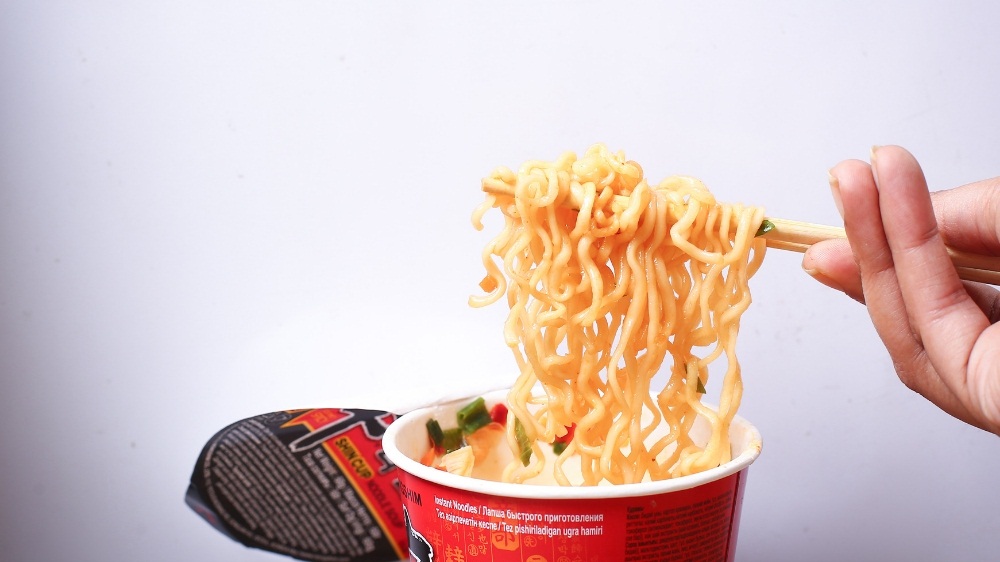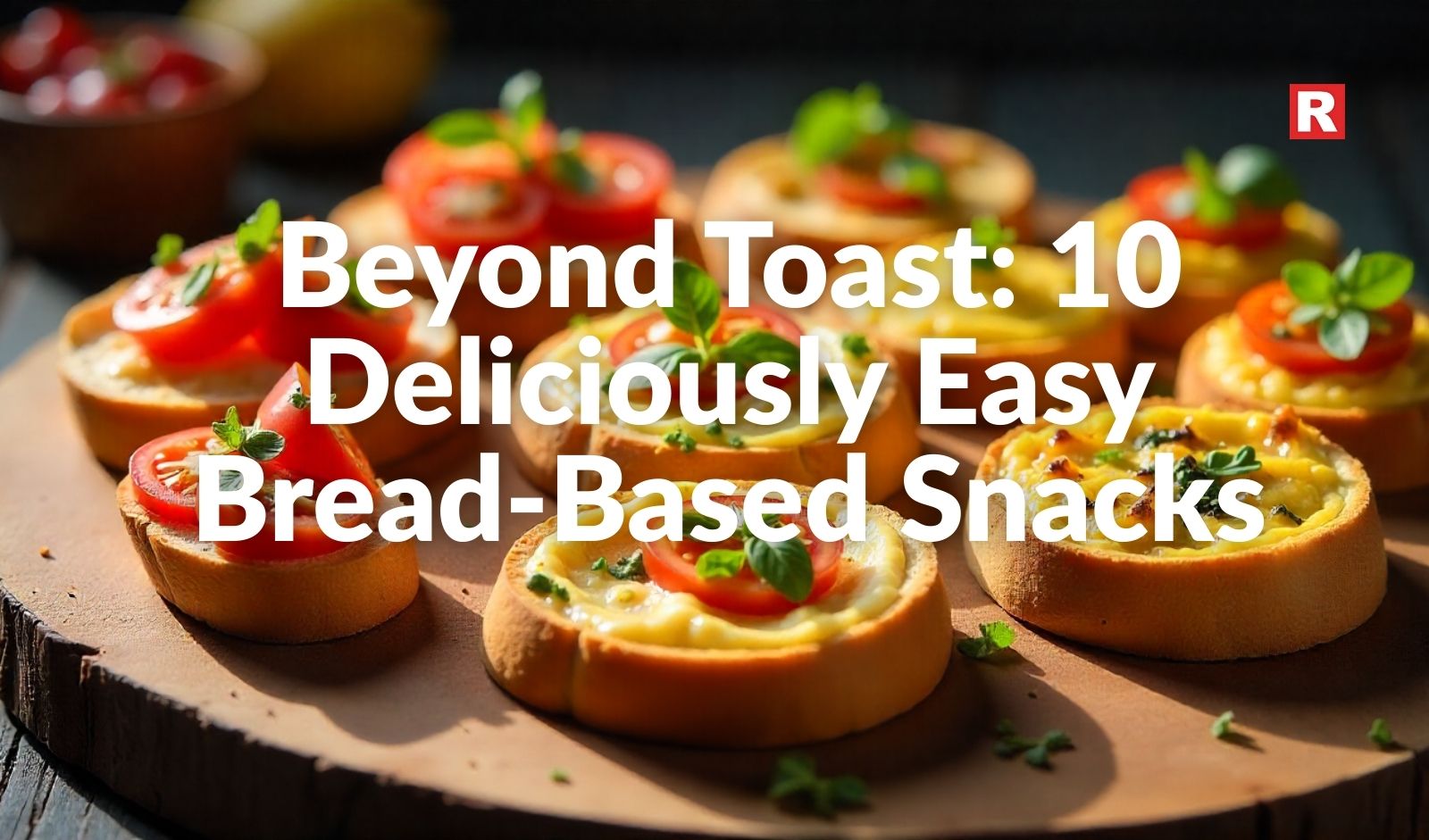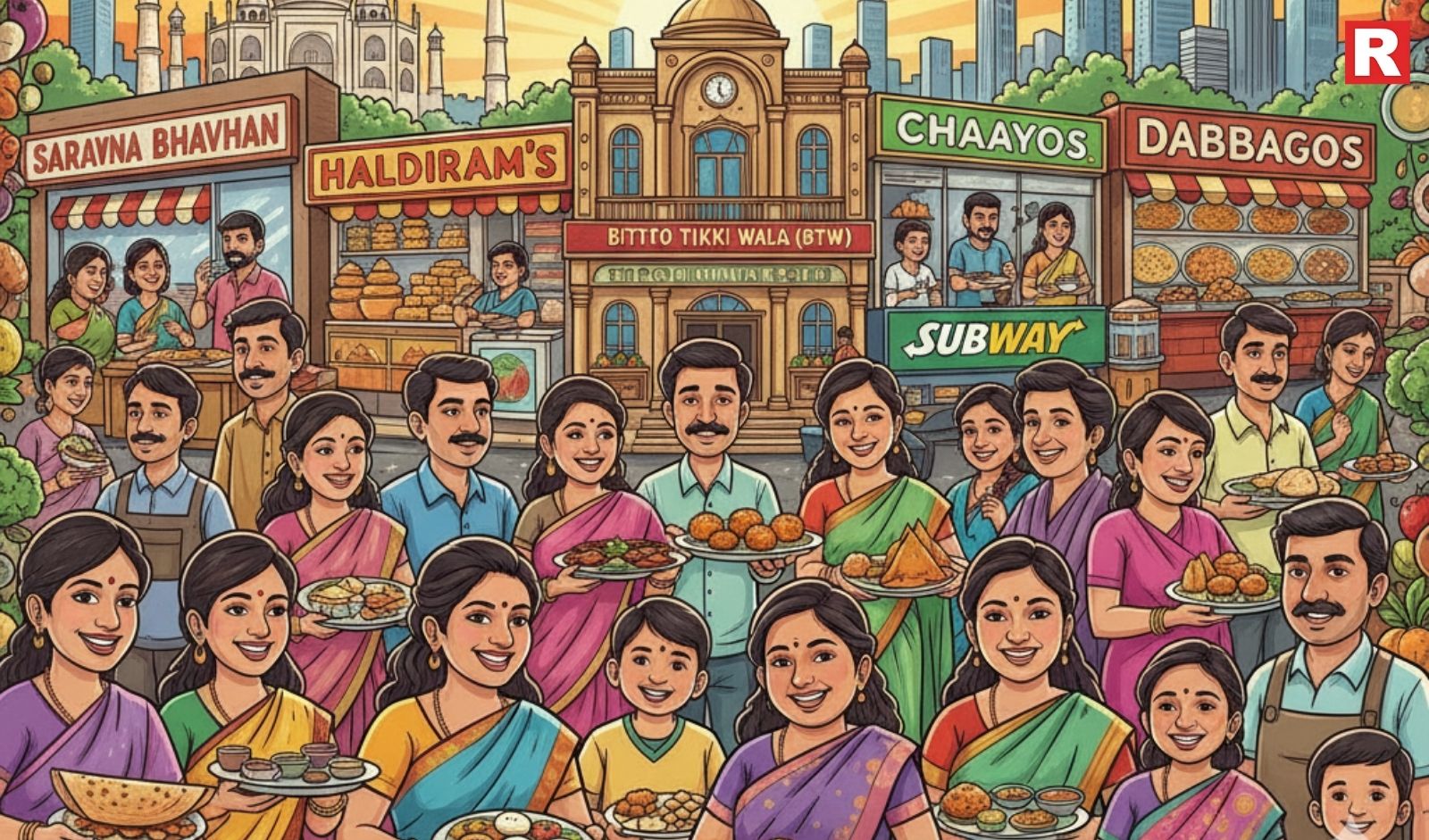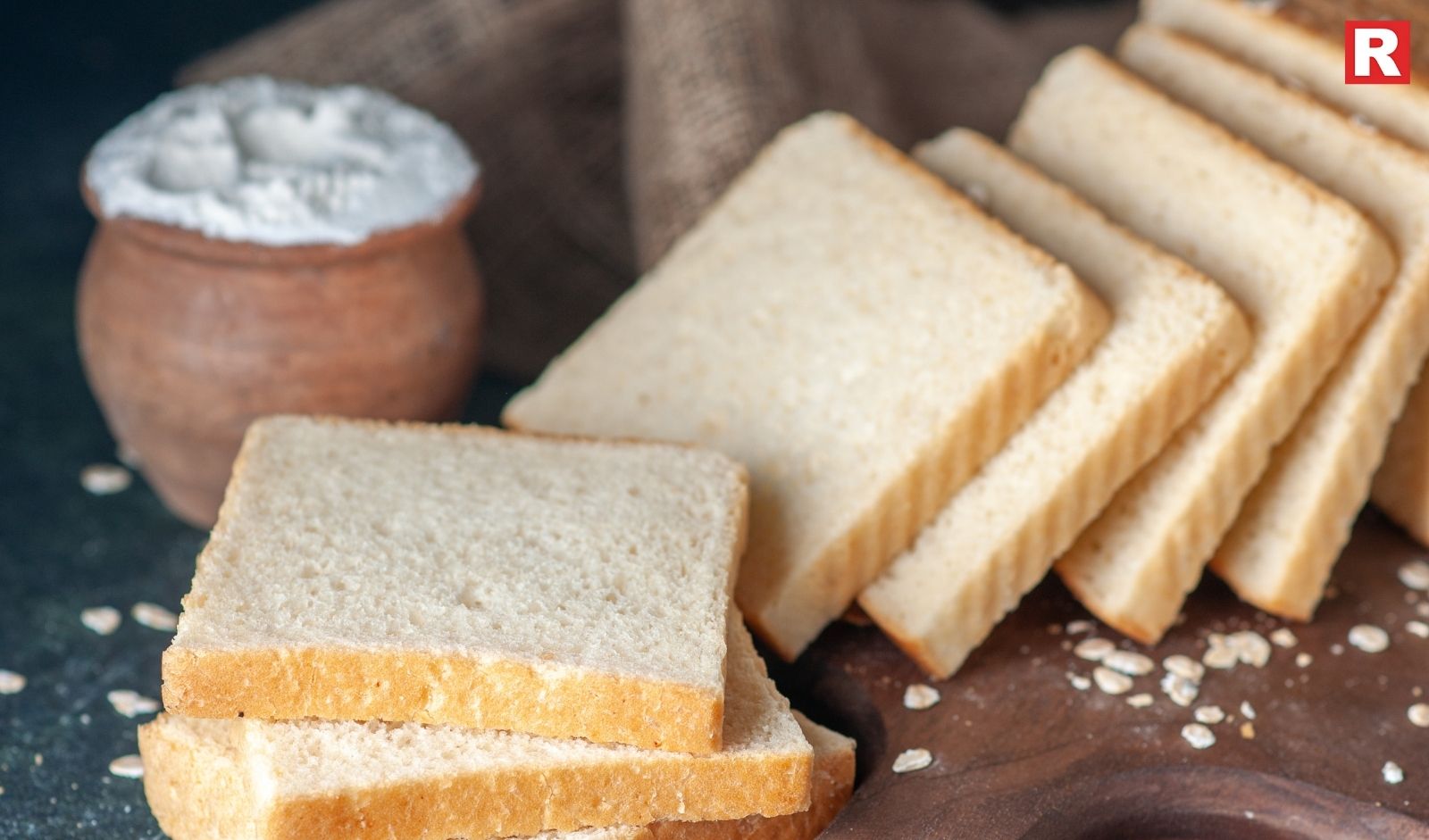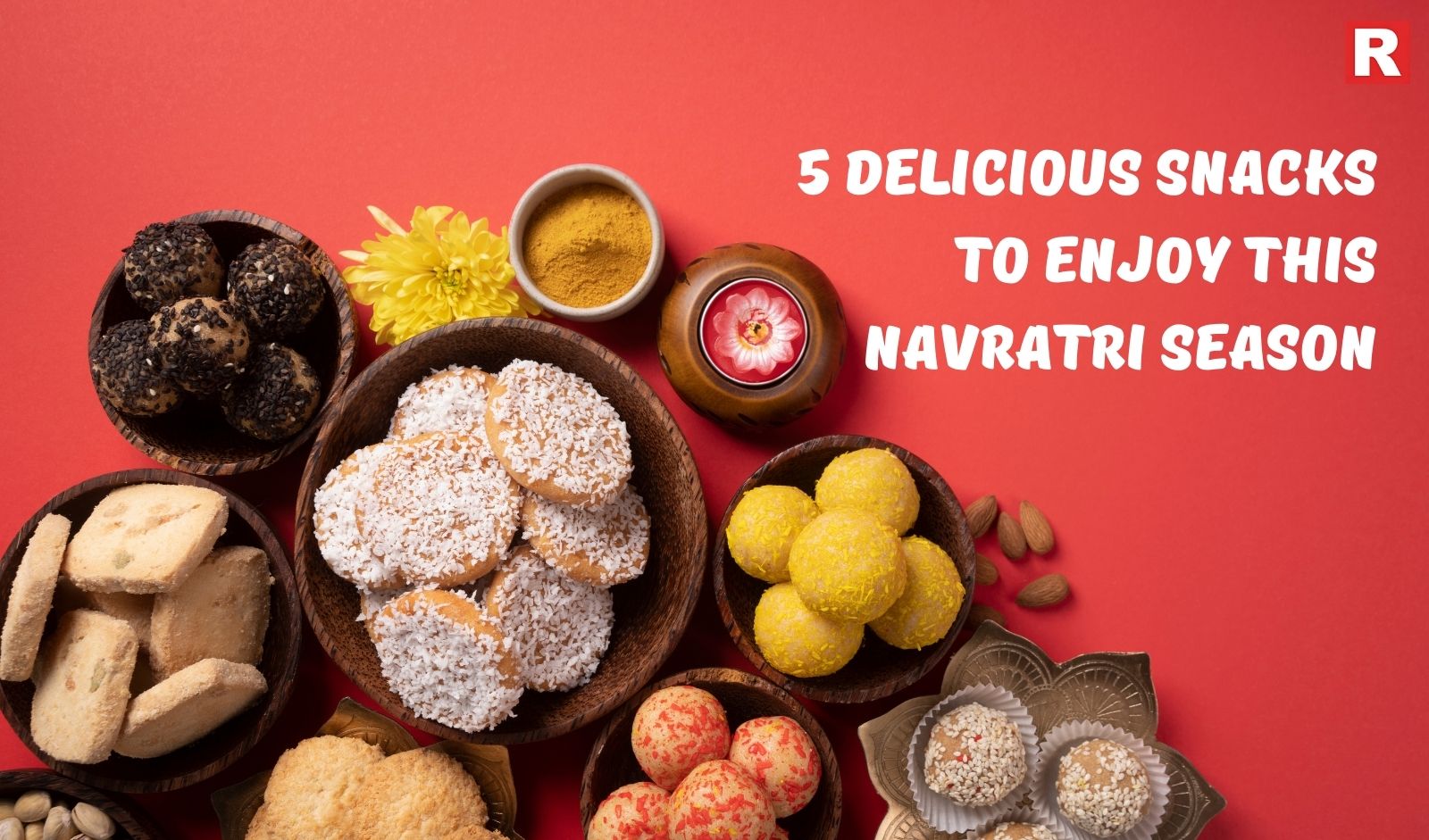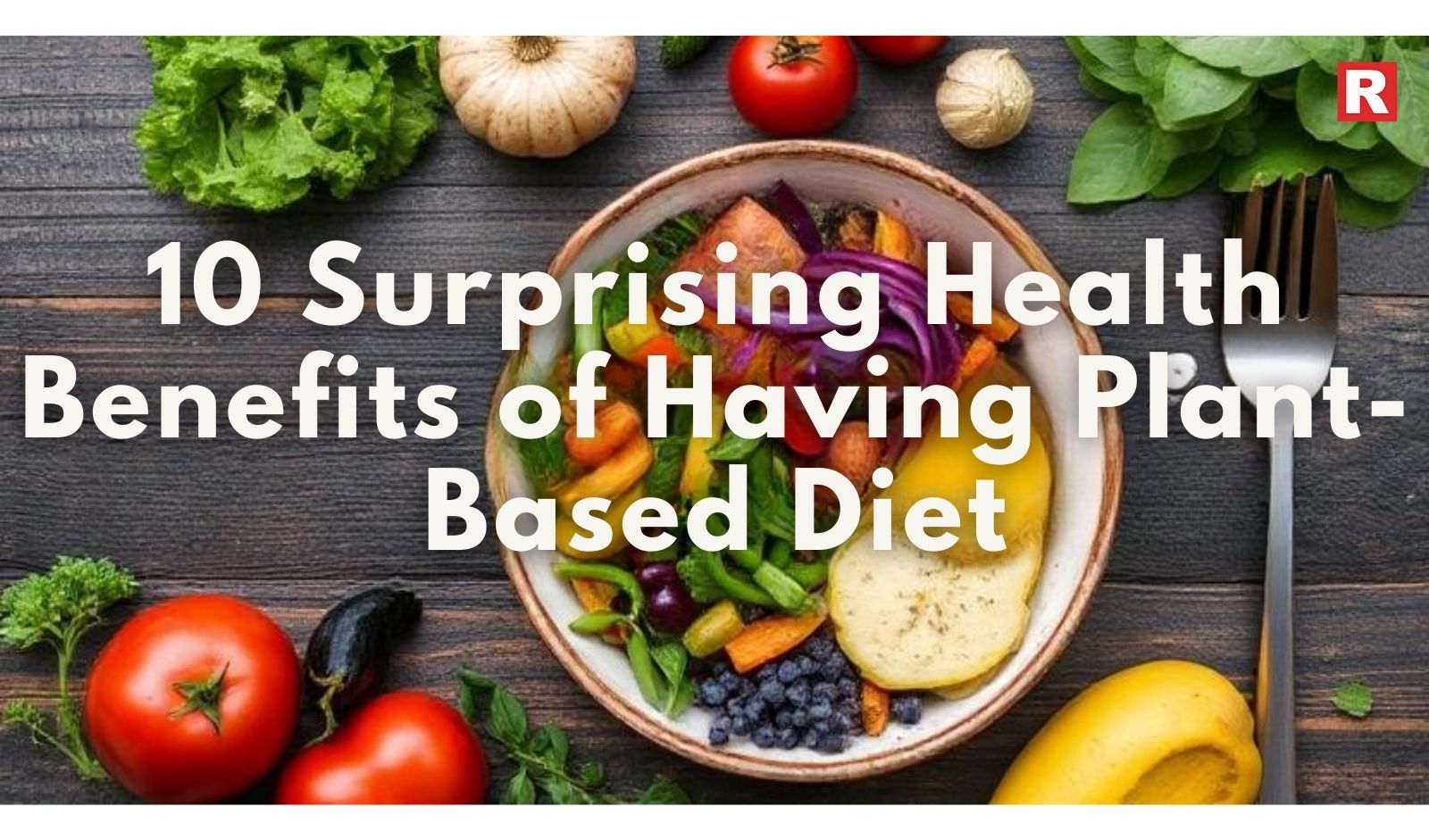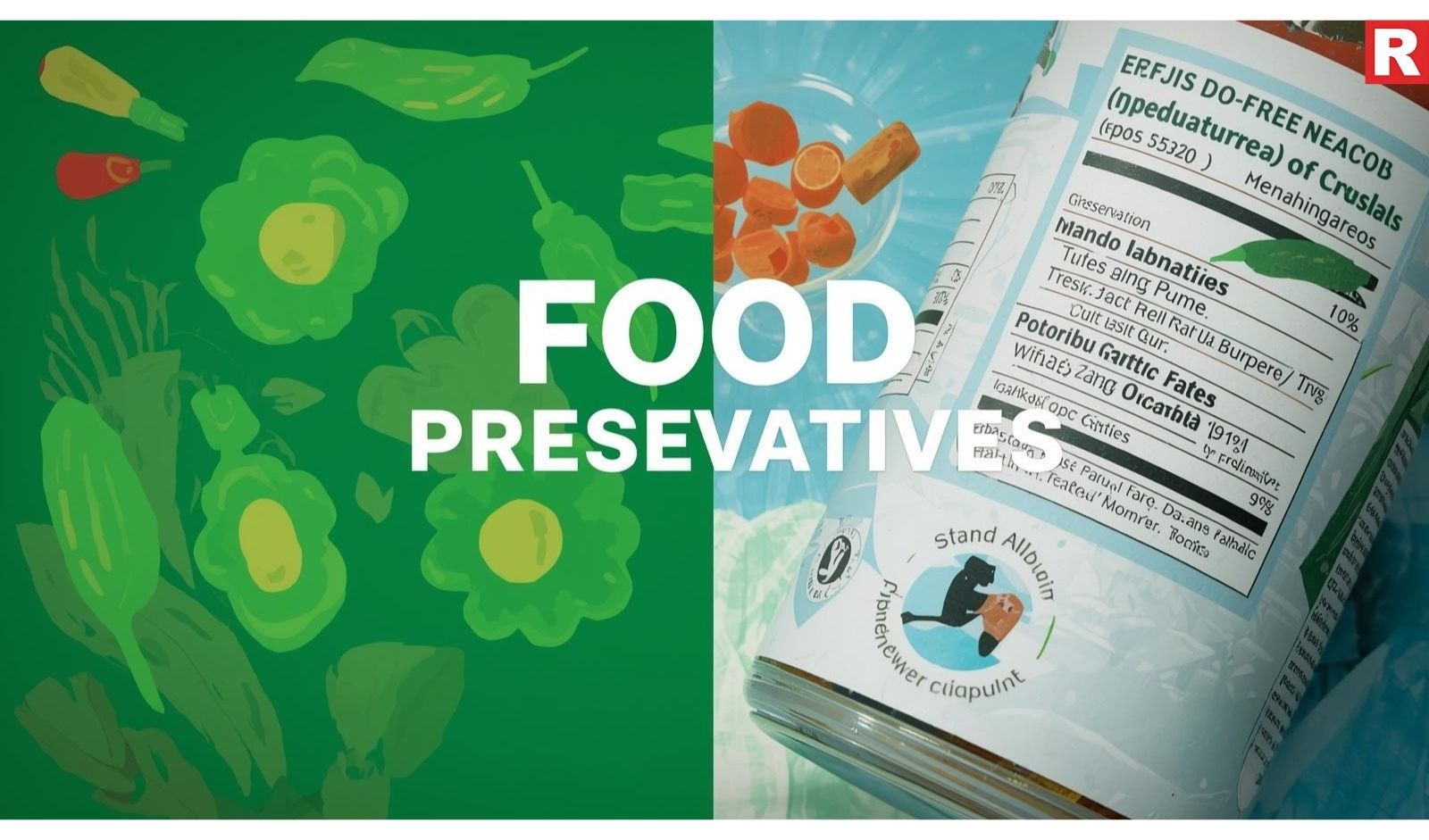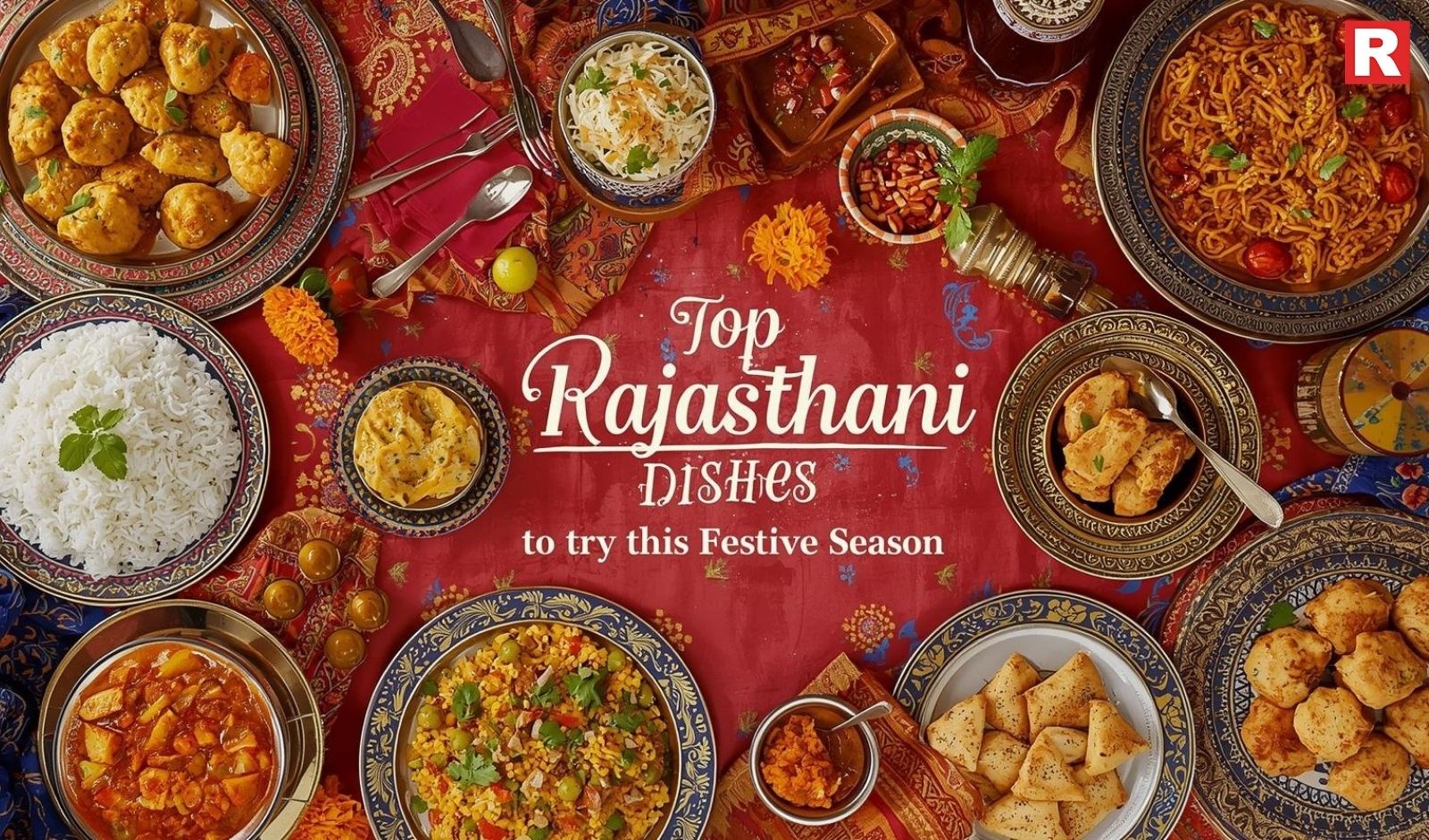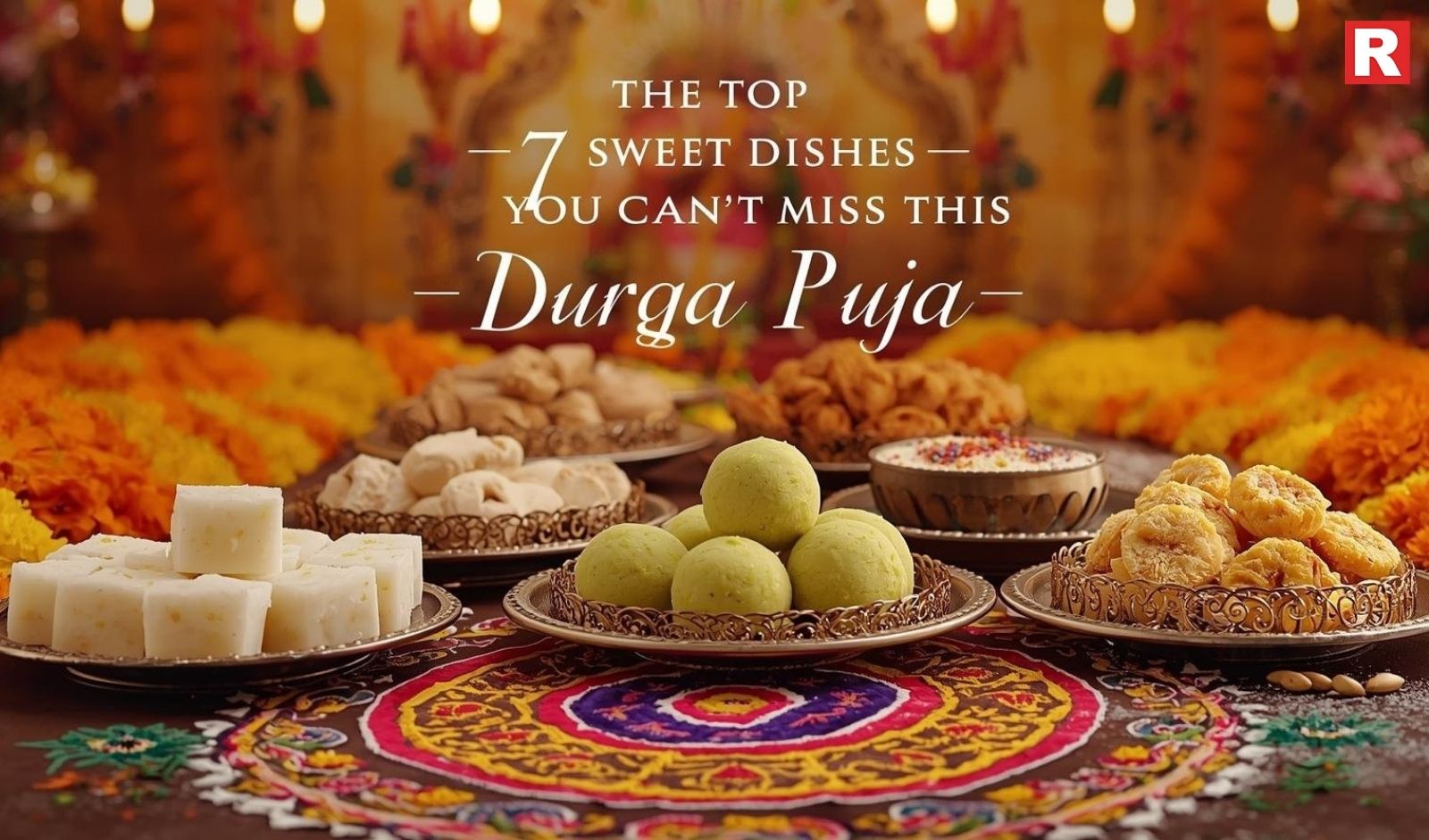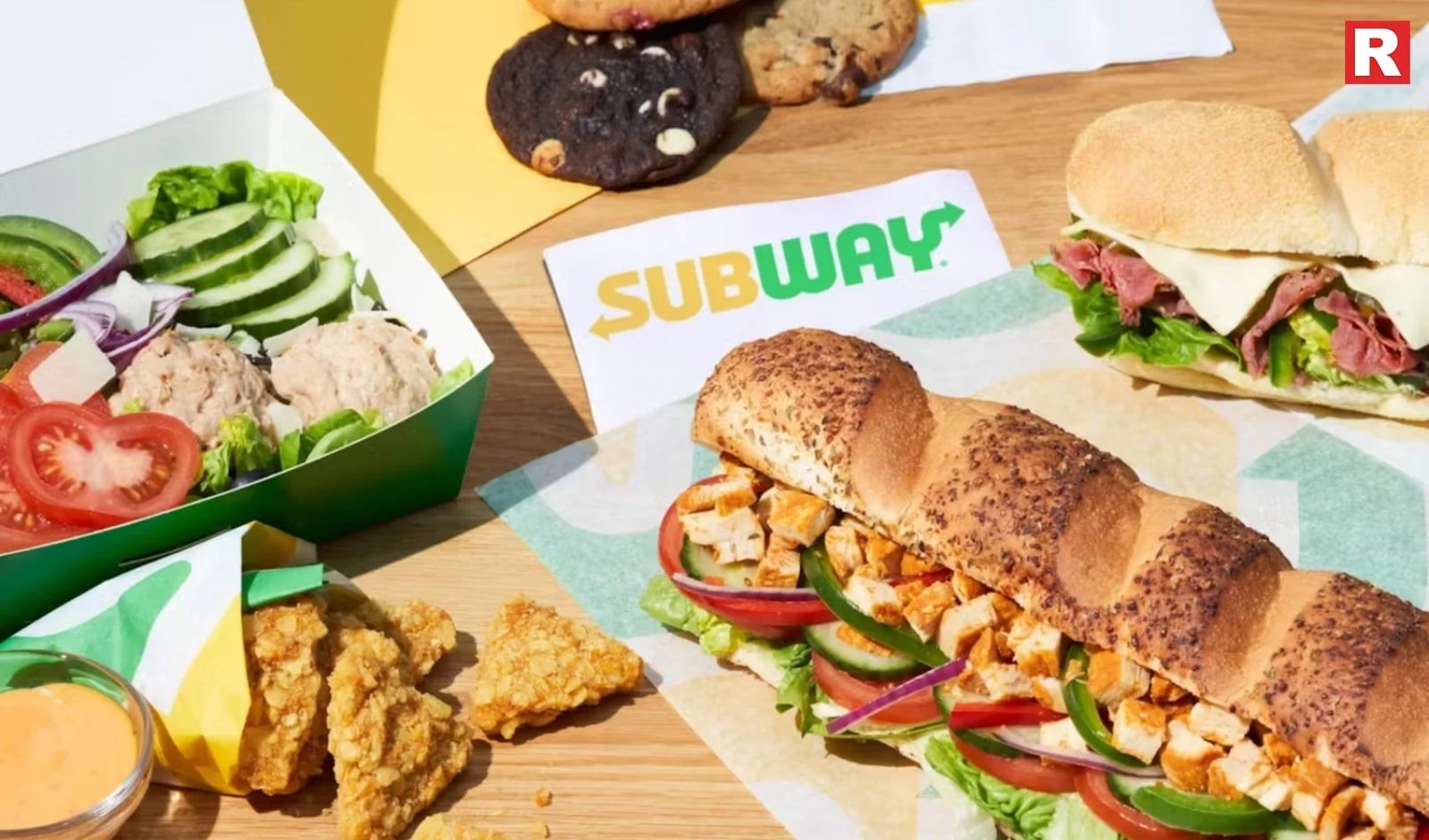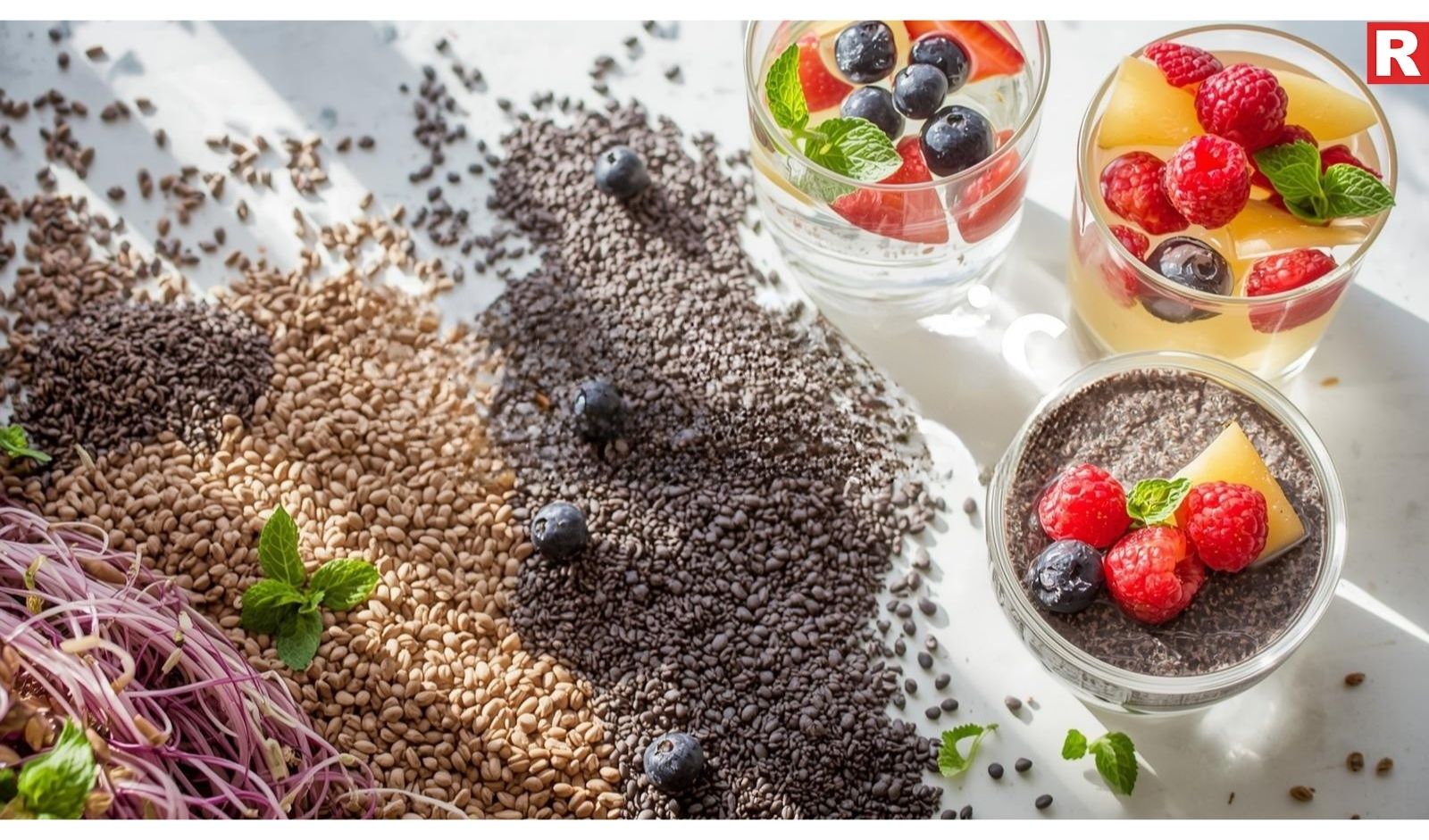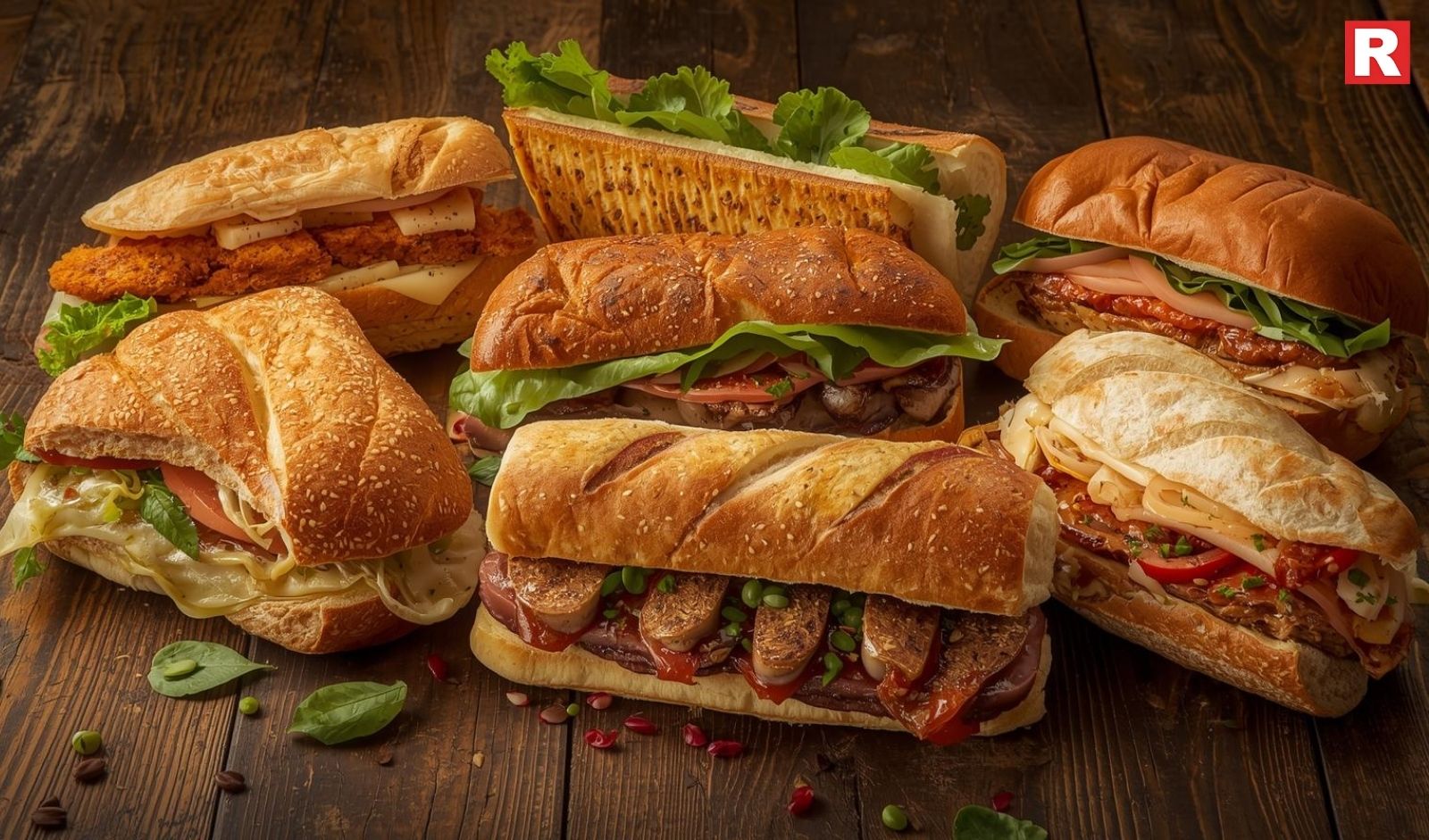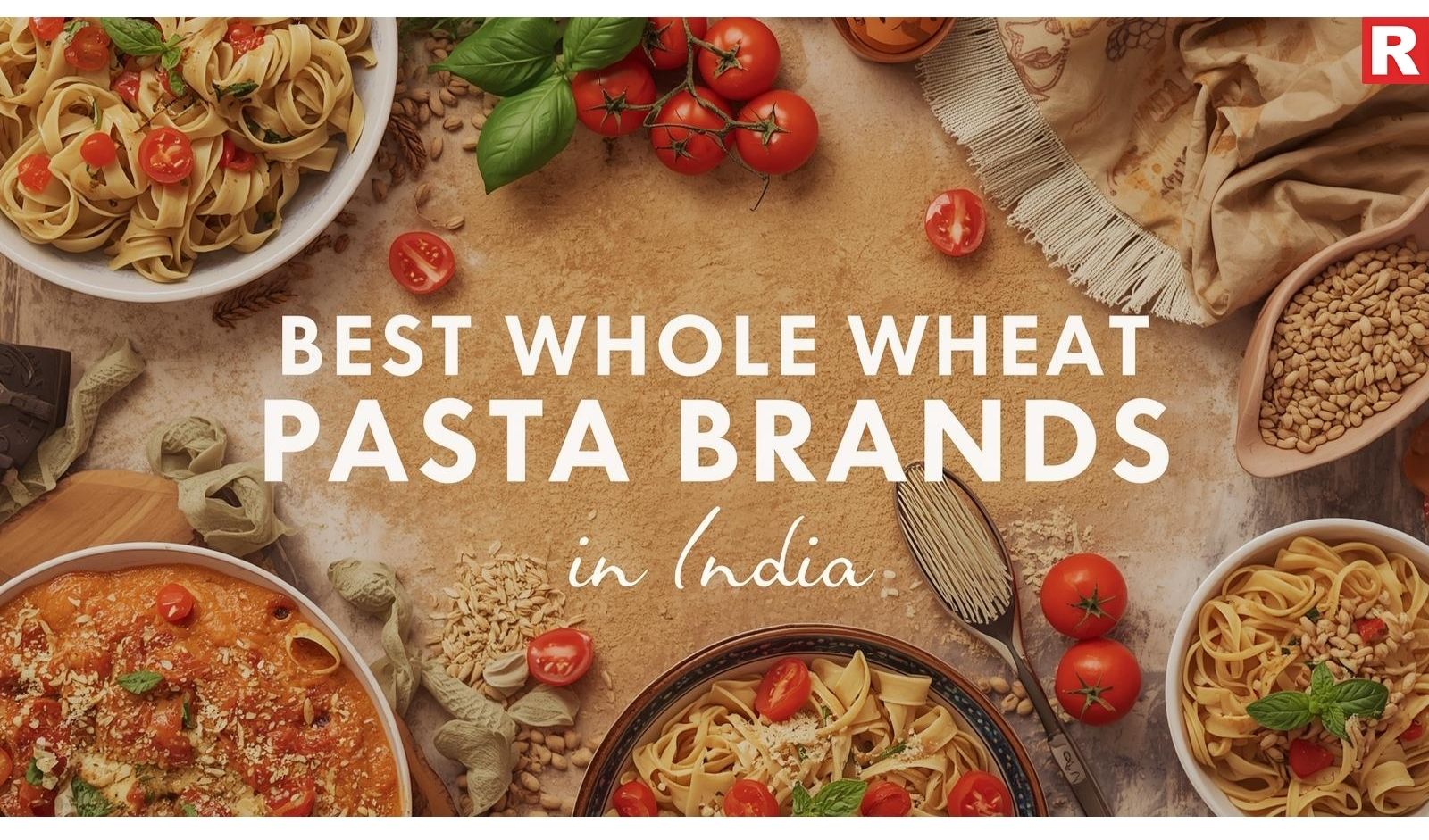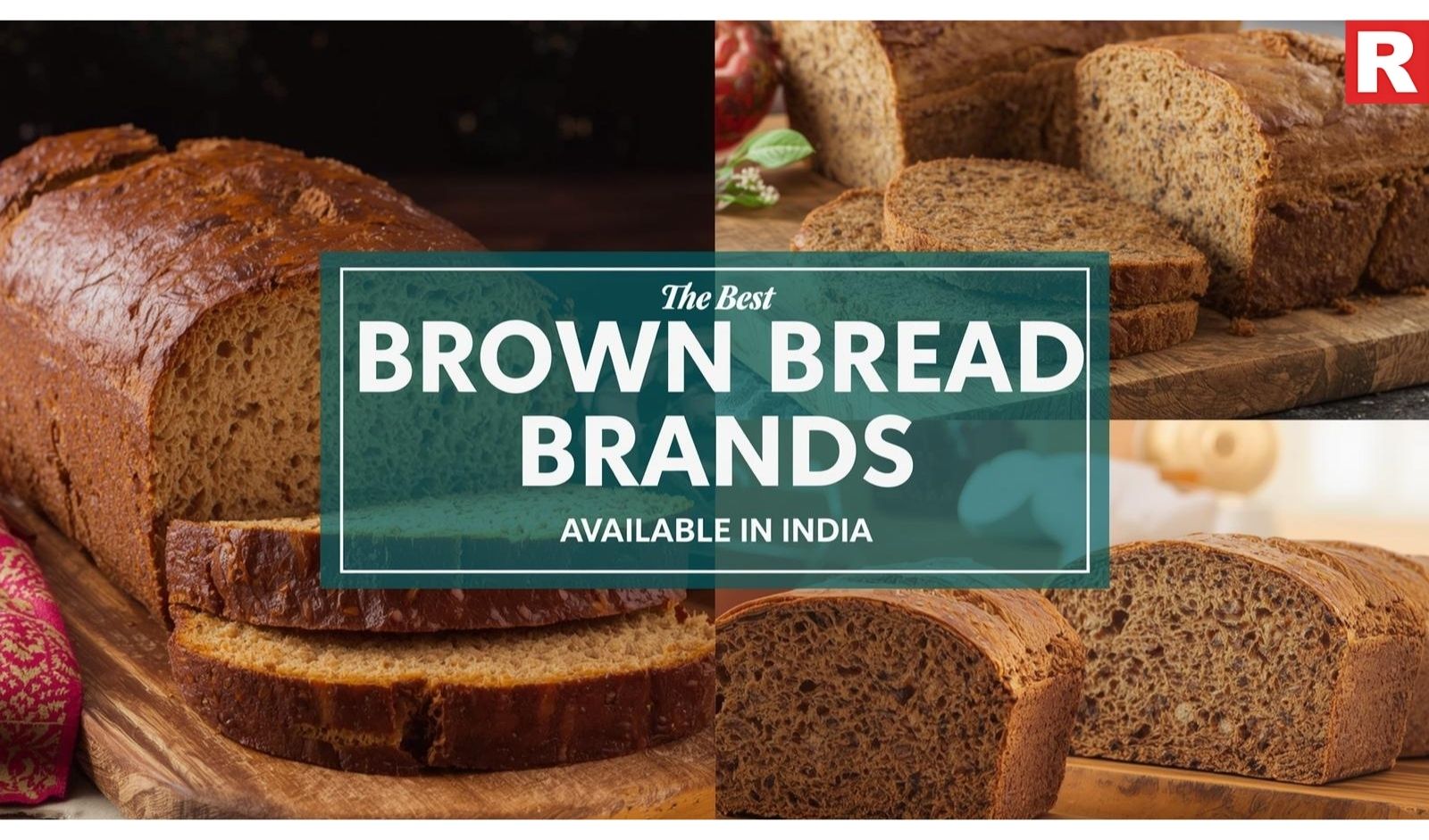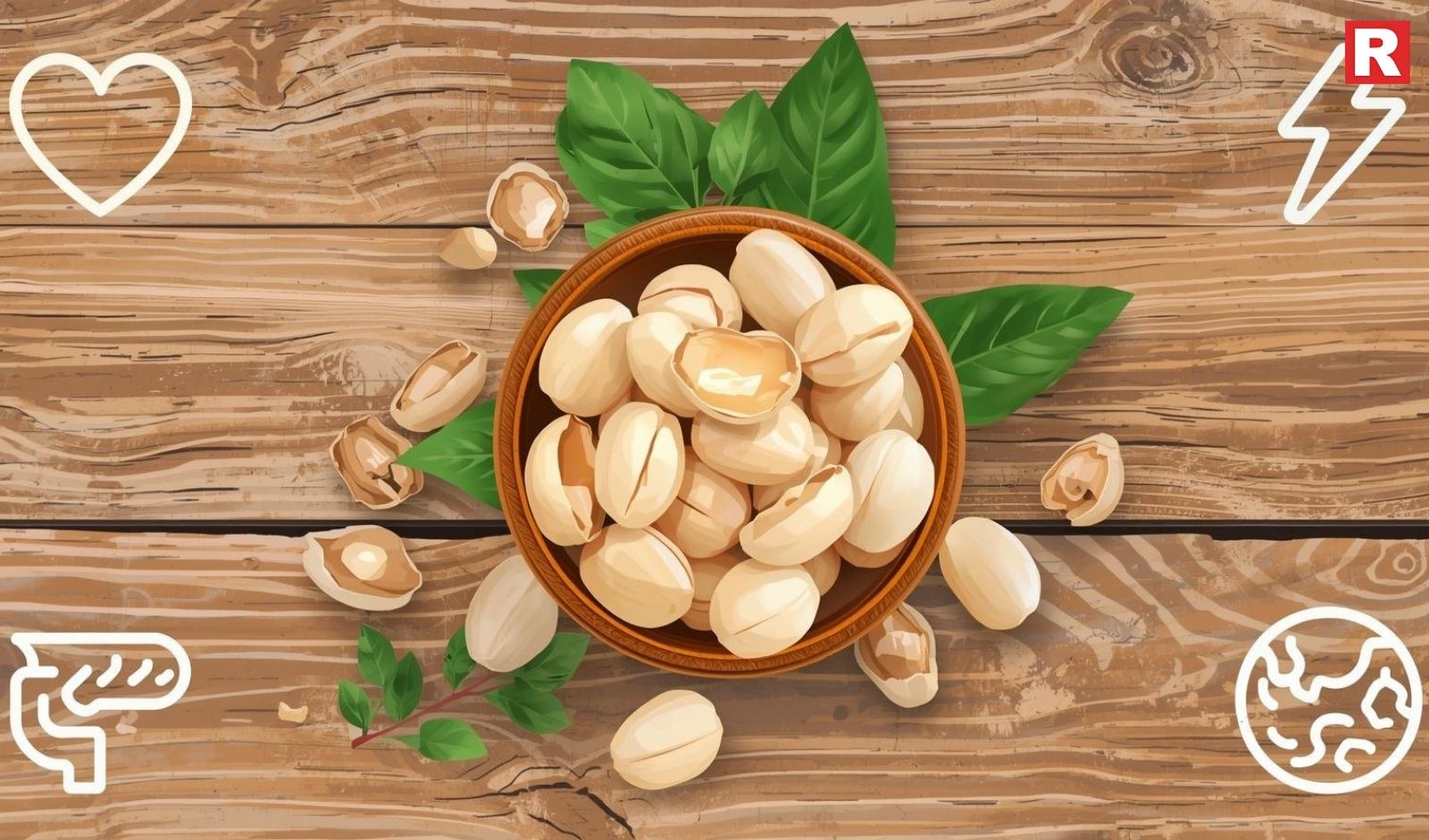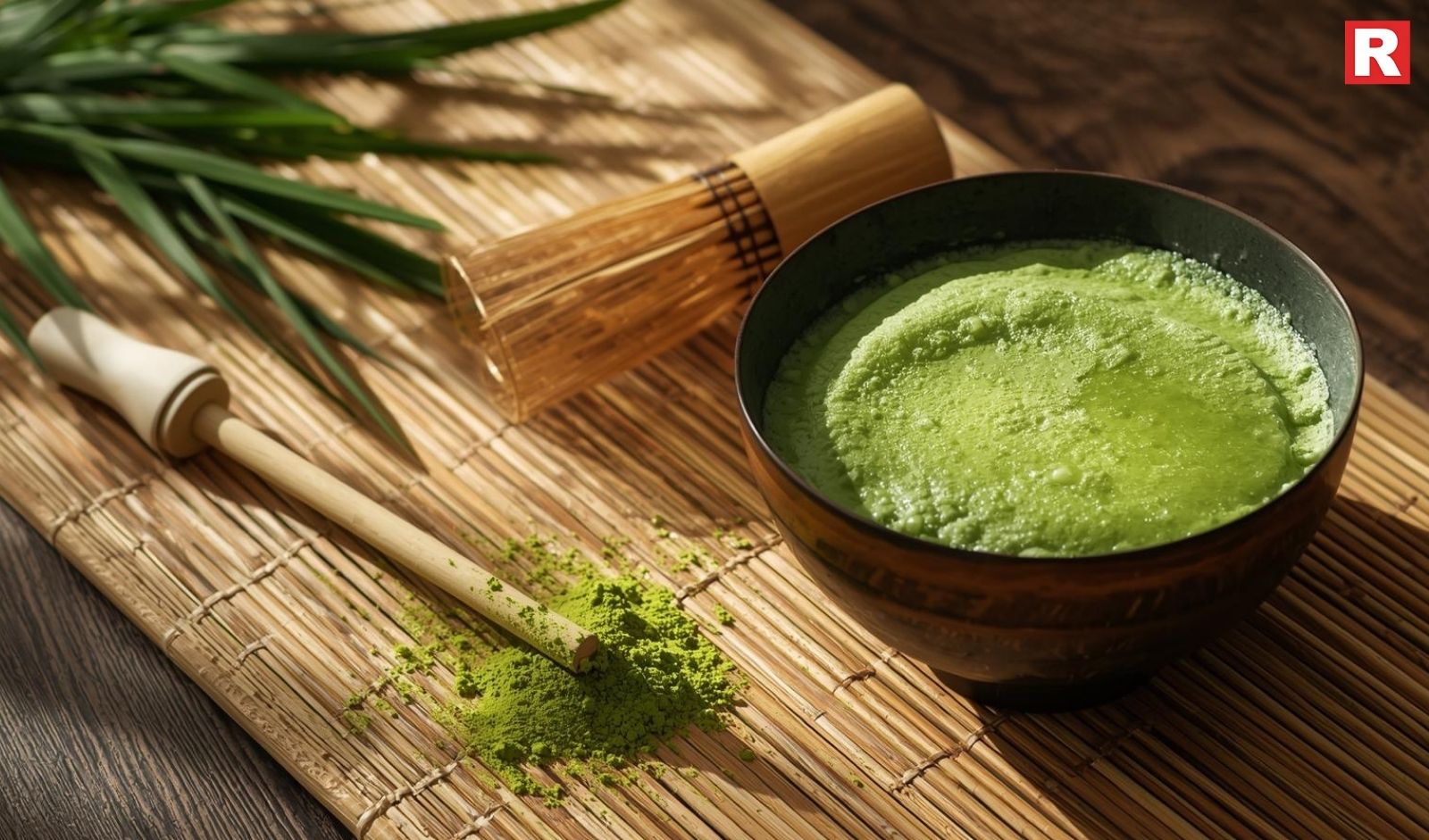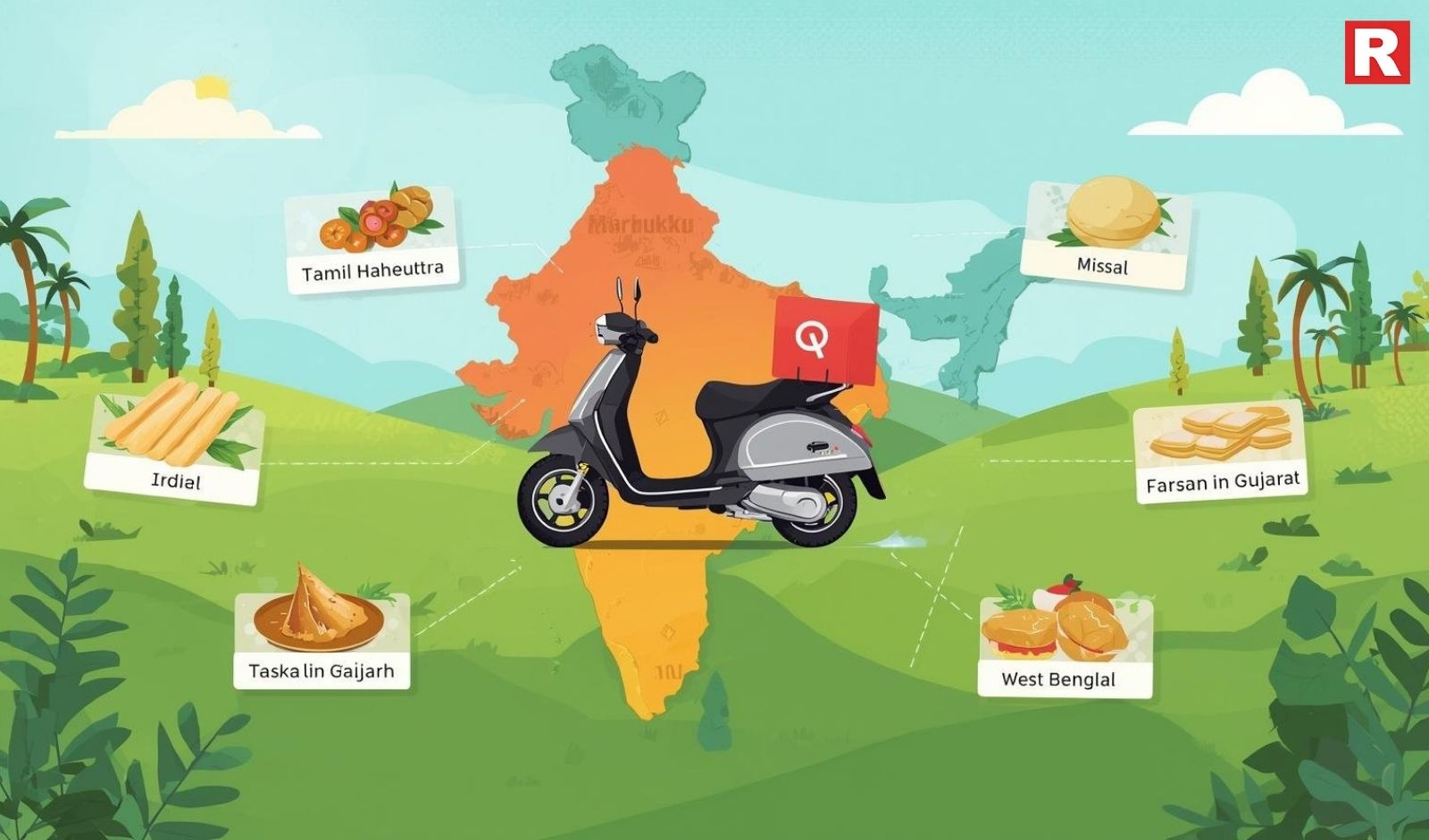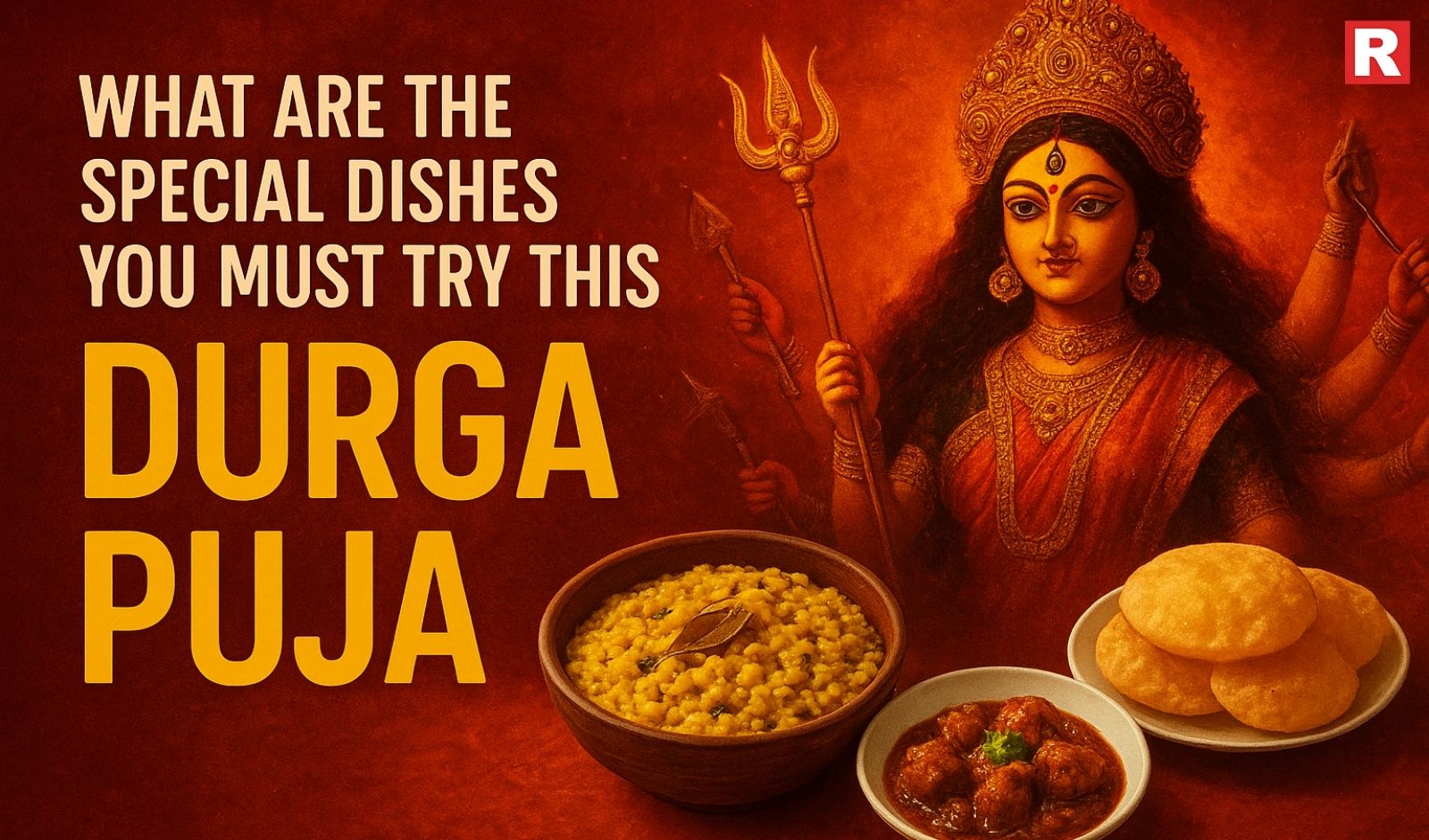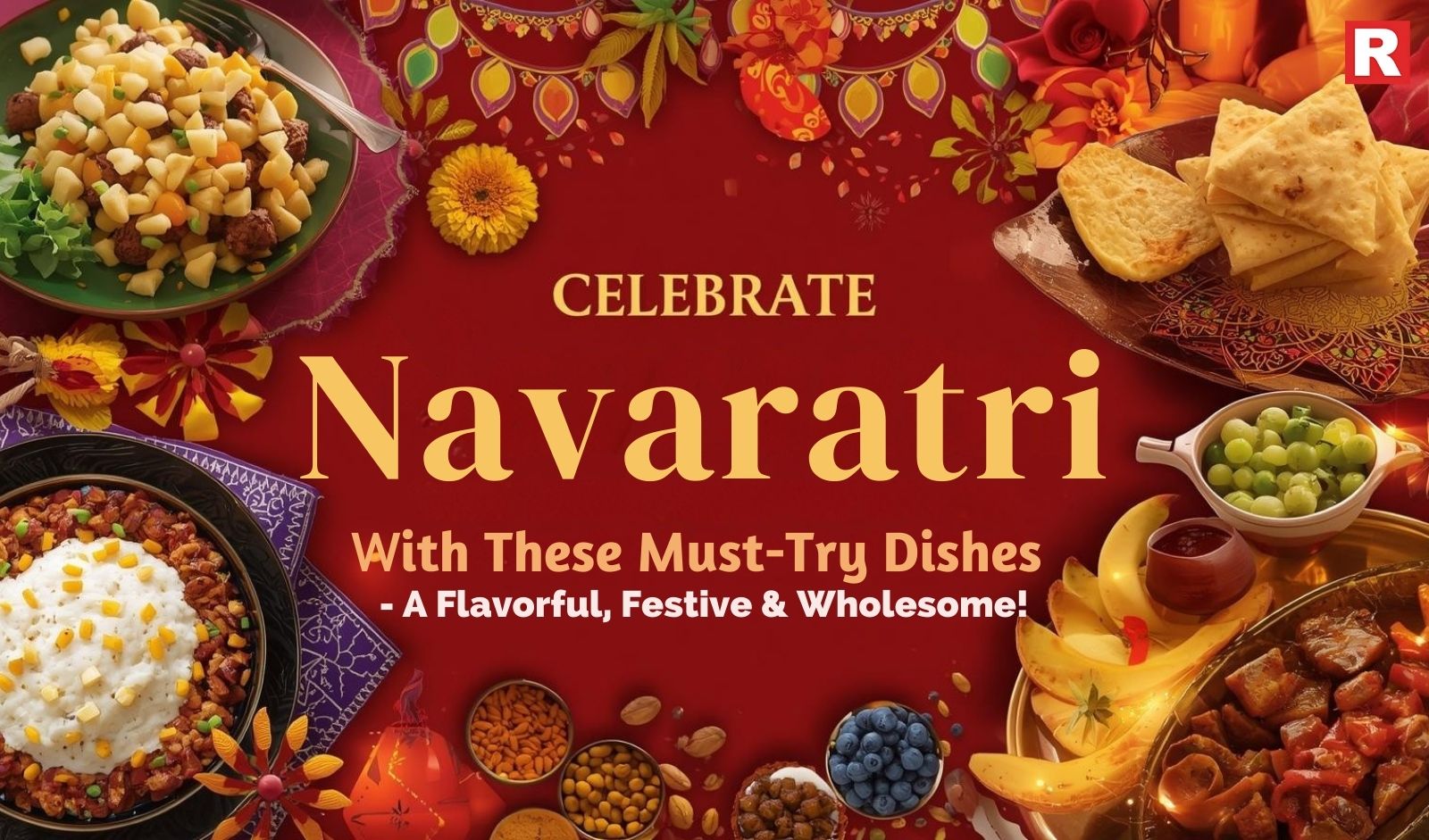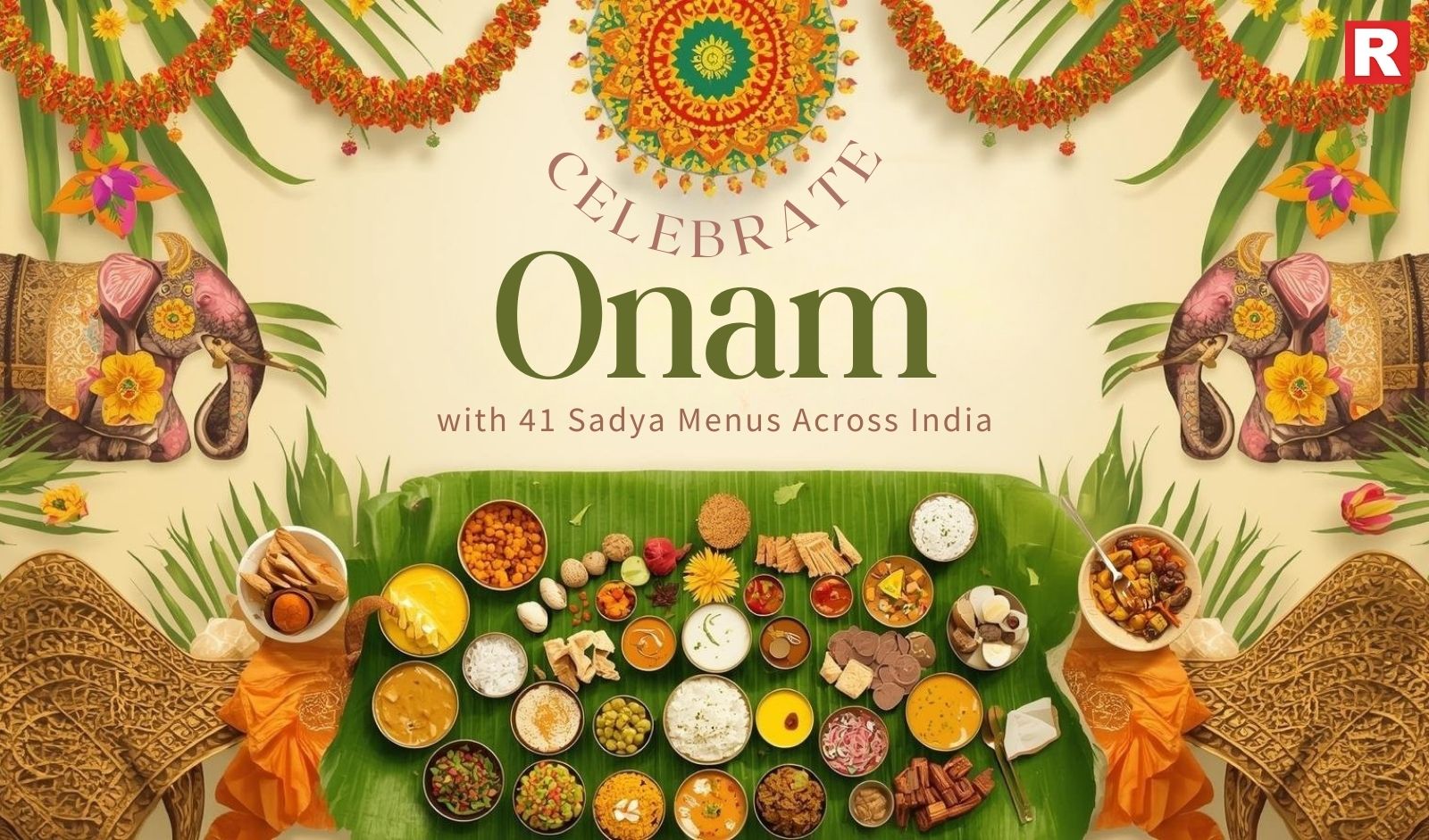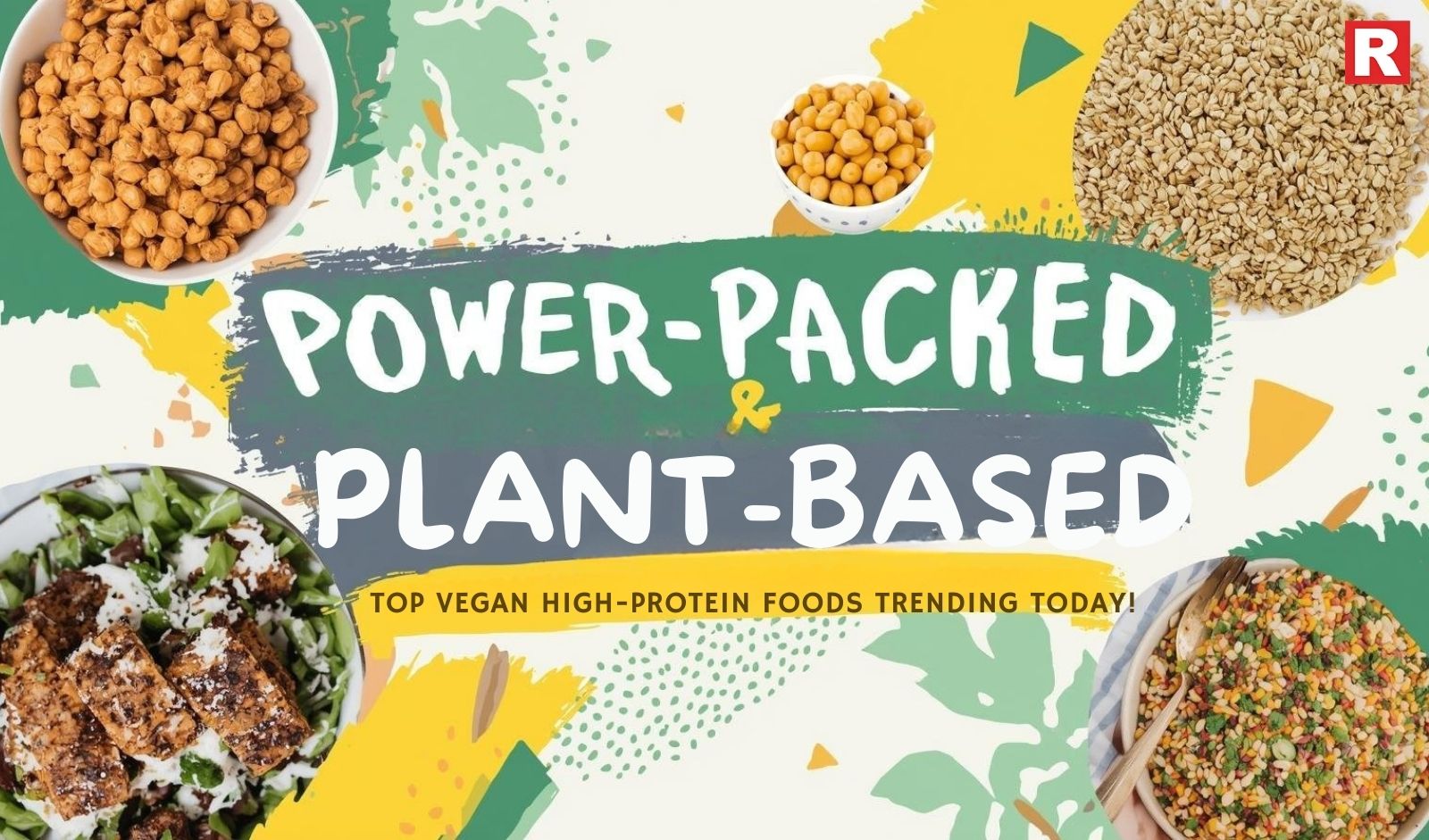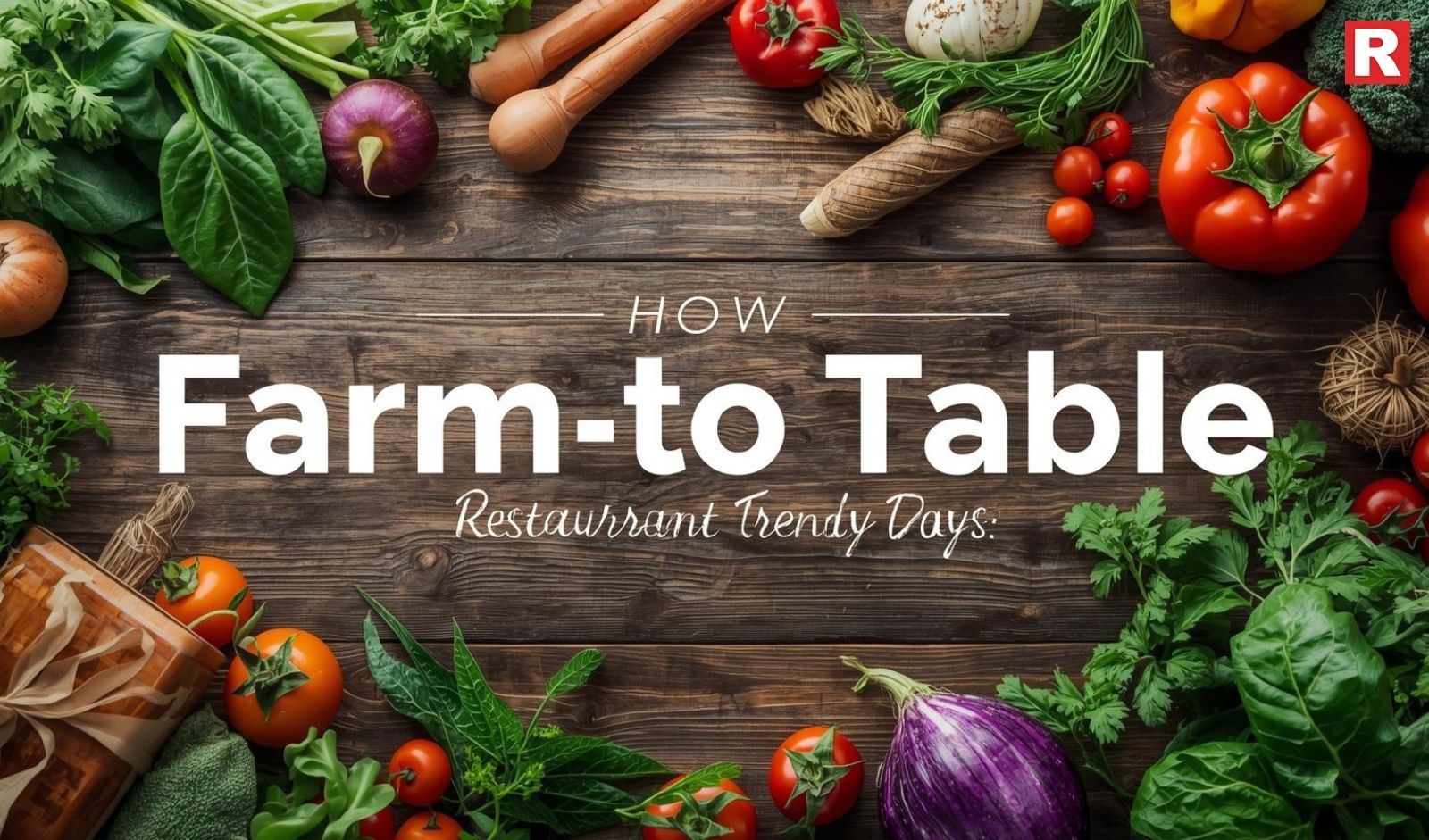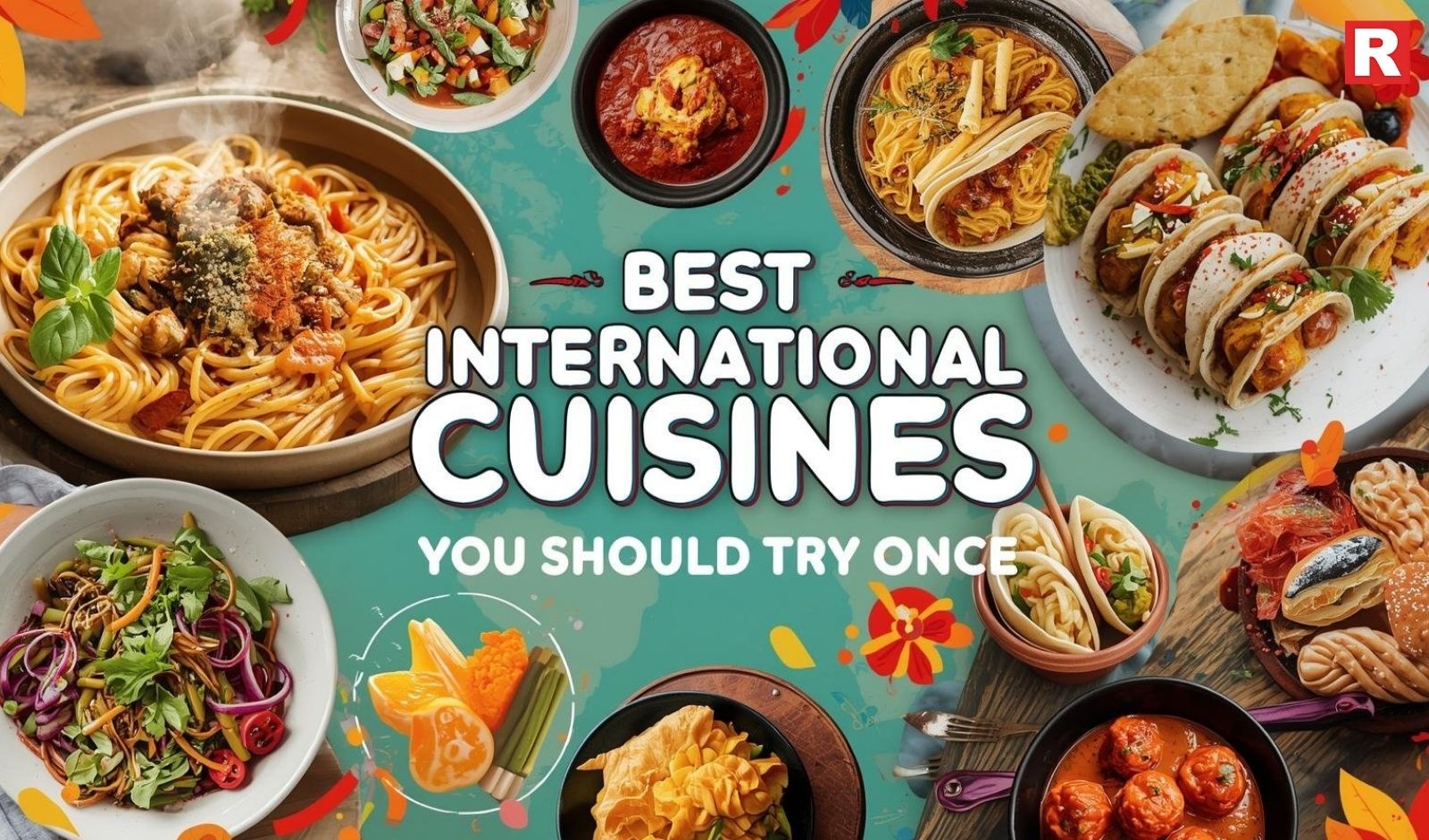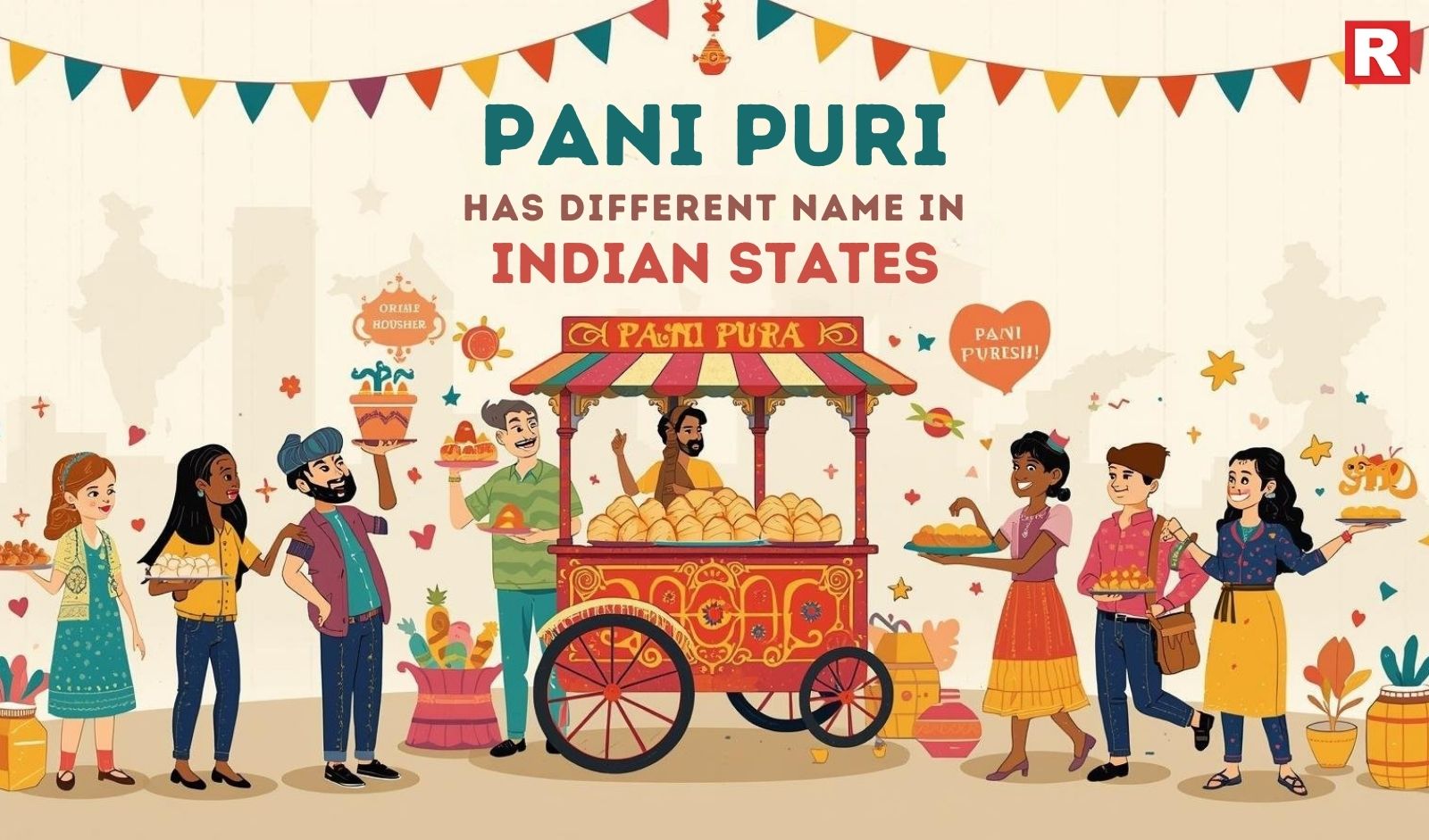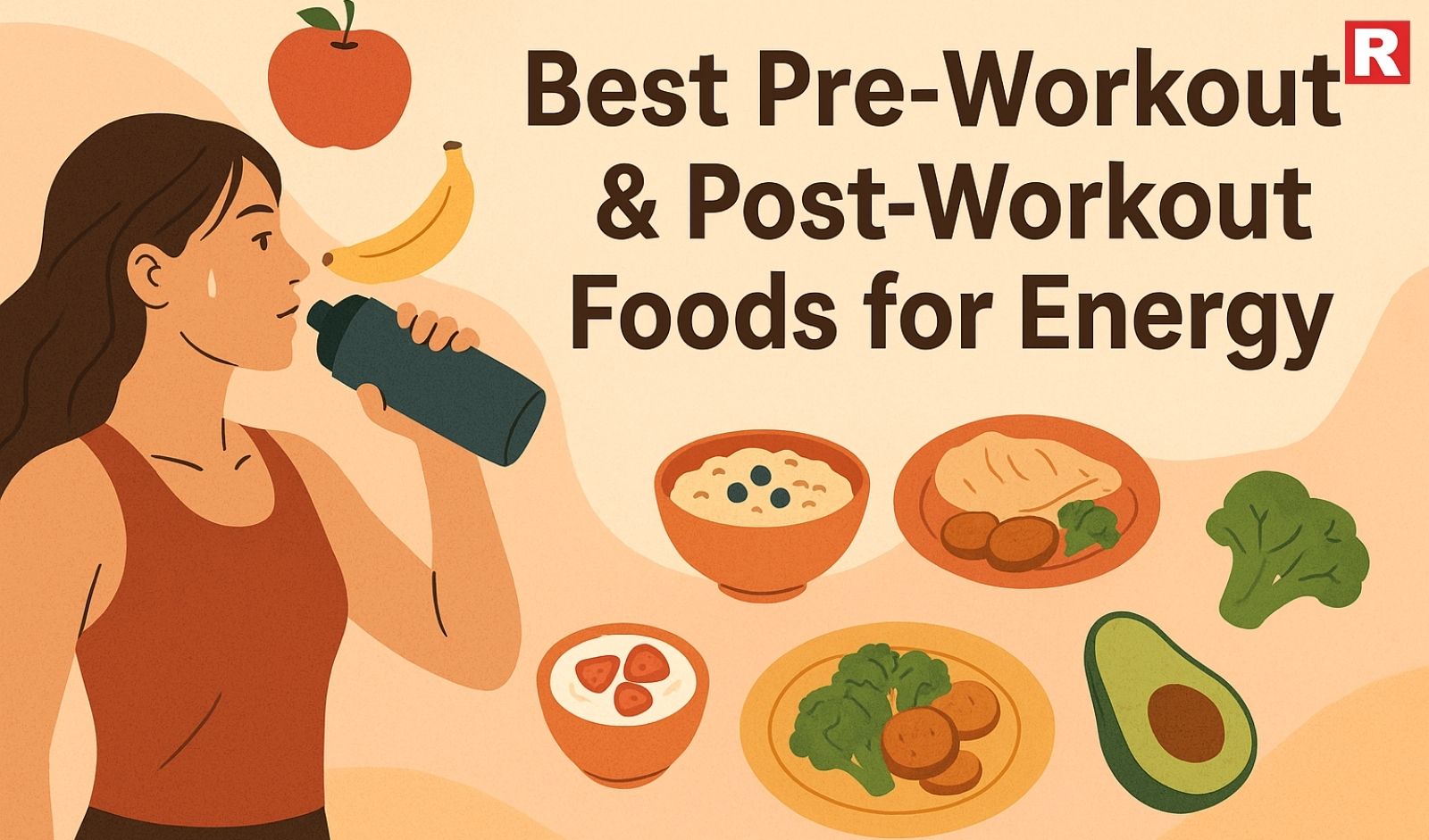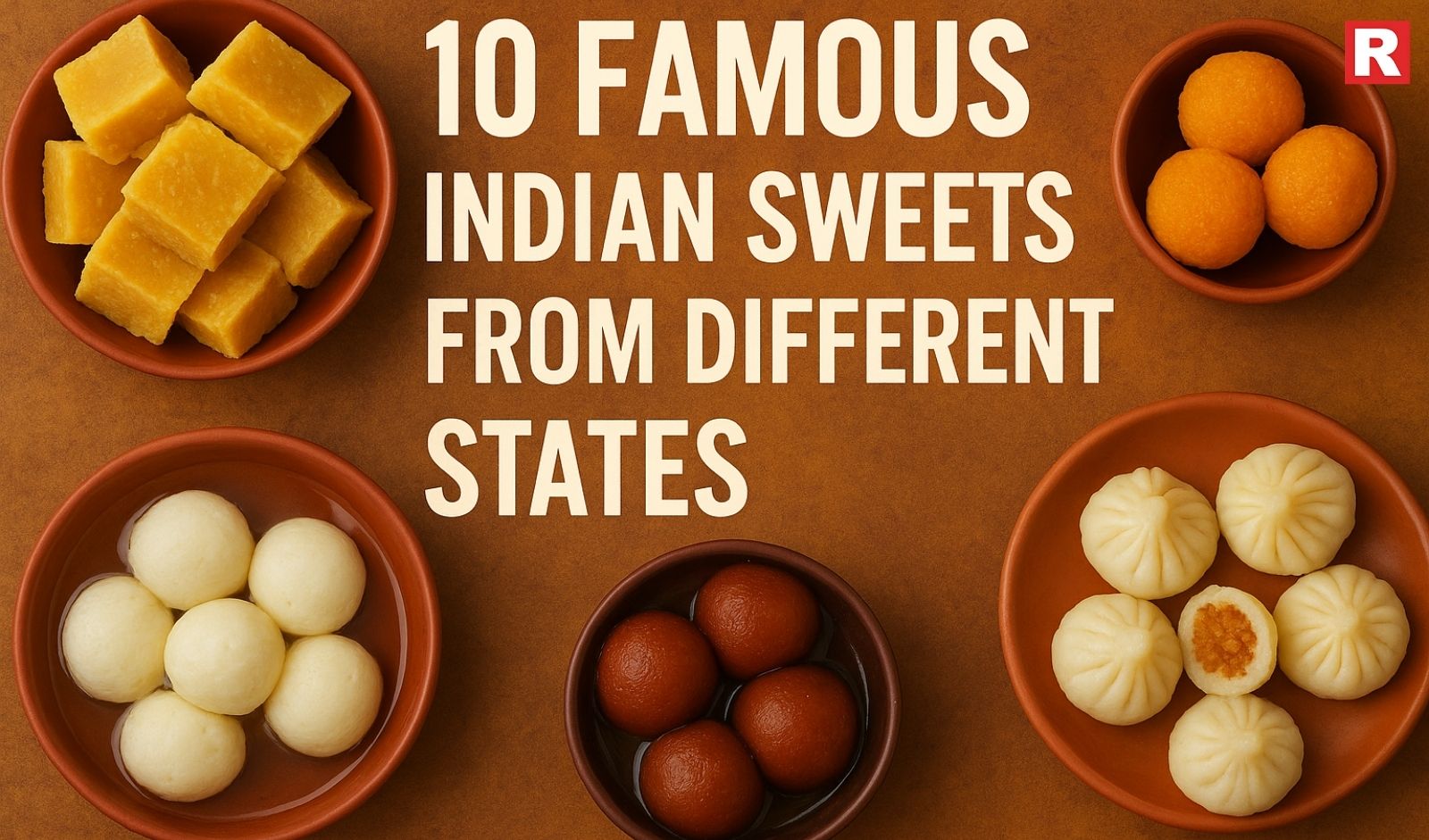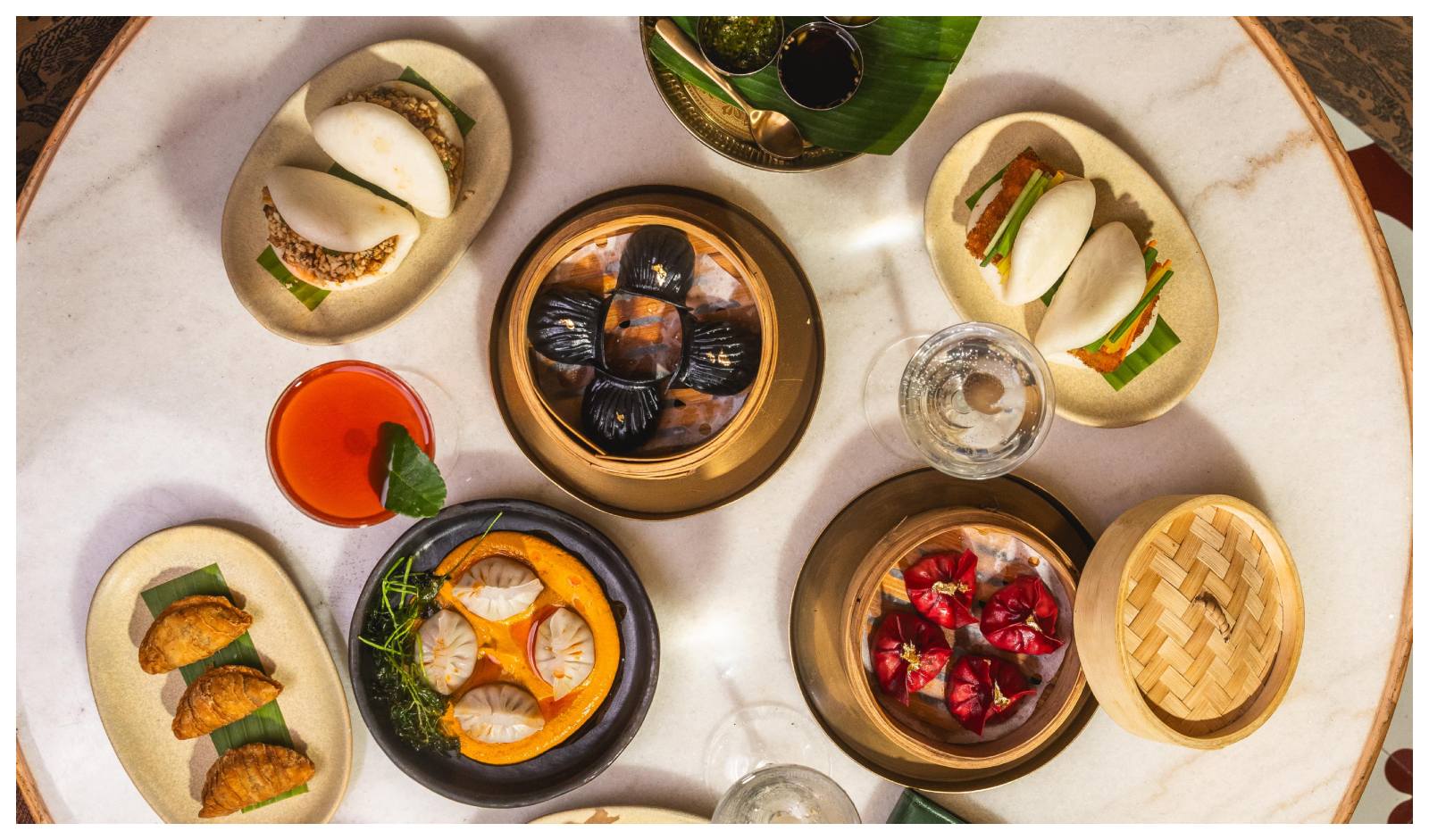
It’s time to give the spotlight to ramyun – a sumptuous Asian dish we all drool for!
A popular food said to originate from China as ramen, it is a Japanese dish made of Chinese-style wheat noodles served in a bowl of warm broth and topped with seasoning. Its name, ramen, was derived from the Chinese word, lamian – a kind of Chinese noodles that is manually made by twisting, stretching, and folding the dough into fine strands.
Ramyun, A Noodle Dish
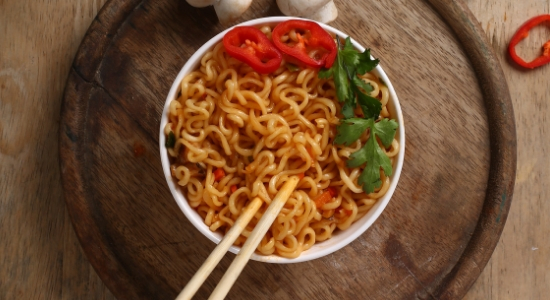
While ramen became widely-known through the influence of the Japanese people, it has also received a lot of love in a different variety over the years.
Unknown to many, ramen has made its way to Korea in the early 1960s. This led to the birth of its Korean counterpart known as Ramyeon or ramyun. Ramyun is basically a noodle dish, similar to the Japanese ramen, but is quite distinct in form and taste.
Today, it’s has gained popularity all over the world and enjoyed by people everywhere. Ramyun’s popularity is due in part to the fact that it is simple to make and quick to eat. It is also inexpensive, making it an ideal lunch, dinner or after-a-night-on-the-town snack.
Must Read: Ramen, An Evolution Of Model Soup Phenomenon
Difference between Korean Ramyun and Japanese Ramen
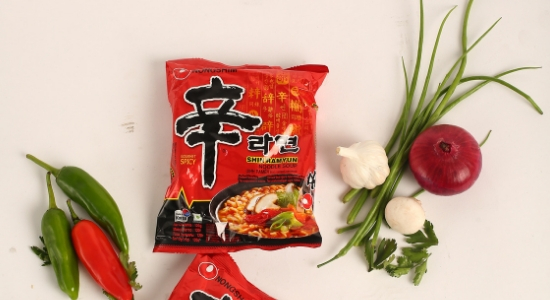
Japanese ramen is more subtle in flavour compared to that of Korean ramyun as it has a stronger taste, and is generally spicy.
Another difference between the two is that Japanese ramen’s broth is made from chicken, seafood, or pork stock whereas Korean ramyun’s soup is made from a processed seasoning. To be more specific, Korean ramyun is usually in the form of instant noodles simply boiled in a pot while Japanese ramen is made using natural seasoning, ingredients, and flavours. However, despite this fact, Koreans make their ramyun special by adding pork, vegetable, or seafood toppings.
Ramyun in India
In India, ramen is gaining popularity, thanks to increasing Japanese and Korean investment in India, complemented by raising awareness on Asian cuisines. However, it is still mostly available in Asian cuisine restaurants.
Catering to Indian Palate
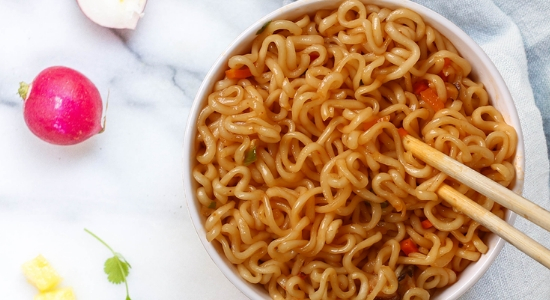
Nongshim India is one of the companies that have brought instant ramyun to India. It wants Indians to enjoy ramyun at the comfort of their home easily like people back in Korea.
Like Korean cuisine, Ramyun is generally served hot and spicy which suits to taste buds of Indians. Korean cuisine predominantly consists of seafood and meat-based dishes. And Ramyun is mostly served with beef, pork and seafood. But, when we brought Nongshim to India, the purpose was to serve all the Indians, including vegetarians. Nongshim India brought the vegetarian variation of their trademark flavour, Shin Ramyun Noodle Soup, to cater the vegetarians in India.
Serving It Right at the Restaurants
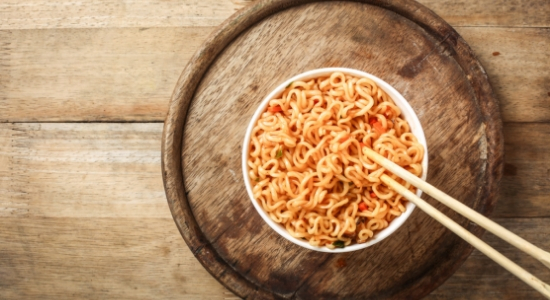
Ramyun is served across Asian cuisine restaurants, but there is only a handful that serves it right. Making ramen is a time-honoured art. What some people try to knock out in a couple of hours, the right people will let simmer for a day, even more, to truly capture the intensity of flavour that’s required.
As told by Nongshim India Team
About Nongshim India
Nongshim started in 1965 in Seoul, Korea, and became the #1 noodle and snack manufacturer in the country for almost 30 years. Today Nongshim is delivering healthy and happy food culture to dining tables in Asia and beyond.

Have you seen yourself pondering what to cook for an evening snack while holding a few pieces of bread and staring into the kitchen? In the chaos of a hectic day, bread is frequently the first food we reach for, whether we're balancing a demanding job, running a household, or just satisfying our sudden hunger. It is a delicious blank canvas that is just waiting to be filled. But why limit yourself to a basic sandwich or toast?
This article is for you if you're sick of the same old routine and want to surprise your family or your own taste buds. Our goal is to take you beyond the fundamentals by transforming plain bread into ten innovative, delicious, and very simple snacks.
Read more: Celebrate Durga Puja in Style: Bringing Bengal’s Festive Spirit to Life
Why Get Creative with Bread?
Bread's ease and adaptability are what make it so lovely. It's easy to find, affordable, and ideal for urgent situations. More than that, though, using innovative bread snacks is a great way to:
- Minimize Food Waste: At the end of the week, do you have any leftover slices? Don't discard them! These recipes are ideal for making use of leftover or stale bread.
- Save Time: These snacks are ideal for those sudden hunger pains because they can be prepared in less than 20 minutes.
- Try Different Flavors: Bread may be used as a foundation for about any flavor profile you can think of, from savory and spicy to sweet and crunchy.
Let's get started to improve your snack game.
1. Cheesy Chilli Bread Toasties

This is the ideal option for a quick, cheesy bite and is sure to impress everyone who tastes it. Imagine a creamy, hot cheese mixture on top of a crunchy slice of bread.
- You'll need: Some butter, finely chopped onions and green chillies, shredded cheese (either mozzarella or cheddar), sliced bread, and a dash of black pepper.
- Let's Create It: In a bowl, combine the shredded cheese, black pepper, green chillies, and chopped onions. Toast the bread till browned on one side. Turn the slice over and evenly cover the toasted side with the cheese mixture. Return it to the pan or toaster oven and cook until the cheese is bubbling and melted.
- Chef's Tip: For a pizza-like taste, add a dash of oregano or a few drops of chilli flakes.
2. Spiced Potato & Pea Bread Rolls
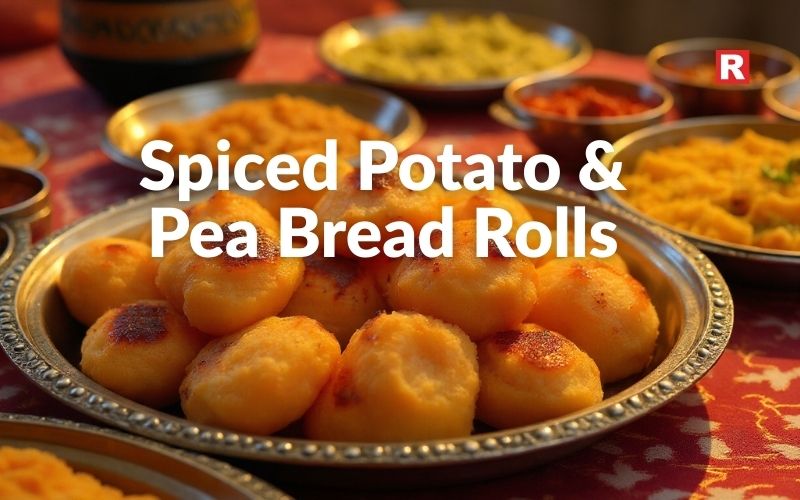
This old-fashioned snack goes well with evening tea. These have a crunchy outside and a soft, delicious potato mixture inside.
- You'll need: Bread slices, boiling and mashed potatoes, boiled green peas, finely chopped ginger and green chilies, turmeric, coriander powder, red chilli powder, and frying oil are all necessary.
- Let's Create It: Add the mashed potatoes and spices to the stuffing after the ginger and chilies have been sautéed. Using a rolling pin, flatten out each piece of bread. Roll the bread firmly, seal the edges with a little water, and place a tablespoon of the potato mixture on one end. Deep-fry till crispy and golden brown.
- Chef's Tip: Instead of deep-frying these, you may bake or air-fry them for a healthier option.
Know more: Sip Smart: Hydrating Drinks to Power You Through Navratri Fasting
3. Garlic Herb Breadsticks

Who knew that making crispy breadsticks at home could take just a few minutes? These are delicious and ideal for dipping in creamy dips or ketchup.
- You'll need: dried herbs like parsley and oregano, melted butter, minced garlic, and sliced bread.
- Let's Create It: Slices of bread should be cut into long strips. Combine the dried herbs, minced garlic, and melted butter in a small bowl. Lightly brush the bread strips on all sides with this mixture. Bake them in a frying pan or an oven that has been preheated until they are crispy and brown.
- Chef's Tip: Try a sweet version by substituting honey and cinnamon for the garlic and herbs.
4. Bread Pizza Bites

These little pizzas are really simple to prepare and quite popular with children.
- You'll need: Grated cheese, your preferred toppings (chopped onions, bell peppers, or corn), sliced bread, pizza sauce or ketchup, and a dash of oregano are all necessary.
- Let's Create It: Slices of bread should be cut into tiny squares. Cover each square with a thin layer of pizza sauce. Top with a good amount of cheese and garnish with preferred toppings, including oregano. Bake in a frying pan or oven that has been warmed until the cheese is completely melted and bubbling.
- Chef's Tip: To make bell peppers appear lively and attractive, combine a variety of colors.
5. Crispy Bread Pakoras
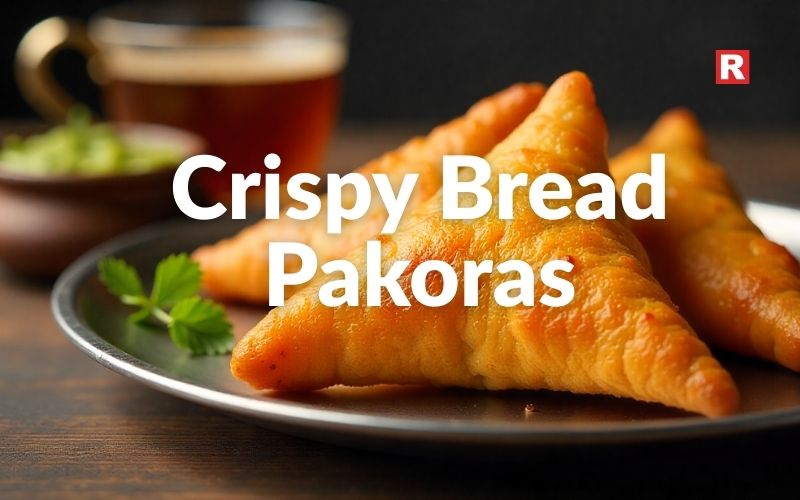
A classic snack of every Indian household. We're keeping it easy and tasty instead of using traditional batter.
- You'll need: Bread slices, besan (chickpea flour), red chilli powder, salt, a pinch of turmeric, asafoetida (hing), and frying oil.
- Let's Create It: Combine the besan, water, and spices to make a thick, smooth batter. Slices of bread should be cut into triangles. Make sure to evenly coat each triangle by dipping it in the batter. Slide gently into hot oil and cook until golden and crispy.
- Chef's Tip: To enhance the batter's flavor, add a sprinkle of carom seeds (ajwain) and a small amount of chopped coriander.
What's new: Easy & Delicious Meal Prep Ideas for a Busy Week
6. Mumbai Pav Bhaji Toast
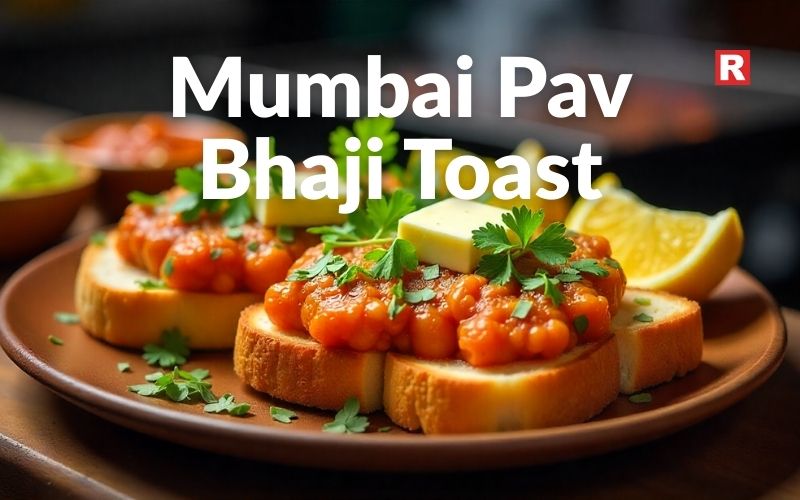
This one will bring the street food of Mumbai into your kitchen. There is a lot of flavor in this quick and sticky snack.
- You'll need: A teaspoon of leftover bhaji or a fast bhaji made with mashed potatoes and veggies, butter, and pav (buns) are required.
- Let's Create It: Melt some butter in a nonstick pan. Put the pav on the buttered pan and give it a quick toast. Now cover one-half of the pav with a thick coating of hot bhaji. Place the other half on top, gently press, and serve right away.
- Chef's Tip: For a taste of real street food, garnish with finely chopped onions and a squeeze of fresh lemon juice.
7. Leftover Roti/Chapati Crisps with Chutney
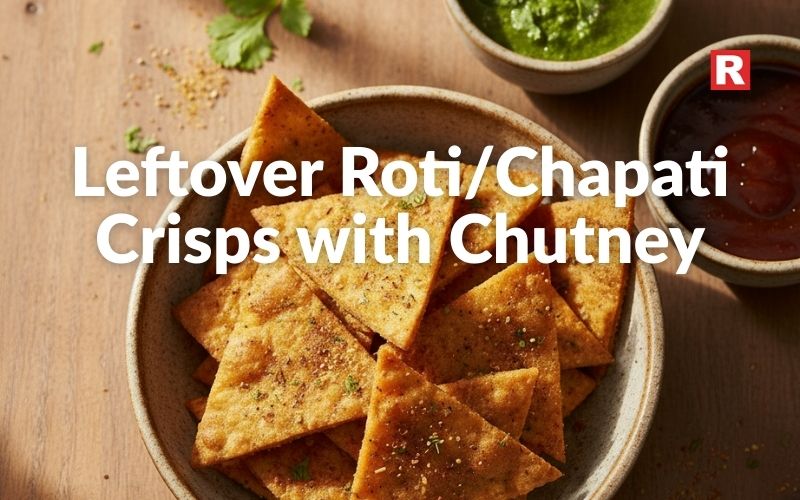
You don't have any bread? No issue! This is the ideal method for utilizing leftover chapatis or rotis.
- You'll need: your preferred chutney (garlic, tamarind, or mint), oil, salt, and leftover rotis.
- Let's Create It: Make little triangles out of the rotis. Sprinkle them with a little salt and lightly oil them. They can be deep-fried for a quick, crunchy snack, pan-roasted until crispy, or baked in an oven.
- Chef's Tip: To give them a tangy, chatpata taste, sprinkle them with a little chaat masala.
8. Bread Upma
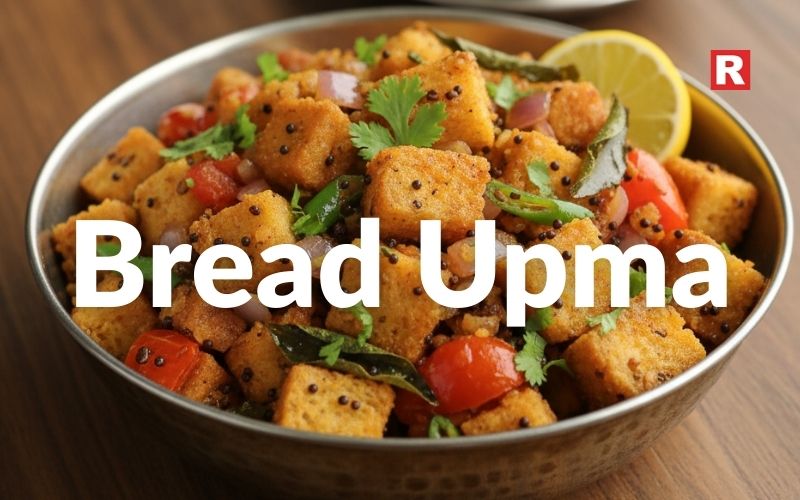
This is a delicious, flavorful breakfast or snack that comes together quickly. It's an excellent method of using up stale bread.
- You'll Need: Bread cubes, chopped tomatoes, onions, curry leaves, mustard seeds, turmeric, and green.
- Let's Create It: Curry leaves and mustard seeds should be fried in a pan. Add the green chilies and onions. Add chopped tomatoes and spices once it's soft. Add the bread cubes after thoroughly mixing. Cook until the bread is tender and has absorbed all of the flavor.
- Chef's Tip: For a delicious crunch, add a handful of roasted cashews or peanuts.
Check out: Best White Bread Brands in India
Top Navratri Dishes You Can Relish Without Guilt
9. Sweet Bread Pudding Cups

Who said only savory bread snacks can be made with bread? This is a sweet treat or a simple, cozy dessert.
- You'll need: Bread cubes, milk, sugar, a small amount of cardamom powder (elaichi), and a few raisins.
- Let's Create It: Soak the bread cubes in warm milk in a bowl until they become mushy. Add the raisins, cardamom powder, and sugar. Transfer the mixture into tiny bowls or cups that are safe to put in the oven, and bake until the top is firm and golden.
- Chef's Tip: For added sweetness, drizzle with honey or condensed milk after baking.
10. Paneer Bhurji Stuffed Bread Pockets
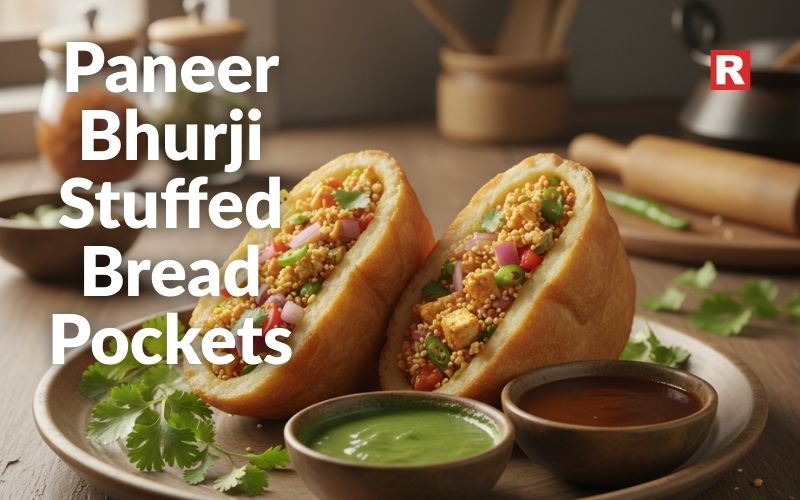
A filling snack that has the texture and richness of a full dinner. They make a filling evening snack and are ideal for lunchboxes.
- You'll need: Bread pieces, paneer bhurji (scrambled paneer with vegetables and spices), and toasting oil.
- Let's Create It: Get your paneer bhurji ready. Using a rolling pin, flatten the bread pieces after cutting off the crusts. Put a teaspoon of paneer bhurji in the middle, fold the bread into a pocket, and use a little water to seal the corners. Put a little oil in a pan and toast the pockets until they are brown and crispy.
- Chef's Tip: To give the paneer bhurji an extra-creamy texture, add additional grated cheese.
Read this: 5 Timeless Indian Sweets That Rule Every Celebration
A Few Final Tips for Your Kitchen
- Prepare ahead: prep in advance by chopping your vegetables and grating your cheese. To make assembly even quicker, store them in sealed containers.
- Master the Pan: If you don't have a fancy oven, don't panic; many of these recipes can be prepared on a basic non-stick pan.
- Engage the Family: Even children can assist with these because they are so easy. Watch them gobble up these small snacks and make it an enjoyable pastime.
Conclusion
Think beyond the box the next time you see that loaf of bread. You can turn it into a variety of tasty, easy, and entertaining snacks with a little imagination and a few basic items from your kitchen. Bread is your key to a world of creative cooking possibilities, from the comforting sweetness of a pudding cup to the spicy crunch of a bread roll. So go ahead, take a chance, and turn your kitchen into a center of delicious creativity.

Vegetarian food in India is not just a choice—it’s a tradition, a culture, and for many, a way of life. While meat-free dining is growing across the world, India has always been a leader in vegetarian cuisine. From the busy streets of Delhi to the global markets of New York and Dubai, Indian vegetarian restaurant brands are making a name for themselves with authentic flavors, rich legacies, and innovative menus. Every region has its own vegetarian specialties. South India is known for its dosas and idlis, while the North offers rich curries, chaats, and thalis. Over time, some restaurant brands have taken these flavors to a larger audience. They have not only built trust at home but also carried Indian vegetarian food to global markets.
In cities like Delhi, Mumbai, and Chennai, these restaurants are household names. Abroad, in places like New York, London, and Dubai, they have given Indians a taste of home and introduced others to authentic vegetarian dining. For anyone who enjoys vegetarian food or wishes to explore it more deeply, the top five restaurant brands in India stand out. They are known for authentic flavors, strong legacies, and memorable dining experiences, here are the top 5 vegetarian restaurant chains in India you must know about.
Read more: High Protein Indian Meals You Should Try
12 Delicious High-Protein Foods to Eat Daily for a Healthier You
Why Vegetarian Restaurants Are Growing in India
India has the largest vegetarian population in the world. For centuries, vegetarian food has been linked with cultural, religious, and regional practices. But today, there’s more to the story.
- Health-conscious eating: Many Indians are shifting towards lighter, plant-based meals.
- Global trends: The rise of vegan and vegetarian dining across the world is pushing Indian brands to expand overseas.
- Affordable yet diverse meals: From simple thalis to elaborate festive spreads, vegetarian restaurants offer something for everyone.
This combination of tradition and modern demand has made vegetarian dining a booming business in India and beyond.
1. Saravana Bhavan – The Global Face of South Indian Cuisine
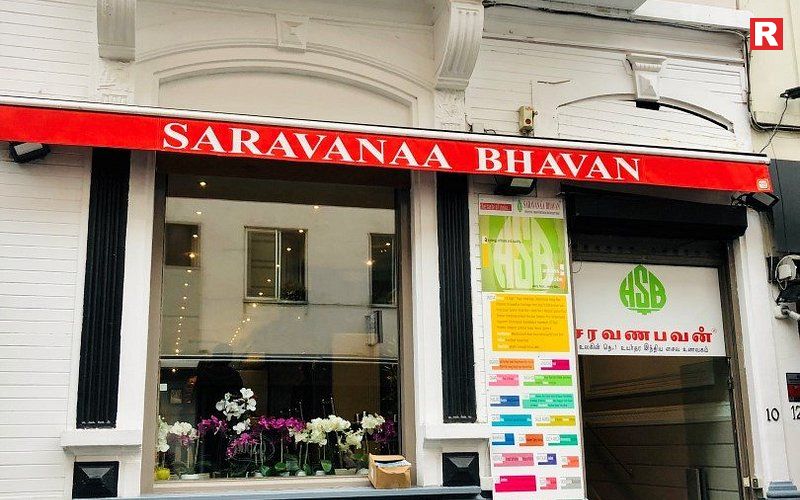
Saravana Bhavan began in 1981 in Chennai, founded by P. Rajagopal. What started as a small eatery soon became the world’s largest vegetarian restaurant chain. The brand is known for authentic South Indian dishes such as dosa, idli, vada, sambhar, and strong filter coffee. Saravana Bhavan is trusted for its consistency in taste across all outlets. Families, office-goers, and students prefer it for affordable yet filling meals. The chain has expanded worldwide, with outlets in the USA, UK, UAE, Canada, and Singapore. Wherever one eats, the flavors reflect the same South Indian tradition.
Why It’s Special
- Famous for authentic South Indian dishes like dosas, idlis, vadas, sambhar, and filter coffee.
- Known for consistency in taste across outlets.
- Offers an affordable yet fulfilling dining experience, which appeals to families and students.
2. Sagar Ratna – North India’s Love for South Indian Food
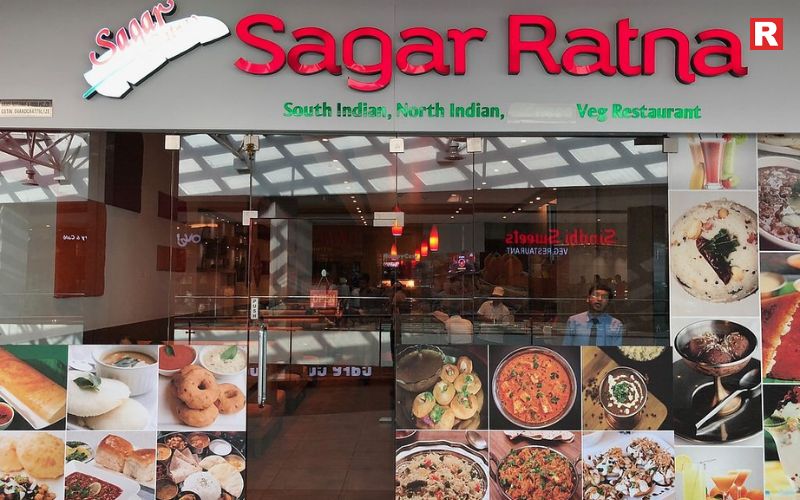
Sagar Ratna was founded in Delhi in 1986 and quickly made South Indian food popular in North India. At a time when dosas and idlis were rare in Delhi, this brand created demand with authentic recipes. Over the years, it expanded to more than 90 outlets across India. Sagar Ratna is famous for its wide range of dosas, from simple plain dosa to creative fusion versions. It also offers North Indian vegetarian dishes to reach a broader audience. The menu is affordable, which makes it popular among college students, families, and working professionals looking for dependable vegetarian food.
Why It’s Special
- Offers both South Indian and North Indian vegetarian dishes.
- Known for its wide variety of dosas, ranging from classic plain dosa to fusion-style versions.
- Affordable pricing makes it a go-to option for college students, families, and office-goers.
Know more: Top 5 States With the Spiciest Food in India
3. Bikanervala – Where Sweets Meet Savory Meals

Bikanervala started as a small sweet shop in Bikaner during the 1950s. From that humble beginning, it has grown into a trusted vegetarian brand with over 100 outlets in India and abroad. It is especially known for its Indian sweets like rasgullas, soan papdi, and laddus, along with savory snacks like bhujia and namkeens. Beyond sweets, the restaurants serve full vegetarian meals, including thalis, chaats, curries, and breads. Bikanervala blends tradition with modern dining formats, making it a favorite for family outings. Many customers also choose it for festive sweets and gifts, keeping its popularity alive across generations.
Why It’s Special
- Famous for its Indian sweets and snacks like rasgullas, soan papdi, bhujia, and namkeens.
- Offers a full range of vegetarian meals including thalis, chaats, North Indian curries, and breads.
- Combines tradition with modern outlets, making it a popular family dining spot.
4. Haldiram’s – The Household Name

Haldiram’s was founded in 1937 in Bikaner and has since become one of India’s biggest food brands. It began as a small sweet and snack business but today operates as a global vegetarian chain. The brand is known for its packaged snacks like aloo bhujia, sev, and namkeens, which are household staples. In addition to snacks, its restaurants serve North Indian thalis, South Indian tiffins, and even Indo-Chinese platters. Haldiram’s has expanded internationally, reaching countries with large Indian communities. It is trusted for quality, consistency, and variety, making it one of the most recognized vegetarian food brands worldwide.
Why It’s Special
- Known for snack products like aloo bhujia, namkeens, and packaged sweets.
- Their restaurants serve a wide range of vegetarian meals—from North Indian thalis to Chinese platters.
- The brand has expanded internationally, making it one of the most recognized Indian food names worldwide.
Also check: Top Navratri Dishes You Can Relish Without Guilt
5. Rajdhani Thali – A Feast of Tradition
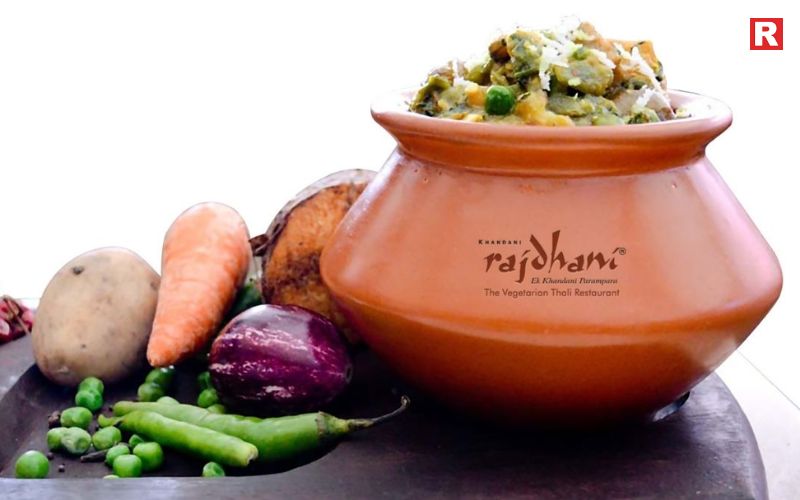
Rajdhani Thali is known as the “thali restaurant of India.” It specializes in Rajasthani and Gujarati cuisine, served in unlimited thalis. Each visit feels unique, with more than 72 rotating menus and over 22,000 different dishes served to date. The restaurant is famous for its warm service, where staff ensures diners enjoy every dish with traditional Indian hospitality. Rajdhani brings regional flavors like dal baati churma, kadhi, and aamras puri to city diners across India. The thali experience is more than a meal—it is a cultural celebration. For many, Rajdhani is the true taste of home and tradition.
Why It’s Special
- Offers unlimited thalis with authentic Rajasthani and Gujarati dishes.
- Famous for its warm hospitality, where staff serves food with traditional Indian warmth.
- A great way to explore India’s regional vegetarian cuisine.
The Vegetarian Dining Market in India
The Indian food service industry is currently valued at over Rs 5 trillion, and vegetarian dining holds a major share of this market. Quick-service vegetarian brands like Haldiram’s and Bikanervala dominate urban markets, while traditional thali restaurants like Rajdhani attract both domestic and international tourists.
Globally, Indian vegetarian brands are also gaining traction, especially as more people adopt plant-based diets. Brands like Saravana Bhavan and Haldiram’s are now global ambassadors of India’s rich vegetarian heritage.
Check more: 5 Timeless Indian Sweets That Rule Every Celebration
5 Delicious Snacks to Enjoy This Navratri Season
Top Rajasthani Dishes to Try This Festive Season
Final Thoughts
Vegetarian food in India is more than just dal, roti, or sabzi—it’s an endless variety of flavors, traditions, and innovations. The top 5 vegetarian restaurant brands—Saravana Bhavan, Sagar Ratna, Bikanervala, Haldiram’s, and Rajdhani Thali—show us how rich and diverse India’s vegetarian culture is.
Whether you are looking for authentic South Indian food, festive sweets, spicy chaats, or a royal thali, these brands have something special to offer. They are not just restaurants; they are experiences that bring families together and take Indian vegetarian cuisine to the world.

White bread has been a part of Indian kitchens for many years. It is a common choice for breakfast, snacks, and quick meals. Children often enjoy a slice of toast with butter or jam before school. Adults use it to make sandwiches for work or late-night snacks. Its soft texture and mild taste make it easy to eat and versatile for many recipes. Today, there are many types of bread available in India. Brown bread, multigrain bread, and gluten-free bread are becoming more popular. However, white bread remains a favorite in most households. It is simple, light, and easy to pair with different foods.
Not all white bread is the same. Some brands focus on freshness. Others focus on softness or taste. A few brands offer premium options that stay fresh longer. Price, availability, and ingredients also vary from brand to brand. For anyone looking to choose the best white bread, understanding these differences is important. The choice depends on taste, budget, and quality. This guide highlights the top white bread brands in India and the key facts every buyer should know before making a decision.
Read more: 21 Different Types of Indian Breads and Their Benefits
A Guide to Different Breads and Their Nutritional Value
Top White Bread Brands in India
Top white bread brands in India include Britannia, Modern, Harvest Gold, English Oven, Fresho, Bonn, and Wibs for freshness and softness.
1. Britannia
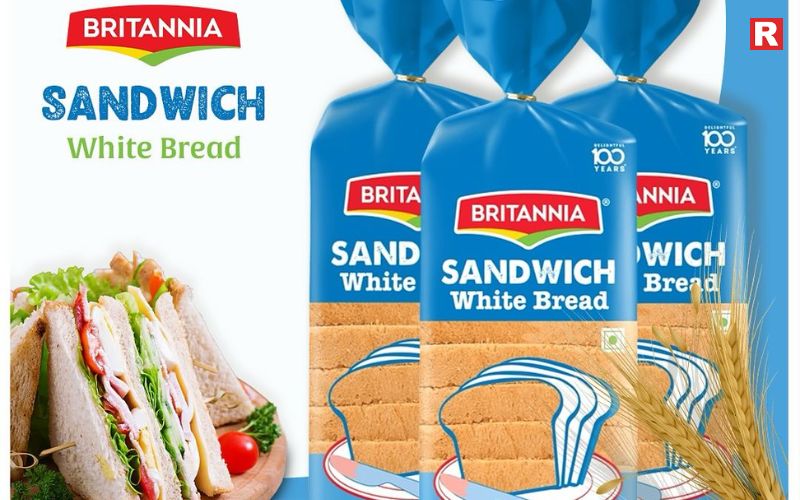
Britannia is one of the most trusted names when it comes to packaged food in India. Its white bread is soft, consistent in taste, and easily available in almost every city and town. Many families prefer Britannia because of its reliable quality and decades-long reputation. If you are looking for a daily bread option that never disappoints, Britannia is often the first choice.
2. Modern Bread
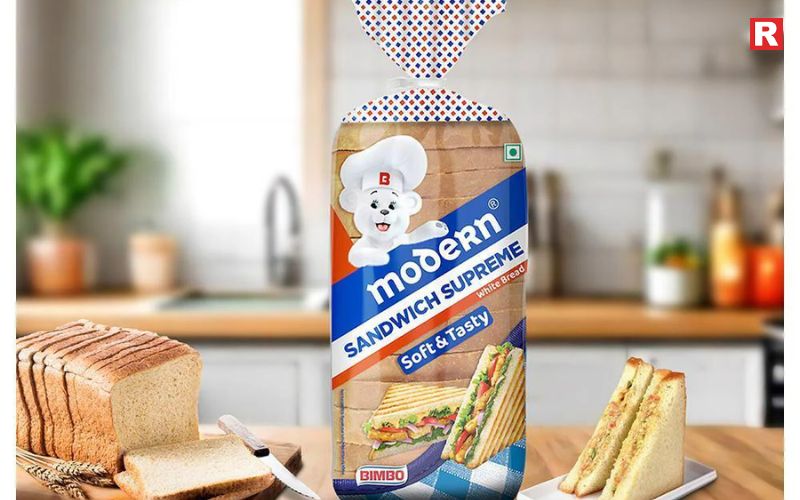
Modern Bread is one of the oldest packaged bread brands in India. It has a loyal customer base because of its freshness and affordable pricing. The brand has a strong presence across India, making it easy for people to find it in local shops. The texture is fluffy and works well for sandwiches, bread rolls, or just plain toast.
Know more: Pani Puri Has Different Names in Different Indian States—Know Them All
3. Harvest Gold
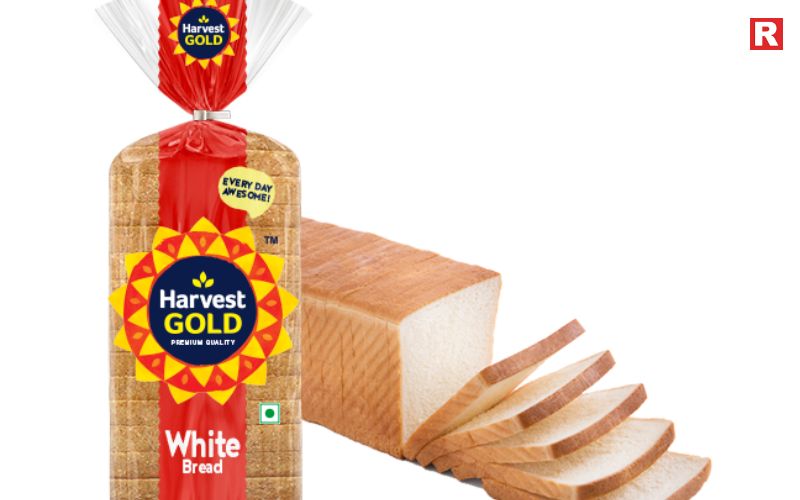
Harvest Gold has grown rapidly in the Indian bread market, especially in metro cities. Its white bread is known for being extra soft and airy, making it a favorite for sandwich lovers. The brand positions itself as slightly premium compared to others, but the quality often justifies the price. If you want bread that feels fresh even after a few hours, Harvest Gold is worth considering.
4. English Oven
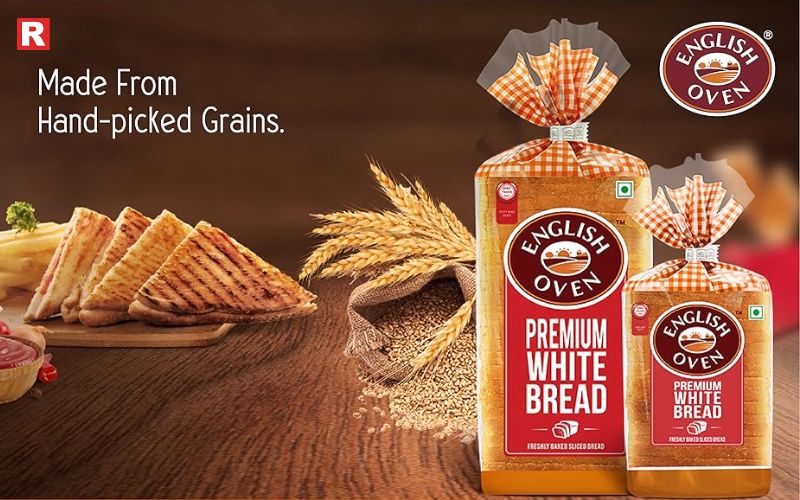
English Oven is a premium bread brand that has gained popularity for its longer shelf life and high-quality ingredients. Unlike mass-market bread, English Oven focuses on giving a bakery-style feel in packaged form. Its slices are thick, soft, and perfect for gourmet sandwiches. Many people prefer English Oven when they are looking for something more than just basic white bread.
5. Fresho (BigBasket)

With the growth of online grocery shopping, Fresho from BigBasket has become a popular name. Fresho white bread is baked fresh daily and delivered quickly through the platform. For urban customers who prefer buying groceries online, Fresho offers both convenience and freshness. It is also priced competitively, making it a good choice for everyday use.
6. Bonn Bread
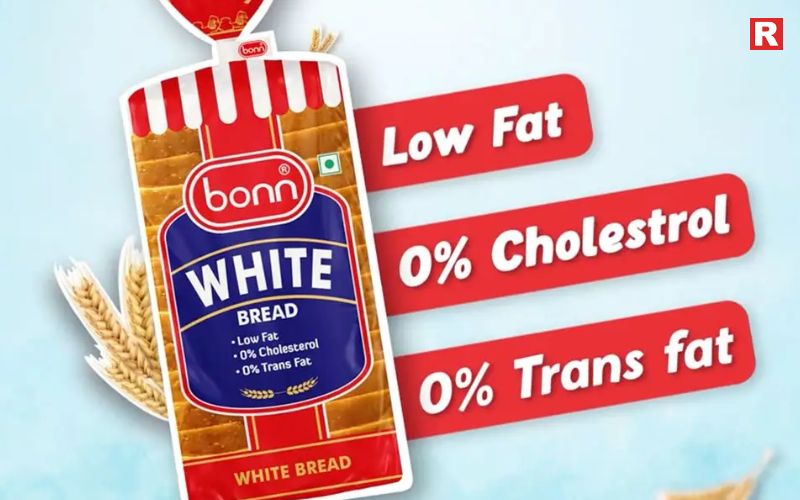
Bonn is a major bread brand with strong roots in North India. Known for its softness and rich taste, Bonn white bread is widely consumed across Punjab, Haryana, and Delhi. The company has also expanded its distribution to other parts of the country. For families in North India, Bonn is almost a household name when it comes to bread.
7. Wibs Bread
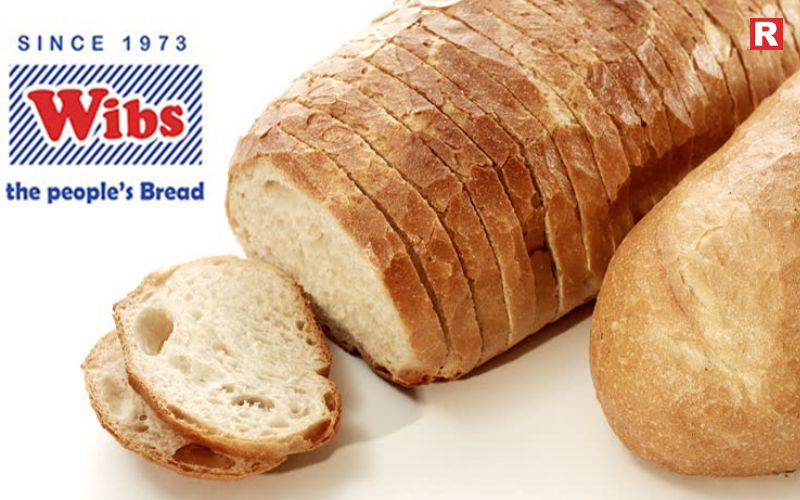
If you are from East India, especially Kolkata, you probably grew up with Wibs bread. It is a legacy brand that has been around for decades. Wibs is known for its fluffy texture and unique taste. Many families in that region will tell you they trust only Wibs for their daily breakfast.
Also check: 12 Delicious High-Protein Foods to Eat Daily for a Healthier You
Facts About White Bread in India
- Market Value: The packaged bread market in India is valued at more than ₹5,000 crore and is growing steadily every year. White bread makes up the largest share of this market.
- Shelf Life: Most packaged white bread stays fresh for 3–5 days. This short shelf life is one reason people prefer buying fresh packets every two or three days.
- Nutritional Value: White bread is high in carbohydrates but low in fiber compared to whole wheat or multigrain bread. This makes it a quick energy source but not the healthiest choice.
- Additives and Preservatives: To keep bread soft and fresh, brands add small amounts of preservatives. These are generally safe but always check the ingredients if you are health conscious.
- Popularity: More than 90% of Indian households consume bread at least once a week, making it one of the most common packaged foods in the country.
- Cultural Connection: The sandwich became a popular household snack in India mainly because of the easy availability of white bread. Over time, it has become part of our daily food culture.
White Bread vs Other Types of Bread
While white bread is the most common, other options like brown bread and multigrain bread are becoming popular.
- White Bread: Soft, affordable, versatile, and widely available.
- Brown Bread: Higher in fiber, marketed as a healthier option.
- Multigrain Bread: Contains multiple grains, often considered more nutritious.
Despite these options, white bread continues to dominate because of its affordability, mild taste, and ability to pair with almost anything.
How to Choose the Best White Bread
Before picking a packet from the shelf, here are a few things you should check:
- Freshness: Always look at the manufacturing date. Bread tastes best when it is fresh.
- Ingredients: Read the label for added sugar, oil, or preservatives. Some brands use better quality ingredients than others.
- Brand Trust: Established brands like Britannia, Modern, or Harvest Gold have strict quality checks, making them more reliable.
- Packaging: Ensure the seal is intact. Good packaging keeps the bread safe from moisture and contamination.
Check more: Domino’s 4-Course Meal— The Ultimate Lunch Deal You Can’t Miss
5 Foods to Avoid for Better Cholesterol
5 Delicious Snacks to Enjoy This Navratri Season
Why White Bread Still Rules Indian Kitchens
Even though people are becoming health conscious, white bread remains the top choice in India. The reasons are simple:
- It is affordable compared to other types of bread.
- It is soft, neutral in taste, and works for both sweet and savory dishes.
- It is available everywhere—from big supermarkets to small neighborhood shops.
- It is part of tradition. Many of us grew up eating white bread, and that emotional connection keeps it alive in our homes.
The Bottom Line!
White bread may not be the healthiest choice, but it remains one of the most popular foods in India. Many households prefer it because it is soft, light, and easy to eat. Brands such as Britannia, Modern, Harvest Gold, English Oven, Fresho, Bonn, and Wibs are trusted across the country. They are known for their consistent quality, freshness, and reliable taste. People use white bread in many ways. It is often served as toast for breakfast. It is a favorite for sandwiches, snacks, and even quick meals. Its mild taste makes it easy to pair with both sweet and savory ingredients. Families of all ages enjoy it daily.
Choosing the right white bread depends on freshness, quality, and personal taste. Checking the label is important. Fresh bread tastes better and stays soft longer. Moderation is also key since white bread is high in carbohydrates and low in fiber. Beyond nutrition, white bread holds a place in Indian life and memories. From school tiffins to late-night snacks, it has been a comfort food for generations. It is more than just food—it is a part of daily life, tradition, and simple joys that people continue to enjoy.

In the modern world, where everyone is living a hectic life, the prospect of a home-cooked lunch frequently seems unattainable. People have hectic schedules, and by the time they get home, ordering takeout or opting for a quick, unhealthy snack is usually the easiest option. This cycle can harm both health and finances in the long run. However, what if we tell you that there is an easy and long-term fix to this problem? Using Meal Prepping to prepare entire meals and supplies ahead of time can save money, time, and your sanity.
We'll go over a number of easy, delicious, and flexible options that satisfy a range of tastes and busy schedules in this article, so you can enjoy a week of nutritious meals without the usual chaos in the kitchen.
Read more: Fusion Fever: Global Flavours Redefining Gen Z Dining and Home Cooking
The Meal Prep Mindset: Planning for Success

An effective meal prep routine involves more than just cooking; it involves changing the way you think about eating. It helps to plan a little before you even enter the kitchen.
- Establish a Weekly Meal Plan: To begin, list the meals you intend to consume during the coming week. Think about what you already have in your pantry and what you need to purchase. This way, food waste and impulse buying are avoided as a result. For your first few tries, stick to easy, classic recipes rather than complicating things too much. A theme-based strategy, such as "soup Thursdays" or "rice bowl Mondays," can further simplify planning.
- Make a Smart Shopping List: Make a detailed grocery list based on your meal plan. To save time when shopping, arrange it according to the departments of the grocery store (produce, pantry, dairy, etc.). Long-term cost savings can be achieved by purchasing staples like grains, lentils, and spices in bulk.
- Select Your Cooking Day: Set aside one to two hours on a particular day, usually a Sunday, to prepare your meals. Consider this to be your weekly self-care routine. Make it a fun exercise rather than a chore, turn on some music, and grab a cup of coffee.
- Invest in Good Storage: Your best buddies are high-quality, airtight containers. Glass containers are great since they don't break when they go from the refrigerator to the oven or microwave. Your food stays fresh and well-organized when it is stored properly.
The Foundation of Your Meals

Cooking basic ingredients in large quantities and assembling them in multiple ways throughout the week is the most effective method of meal preparation. Consider them the "building blocks" of your meal.
Master Grains: Grains make the ideal foundation for a variety of dishes. Cook a big pot of your preferred grain, such as protein-rich quinoa, nutritious brown rice, or fragrant basmati rice. This is where a pressure cooker comes in handy because it cooks grains and beans in a fraction of the time. Allow them to cool fully after cooking and then store them in airtight containers.
Versatile Proteins: The foundation of a well-balanced meal is a powerful protein.
- Dal Lentil Curry: This easy lentil Curry is a meal prep powerhouse. It is very adaptable, nourishing, and comforting. Make a large pot of simple red or yellow lentil curry with a few spices; you can simply add more or different vegetables or seasonings later.
- Spiced Chickpeas: Add a variety of common spices, such as turmeric, coriander, and cumin, to a large pan of sautéed chickpeas. You may use this mixture for wraps, rice bowls, or even as a quick snack.
- Roasted Paneer or Tofu: Cubes of paneer or tofu should be cut, mixed with a little oil, salt, and spices, and then roasted till golden. This gives any meal a wonderful texture and an excellent amount of protein.
Preparing Vegetables: At the start of the week, wash, chop, and store your vegetables.
- Roast them all: Broccoli, bell peppers, carrots, sweet potatoes, and other veggies should all be tossed with olive oil, salt, and pepper before being roasted on a single tray. You can add them to any dish afterwards throughout the week.
- Sautéed Greens: Add a little garlic to a big pot of spinach or other greens and sauté them. They can be served as a side dish or added to wraps or rice bowls.
Know more: 5 Timeless Indian Sweets That Rule Every Celebration
Themed Meal Prep Ideas: Putting it All Together
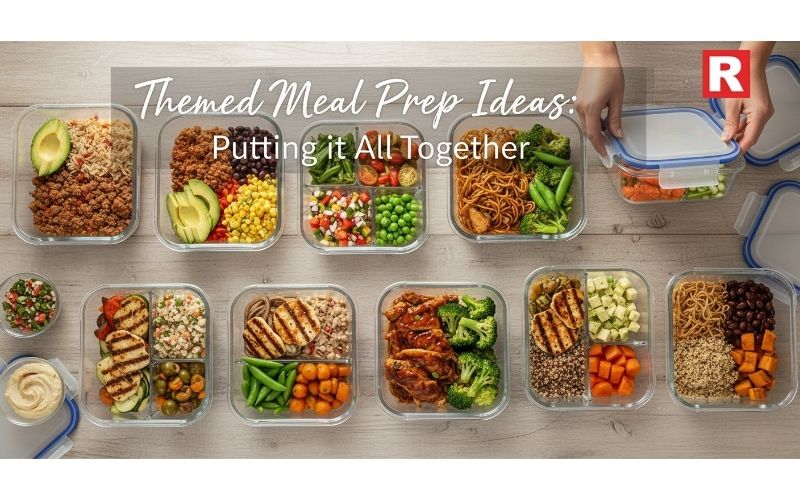
It's easy to assemble once your building blocks are ready. To help you get started, here are three theme-based ideas:
1. The Customizable Rice Bowl: The Ideal "mix and match" supper is the Rice Bowl with Customization.
- Base: Divide the brown or basmati rice you've already cooked into individual containers.
- Protein: Include some spicy chickpeas or your lentil curry.
- Vegetables: Place your roasted veggies on top.
- Final Touches: Include fresh garnishes like pickled onions, a spoonful of plain yogurt, chopped fresh coriander, or a dash of lemon juice in your package separately. This gives everything a last taste boost right before eating and keeps everything fresh.
2. The Simple Roll or Wrap: Ideal for an on-the-go lunch.
- Wrap: Use your preferred flatbread, whole wheat rotis, or tortillas.
- Filling: Mix sautéed vegetables with precooked protein (such as roasted paneer or tofu, or spiced chickpeas).
- Sauce/Spread: Fill each container with a ready-made dab of hummus or a basic yogurt-mint sauce.
- Assembly: Just reheat the flatbread, stuff it with the prepared contents, and roll it up on the day.
3. The Hearty Soup or Stew: This warming dish is ideal for chilly weather.
- Base: Make a substantial lentil-based soup or vegetable stew in a big pot. A combination of tomatoes, peas, potatoes, and carrots can be used.
- Protein: Top the base with some of your cooked lentils or chickpeas.
- Portioning: Ladle the soup into separate containers to portion it out. It just requires a quick reheat and also stores well.
- Serving Suggestion: For a full meal, serve with a slice of bread or a side of your prepared rice.
What's new: 10 Surprising Health Benefits of Having Plant-Based Diet
Meal Prep for Breakfast & Snacks
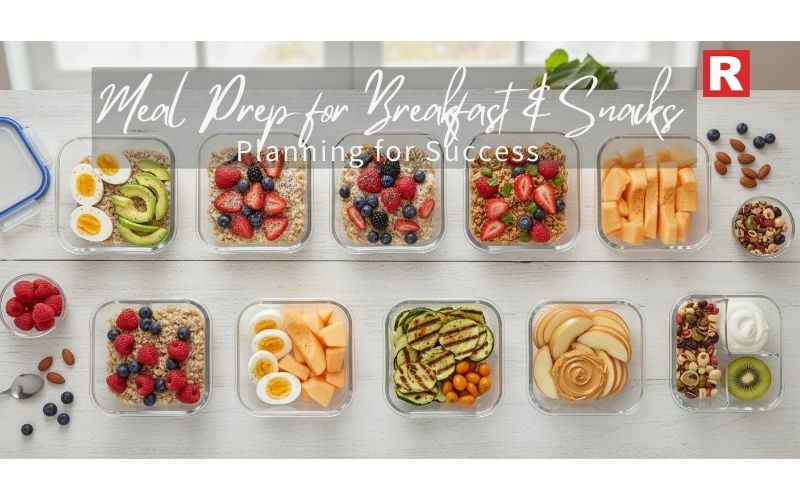
Preparing meals isn't limited to lunch and dinner. You can prevent making unhealthy decisions throughout the day by organizing your lunchtime snacks and your first meal.
- Overnight Oats: A ready-to-eat breakfast that doesn't require cooking. Put rolled oats, your preferred milk, and a sweetener in a container. Add your preferred toppings, such as nuts, fresh fruit, or a spoonful of yogurt, in the morning.
- Fruit and Nut Mix: This is a classic dish. Make individual packets of seeds, dried fruits, and mixed nuts for a snack that will give you more energy.
- Boiled Eggs: A handful of hard-boiled eggs can be a protein-rich salad addition or a fantastic on-the-go snack.
Check out: 5 Key Features a Restaurant Pizza Oven Should Have
10 Must-Try Goan Dishes That Define Its Rich Food Culture
The Spice of Life: Meal Prep Tips & Tricks
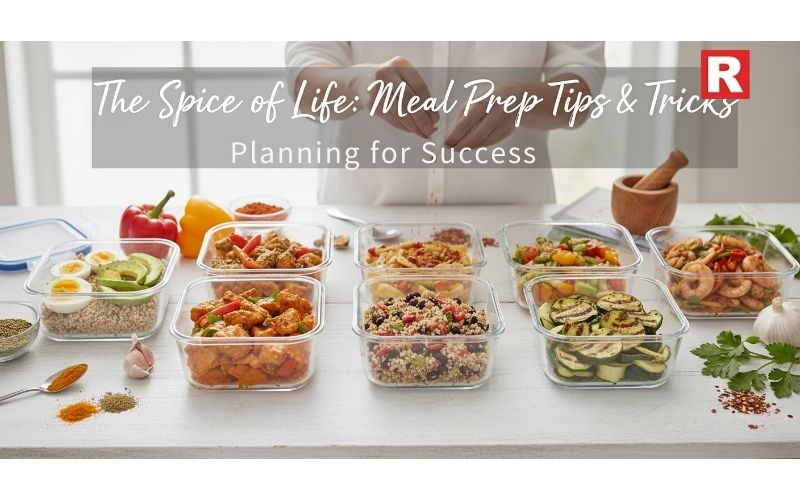
Even if the basic steps are simple, there are a few little tricks that can improve the efficiency and flavor of your meal preparation.
- The Power of the Pressure Cooker: Every meal prepper needs this gadget. It significantly reduces the amount of time needed to prepare grains, lentils, and even difficult veggies, allowing for a week's worth of preparation in just one hour.
- Don't Cut Back on Spices: Although you may make a base with little to no seasoning, have a small number of basic spices on hand so you may add them the day of serving. A pinch of garam spice in your lentil curry or a simple sprinkle of chaat masala on your chickpeas can completely change the flavor profile.
- Fresh is Best: Always have fresh herbs on hand, such as ginger, mint, and coriander. Your reheated dinner will taste freshly prepared and pleasantly enhanced by adding a handful of freshly chopped herbs.
- The Yogurt Fix: When mixed with spicy foods, a scoop of plain, unsweetened yogurt or raita (yogurt with chopped cucumber and mint) can bring a cool, creamy touch to a meal.
Meal Prep Safety and Best Practices

- Cool Down First: Avoid putting hot food in the fridge right away. To stop bacteria from growing and to safeguard other goods in the refrigerator, let it drop to room temperature first.
- Use Airtight Containers: To preserve freshness and stop food from absorbing other smells in the refrigerator, seal your meals in airtight containers.
- The 4-5 Day Rule: Most prepared foods are best consumed within four to five days, according to the "4-5 Day Rule."
- Freeze for Longevity: To preserve freshness and safety, freeze meals that are meant for later in the week.
- Reheat Completely: To kill any bacteria, always reheat food until it is steaming hot throughout.
Read this: Top 7 Tips for Efficient Energy Management in A Restaurant Kitchen
Conclusion
Meal preparation gives you control over your time, money, and health; it's more than simply a passing trend. It lessens the temptation to eat unhealthy fast food and takes away the everyday worry of deciding what to eat. A week of delicious, wholesome, and stress-free meals may be unlocked by investing a little effort in preparation and bulk cooking. Begin slowly, learn one recipe at a time, and then progressively establish a schedule that suits you. Your finances and future self will appreciate it.

Food today crosses borders. It is not tied to one culture or one place. It has become global, diverse, and always changing. One of the biggest changes in recent years is the rise of fusion flavours. These are dishes that mix global styles with local twists. They are winning hearts everywhere.
Fusion food is no longer just a restaurant trend. It has made its way into home kitchens. It is shared on social media. It has become a part of the daily meals of young people, especially Gen Z. From sushi tacos to butter chicken pasta, the craze is strong. These dishes may sound unusual at first. But they offer both comfort and excitement. They give people something new without losing the taste of the familiar. Gen Z is driving this trend. They look for variety and creativity. They enjoy food that tells a story. They are open to experiments and new flavours. Fusion food shows how culture and taste can meet on a single plate. It is a sign of changing times, where food is not about rules but about mixing and enjoying.
Read more: Top 7 Regional Indian Thali Platters That Showcase Culinary Diversity
10 Steamed Indian Dishes Beyond Idli & Dhokla
The Fusion Craze
Fusion food is not new. Chefs across the world have experimented with combining flavours for decades. But what makes it unique today is how quickly it has spread to the mainstream. Social media has played a big role. A quirky dish gets posted, goes viral, and suddenly, everyone wants to try it at home.
Think of ramen burgers, Maggi sushi, or tandoori momos. They may sound unusual at first, but that is exactly why people are curious. The more different it is, the more likely it is to attract attention.
Why Fusion Works So Well
Fusion food works because it strikes the right balance. It takes something familiar and adds a layer of surprise. For example, pizza is loved worldwide. Add a butter chicken topping, and suddenly, you have something exciting but still comforting.
Another reason is that fusion is highly visual. These dishes look colourful, creative, and fun. On Instagram or YouTube, they get shared instantly. For a generation that eats with the eyes before the taste buds, this is a winning factor. Cost is another reason. Cooking fusion recipes at home does not always require high-end skills. With easy ingredient swaps, home cooks can make international-inspired meals without spending too much.
Gen Z and the Fusion Connection
No group has embraced fusion flavours as much as Gen Z. They are adventurous with food. They don’t want to eat the same thing every day. They want food that tells a story. Gen Z has grown up in a connected world. Travel shows, Netflix food series, YouTube cooking videos, and TikTok trends expose them to cuisines beyond borders. A student in Delhi can try making Korean bulgogi, while someone in Bangalore experiments with Mexican-style samosas.
Food is also about identity for this generation. Posting a photo of butter chicken tacos is not just about the taste—it is about expressing creativity. It becomes a part of lifestyle and community.
Fusion in Home Kitchens
Earlier, fusion was something you only found in fancy restaurants. Today, it is a regular part of home kitchens. Quick recipes like paneer quesadillas or spaghetti with Indian tadka are easy to make. Fusion desserts are also trending, such as matcha kulfi or chocolate samosas. The growth of global ingredients in supermarkets has played a huge role. A decade ago, it was hard to find things like avocado, quinoa, or gochujang in India. Today, these are available not just in metros but also in smaller cities. Quick commerce apps like Zepto, Blinkit, and Instamart make it even easier. A home cook can order sriracha or tortillas in minutes.
For many, cooking fusion at home is also about fun. Families experiment together, trying dishes they saw online. It adds variety to everyday meals and makes cooking less routine.
Know more: Top Rajasthani Dishes to Try This Festive Season
Fusion in Restaurants and Cafés
Restaurants too are rethinking their menus. Many cafés now serve global-local combinations to attract younger diners. You will find pasta with Indian spices, tacos with paneer fillings, or even cocktails with desi flavours like paan and tamarind.
Desserts are also being reinvented. Cheesecakes with gulab jamun, rasmalai tiramisu, and filter coffee panna cotta are becoming crowd favourites. Fusion is not just about combining cuisines—it is about creating experiences. Chefs are also blending regional Indian dishes with global flavours. For example, Goan chorizo pizza or Hyderabadi biryani arancini balls. These dishes showcase local heritage while making it accessible to global palates.
Market Value and Growth
The demand for fusion is not just cultural, it is also commercial. The global food fusion market has grown steadily, driven by consumer demand for novelty. In India, the trend is supported by two key factors:
- The quick commerce boom – Gen Z can access global ingredients in record time. This makes fusion easier at home.
- Rising disposable incomes – Young professionals are willing to spend on dining experiences and food experiments.
Food delivery apps like Swiggy and Zomato also contribute. They often highlight fusion menus, promote special offers, and make it easy for young diners to try new dishes. Restaurants have noticed that menus with fusion options often perform better. A survey by local F&B consultants shows that younger diners are more likely to revisit a restaurant if the food feels unique and shareable.
Why Fusion is Here to Stay
Some food trends fade quickly. Fusion, however, seems to be here for the long run. The main reason is cultural curiosity. Today’s youth do not see food as limited to borders. For them, a kitchen is a place where any flavour can meet another. Fusion also aligns with the idea of personalization. People want to make food their own. Mixing cuisines allows them to create something that feels unique. As more global brands enter India and more local chefs innovate, the trend will only grow. What started as an experiment is now part of everyday dining.
Also check: Festive Seasons Are Changing the Restaurant Industry in India
The Top 7 Sweet Dishes You Can’t Miss This Durga Puja
Frankenstein-Inspired Foods and Drinks for Your Spooky Celebrations
A Taste Without Borders
Food today is less about rules and more about freedom. It is about mixing, matching, and enjoying. Fusion flavours have created a new way for people, especially Gen Z and home cooks, to connect with what they eat. They find comfort in traditional roots but also enjoy the thrill of something new.
When butter chicken blends with pasta, or sushi takes a desi twist with chutney, it reflects the changing nature of food. Dishes are no longer limited to their origins. Instead, the kitchen has become a playground where flavours from across the world can meet on one plate. The rise of fusion is about more than taste. It reflects creativity, culture, and self-expression. For Gen Z, food is not just a meal—it is an identity and a story they share. Fusion speaks their language, one that celebrates both heritage and curiosity.

Navratri is one of the most vibrant festivals in India. It is a celebration filled with music, dance, devotion, and traditions that bring people together. Homes during this time are buzzing with joy, laughter, and the aroma of festive food. Families gather for prayers, cultural events, and evenings filled with garba and dandiya. Along with the celebrations, food plays a central role.
During Navratri, many people follow special diets or fasting rules. That does not mean food has to be boring or limited. In fact, this is the time when vrat-friendly snacks and sweets bring both energy and happiness to the table. Whether you are hosting guests, enjoying time with your family, or looking for something quick between festivities, the right snack adds flavor and fun. If you are searching for light, wholesome, and delicious bites this Navratri, here is a list of 5 snacks that combine tradition with taste. Each of these has its own charm, and they are perfect to keep you energized while you enjoy the festival.
Read more: Top 7 Regional Indian Thali Platters That Showcase Culinary Diversity
12 Delicious High-Protein Foods to Eat Daily for a Healthier You
1. Handmade Almond Cookies from Bakingo

When you think of festive snacking, cookies may not be the first thing that comes to mind. But Bakingo’s Handmade Almond Cookies are a refreshing change. These cookies are crunchy, flavorful, and light on the stomach. At the same time, they are filling enough to keep you going through the day.
Made with roasted almonds, these artisanal cookies are completely eggless, making them ideal for Navratri. The nutty crunch balances perfectly with their melt-in-mouth texture, creating a sweet snack that works for both adults and children.
What makes them even better is their versatility. You can place them on your dessert table, serve them to guests with tea, or enjoy them during an afternoon craving. They also make a thoughtful gift if you are visiting family or friends during the festival. The handmade touch gives them authenticity, while the almonds provide both flavor and nutrition.
Price: Rs. 329
2. Protein Pops, Sea Salt & Pepper from 4700 BC
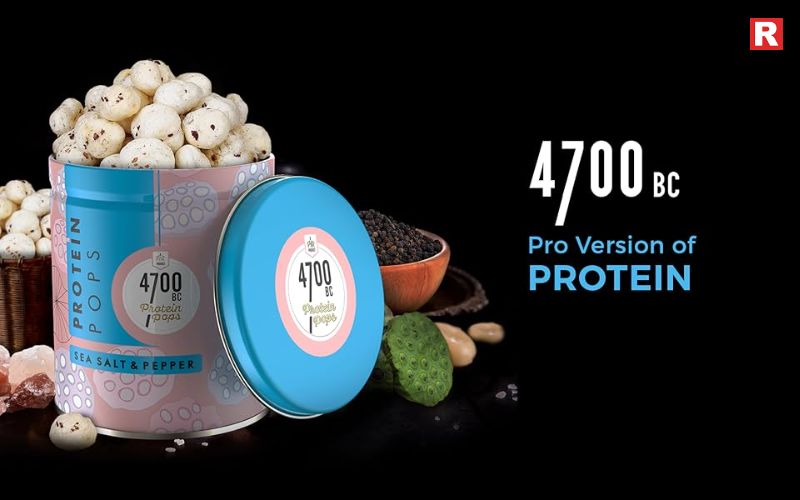
Makhana, or fox nuts, have long been associated with Navratri fasting. They are light, healthy, and full of energy, making them an excellent choice when you want something quick yet nourishing. 4700 BC has taken this traditional ingredient and given it a modern twist with their Protein Pops – Sea Salt & Pepper.
These crunchy pops are made from popped fox nuts and seasoned simply with sea salt and pepper. The flavor is mild, natural, and perfect for fasting days. They are also Non-GMO, gluten-free, and vegan, which means they suit a wide range of dietary needs.
One of the biggest advantages is their nutritional value. With more plant protein than milk, they provide energy without making you feel heavy. Packed in an easy travel tin, they are convenient to carry to garba nights, gatherings, or even when you’re on the go. If you want a guilt-free festive snack that keeps up your energy levels, this one is a must-have.
Price: Rs. 190
Know more: Top Rajasthani Dishes to Try This Festive Season
3. Yellow Banana Chips – Banana Wafers from Chheda’s
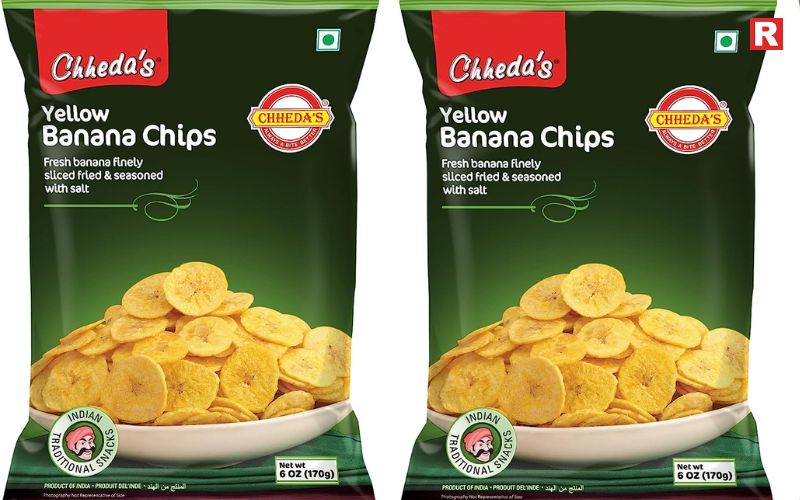
Banana chips are a classic Indian snack, and during Navratri they become even more special. Chheda’s Yellow Banana Chips bring tradition and taste together in every bite. Made from raw bananas, these chips are sliced thin, fried until golden, and sprinkled with just the right amount of salt.
They are crisp, light, and easy to digest. The best part is that they are vrat-friendly, so you can enjoy them even while following your fasting rules. They make the perfect companion for tea-time or can be served as a quick bite to guests.
Chheda’s uses natural ingredients and traditional methods, which means you get authentic taste with every pack. Their chips are not just about crunch, but also about celebrating the spirit of Indian snacking. On festive evenings, a bowl of these banana wafers on the table is sure to bring smiles all around.
Price: Rs. 160
4. Paper Boat Crushed Chikki Peanut Bar
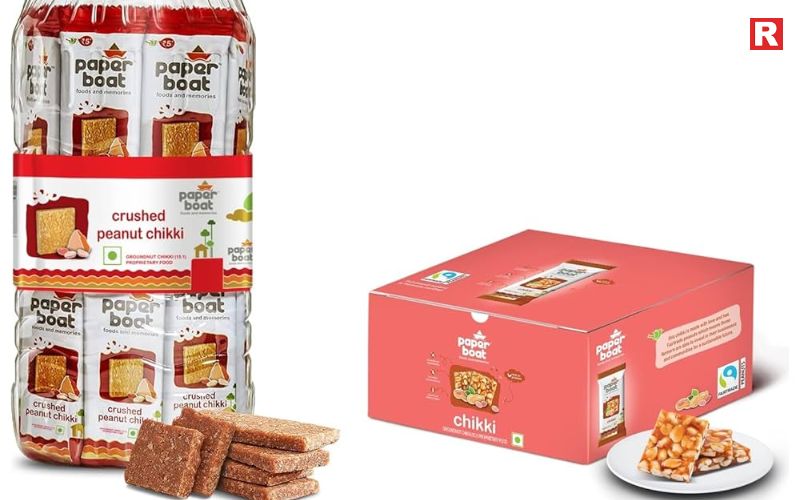
No festive season is complete without a little sweetness. Paper Boat’s Crushed Peanut Chikki Bar is the perfect sweet snack for Navratri. It is light, wholesome, and full of traditional flavor. Made from roasted, crushed peanuts and natural jaggery, this bar has no artificial colors or preservatives. It is portioned into 16 g bars, making it easy to carry and share. The sweetness of jaggery pairs beautifully with the crunch of peanuts, giving you a quick energy boost.
Chikki is a traditional Indian sweet often enjoyed during winters and festivals. With Paper Boat’s modern packaging, you can enjoy the same nostalgic taste in a handy bar. It is ideal for when you want something sweet after a meal, or when you are heading out for festive gatherings.
Price: Rs. 322
Also check: The Top 7 Sweet Dishes You Can’t Miss This Durga Puja
5. Prolicious Methi Khakhra
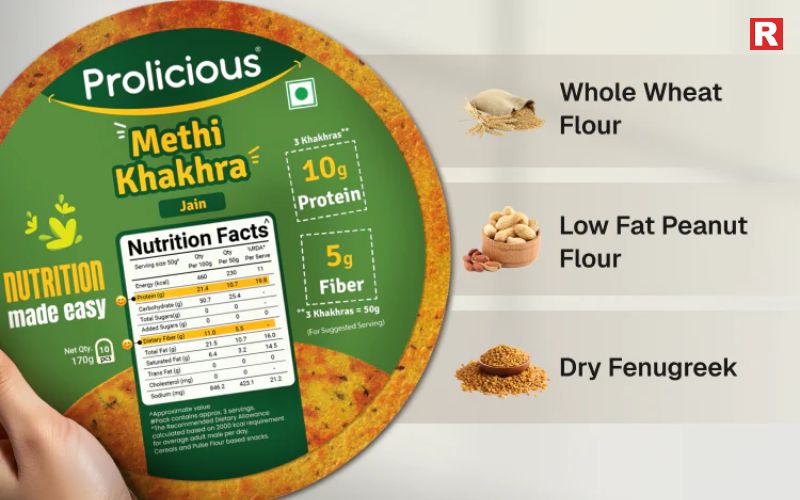
If you are looking for a savory option that is healthy, filling, and flavorful, Prolicious Methi Khakhra is a great choice. Khakhra has been a staple snack in many Indian homes, and this version adds a nutritious twist.
Made from whole wheat flour, defatted peanut flour, and fenugreek leaves, each serving of these khakhras contains 10 g of plant-based protein and 6 g of fiber. They are roasted in rice bran oil, without palm oil, preservatives, or chemicals. This makes them light yet satisfying. Methi khakhras are crunchy and can be enjoyed plain, or paired with yogurt or chutney for extra flavor. They work well as a travel snack, an evening bite, or even as a guilt-free treat when you want something savory during Navratri.
Price: Rs. 125 onwards
Why These Snacks Are Perfect for Navratri
All five of these snacks balance taste and health. They are light, filling, and made with ingredients that are suitable for fasting. Whether you prefer sweet or savory, crunchy or chewy, this list offers something for every mood.
Another reason they work well is their convenience. Modern brands have packaged traditional favorites in a way that makes them easy to carry, store, and share. From artisanal cookies to protein-rich pops, each option reflects both tradition and innovation.
Check more: Festive Seasons Are Changing the Restaurant Industry in India
10 Must-Try Gujarati Dishes That Will Delight Your Taste Buds
Power-Packed Mornings: 8 Protein-Rich Vegetarian Indian Breakfast Ideas
Final Thoughts
Navratri is not just about devotion and dance; it is also about enjoying food with family and friends. The right snacks can make your celebrations even more special. This year, try adding a mix of sweet and savory treats to your festive spread. Handmade Almond Cookies, Protein Pops, Banana Chips, Peanut Chikki Bars, and Methi Khakhras are all great options that bring both flavor and energy. Whether you are hosting a gathering, joining a garba night, or simply relaxing with your loved ones at home, these snacks are sure to keep your spirits high. After all, Navratri is about togetherness, and nothing brings people closer than sharing good food.

Have you ever thought about the amazing power that your food contains? What if just a small change to your diet might start a chain reaction of health advantages that would change your health from the inside out? Welcome to the world of plant-based eating, a tasty, delicious, and increasingly popular way of living that is far more than an Instagram trend.
The plant-based diet stands out as a scientifically supported strategy for achieving the best possible health in a world full of misleading dietary advice and health trends. It's important to focus on the abundance of nutrient-dense fruits, vegetables, grains, legumes, nuts, and seeds that nourish your body and mind rather than just what you cut out of your diet.
Are you prepared to discover the reasons behind the widespread adoption of this green revolution? Let's examine the top ten health advantages of a plant-based diet and learn why adopting this healthy choice can be the best course of action for your well-being.
Read this: 7 Tips That Can Help Restaurants Make More Revenue During Festivals
What Exactly is a Plant-Based Diet?

A plant-based diet, which is sometimes mistaken for veganism, places an emphasis on complete, unprocessed plant foods while minimizing or avoiding animal products. Some consumers of plant-based foods may occasionally incorporate small quantities of animal products, although many are vegans. However, the main goal remains to make plants the focal point of every meal.
Consider these food products:
- Fruits: Berries, apples, bananas, oranges, grapes, avocados
- Vegetables: Leafy greens, broccoli, carrots, peppers, sweet potatoes, mushrooms
- Whole Grains: Brown rice, quinoa, oats, whole wheat bread, pasta
- Legumes: Lentils, beans (black, kidney, chickpeas), peas
- Nuts & Seeds: Almonds, walnuts, chia seeds, flax seeds, pumpkin seeds
- Plant-Based Proteins: Tofu, tempeh, seitan, nutritional yeast
10 Health Benefits of a Plant-Based Diet:
1. Lowering Your Risk of Cardiovascular Disease
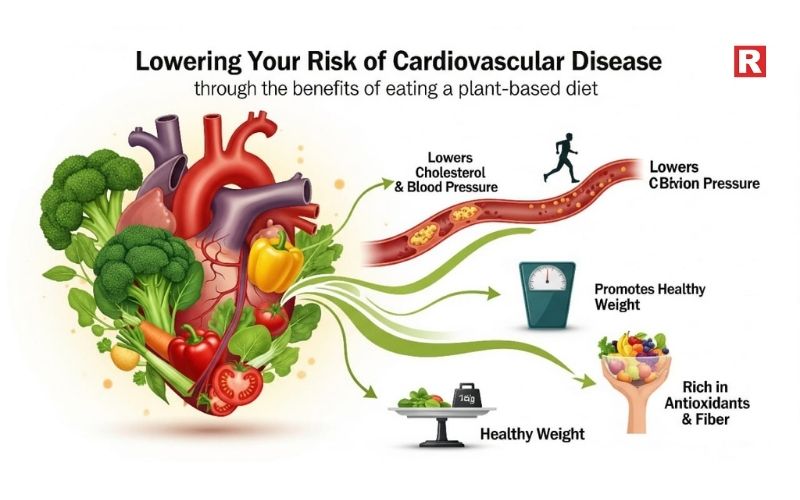
A plant-based diet is like high-quality fuel for your body's engine, which is your heart. People who eat mostly plant-based meals have a much lower risk of heart disease, stroke, and high blood pressure, according to numerous studies.
Why: Diets based on plants are naturally high in fiber, antioxidants, and anti-inflammatory substances and low in saturated fat and cholesterol, which are mostly found in animal products. Antioxidants shield blood vessels from harm, and fiber helps reduce bad cholesterol (LDL). Your heart continues to beat strongly, and your arteries remain clear thanks to this potent mixture.
Imagine your arteries as clear, unobstructed rivers instead of ones that are choked with trash. That's the benefit of being plant-based diet.
Know more: Top 7 Regional Indian Thali Platters That Showcase Culinary Diversity
2. Sustaining a Healthy Body Weight
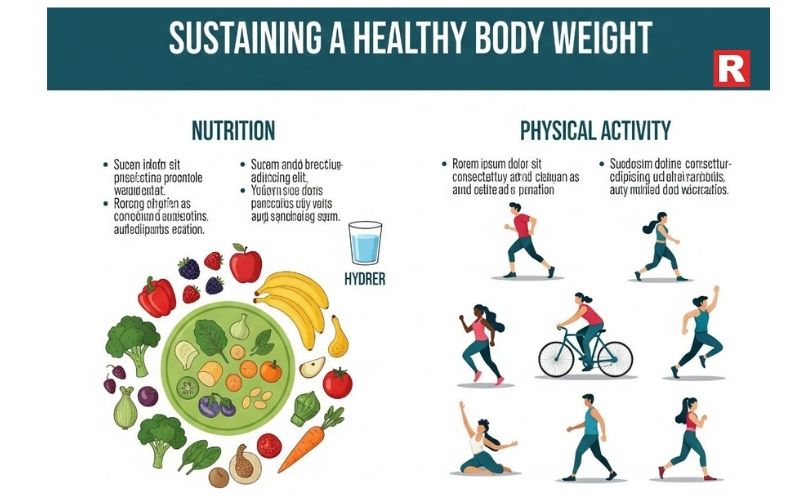
Having trouble losing weight? A diet high in plants could be your hidden weapon. Adopting a plant-based diet frequently makes it simpler for people to reach and stay at a healthy weight without feeling deprived.
How it works: Foods derived from plants often include more fiber and water and fewer calories. Fiber increases the feeling of fullness, which lessens the desire to overeat by making you feel fuller for longer. You might feel full on fewer calories because of the sheer amount of plant-based foods available. Which means calorie-counting nightmares are over!
3. Improving Blood Sugar Control

A plant-based diet provides a strong defense against type 2 diabetes, a condition that is becoming more and more of a global concern. According to research, plant-based diets can help control and even reverse type 2 diabetes in certain people in addition to preventing it altogether.
The science behind it: Plant meals' high fiber content reduces the rate at which sugar is absorbed, avoiding sudden increases in blood sugar levels. Additionally, these diets increase insulin sensitivity, which means that your body's cells are better suited to use insulin to absorb blood glucose.
Instead of a roller coaster of highs and lows, think of it as a slow, peaceful release of energy.
4. Reducing Your Risk of Certain Cancers

Although no diet can prevent cancer, a plant-based diet greatly increases your chances of success. High intake of fruits, vegetables, and whole grains has been associated in studies with a decreased risk of colorectal, breast, and prostate cancer, among other types of cancer.
The protective barrier: Phytochemicals, which are naturally occurring substances with anti-cancer qualities, are abundant in plant foods. These substances can lessen inflammation, combat harmful radicals, and potentially stop the spread of cancer cells. Additionally, fiber supports gut health and detoxification, both of which are essential for preventing cancer.
You can think of every vibrant fruit and vegetable as a little warrior defending your well-being.
What's new: Top 7 Tips for Efficient Energy Management in A Restaurant Kitchen
5. Nurturing a Healthy Microbiome

It's common to refer to your gut as your "second brain," and its health is closely related to your general well-being. A plant-based diet is a feast for your gut's trillions of helpful microorganisms.
Giving your friends food: Plant meals have a wide variety of fiber that feeds these beneficial bacteria by acting as prebiotics. Immune system performance, digestion, nutrition absorption, and even mood control all depend on a healthy gut microbiota. When your gut is content, you're also happy.
Imagine your stomach as a blooming garden where nutrients and the ideal soil are provided by a plant-based diet for the growth of beneficial microorganisms.
6. Improving Mental Abilities

Do you want to maintain your mental sharpness? Perhaps the solution is a plant-based diet. Plant-rich diets are strongly associated with greater mental capacity, a lower risk of dementia, and overall brain health, according to emerging research.
Providing energy to your gray matter: Plant diets provide antioxidants and anti-inflammatory substances that shield brain cells from harm. Additionally, essential for brain health are omega-3 fatty acids, which can be found in walnuts, chia seeds, and flax seeds. Better blood flow to the brain, which supplies vital oxygen and nutrients, is another advantage of having a healthy heart.
7. Energy Booster: Maintaining Stamina All Day

Are you sick of the midday fatigue? People who eat more plants tend to be more energetic and experience less tiredness.
The gradual release of glucose into your bloodstream is made possible by the complex carbohydrates present in whole grains, fruits, and vegetables. This provides you with long-lasting energy without the crashes that come with processed sweets. Additionally, your body may need less energy for digestion if you avoid heavy, difficult-to-digest animal products.
You can experience the difference by waking up feeling energized and renewed for the rest of the day by eating plant-based products for a while.
8. Calming Your Body's Internal Fires

Numerous modern illnesses, including arthritis, heart disease, and some types of cancer, are silently caused by chronic inflammation. Eating a plant-based diet naturally reduces inflammation.
Putting out the fire: Antioxidants and phytonutrients found in fruits, vegetables, nuts, and seeds actively fight inflammation in the body. A plant-based diet helps shield your cells and organs from long-term harm by lowering inflammatory indicators.
Think of your body as a complex machine. Plant foods are the oil that keeps everything moving smoothly, and inflammation is like sand in the gears.
Check out: How Health Regulations are Reshaping India's Dining Scene
10 Steamed Indian Dishes Beyond Idli & Dhokla
9. Achieving Radiant, Healthy Skin

Your skin's health and appearance are greatly influenced by your diet. Clearer, more glowing skin is frequently the result of eating a plant-based diet.
Inner beauty: Your skin cells are nourished from the inside out by the plethora of vitamins, minerals, antioxidants, and water found in fruits and vegetables. Healthy fats, such as those found in nuts and avocados, help to hydrate and soften the skin, while antioxidants guard against environmental harm. Additionally, many people report a more even skin tone and fewer spots.
Give it a try: After consuming a week's worth of fresh fruit, compare your skin to that of a week's worth of processed meals. You may be taken aback!
10. Living a Longer, Healthier Life

Plant-based diets are significantly linked to longer lifespans and better quality of life in later life, which is perhaps the most appealing advantage of them.
The mystery of the blue zones: A common factor throughout many of the world's "Blue Zones"—areas where people live remarkably long, healthy lives—is a diet high in plant-based foods. A plant-based diet not only extends your life but also improves it by lowering your risk of developing chronic illnesses and promoting general cellular health.
Imagine living your golden years free from chronic sickness and full of vitality and energy. Sounds good, right? This can be achieved by properly incorporating a plant-based diet in your life.
Making the Switch: Is a Plant-Based Diet Right for You?
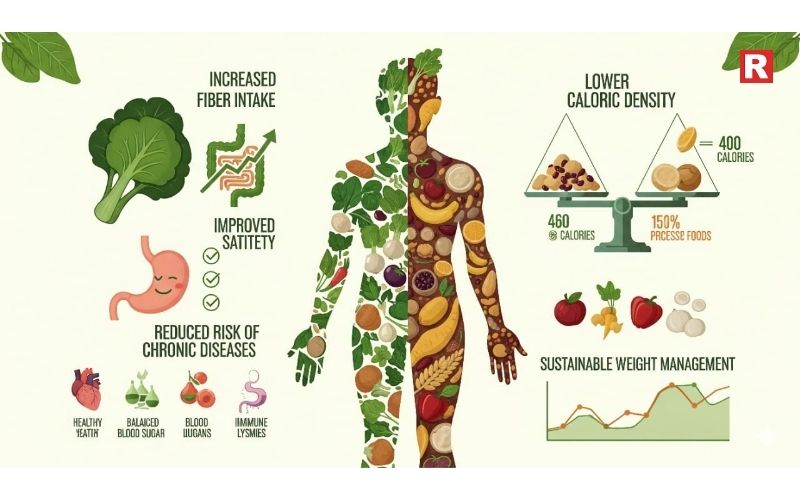
A plant-based diet doesn't have to be "all or nothing" for you to succeed. Many people begin by cutting out animal products and gradually increasing their intake of plant-based meals. Significant health benefits can result from even a minor change in lifestyle.
Tips for getting started:
- Start slowly: Devote one day every week to a plant-based diet, or add one plant-based meal per day.
- Put variety first: To make sure you get a variety of nutrients, try a variety of fruits, vegetables, grains, and legumes.
- Learn: Understand how to balance your meals, about plant-based protein sources, and about important vitamins (such as B12, which frequently requires supplements on a strict vegan diet).
- Get creative in the kitchen: You can do this by learning new spices and recipes that add flavor and excitement to plant-based eating.
- Pay attention to your body: Observe the feelings you get from various foods.
- Speak with an expert: Consult a qualified dietician if you have certain dietary requirements or health issues.
Read this: 5 Ways AI is Changing the Indian Restaurant Industry
Why Plant-Based is More Than Just a Diet
Adopting a plant-based diet has major advantages for the environment and animal welfare in addition to the amazing health benefits for humans. It's a comprehensive decision that fits with a more responsible and caring lifestyle.
By putting more plants on your plate, you're contributing to a rising movement for a better planet and a more compassionate future, in addition to improving your personal health.
Disclaimer: This article is intended for general informational purposes only and should not be considered a substitute for professional medical advice, diagnosis, or treatment. Readers are advised to consult a qualified healthcare professional before making any dietary, health, or lifestyle changes.

When people think of Tim Hortons, coffee is often the first thought. Yet for true fans, donuts hold the same place of pride. Together, coffee and donuts form the heart of Tim Hortons’ story. The brand was founded in 1964 in Hamilton, Ontario, by hockey legend Tim Horton. What started as a single shop soon became a Canadian tradition. Over the years, the chain has spread far beyond Canada, reaching cities around the world. Still, the spirit of comfort and community has remained the same.
At Tim Hortons, donuts are more than quick snacks. They are small treats that bring people together. Each donut carries its own taste and texture. From creamy fillings to soft glazes, every option has loyal fans. Some are loved for their sweetness, while others are chosen for their lightness. The variety on the menu means there is something for everyone. Whether it is a Boston Cream, a Honey Cruller, or a classic Chocolate Dip, each bite offers comfort. Tim Hortons donuts are not only about flavor. They are about warmth, memories, and moments shared over coffee.
Read more: Domino’s 4-Course Meal— The Ultimate Lunch Deal You Can’t Miss
Pani Puri Has Different Names in Different Indian States—Know Them All
Why Tim Hortons Donuts Stand Out
Tim Hortons donuts are not only about taste. They represent tradition, comfort, and Canadian pride. Each donut has a story and a loyal following. Whether you want something simple like a Chocolate Dip or something unique like a Canadian Maple, there is a donut for every mood.
For many people, these donuts are tied to memories. Morning stops on the way to work. Family road trips with a box of Timbits. Quiet moments with a coffee and a sweet treat. That is why Tim Hortons donuts are more than food. They are part of everyday life.
Discover the Musy Try Donuts
Whether you are visiting Tim Hortons for the first time or you are a regular, knowing which donuts are worth trying makes the experience even better. Here is a detailed guide to the top Tim Hortons donuts you must try.
1. Boston Cream

The Boston Cream is one of the most loved Tim Hortons donuts. It is round, soft, and filled with creamy custard. On top, it has a thick chocolate glaze that balances the sweetness. This donut feels like dessert but works any time of the day. What makes the Boston Cream special is its filling. Every bite gives you a mix of custard and chocolate, which is rich but not heavy. Pair it with a Double Double coffee and you will understand why this donut is a timeless classic.
2. Honey Cruller

The Honey Cruller is unique in both taste and shape. It is light, airy, and covered in a shiny honey glaze. Unlike most donuts, it has a twisted design that looks as good as it tastes. This donut almost melts in your mouth because of its texture. Many people say the Honey Cruller is the best Tim Hortons donut ever made. If you like something sweet but not too heavy, this is the one to choose. A cup of hot tea or black coffee goes perfectly with it.
Know more: 10 Fastest-Growing Alcohol Brands in India’s HoReCa Sector
3. Canadian Maple

No list of Tim Hortons donuts is complete without the Canadian Maple. This donut celebrates Canada’s love for maple syrup. It is filled with smooth maple custard and topped with chocolate glaze. The Canadian Maple is rich, sweet, and very satisfying. It has become an icon in Tim Hortons’ menu. If you want to taste Canada in one bite, this donut is the best pick. Try it with an Iced Capp on a warm day, and it will be an experience to remember.
4. Apple Fritter

The Apple Fritter is a donut that feels more like a pastry. It is filled with chunks of apple, swirls of cinnamon, and a shiny glaze on top. It has a crispy outside and a soft inside, making it one of the most comforting options on the menu. This donut is heavier than most others, which makes it a great choice if you are looking for something filling. Many customers say the Apple Fritter tastes like homemade dessert. Pair it with a steeped tea for a cozy treat.
5. Chocolate Dip

Simple but unbeatable, the Chocolate Dip is a classic donut that never goes out of style. It is a plain yeast donut topped with chocolate glaze. The mix of soft dough and chocolate makes it a reliable favorite for both kids and adults. The beauty of the Chocolate Dip is its simplicity. It is not filled or overly sweet, yet it delivers the perfect balance. It pairs well with almost every drink on the Tim Hortons menu.
6. Sour Cream Glazed
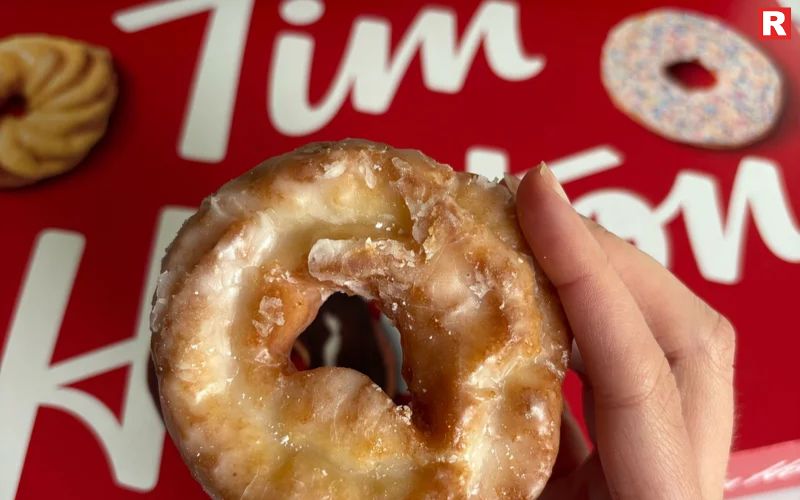
The Sour Cream Glazed donut is for those who love old-fashioned treats. It has a dense texture, a golden crust, and a sweet glaze. The sour cream in the dough gives it a unique flavor that stands out from other donuts. This donut is rich but not overwhelming. It works perfectly with a cup of dark roast coffee. Many long-time Tim Hortons fans consider it a hidden gem on the menu.
Also check: 5 Foods to Avoid for Better Cholesterol
7. Vanilla Dip

If you like fun and colorful desserts, the Vanilla Dip is a must-try. It is a soft yeast donut covered in vanilla frosting and topped with rainbow sprinkles. The Vanilla Dip is especially popular with kids, but even adults love the cheerful look and sweet flavor. It is the kind of donut that makes you smile before you even take a bite. Pair it with an iced coffee for a perfect afternoon pick-me-up.
8. Double Chocolate

The Double Chocolate donut is made for chocolate lovers. It has a chocolate cake base and a chocolate glaze on top. The result is rich, moist, and deeply satisfying. If you want something indulgent, this donut will not disappoint. It pairs beautifully with a hot latte or cappuccino. For many fans, this is the ultimate comfort donut at Tim Hortons.
Seasonal Donuts at Tim Hortons
One of the best things about Tim Hortons is its seasonal specials. Depending on the time of year, you can find donuts that celebrate holidays and occasions. For example, pumpkin spice donuts are popular in the fall, while festive donuts with red and green sprinkles appear during Christmas.
These limited-time options keep the menu exciting. If you are lucky enough to visit during a seasonal launch, make sure you try at least one.
Check more: Top 5 States With the Spiciest Food in India
The 10 Must-Try Sandwiches at Subway You Can’t Miss
Top 8 Must-Try Sandwiches from Around the World
Timbits: A Tim Hortons Signature

No talk about Tim Hortons donuts is complete without mentioning Timbits. These are bite-sized donut holes that come in many flavors, from chocolate glazed to sour cream to honey dip. They are perfect for sharing or for when you want just a small treat.
Timbits are also popular at parties, meetings, and family gatherings. They are affordable, fun, and offer variety in one box.
Best Coffee Pairings with Tim Hortons Donuts
The real magic happens when you pair donuts with Tim Hortons coffee. A Boston Cream with a Double Double is a fan favorite. The Honey Cruller goes well with black coffee. The Apple Fritter is perfect with steeped tea. And the Double Chocolate is best with a latte or cappuccino.
Pairing makes the whole experience richer. It is not just about eating a donut. It is about enjoying a small ritual that Tim Hortons has perfected over the years.
Happy Eating!
If you are new to Tim Hortons, start with the Boston Cream, Honey Cruller, or Canadian Maple. If you are a long-time fan, try revisiting classics like the Apple Fritter or Sour Cream Glazed. And do not forget Timbits, because they are a part of what makes Tim Hortons special.
Tim Hortons donuts are not just desserts. They are a tradition that has been shared for generations. Next time you step into a Tim Hortons, take a moment to enjoy not just the coffee but also one of these iconic donuts. It is an experience that never gets old.

As the modern lifestyle has become more and more hectic, cooking from scratch has become difficult. So, now people prefer convenience over homemade goods to save time. Foods that are packed and processed have become commonplace due to their convenience and long shelf life. However, have you ever wondered how these goods manage to stay fresh throughout their entire journey from factories to store shelves to your pantry? The answer to this is Food Preservatives.
Although the word "preservatives" can occasionally raise concerns, these chemicals are essential for keeping the quality of packaged items, preventing food from spoiling, and guaranteeing food safety. They prevent oxidation, prevent microbiological growth (bacteria, yeasts, and molds), and slow down other chemical reactions that might lead to food spoilage.
In India, as in many other nations, the Food Safety and Standards Authority of India (FSSAI) carefully regulates the use of food additives, including preservatives. Customers have more information to make smart food choices when they know what these preservatives are and how to spot them when reading food labels. This complete article will help you understand Indian food labels and also help to explain food preservatives.
Read more: How to Apply for an FSSAI License for Your Cloud Kitchen in India: A Step-by-Step Guide
What Are Food Preservatives?

Food preservatives are chemicals that are added to food items in order to stop or slow down spoiling that is brought on by unwanted chemical changes or microbiological growth. Their main duties consist of:
- Preventing Microbial Spoilage: Stopping the growth of bacteria, yeasts, and molds that can lead to foodborne illnesses and make food unfit for consumption.
- Delaying Oxidation: Preventing the oxidation of fats and oils, which alters their flavor and aroma.
- Maintaining Freshness and Quality: Keeping food's original color, texture, and flavor for an extended period of time.
Although regulatory agencies frequently classify them according to their chemical class and function, preservatives can be generically divided into two categories: natural and artificial (synthetic).
Natural Preservatives
Throughout history, food has been preserved using a variety of natural materials:
- Salt: Since ancient times, salt has been used to extract moisture from meats and fish to preserve them.
- Sugar: Used to prevent the growth of microorganisms in jams, jellies, and candied fruits.
- Vinegar (Acetic Acid): Pickles and chutneys include vinegar, often known as acetic acid.
- Spices: Some spices, such as extract from rosemary, have antioxidant qualities.
Artificial (Synthetic) Preservatives
These compounds are made chemically and are intended to work very well at low amounts. They provide a wider range of preservation options and are frequently more effective than natural techniques alone. These are the ones that appear on food labels that are packed the most frequently.
Know more: 10 High-Protein, Low-Calorie Foods to Conquer Cravings
Why Are Preservatives Necessary in Packaged Food?
Suppose there were no preservatives in the world. The shelf life of many of the things we take for granted, such as bread, dairy products, processed meats, sauces, and pre-prepared meals, would be significantly reduced.
- Food Safety: The first line of protection against foodborne microorganisms that can cause life-threatening illnesses is preservatives. They stop dangerous microorganisms from growing.
- Reduced Food Waste: Preservatives help prevent food spoiling in our homes and at grocery stores by prolonging shelf life.
- Economic viability: By allowing the food industry to produce, store, and distribute goods over greater distances and periods of time, it increases the range of foods that are available and reasonably priced.
- Convenience: They let customers buy foods that are suitable for hectic schedules and don't need to be eaten right away.
FSSAI Regulations on Food Preservatives in India

The use of all food additives, including preservatives, and their subsequent changes is governed in India by the Food Safety and Standards (Food Products Standards and Food Additives) Regulations, 2011. A thorough list of authorized additives, along with information on their maximum permissible limits (MPLs) in particular food categories and labeling specifications, is provided by the FSSAI.
Key elements of FSSAI rules:
- Permitted List: Only preservatives specifically listed by the FSSAI are permitted.
- Maximum Permissible Limits (MPLs): There is a maximum quantity of each approved preservative that can be used in a given food product. Based on a thorough scientific analysis, these limits have been created to guarantee consumer safety.
- Good Manufacturing Practices (GMP): According to Good Manufacturing Practices (GMP), preservatives shouldn't be used in place of hygienic procedures, but rather only when technologically required to get the intended result.
- Labeling: The food label must list all additional preservatives.
How to Identify Preservatives on Indian Food Labels

Now is the time to use your detective abilities! All ingredients, including additives, must be listed explicitly on Indian food labels. Usually, there are two ways that preservatives can be found in the "Ingredients" list:
By their full chemical name: for example, "Sodium Benzoate," "Potassium Sorbate," and "Calcium Propionate."
Using their code from the International Numbering System (INS): Usually found in Europe but also used globally, these are three- or four-digit numbers that are usually followed by the letter "E" or just the number. The number is mainly visible in India. INS 211 for sodium benzoate, for example.
Since the ingredients are given in decreasing order of their weight proportion, you will typically find the preservatives near the end of the ingredient list.
Look for keywords like:
- "Preservative (INS XXX)"
- "Preservative (chemical name)"
- The phrase "Contains permitted Class II preservative" indicates a specific category of preservatives.
- "Antioxidant" (certain antioxidants prevent spoiling, hence they also serve as preservatives).
What's new: The Comfort Revolution: How Home Cooking Can Save Your Restaurant
Disclaimer: This article is intended for general informational purposes only and should not be considered a substitute for professional medical advice, diagnosis, or treatment. Readers are advised to consult a qualified healthcare professional before making any dietary, health, or lifestyle changes.
Common Food Preservatives You'll Find in India
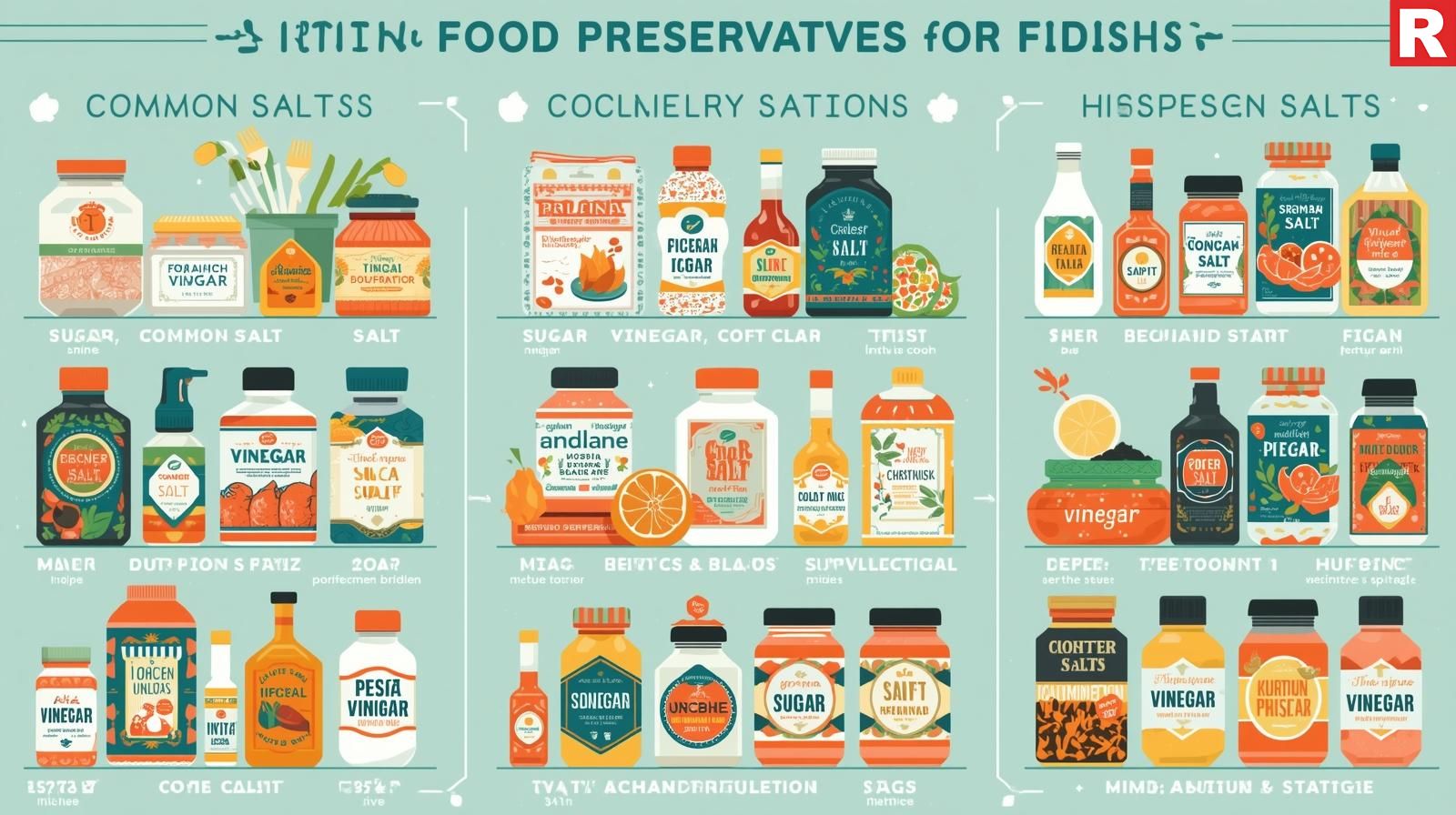
Here is a list of some of the most often used preservatives that have been approved by the FSSAI and that you may find on Indian food packaging labels:
Benzoates (E 210-213 / INS 210-213)
- Common Forms: (INS 213), potassium benzoate (INS 212), and sodium benzoate (INS 211).
- Function: Works well against certain bacteria, molds, and yeasts, particularly in acidic diets.
- Found in: Fruit preparations, jams, pickles, sauces, soft drinks, fruit juices, and some baked items.
Sorbates (E 200-203 / INS 200-203)
- Common forms: calcium sulfate (INS 203), potassium sulfate (INS 202), and sorbic acid (INS 200).
- Function: Less efficient against bacteria, but quite good against yeasts and molds.
- Found in: Cheese, dairy products, bread, fruit, wine, and yogurt are among the items that contain it.
Propionates (E 280-283 / INS 280-283)
- Common Forms: calcium propionate (INS 282), sodium propionate (INS 281), and propionic acid (INS 280).
- Function: Especially good in preventing the growth of mold in baked foods.
- Found in: Some processed cheeses, bread, and other baked goods.
Sulfites (E 220-228 / INS 220-228)
- Common forms: potassium metabisulfite (INS 224), sodium sulfite (INS 221), and sulfur dioxide (INS 220).
- Function: Prevent discoloration by acting as antimicrobials and antioxidants.
- Found in: Wine, vinegar, fruit juices, dried fruits, and some shellfish. Note: Sulfites can cause sensitivity in certain people.
Nitrates & Nitrites (E 249-252 / INS 249-252)
- Common Forms: Sodium Nitrite (INS 250), Potassium Nitrite (INS 249), Sodium Nitrate (INS 251), Potassium Nitrate (INS 252).
- Function: Mainly used in cured meats to improve flavor, maintain color, and stop the growth of Clostridium botulinum, the bacteria that causes botulism.
- Found in: Hot dogs, sausages, bacon, and cured meats like ham.
Acetic Acid (E 260 / INS 260) and its Salts
- Common forms: calcium acetate (INS 263), sodium acetate (INS 262), and acetic acid (vinegar).
- Function: Prevents the growth of mold and germs.
- Found in: bread, pickles, sauces, and condiments.
Ascorbic Acid and Its Salts (E 300/INS 300)
- Common forms: sodium ascorbate (INS 301) and ascorbic acid (Vitamin C).
- Function: Mainly an antioxidant, it keeps food from oxidizing and spoiling (e.g., browning fruits, rancidity of lipids). Despite not being a conventional antimicrobial preservative, it plays a vital function in keeping food from spoiling.
- Found in: baked foods, processed meats, fruit juices, and drinks.
Citric Acid (E 330 / INS 330) and its Salts
- Common forms: sodium citrate and citric acid (INS 331).
- Function: It is mostly used as a taste enhancer and acidic agent, but it also has minor preservative qualities by binding to metals and reducing pH, which increases the potency of other preservatives.
- Found in: Dairy products, beverages, jams, jellies, and confections.
Check out: Chia Magic: Health Benefits & Endless Delicious Ways to Enjoy
Top Drinks You Should Consume to Get a Festive Glow
A Practical Approach to Decoding the Label
The following actions should be taken the next time you pick up a packaged food item in India:
- Find the list of "Ingredients": Usually, this appears on the packaging's side or back.
- Scan for "Preservative": Look for the term "Preservative" followed by either an INS number or a name.
- Determine the INS Codes: Learn the common INS codes, such as INS 211 and INS 202. Unusual numbers can be found with a short internet search.
- Check for: Look for the generic statement "Contains Permitted Class II Preservative" as this is frequently used in India to indicate the use of a permitted preservative from that category.
- Recognize "Antioxidants": Even if they aren't specifically referred to as "preservatives," antioxidants (typically INS 300–321) help prolong shelf life by slowing oxidation.
Read this: 10 Popular Energy Drinks and Their Benefits
Making Smart Choices
Being aware of preservatives does not mean that you need to stay away from packaged goods. It has to do with balance and awareness.
- The key is moderation: More additives are frequently found in highly processed foods. When possible, give priority to eating nutritious, fresh meals.
- Carefully Read Labels: Develop the practice of looking over ingredient lists, particularly for goods you use frequently.
- Recognize Your Needs: Careful label reading is essential if you have allergies or sensitivities (such as to sulfites).
- Regulations for Trusts: Keep in mind that the FSSAI establishes boundaries to guarantee safety. In general, the allowed amounts are regarded as safe for ingestion.
Conclusion
Food preservatives are an essential component of our modern food system, which improves food accessibility, safety, and waste reduction. The FSSAI makes sure that its use is controlled and freely accessible in India. You can comfortably explore the supermarket aisles by learning about the common forms of preservatives and making it a practice to carefully read product labels. Use this information to empower yourself and, one ingredient list at a time, make nutritional decisions that support your preferences and health objectives.

Rajasthan is known for its bright colors, rich traditions, and strong flavors. The food here is bold, tasty, and full of history. It has been influenced by the desert lifestyle and royal families. During festivals, families come together to celebrate with special meals. These dishes are more than just food. They tell stories of how people lived in the harsh desert and how they made the best of local ingredients. Spices, ghee, and grains are used to create flavors that are both simple and grand.
Festivals in Rajasthan are a time of joy and sharing. People cook traditional recipes that have been passed down for generations. Every dish has its own story and taste. Some are spicy, while others are sweet. Together, they make festive meals more special and memorable. Whether it’s a crispy snack or a hearty curry, these dishes bring warmth and happiness to the table. This article explores the top Rajasthani dishes to try during festive times. Each dish reflects the culture and spirit of Rajasthan. They are a treat for the senses and a way to experience the region’s rich heritage.
Read more: Must-Try Sweet Dishes on Dandiya Night
Top Drinks You Should Consume to Get a Festive Glow
Why Rajasthani Food is a Festive Treat
Rajasthani cuisine stands out because of its unique flavors. The use of spices, ghee, and local ingredients gives it a bold taste. The desert’s dry climate led to creative ways of cooking and storing food. Dishes like Ker Sangri and Bajra roti are examples of how people made the most of what nature provided.
During festivals, families prepare special meals to share with loved ones. These dishes bring warmth, energy, and happiness. Rich curries, baked breads, and sweet treats make every celebration memorable. If you want to add more joy to your festival, trying Rajasthani food is a must.
Find the Top Rajasthani Flavour to Try
Here are the top dishes you should taste this festive season. Each has a story and a special flavor.
1. Dal Baati Churma

Dal Baati Churma is the king of Rajasthani meals. It is served on every festive table. The baati is baked over fire or in an oven. It is soft inside and crunchy outside. The dal is rich and aromatic. The churma adds sweetness to balance the flavors. This dish represents the royal heritage of Rajasthan and is perfect for sharing. The dish is made of three parts:
- Baati – round, baked wheat flour balls.
- Dal – a mix of lentils cooked with spices.
- Churma – sweet, crushed baati mixed with ghee and sugar.
2. Laal Maas

Laal Maas is a fiery mutton curry. The name means “red meat.” The red color comes from dried red chilies. This dish is spicy and aromatic. It is slow-cooked with garlic, yogurt, and ghee. The result is a thick, flavorful curry that melts in your mouth. Laal Maas is often served during weddings and big gatherings. It is a must-try for those who love spice. The dish reflects the bold and brave spirit of Rajasthan.
Know more: 10 Must-Try Gujarati Dishes That Will Delight Your Taste Buds
3. Gatte ki Sabzi
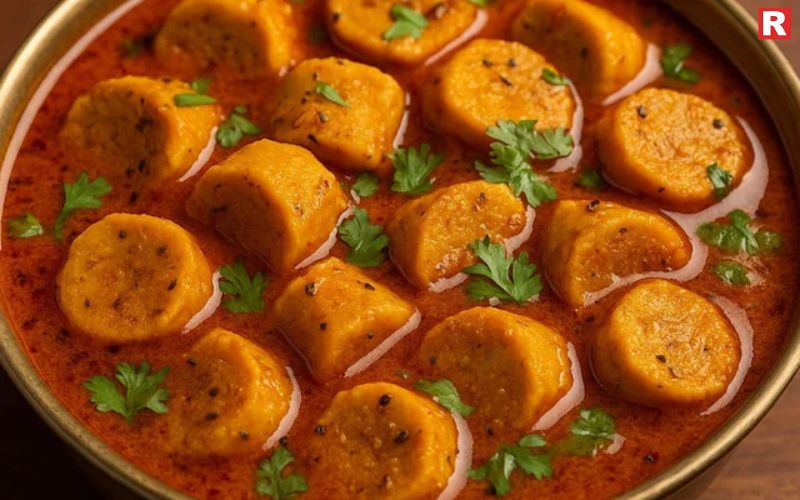
Gatte ki Sabzi is a simple yet tasty dish. It is made with gram flour dumplings cooked in a tangy yogurt gravy. The dumplings are soft and absorb the flavors of the spices. The dish is usually served with roti or rice. This dish shows how resourceful the people of Rajasthan are. Even with limited ingredients, they created something filling and delicious. It is a comfort food that reminds you of home-cooked meals.
4. Ker Sangri
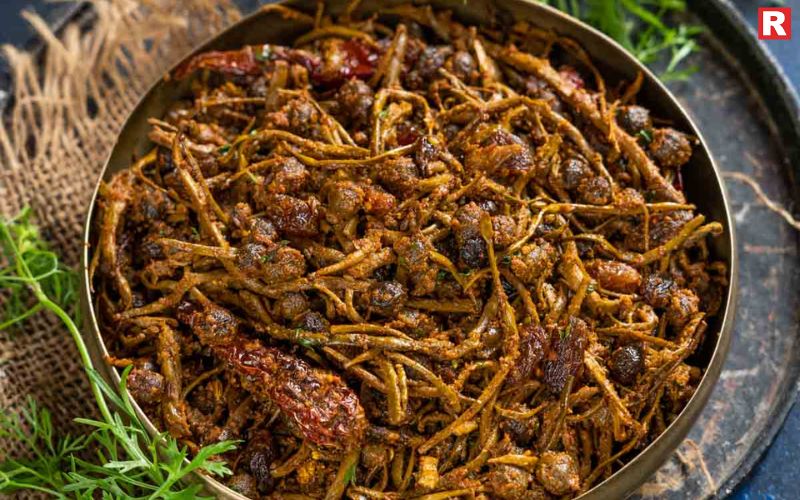
Ker Sangri is a traditional desert dish. It is made from dried berries (Ker) and beans (Sangri). These are soaked, cooked, and spiced with mustard seeds, red chilies, and other masalas. The dish has a unique texture and earthy flavor. Ker Sangri represents survival in harsh climates. It is a dish that uses the desert’s natural produce. During festivals, it is served to guests as a special treat. Trying this dish is like tasting the spirit of Rajasthan.
5. Pyaaz Kachori
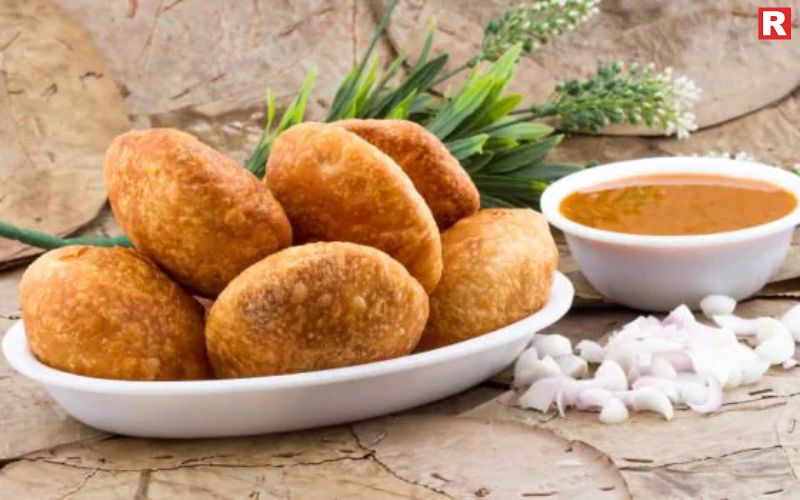
Pyaaz Kachori is a crispy, onion-filled snack. The outer layer is made of wheat flour and fried until golden. The inside is stuffed with spicy onions, herbs, and masalas. It is a popular breakfast or evening snack. The crunchy texture and flavorful filling make it irresistible. During festivals, families enjoy it with chutneys and tea. It’s a dish that brings everyone together for a simple yet tasty bite.
Also check: High Protein Indian Meals You Should Try
6. Mawa Kachori and Ghevar
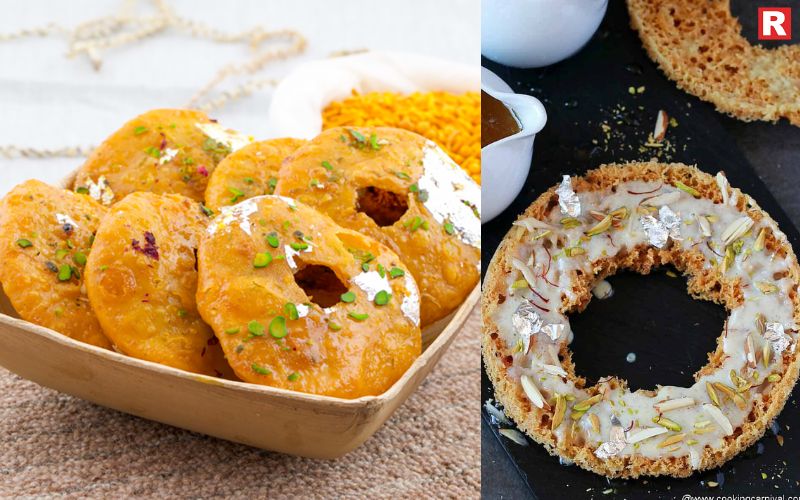
No festival is complete without sweets. Mawa Kachori is stuffed with khoya (mawa) and dry fruits. It is deep-fried and soaked in sugar syrup. Ghevar, on the other hand, is a delicate disc-shaped sweet made with flour, ghee, and soaked in syrup. These sweets are festive favorites. Their rich flavors and textures make them perfect for special occasions. Serving them with family and friends adds a sweet touch to celebrations.
Festive Food Traditions of Rajasthan
Food is more than just taste in Rajasthan. It is a way of celebrating together. During festivals like Diwali, Holi, and Gangaur, families cook special meals and invite neighbors and friends. Temple offerings, community feasts, and family dinners are common. Ghee, jaggery, and spices are used generously. These ingredients not only add flavor but also boost energy during long celebrations. Sharing food with others is considered a way of spreading happiness. Even today, many households prepare large quantities of traditional dishes and distribute them among relatives and neighbors.
Check more: 12 Delicious High-Protein Foods to Eat Daily for a Healthier You
5 Foods to Avoid for Better Cholesterol
Top 5 States With the Spiciest Food in India
Tips for Enjoying Rajasthani Cuisine
To make the most of your experience, here are some tips:
- Balance spice with curd or buttermilk. Rajasthani dishes can be spicy, so having a side of curd or chaas helps cool the palate.
- Don’t skip the ghee! A drizzle of ghee enhances the flavor and adds richness to every bite.
- Try seasonal sweets. During festivals, sweets like Ghevar and Mawa Kachori are prepared fresh. They are a must-try.
- Pair dishes wisely. For example, serve Laal Maas with soft bajra roti or steamed rice for the best experience.
- Talk to locals. Ask about family recipes or regional styles. Every household has its own special way of preparing these dishes.
Celebrate with Flavor
Rajasthani cuisine is known for its rich flavors, history, and warmth. During the festive season, it is a great time to try these special dishes. Whether someone is hosting a dinner or simply wants to explore new flavors, these recipes bring joy to any celebration. The food is a mix of spicy, savory, and sweet dishes, each with its own story. Many recipes have been passed down through generations and reflect the culture of Rajasthan. Sharing these meals with family and friends makes the celebrations even more special. People can enjoy the bold spices, soft breads, and delicious sweets while creating happy memories together. Festivals are not just about decorations or lights; they are also about gathering around a table and enjoying good food. Rajasthani dishes add warmth, love, and togetherness to every festive occasion. It’s a perfect way to celebrate and connect with others.

Durga Puja is one of the most joyful festivals in India. It is a time when people come together to celebrate, pray, and enjoy special meals. Food plays a big role in the festival, and sweets are an essential part of it. Sweets are more than just something sweet to eat. They are a way to show love and care for family and friends. Many traditional sweets have been made during Durga Puja for years. Some are only prepared during this time of the year. Others are shared with neighbors and guests.
These sweets carry the taste of tradition and the joy of celebrations. They bring back memories of past festivals and happy times spent together. Some families follow old recipes passed down through generations. These sweets are also a way to keep traditions alive. In this article, the top 7 sweet dishes for Durga Puja are introduced. These sweets are full of flavor, culture, and history. They can be bought from local shops or made at home. Everyone should try them and enjoy the festive spirit. Let’s discover these special treats.
Read more: Must-Try Sweet Dishes on Dandiya Night
What Are the Special Dishes You Must Try This Durga Puja
Why Sweets are Important During Durga Puja
During Durga Puja, sweets are more than food. They are part of rituals and offerings. Many families offer sweets to the goddess as a sign of gratitude. After prayers, people share sweets with everyone. It is a way of spreading joy and love. Sweets also bring families together. Making them at home can be a fun activity. Grandparents often pass recipes to the younger generation. These recipes hold memories and stories. When you eat these sweets, you are not just tasting flavors but also celebrating your culture.
Now, let’s look at the top 7 sweets that you cannot miss this festive season.
1. Sandesh – Soft and Delightful
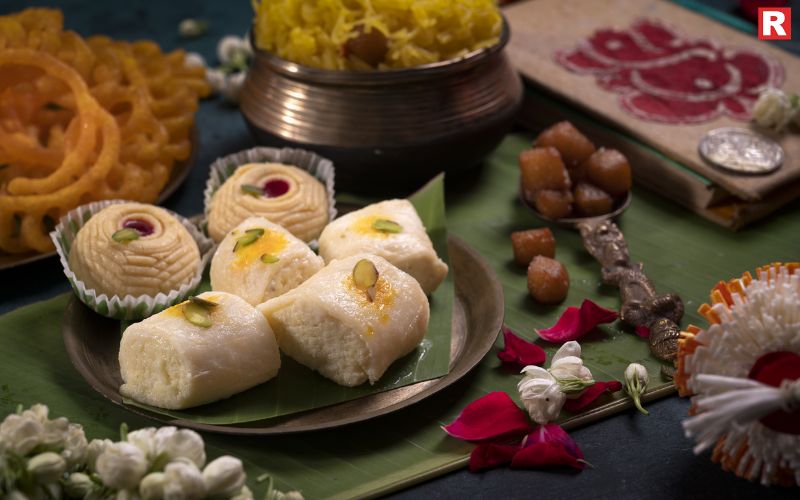
Sandesh is one of the most famous Bengali sweets. It is made with fresh paneer, also called chhena. The texture is soft and smooth. It melts in your mouth. You can find different types of Sandesh. Some have flavors like mango, kesar (saffron), or pista. Some are plain and simple, while others are decorated with dry fruits. Sandesh is often offered to the goddess during Durga Puja. Many families have their own special way of making it. It is also a popular gift during the festival.
How to enjoy: Eat it fresh for the best taste. You can also pair it with warm milk or tea.
Know more: Celebrate Navaratri with These Must-Try Dishes – Flavorful, Festive & Wholesome!
2. Rasgulla – Soft and Syrupy
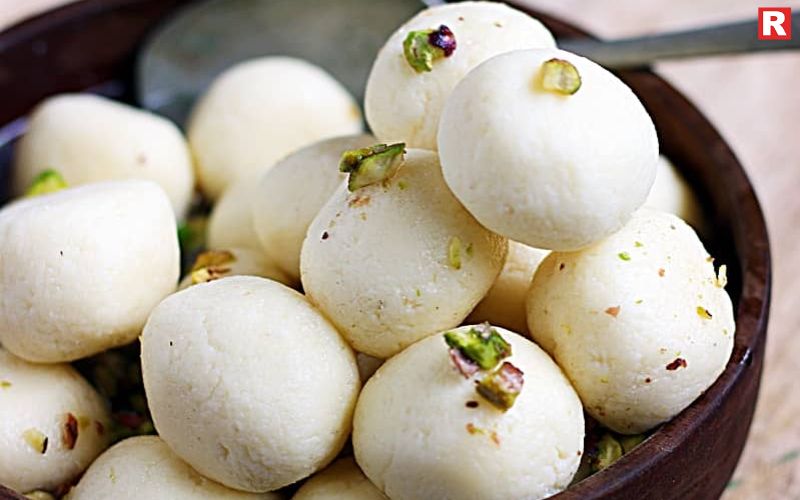
Rasgulla is a spongy, soft sweet that soaks in syrup. It is made from paneer and cooked in sugar syrup. The result is a light and juicy dessert. Rasgulla is loved by people of all ages. It is a festival favorite because it is easy to share. Its taste is sweet but not overpowering. Some regions make it slightly tangy, while others keep it plain. No matter where you go, Rasgulla remains a crowd-pleaser.
Fun fact: In Bengal, Rasgulla is considered a sign of hospitality. Serving it shows respect and love.
3. Mihidana – Fine and Melt-in-Mouth
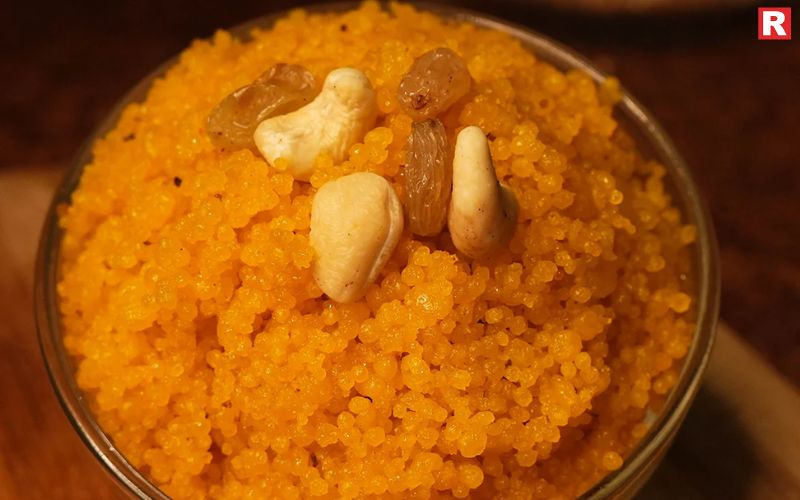
Mihidana is a delicate sweet from Bardhaman. The name means “fine grains.” It is made by frying tiny droplets of batter and soaking them in syrup. The texture is soft but grainy. It dissolves easily in your mouth. The taste is sweet with a hint of cardamom. Mihidana is usually paired with Sitabhog, another sweet from the same region. During Durga Puja, these sweets are often shared as gifts.
Interesting fact: The preparation of Mihidana is an art. Skilled sweet makers take years to perfect it.
4. Chomchom – Rich and Creamy

Chomchom is a popular sweet made from paneer. It is slightly firmer than Rasgulla and has a rich taste. The outer layer is soft, while the inside is creamy. It is cooked in thick sugar syrup. Some versions are flavored with rose water or saffron. Others are coated with coconut or nuts. Chomchom is often served at weddings and festive gatherings. During Durga Puja, it is a must-try treat at sweet shops.
How to serve: Warm it slightly before serving. It enhances the taste and aroma.
5. Malpua – Sweet Pancakes
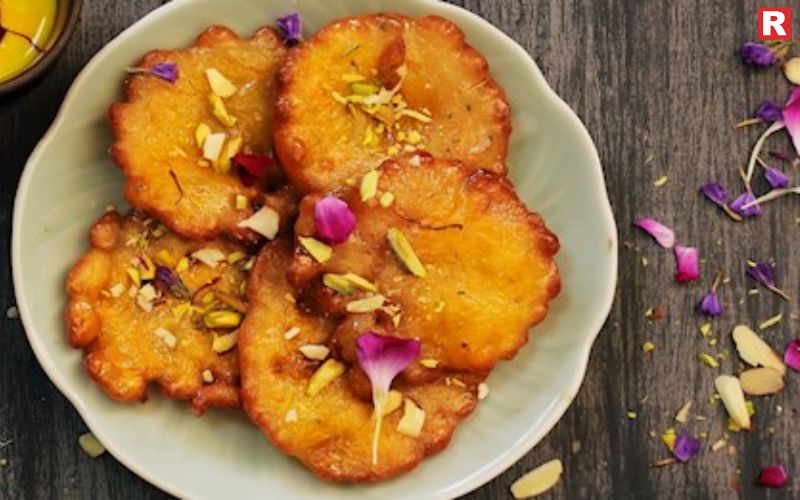
Malpua is a traditional Indian sweet pancake. It is made from flour, milk, and sugar. Some recipes also add bananas or coconut. The pancakes are fried until golden and then dipped in sugar syrup. They are soft and fluffy on the inside and slightly crispy on the outside. Malpua is often served with thickened milk or rabri. During Durga Puja, many families prepare it at home. It is a festive dessert that is easy to share.
Tip: Add cardamom or fennel seeds for extra flavor.
6. Kheer – Creamy Rice Pudding
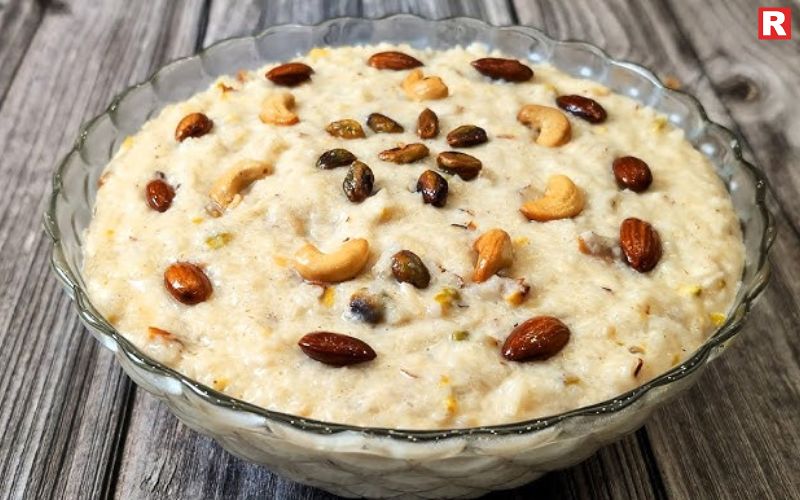
Kheer is a simple yet comforting dessert. It is made by slow-cooking rice in milk. Sugar, nuts, and spices are added to enhance the flavor. The texture is creamy and smooth. The taste is rich but balanced. Kheer is often prepared in large quantities during Durga Puja. Families gather around and enjoy it together. It is also offered to the goddess as prasad.
Did you know? Every family has its own version. Some use basmati rice, while others prefer broken rice.
Also check: 5 Foods to Avoid for Better Cholesterol
Pani Puri Has Different Names in Different Indian States—Know Them All
10 Must-Try Gujarati Dishes That Will Delight Your Taste Buds
7. Payesh – Slow-Cooked Milk Dessert
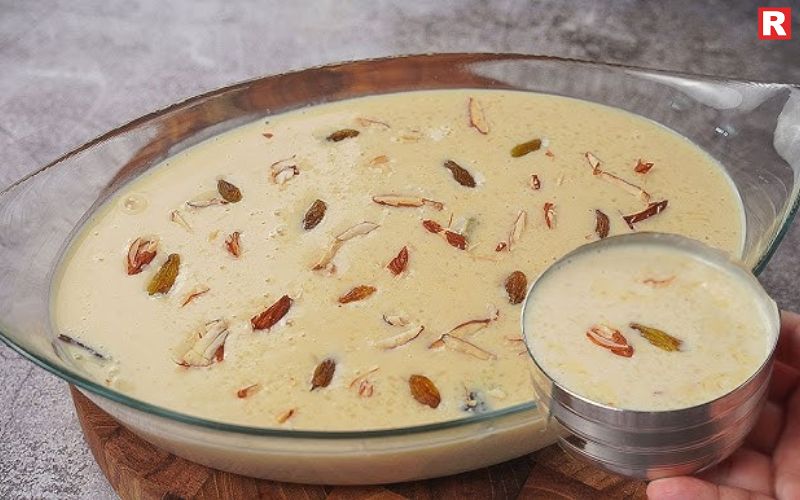
Payesh is a sweet dish similar to Kheer but cooked with more love and patience. It is made from milk, rice, and jaggery or sugar. It is slow-cooked to develop a deep flavor. Cardamom and bay leaves are often added for aroma. It is rich, creamy, and satisfying. During Durga Puja, Payesh is prepared for family gatherings and offerings. It is a dessert that warms the heart.
Pro tip: Use full-fat milk for the best texture.
Final Thoughts
Durga Puja is a time for joy, devotion, and being with loved ones. The sweets enjoyed during this festival are more than just treats. They hold traditions, memories, and love that have been passed down through generations. Whether bought from a shop or made at home, these sweets are best enjoyed with family and friends. Every bite brings happiness and a sense of togetherness. These sweets are a way to celebrate culture and share warmth. This festive season, people should not miss out on trying these special treats. Exploring the different flavors adds to the fun. Sharing them creates happy moments and strengthens bonds. Durga Puja is a perfect time to celebrate with sweetness, smiles, and stories that everyone will cherish for years to come.

Subway is one of the most popular sandwich chains in the world. It is loved for its fresh ingredients and healthier choices. People can easily create a sandwich the way they want. Whether someone enjoys meat, prefers vegetarian options, or wants something light, Subway has many choices to offer. The menu has a wide variety of sandwiches, sauces, and breads to pick from. This makes it exciting but also a little confusing for first-timers. That’s why this list of 10 must-try sandwiches helps customers choose their favorites. These sandwiches are enjoyed by people from all over the world.
Each one has a unique taste and style. Some are rich and filling, while others are light and fresh. Customers can add or remove ingredients as they like. This makes every sandwich personal and special. Subway’s sandwiches are more than just fast food. They are tasty, simple, and easy to enjoy anytime. Whether it’s lunch, dinner, or a quick snack, these sandwiches are a great way to enjoy something delicious and healthy. These top picks are sure to please everyone.
Read more: Domino’s 4-Course Meal— The Ultimate Lunch Deal You Can’t Miss
12 Delicious High-Protein Foods to Eat Daily for a Healthier You
Why These Sandwiches Are Special
Each of these sandwiches offers something different. Some are rich and hearty, while others are light and fresh. Subway’s biggest strength is customization. You can choose your bread, sauces, and toppings. This makes every sandwich personal and suited to your taste.
For example, if you want more spice, you can add jalapenos or pepper sauce. If you prefer healthy eating, pick lean meats like turkey or go vegetarian with the Veggie Delight. You can even mix sauces like honey mustard with barbecue to create your own flavor. Subway also focuses on using fresh ingredients. Their bread is baked daily, and vegetables are washed and cut regularly. This helps maintain the quality of every sandwich.
1. Italian B.M.T.

The Italian B.M.T. is one of Subway’s most popular sandwiches. It is made with three kinds of meat – pepperoni, salami, and ham. These meats give the sandwich a smoky and spicy flavor. It is perfect for people who enjoy bold tastes. Fresh vegetables like lettuce, tomatoes, and onions balance the strong flavors. The sandwich is hearty and filling, making it a great option for lunch or dinner. It tastes even better on Italian bread. Adding chipotle southwest sauce gives it an extra kick. This sandwich is a favorite for those who like rich and satisfying meals.
2. Chicken Teriyaki
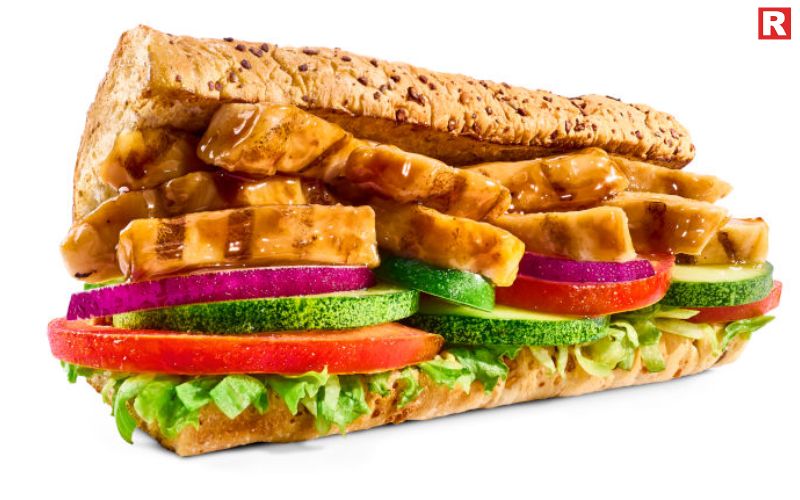
The Chicken Teriyaki sandwich is a sweet and savory option. It has tender chicken coated in a thick teriyaki sauce. The sauce gives it a slightly sweet taste that pairs well with crunchy vegetables. Lettuce, cucumbers, and bell peppers add freshness to the sandwich. It is ideal for people who want something different from the usual flavors. Toasting the bread adds a crisp texture and enhances the taste. Sweet onion sauce complements the chicken’s sweetness and brings extra flavor. This sandwich is a great choice for lunch or dinner. It is both tasty and satisfying without being too heavy.
Know more: Power-Packed Mornings: 8 Protein-Rich Vegetarian Indian Breakfast Ideas
3. Subway Club

The Subway Club is a classic choice among sandwich lovers. It is made with turkey breast, roast beef, and ham. The combination of these three meats creates a balanced and rich taste. It is not too spicy or greasy but still filling. This sandwich is perfect for anyone who wants a hearty meal without feeling weighed down. Fresh vegetables like lettuce, onions, and cucumbers add texture and flavor. Adding mustard or light mayonnaise makes it even better. It works well for lunch or dinner. The Subway Club is a simple yet satisfying sandwich that offers great taste with every bite.
4. Turkey Breast
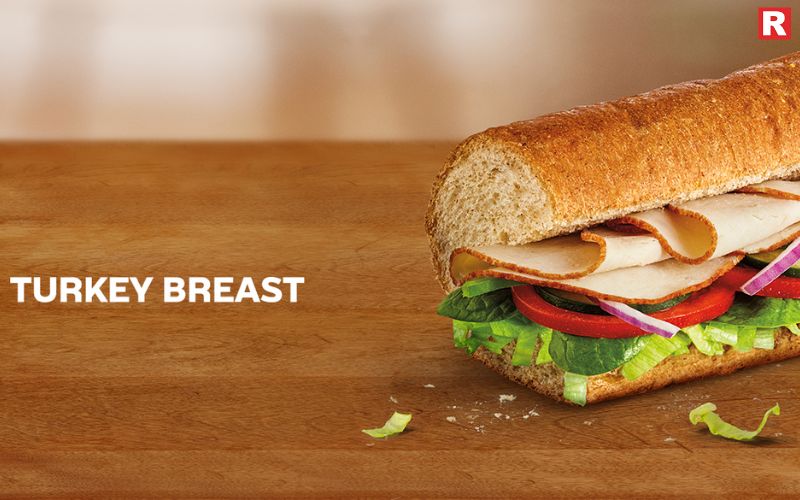
The Turkey Breast sandwich is a healthy option for those who want something light. It is filled with slices of lean turkey, which is low in fat and high in protein. Fresh vegetables like spinach, cucumbers, and onions add crunch and freshness. It is perfect for people who care about eating healthy but don’t want to give up flavor. The sandwich is easy to eat and satisfying without being heavy. It tastes great with sauces like mustard or honey mustard. This option is ideal for lunch or dinner and gives a refreshing and clean taste with every bite.
5. Tuna Sandwich

The Tuna sandwich is one of Subway’s oldest and most loved offerings. It has tuna mixed with creamy mayonnaise. The filling is smooth and rich in flavor. It is simple but very satisfying. Toasting the bread makes the sandwich crisp and adds texture. Cheese and fresh vegetables like lettuce and tomatoes enhance the taste and add more layers of flavor. This sandwich is great for anyone looking for a filling meal that is not too heavy. It works well for lunch or a light dinner. The Tuna sandwich is a classic choice that is both comforting and tasty.
6. Veggie Delight

The Veggie Delight is perfect for vegetarians or anyone wanting a lighter meal. It is filled with fresh and crunchy vegetables. Common toppings include lettuce, tomatoes, cucumbers, onions, and green peppers. For extra taste, olives, pickles, or jalapenos can be added. The sandwich is refreshing and healthy, making it a great option for lunch or dinner. It is not heavy and offers a clean, crisp flavor. The combination of vegetables gives it texture and freshness. People who prefer simple and nutritious meals enjoy this sandwich. It is a great choice for those who want something light but tasty.
Also check: Top 5 States With the Spiciest Food in India
7. Meatball Marinara

The Meatball Marinara is a warm and filling sandwich. It has juicy meatballs covered in rich marinara sauce. The sauce is made with tomatoes, herbs, and spices, giving it a bold flavor. Adding melted cheese makes it creamy and even more delicious. It’s a little messy but very satisfying. This sandwich is perfect for people who enjoy hearty and comforting food. It tastes great on soft white bread or garlic bread. The Meatball Marinara is a treat that fills you up and leaves you happy. It’s a popular choice for lunch or dinner when you want something rich and warm.
8. Roast Beef

The Roast Beef sandwich is a great option for people who love strong flavors. It is made with thin slices of roast beef cooked to bring out a savory taste. The meat is high in protein and very filling. Spicy mustard or horseradish sauce adds extra heat and flavor. Fresh vegetables like onions, lettuce, and pickles give the sandwich a crunchy texture. The flavors balance well, making it enjoyable without being too heavy. This sandwich is simple but satisfying. It works well for lunch or a quick dinner. Anyone who loves bold, meaty flavors will enjoy this choice.
9. Chicken Ham

The Chicken Ham sandwich is a lighter, softer option on the Subway menu. It has slices of chicken ham that are mildly flavored. This makes it great for people who prefer gentle tastes. It pairs well with fresh vegetables like lettuce, cucumbers, and onions. Adding sauces like honey mustard or barbecue sauce can give it extra flavor. The sandwich is easy to eat and not too spicy. It’s a good choice for breakfast or lunch when someone wants something simple and tasty. The Chicken Ham sandwich is filling but not too heavy, making it a perfect everyday option.
10. Paneer Tikka Sub (India Special)
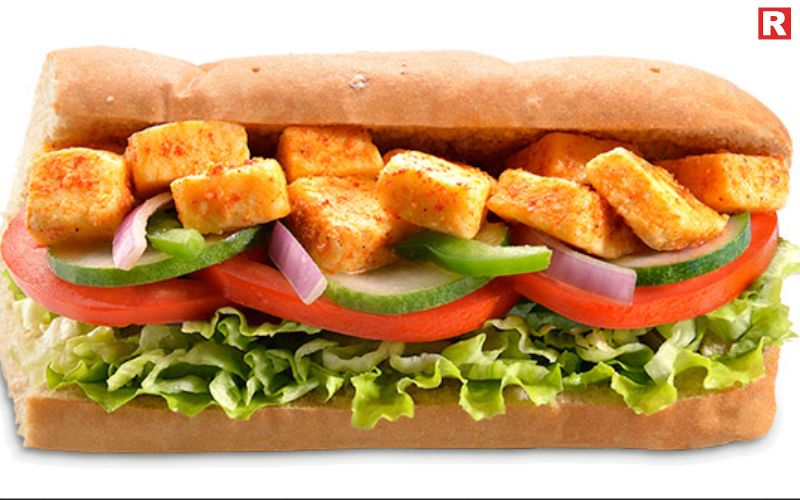
The Paneer Tikka Sub is a unique sandwich available in India. It combines Subway’s style with popular Indian flavors. The paneer pieces are marinated in spices like turmeric, chili powder, and garam masala. This gives the sandwich a spicy and bold taste. Fresh toppings like onions, cucumbers, and mint chutney add crunch and freshness. It’s perfect for those who enjoy spicy and flavorful food. The sandwich is filling and full of texture. It shows how Subway adapts to local tastes while keeping its signature style. The Paneer Tikka Sub is a must-try for anyone who loves Indian flavors.
Tips to Make Your Subway Experience Better
- Choose the right bread – Italian herbs and cheese bread adds extra flavor to simple sandwiches like Turkey or Veggie Delight.
- Don’t skip toasting – Toasted bread gives a crispy texture and makes the sandwich taste better.
- Pair sauces carefully – Sweet onion sauce works well with Chicken Teriyaki, while chipotle southwest sauce adds spice to Italian B.M.T.
- Add more veggies – Pick lettuce, spinach, cucumbers, and onions for a fresh, crunchy bite.
- Balance the flavors – Combine one spicy sauce with a creamy one like mayonnaise to balance heat and texture.
Check more: Different Types of Bars to Explore in 2025: Where Drinks Meet Vibes
7 Types of Whiskies Everyone Should Try Once
Top 8 Must-Try Sandwiches from Around the World
Your Sub Treat!
Subway sandwiches are more than just fast food. They are customizable meals that suit every taste and lifestyle. From classic meat lovers to health-conscious eaters and spice lovers, Subway has something for everyone. These 10 must-try sandwiches will give you the best experience Subway has to offer.
So next time you visit Subway, don’t just order the first option you see. Explore the menu, try something new, and make it your own. Whether it’s the bold Italian B.M.T. or the comforting Meatball Marinara, each sandwich is a tasty journey waiting for you to enjoy. Start with one, experiment with your favorite ingredients, and discover how simple bread and fillings can turn into a delicious and fulfilling meal.

The world of superfoods is vast and enormous. Still, not any food can become a superfood. However, chia seeds, which have recently sparked a wave in the healthy food industry, are the ones that deserve to be a superfood. These are a nutritional powerhouse with their ability to store many key nutrients in such a small amount. The origin of chia seeds can be dated back to the ancient Aztec and Mayan civilizations, where chia seeds were once renowned for their ability to help maintain endurance and energy. In fact, the term "chia" itself is derived from the Mayan word for "strength."
In addition to its amazing health benefits, this ancient staple has seen a spectacular comeback in popularity today due to its extraordinary cooking possibilities. Unlocking the magic of chia seeds is one of the easiest and most effective ways to enhance your daily nutrition, whether you are a dedicated health enthusiast or someone just beginning their health journey. In this article, we will be discussing the multiple health benefits of these tiny but nutrient-dense seeds, and also give you tips on how to enjoy them in your meals.
Read more: Top Drinks You Should Consume to Get a Festive Glow
The Unbelievable Nutritional Powerhouse
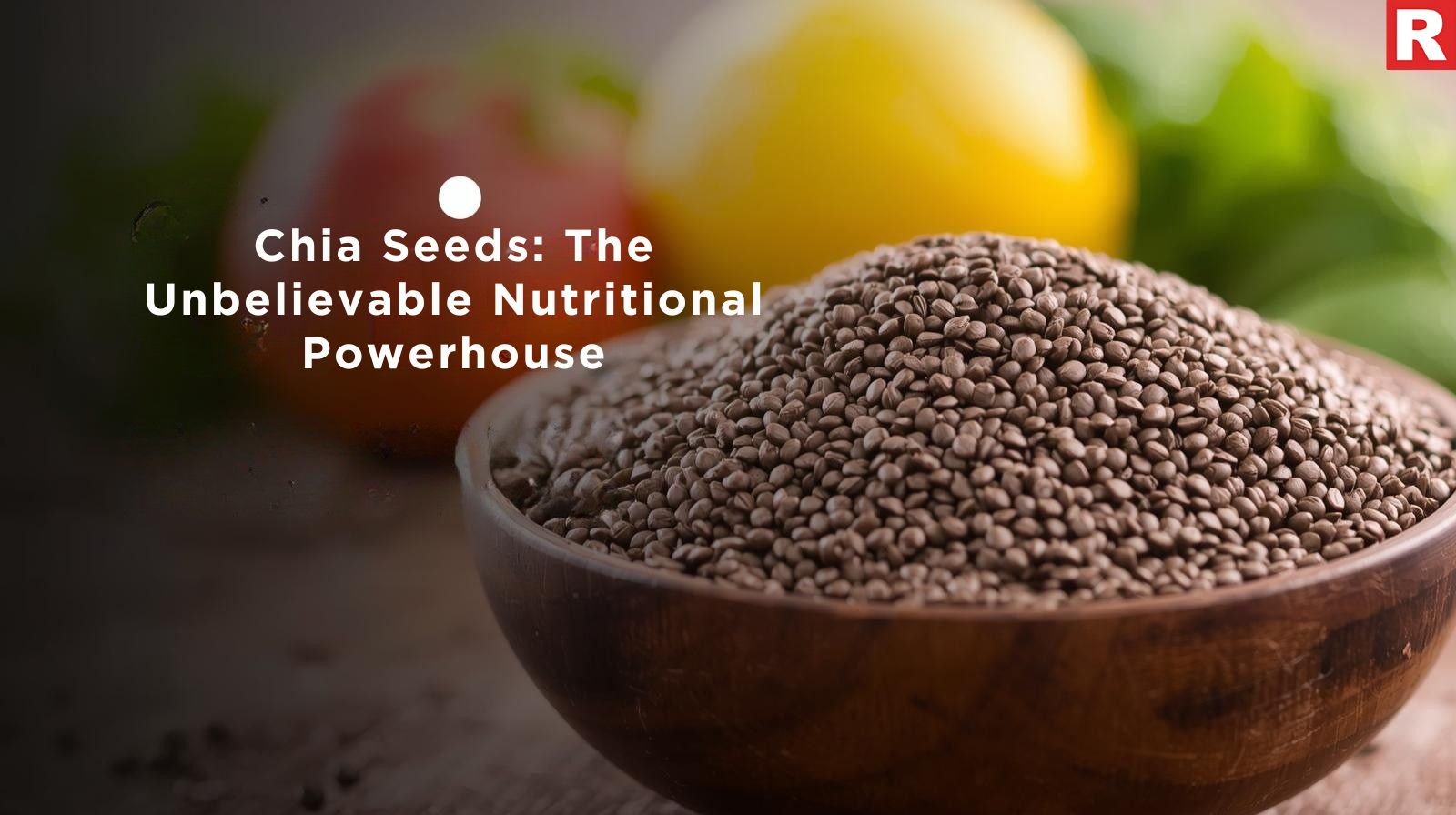
Don't be fooled by how small these seeds are. Rich in vital nutrients, chia seeds are a nutritional powerhouse that can improve your health from the inside out. Let's take a closer look at what makes them unique.
1. Rich in Omega-3 Fatty Acids
The remarkably high amount of omega-3 alpha-linolenic acid (ALA) in chia seeds is one of its main factors. Chia seeds are actually among the best organic sources of this essential fatty acid. ALA is essential for heart health because it lowers blood pressure, reduces inflammation, and lowers the risk of heart disease. By incorporating chia seeds into their diet regularly, vegetarians and vegans can easily meet their omega-3 requirements without relying on fish oil supplements.
2. A Fiber Champion
A single two-tablespoon serving of chia seeds provides a great amount of daily intake of fiber intake, making them a genuine champion of the fiber space. They contain both soluble and insoluble fiber, which are essential for digestive health of a person. By forming a gel-like structure in your stomach, the soluble fiber slows down digestion, increases feelings of fullness, and helps keep blood sugar levels stable. Chia seeds are, therefore, a great tool for people with diabetes and for managing their weight. By giving your stool more volume, the insoluble fiber encourages regular bowel movements and keeps constipation at bay.
3. Complete Plant-Based Protein
For people looking to attain protein from plant sources and increase their protein intake, chia seeds are the best option. They have a complete amino acid profile, since they provide all nine essential amino acids that our bodies are unable to manufacture on their own. Because of this, they are a better source of protein than many other plant-based options and are a great complement for athletes and plant-based diet followers.
4. Loaded with Antioxidants
Chia seeds are rich in antioxidants, which are substances that combat free radicals and lessen the body's oxidative stress. This defense mechanism supports general cellular health, lowers the risk of chronic diseases, and fights aging symptoms. Chia seeds' antioxidants also keep their delicate omega-3s from getting oxidized, which is another reason why they stay fresh for so long.
5. Abundant Minerals
Chia seeds are an excellent source of vital minerals in addition to their macronutrient composition. Their calcium content is surprisingly high, surpassing that of the majority of dairy products by weight. They are also a good source of phosphorus, which combines with calcium to form strong bones and teeth, and magnesium, which is essential for healthy muscles and nerves.
Know more: 10 Popular Energy Drinks and Their Benefits
How Chia Seeds Work
The amazing capacity of chia seeds to absorb liquid and create a gel is among their most appealing qualities. Their high soluble fiber content gives them their special quality. They can absorb up to 10–12 times their weight in water or another liquid, giving them a pudding-like consistency. Their versatility comes from their natural gelling effect, which makes them an excellent natural thickening, binder, and texturizer in a wide range of recipes.
Their capacity to gel also adds to their health advantages. The seeds help you feel full and satisfied for longer after eating, which can reduce overeating and help you lose weight.
Delicious Ways to Enjoy Chia Seeds
Are you prepared to begin using this superfood in your diet? Because of their neutral flavor, chia seeds may be used in almost any meal without changing its flavor, making them extremely easy to use. Here are a few of the most popular and delicious ways to eat them.
Chia Pudding: The Classic Staple

Chia pudding is perhaps the most well-known usage for chia seeds, and with good reason for that. It's easy, tasty, and incredibly customizable. It is ideal for a nutritious dessert or a breakfast that can be prepared in advance.
Simple Recipe for Chia Pudding:
Ingredients:
- Chia seeds, two tablespoons
- Half a cup of liquid, such as ordinary milk, almond milk, coconut milk, or oat milk
- One teaspoon of sweetener, such as honey, maple syrup, or a few drops of stevia
- Half a teaspoon of vanilla essence (optional)
Instructions:
- Mix the chia seeds, liquid, sweetener, and vanilla essence thoroughly in a basin or container.
- After letting the mixture settle for roughly five minutes, whisk it once more to remove any remaining clumps.
- Cover and chill for at least two hours, or better yet, overnight, until it thickens and takes on the consistency of pudding.
- Before serving, sprinkle your preferred chocolate chips, nuts, or fruits on top.
Innovative Variations:
- Add 1 tablespoon of cocoa powder to the chocolate chia pudding.
- Mash a handful of fresh berries into the mixture to make Berry Chia Pudding.
- Use coconut milk to make tropical chia pudding, then garnish with pineapple and mango.
What's new: Top 10 Non-alcoholic Drink Ideas for Your Restaurant
Smoothie & Juice Boosters

One of the simplest ways to receive a nutritious boost without even realizing it is to add chia seeds to your fresh juices or smoothies. Just put a tablespoon or two into your blender along with the rest of your ingredients. In addition to adding fiber, protein, and healthy fats, they will thicken the smoothie and make it a more nutritious and delicious meal.
Baking & Cooking Add-Ins
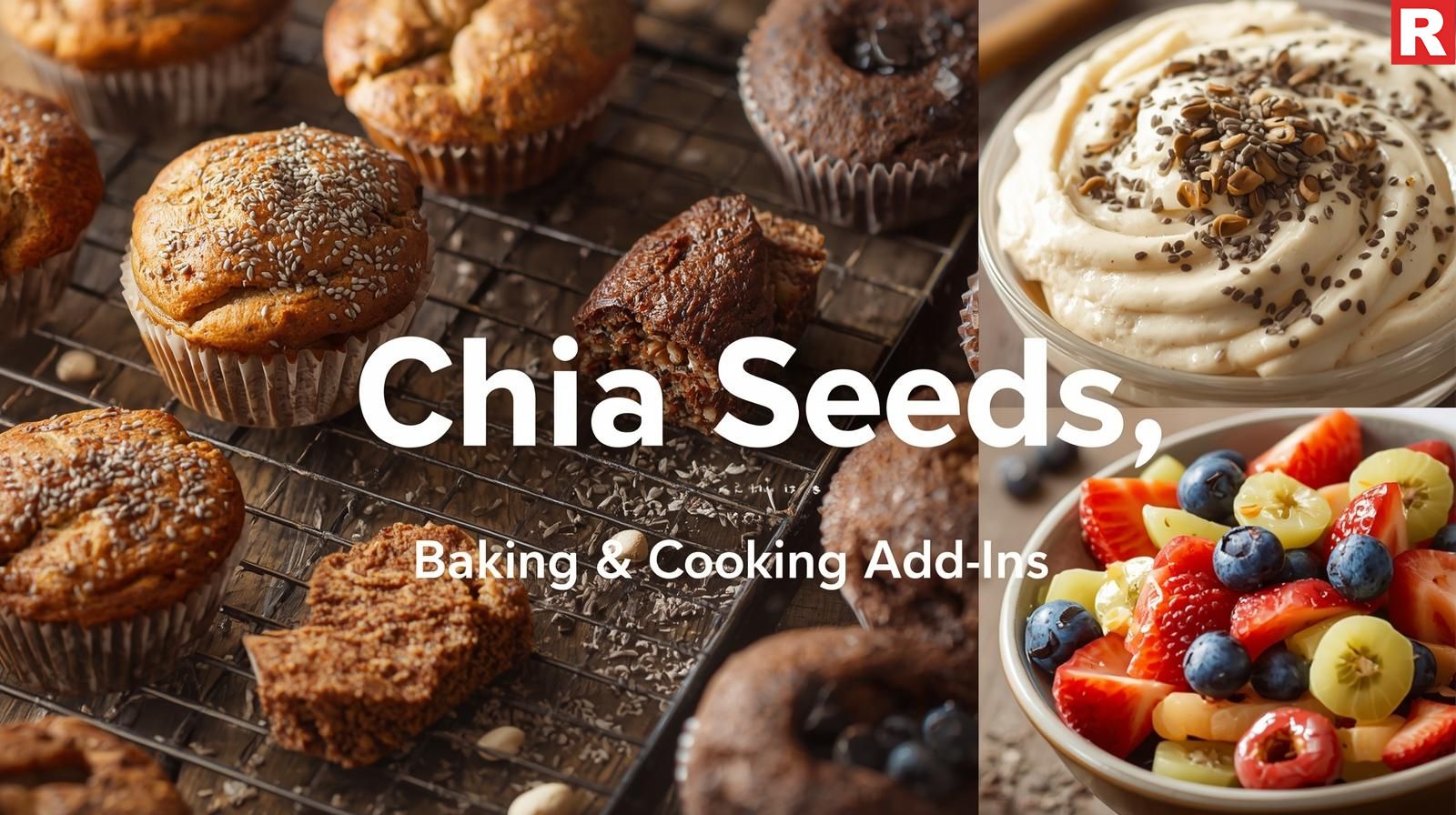
Chia seeds are a great gluten-free option to enhance baked foods' nutritional value and texture.
- In breads and muffins: Add them to the mix for a nice crunch and fiber boost.
- As an Egg Substitute: A "chia egg" is the ideal option for vegan or egg-free baking. To make a gel, combine 1 tablespoon of chia seeds with 3 tablespoons of water and let for 5 minutes. In most recipes, this mixture can be used as a binder in place of one egg.
Toppings & Garnishes
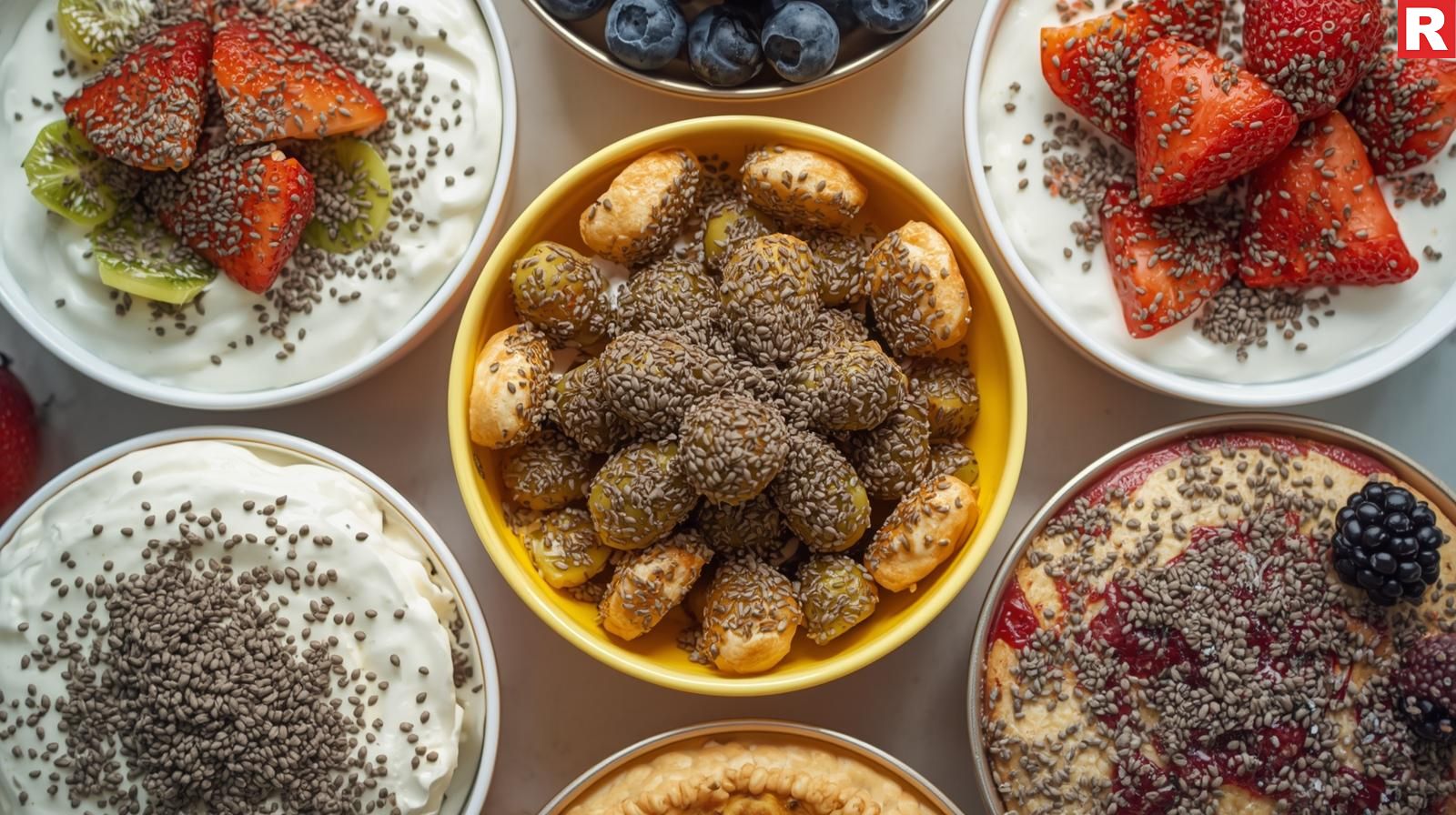
If you don’t want to mess with a recipe or simply need a good garnish to finish your dish, then you can simply sprinkle a tablespoon of crushed or whole chia seeds on your favorite dishes. They will be perfect for:
- Yogurt or oatmeal
- Salads
- Cereal
- Fresh fruit bowls
- Soups
Chia Fresca: The Ancient Energy Drink

Chia Fresca is a refreshing, hydrating beverage that originated in Mexico and is very simple to prepare. It's ideal as a refreshing beverage on a hot day or as a natural energy boost before working out.
Easy Recipe for Chia Fresca:
Ingredients:
- One or two tablespoons of chia seeds
- One cup of water
- Half a lemon or lime's juice
- Your preferred sweetener (to taste)
Instructions:
- Add the chia seeds to the water and stir.
- Let them soak for 15 to 20 minutes, stirring now and then, until they take on the consistency of gel.
- Add the sweetener and lemon or lime juice. Mix thoroughly and serve cold.
In short, there are multiple ingredients and many customizable ways to eat chia seeds. You can enjoy them with your choice of element, like yogurt, fruits, berries, water, or even milk.
Check out: Best Foods for Glowing Skin & Healthy Hair
How to Make a Healthy Dessert With Just 5 Ingredients
Tips for Buying, Storing, and Using Chia Seeds
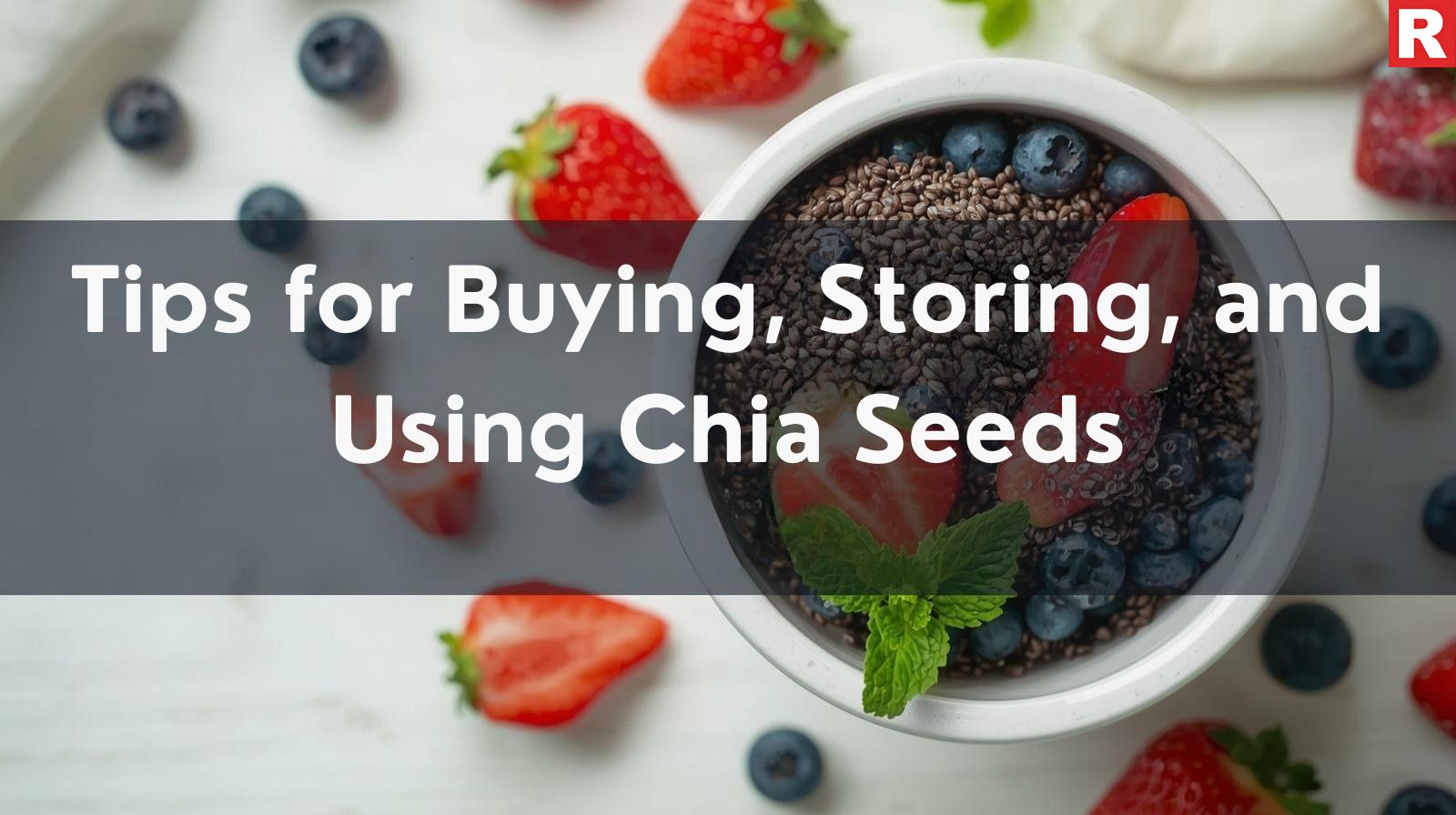
Knowing a little bit about chia seeds will help you get the most out of them.
- Buying: When purchasing, look for whole chia seeds in a bag or sealed container. They are available in both black and white forms and have the same nutritional value.
- Storage: Chia seeds have a long shelf life because of their consistent antioxidant content. Keep them in a cool, dark location, such as your pantry, in an airtight container. They can last for a number of years.
- Hydration: Although it's not technically required, soaking chia seeds beforehand can facilitate digestion and guarantee that you receive the full advantages of their gel-like quality. Make sure to stay hydrated throughout the day if you take them dry.
- Dosage: Start with one to two tablespoons daily. To make sure your digestive system gets used to the high fiber level, this is a good starting quantity.
Read this: 10 vegetarian foods that are healthy and suitable for Fasting
The Simple Magic of Chia
Chia seeds stand out for their stunning simplicity and undisputed effectiveness in a world full of complicated diets and pricey supplements. They provide a powerful plant-based supply of protein, fiber, omega-3 fatty acids, and vital minerals in a small, simple package. Their "magic" is found in their potent, natural ability to support and nourish the body rather than in a secret element.
Chia seeds are a monument to the idea that some of the most powerful changes originate from the tiniest sources, whether they are added to your favorite dish, mixed into a morning smoothie, or made into a filling pudding. Accept the chia magic and learn how this age-old superfood can improve your life pleasantly and healthfully.

Everyone loves a good sandwich. It’s one of the simplest and most satisfying meals. It can be eaten on the go or enjoyed while sitting with friends. But a sandwich is more than just bread and fillings. It is a way to experience different cultures and flavors from around the world. Sandwiches have a story to tell. Many of them were created because of migration, trade, or local ingredients. Some are made by street vendors and loved by everyone. Others are served in cafes and restaurants. Each sandwich reflects the taste and traditions of the place where it was made. For people who enjoy trying new foods, sandwiches are a great way to explore the world. They are easy to make, but the flavors can be bold and surprising. From spicy to sweet, crunchy to soft, there is something for every taste.
This guide introduces some of the best sandwiches from different countries. These are not ordinary sandwiches. They are unique, full of flavor, and tell a story. Adding them to one’s foodie list is a delicious way to travel without leaving the table.
Read more: A Guide to Different Breads and Their Nutritional Value
7 Healthy Chicken Dishes to Maintain Your Diet
Why You Should Try These Sandwiches
What makes sandwiches so special?
- First, they are easy to carry and quick to prepare. They can be made with local ingredients and adapted to different tastes. Every country has its own version of a sandwich, shaped by history, geography, and culture.
- Second, sandwiches bring people together. You can share them with family or friends, enjoy them at festivals, or grab one on the go. They are affordable and accessible, making them perfect for people from all walks of life.
- Finally, sandwiches are endlessly creative. Whether you like them spicy, sweet, tangy, or savory, there’s a version for everyone. Even small changes, like adding herbs or sauces, can turn an ordinary sandwich into something extraordinary.
1. Banh Mi – Vietnam’s Flavor Explosion
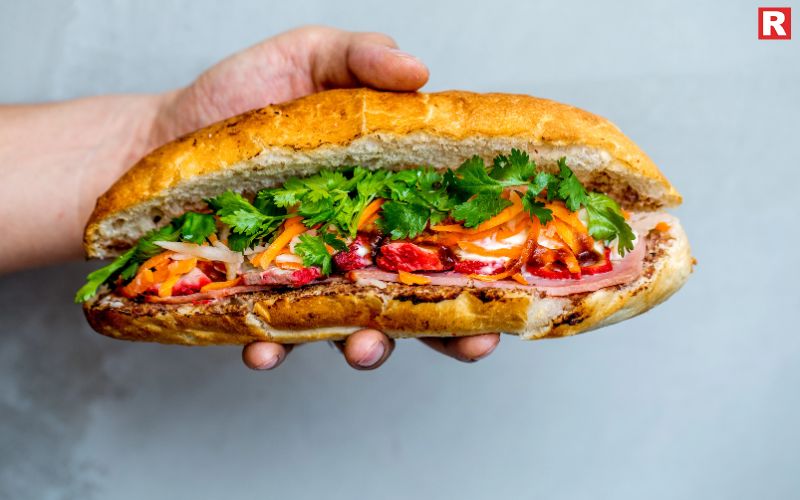
Banh Mi is one of the most famous sandwiches from Vietnam. It is crunchy and fresh, with a mix of flavors that surprise your taste buds. The sandwich is made with a light and crispy baguette, pickled carrots and daikon, fresh cilantro, cucumber, and either pork, chicken, or tofu. Sometimes pate is added for extra richness.
The story behind Banh Mi is interesting. It started during French colonial times when baguettes were introduced to Vietnam. Locals added their own spices, herbs, and flavors. Now, it’s sold on almost every street corner in Hanoi and Ho Chi Minh City. It’s cheap, fast, and full of taste. If you love tangy and spicy flavors, this sandwich will become your favorite.
2. Cubano – A Slice of Cuba in Miami
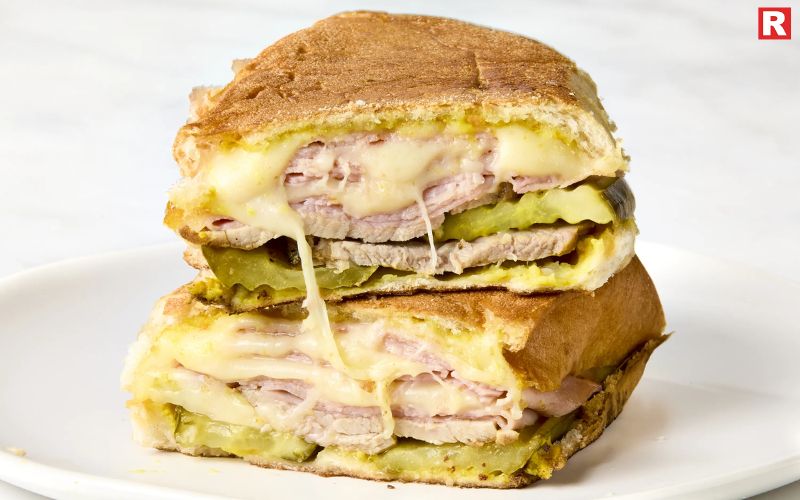
The Cubano sandwich is a delicious treat from Cuba but made famous in Miami, Florida. It’s a pressed sandwich filled with slow-roasted pork, ham, Swiss cheese, pickles, and mustard. All of this is layered between soft Cuban bread and then toasted until golden and crispy.
This sandwich tells a story of migration. When Cubans moved to the U.S., they brought their food with them. Today, the Cubano is a must-try dish in Cuban restaurants and cafes. It’s hearty and perfect for lunch. The balance between salty meats, tangy pickles, and melted cheese is what makes this sandwich stand out.
Know more: 7 Chinese Dishes That Can Be a Healthy Option for Your Diet
3. Smorrebrod – Denmark’s Open-Faced Art
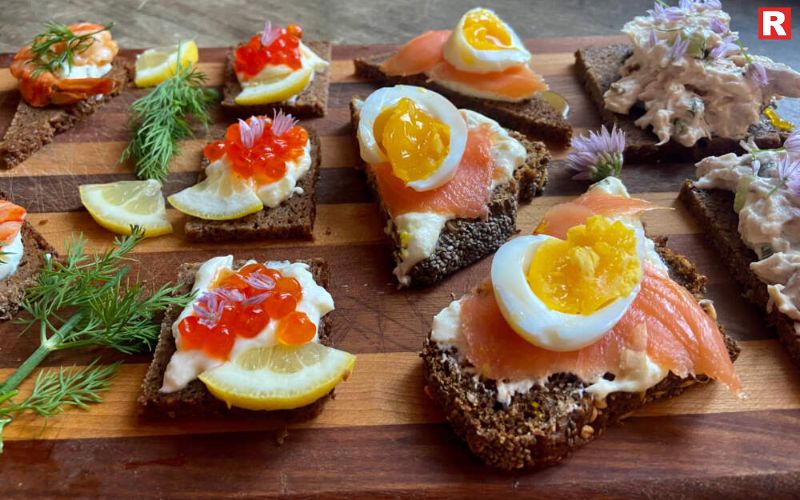
Smorrebrod is Denmark’s take on sandwiches. It’s open-faced, which means the toppings sit right on top of the bread without another slice covering them. The base is usually rye bread, and it’s topped with ingredients like cured meats, herring, cheese, or liver pate. Fresh herbs and sauces make it even more flavorful.
For Danish people, Smorrebrod is more than food – it’s an art form. Many restaurants offer beautifully plated versions with balanced flavors and textures. It’s a great way to taste different ingredients in one dish. If you ever visit Copenhagen, stop by a local cafe and try this simple yet elegant sandwich.
4. Muffuletta – New Orleans’ Italian Masterpiece

Muffuletta comes from New Orleans but has roots in Sicily, Italy. It’s a round sandwich made with Italian bread, layers of salami, ham, mortadella, and provolone cheese. What makes it special is the olive salad spread that adds a bold and tangy flavor.
This sandwich was created by Italian immigrants in the early 1900s. They needed something filling, portable, and affordable. Today, the Muffuletta is a staple at delis and markets in New Orleans. It’s perfect for sharing and offers a great mix of textures – crunchy bread, soft cheese, and a zesty olive spread.
5. Medianoche – Cuba’s Sweet Treat
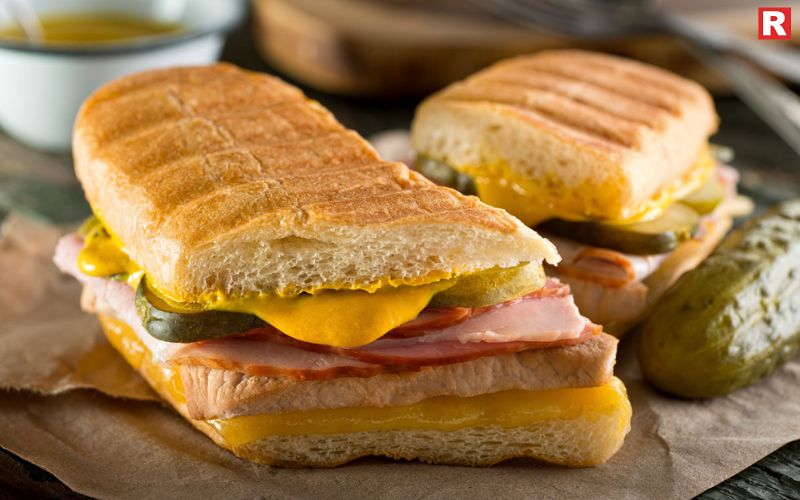
If you’ve tried the Cubano, you must also taste the Medianoche. The word “Medianoche” means midnight in Spanish. This sandwich is similar to the Cubano but uses sweeter, softer bread. The fillings are the same – pork, ham, Swiss cheese, and pickles – but the texture is lighter.
Medianoche is a favorite late-night snack in Havana. It’s often paired with coffee or rum for a midnight indulgence. The soft bread absorbs the juices and creates a rich, satisfying bite. If you want to try something a little sweeter and softer, this sandwich is a must.
Also check: 12 Delicious High-Protein Foods to Eat Daily for a Healthier You
6. Choripan – Argentina’s Street BBQ Star
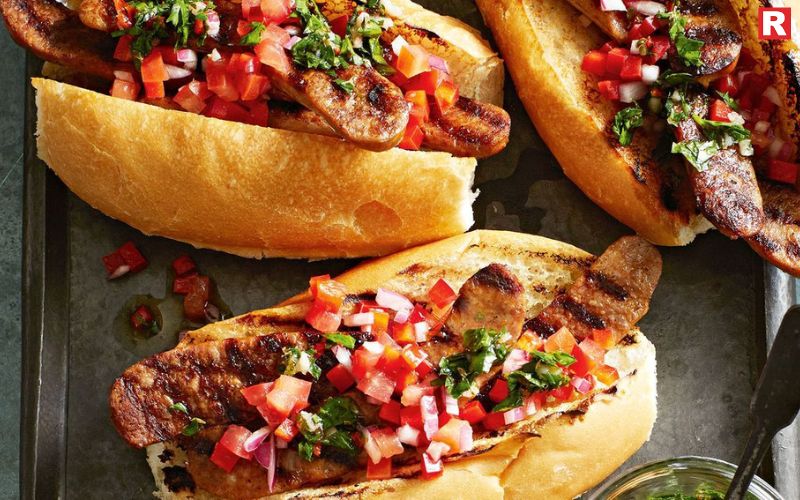
Choripan is Argentina’s version of a sausage sandwich. It’s simple but incredibly flavorful. A grilled chorizo sausage is placed inside a crusty roll and topped with chimichurri sauce, made of parsley, garlic, vinegar, and oil.
You’ll find Choripan at street stalls, football matches, and festivals across Argentina. It’s a quick and tasty meal, often eaten standing up with friends. The smoky sausage and fresh herbs create a bold, zesty experience. If you enjoy spicy flavors and grilled meat, this sandwich will not disappoint.
7. Ploughman’s Sandwich – The British Classic

The Ploughman’s Sandwich is a comforting, rustic treat from the UK. It’s made with thick slices of crusty bread, sharp cheddar cheese, tangy pickles, and sometimes slices of apple or onion. It’s simple but satisfying.
This sandwich was inspired by the Ploughman’s Lunch, a traditional British meal eaten by farmers. It’s hearty and filling, with flavors that complement each other beautifully. Many pubs still serve this classic today, and it’s perfect for a relaxing afternoon tea or picnic.
8. Katsu Sando – Japan’s Crispy Comfort
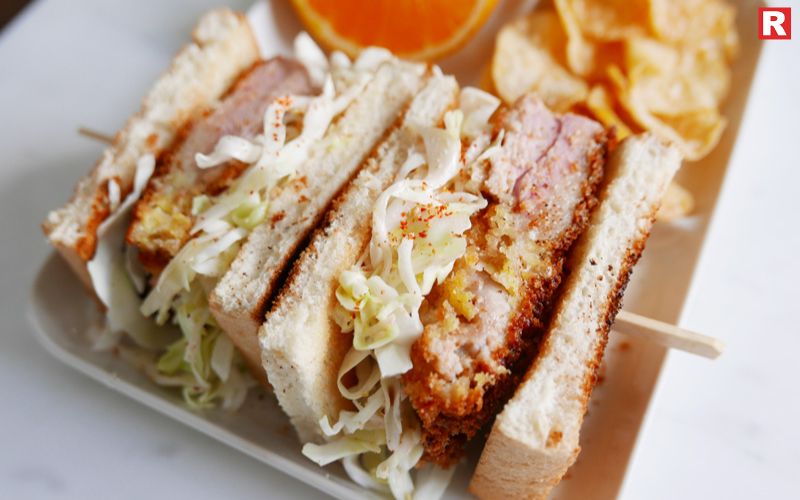
Katsu Sando is Japan’s answer to fried comfort food. It features a pork cutlet coated in crispy panko breadcrumbs and deep-fried until golden. The meat is then topped with tangy tonkatsu sauce and sandwiched between slices of soft white bread.
You’ll find this sandwich at convenience stores, cafes, and restaurants across Japan. It’s popular among students and office workers who want something filling but easy to eat. The crisp outside and juicy inside create a delightful contrast. Even if you’re new to Japanese food, this sandwich is a great introduction.
Check more: Pani Puri Has Different Names in Different Indian States—Know Them All
7 Reasons to Add Macadamia Nuts to Your Daily Diet
5 Foods to Avoid for Better Cholesterol
How to Try These Sandwiches
If you can travel, seek out local street food stalls or restaurants that serve authentic versions. If you can’t travel, you can recreate them at home. Many ingredients are easy to find, and some sandwiches only need a few fresh items to get close to the original taste.
Start with one sandwich and build from there. For example, try making a simple Banh Mi with pickled vegetables and pork. Or experiment with a Ploughman’s Sandwich using cheddar and pickles from your local market. Once you start, you’ll find that making sandwiches can be fun and rewarding.
Final Thoughts
Sandwiches are more than just something to eat between meals. They show culture, creativity, and traditions from different parts of the world. Every sandwich has a story. Some were created because people moved to new places. Others were made during hard times or for celebrations. When someone tries these sandwiches, it’s like tasting a piece of history. These sandwiches are full of different flavors and textures. Some are spicy, others are sweet or crunchy. Each one offers a new experience. Instead of eating the same sandwich every day, trying something new can be exciting. Starting with one sandwich is easy. It can open the door to exploring more. Bread, fillings, and spices come together in ways that are surprising and delicious. Sandwiches are also a way for people to connect. Sharing food can bring friends and families closer, one bite at a time. It’s a simple way to enjoy life’s flavors.

Living in the modern world has become a race against time. In fact, everyone is surviving here instead of living where each day becomes more hectic than the other. From daily schedules that are too demanding to daily exercise routines that are actually designed to get fit but only end up taking more of our energy, or just the desire to go through the day, people need an energy boost to go through everything. This leads us to reach out to carbonated energy drinks. These beverages, which are designed to give us a rapid boost of energy, increase our mental clarity, and help us perform better physically, are getting more popular day by day. But not each drink is the same, and drinking anything would not give you the energy boost you need.
So, in this article, we will dive into the world of energy drinks and pick up the 10 most popular brands from the market. To help you comprehend the different benefits they offer and how they provide that much-needed boost, we'll break down the main components of each, from sugar and caffeine to extra vitamins and performance-enhancing substances.
Read more: What Are Rail Drinks? The Anatomy of Your Cheapest Night Out
Understanding the Basics of Energy Drinks

The majority of energy drinks use a similar combination of substances to produce their energizing effects. Caffeine, a naturally occurring substance that blocks the brain's adenosine receptors( these receptors induce sleep and exhaustion) to lessen feelings of exhaustion, is usually the main ingredient. In addition to caffeine, many contain a combination of sugars (such as sucrose and glucose) for a rapid energy boost, B vitamins (B2, B3, B6, and B12) to help with energy metabolism, and other safe stimulants and substances.
Typical additives are as follows:
- Taurine: An amino acid considered to be involved in physical performance, taurine promotes nerve growth.
- Guarana: A high-caffeine plant extract that is frequently utilized to extend the stimulating effects of drinks.
- Ginseng: A botanical extract that is said to increase vitality and lower stress levels.
- L-Carnitine: One substance that helps turn fat into energy is L-carnitine.
Even while these components may provide advantages like improved attention and alertness, it's important to use energy drinks sensibly. If taken in excess, the high amounts of sugar and caffeine may cause adverse side effects.
Disclaimer: This article is intended for general informational purposes only and should not be considered a substitute for professional medical advice, diagnosis, or treatment. Readers are advised to consult a qualified healthcare professional before making any dietary, health, or lifestyle changes.
Top 10 Popular Energy Drinks and Their Profiles
This article provides a thorough analysis of ten well-known energy drinks, highlighting their main characteristics, advantages, and nutritional data per average 16-ounce (473 ml) can, unless otherwise noted.
1. Red Bull

It is the undeniable leader that established the whole energy drink market. Red Bull's famed "gives you wings" tagline and iconic slim can are well-known around the world. It is a high-end product that is frequently linked to excellent performance and late-night productivity in India. It gives you a strong physical and mental boost.
Caffeine: 75 mg per 250 ml can.
Sugar: 27.5 g (11 g per 100 ml) per 250 ml can.
Calories: 115 kcal (46 kcal per 100 ml) per 250 ml can.
Energy Type: A physical jolt paired with a focused and alert mental boost.
Know more: Coffee Cocktail Drinks: 10 Must-Try Options to Follow in 2025
2. Monster Energy

Red Bull's major rival, Monster, is renowned for its huge can size and strong, "no-nonsense" branding. It is well-liked by athletes, gamers, and anybody else in need of a stronger energy boost since it provides a stronger and longer-lasting energy boost than its competitors. Its combination of B vitamins, taurine, and caffeine seeks to provide a full-bodied energy boost.
Caffeine: 160 mg per 500 ml can.
Sugar: 55 g per 500 ml can.
Calories: 237 kcal per 500 ml can.
Energy Type: A strong, continuous energy boost that is perfect for extended periods of mental or physical exertion.
3. Sting

Sting, a PepsiCo product, has swiftly gained popularity in India's mass market thanks to its affordable price and unique, sweet taste. College students and young adults looking for a quick and easy energy boost are particularly fond of it. Its flavor and vivid color are two of its main attractions.
Caffeine: 72 mg per 250 ml bottle.
Sugar: 17.5 g (7 g per 100 ml) per 250 ml bottle.
Calories: 70 kcal (28 kcal per 100 ml) per 250 ml bottle.
Energy Type: A quick energy boost that is fueled by high-octane sugar and caffeine.
4. Gatorade

Despite being a sports drink rather than a usual energy drink, Gatorade is popular in India because it replenishes energy, especially during or after physical activity. Although it doesn't include caffeine, it gives you energy by restoring the body's electrolyte and glucose balance after you sweat out.
Caffeine: 0 mg.
Sugar: 30 g (6 g per 100 ml) per 500 ml bottle.
Calories: 120 kcal (24 kcal per 100 ml) per 500 ml bottle.
Energy Type: Hydration and electrolyte replacement provide energy for physical activity and recovery.
What's new: Top 10 Non-alcoholic Drink Ideas for Your Restaurant
5. Mountain Dew

Because of its high sugar and caffeine content, Mountain Dew, a classic soft drink, serves as an unofficial energy drink for many Indians. It provides a brief, sweet thrill along with a caffeine spike. Its "Darr Ke Aage Jeet Hai" motto and unique citrus flavor have made it strongly associated with taking risks and conquering obstacles.
Caffeine: Approximately 54 mg per 600 ml bottle.
Sugar: 73 g per 600 ml bottle.
Calories: 282 kcal per 600 ml bottle.
Energy Type: A fast, high-sugar energy boost that gives you a sugary high and a brief mental clarity boost.
6. Thums Up Charged

This version of Thums Up, a variant of the well-known Indian cola brand, is promoted for having more caffeine. This cola, which has a high caffeine content, promises a strong energy boost while maintaining the rich, well-known flavor of the original Thums Up. Customers who desire the traditional cola experience with a big energy boost are pleased to by it.
Caffeine: 61.5 mg per 250 ml bottle.
Sugar: 18.25 g (7.3 g per 100 ml) per 250 ml bottle.
Calories: 75 kcal (30 kcal per 100 ml) per 250 ml bottle.
Energy Type: A strong energy boost along with the robust, well-known flavor of a traditional cola.
7. Tzinga

With a variety of unique and tasty options, the energy drink brand Tzinga has effectively established a niche for itself in the Indian market. It is a well-liked substitute for more costly foreign brands since it has a reputation for being an affordable option that also provides a consistent energy boost.
Caffeine: 72 mg per 250 ml can.
Sugar: 18 g per 250 ml can.
Calories: 82 kcal per 250 ml can.
Energy Type: A quick, accessible, and efficient energy boost that comes in a range of tastes.
Check out: 6 Fermented Drinks Known To Support Digestive Health
10 Delicious Detox Drinks | Easy Detox Drinks for Summers
8. Cloud 9

An Indian energy drink company called Cloud 9 is well-known throughout the nation and has a traditional, citrus-inspired flavor profile. A popular choice for a wide variety of customers, it is promoted as a reviving and delightful carbonated beverage that gives a rapid energy boost.
Caffeine: Although not always stated on the box, caffeine content is usually between 70 and 80 mg per 250 ml, which is comparable to other energy beverages.
Sugar: Approximately 27.5 g per 250 ml can.
Calories: Approximately 110 kcal per 250 ml can.
Energy Type: An energizing and revitalizing energy boost that is ideal for a last-minute pick-me-up.
9. Power Horse

Power Horse is a well-known global brand that has established a significant presence in the Indian market thanks to its potent, somewhat sweeter flavor profile. It offers a steady and dependable energy boost, making it appealing to a large Indian consumer base that appreciates the flavor and functionality of a reputable international brand.
Caffeine: 80 mg per 250 ml can.
Sugar: 27.5 g (11 g per 100 ml) per 250 ml can.
Calories: 110 kcal (48 kcal per 100 ml) per 250 ml can.
Energy Type: A consistent energy boost that supports lasting alertness and attention.
10. Wild Tiger

Another well-known Indian company that has centered its branding on a unique, exotic appearance is Wild Tiger. Well-known for its unique taste and frequently available in a range of retail locations, it offers a consistent and strong energy boost and is a dependable substitute for some of the more costly brands.
Caffeine: Usually between 70 and 80 mg per 250 ml can, though this is not always the case.
Sugar: 25 g per 250 ml can.
Calories: 125 kcal per 250 ml can.
Energy Type: A reliable and constant energy boost that promotes mental clarity and fights weariness.
Read this: Frankenstein-Inspired Foods and Drinks for Your Spooky Celebrations
A Word of Caution: The Risks
Energy drinks can be a helpful tool, but it's important to be aware of any potential drawbacks. Many of these drinks include a lot of sugar, which can lead to tooth decay, weight gain, and other health problems. An increased heart rate, jitters, anxiety, and disturbed sleep can result from consuming too much caffeine. These beverages cannot replace adequate sleep, staying hydrated, and eating a healthy, balanced diet. You should always be mindful of your own personal caffeine sensitivity and take them in moderation.
Conclusion
Energy drinks, which provide a practical means of overcoming weariness and boosting productivity, have solidified their position in the fast-paced Indian culture. There are several options available on the market, ranging from the well-known Red Bull and Monster to domestic favorites like Sting and Thums Up Charged. Customers may make wise choices if they are aware of the ingredients and nutritional information, particularly the important details about calories, sugar, and caffeine. Always put your health and well-being first, and use these drinks as a tool for a short-term energy boost rather than as an excuse for long-term energy.

The modern food industry is growing through a major revolution that may be silent, but is so powerful that it goes beyond the food. As trends related to personal health and fitness are gaining popularity, people are moving towards ‘staying sober’. As people are staying away from drinking alcohol, there has been an increase in demand for non-alcoholic drinks that are both innovative and delicious. The customers are seeking more than just any soft drink or juice to go with their food. People want unique and exciting drinks that provide the same level of satisfaction as that of any alcoholic drink. This new trend is not just a passing facade that will go away in just a few months or years. For the restaurants that provide high-end meals with alcohol or specialty drinks, adding dynamic non-alcoholic beverages to their menu is a necessity, not a luxury.
This shift towards non-alcoholic beverages is the most beneficial to a customer base that is made up of drivers, non-drinkers to families, and health-conscious customers. Beyond the affordable factor, these drinks can be a significant factor for profitability, frequently have larger profit margins, and lower ingredient prices. Therefore, in this article, we will be covering the top 10 non-alcoholic drinks for your restaurant that are both creative and profitable. They can help increase the customer experience, attract a big customer base, and solidify the restaurant’s reputation as a progressive business.
Read more: Frankenstein-Inspired Foods and Drinks for Your Spooky Celebrations
Why Non-alcoholic Beverages Are a Must-Have for Restaurants
If you ignore the non-alcoholic beverage market, then that means you will be leaving behind a chunk of your revenue and potential customers, and a loyal customer base as a restaurateur. So it is important to know why adding non-alcoholic beverages is important to the business:
- Growing Market: The international market for non-alcoholic drinks is expanding. In India, the party culture is strong due to the large amount of youth population. But, this specific population is also striving towards their own health and fitness, which has also started showing in various aspects of their life, including beverages. The young customers don’t want to compromise on both fitness and experience. This has led to the rise of luxurious, alcohol-free options.
- Increased Profitability: Specialized non-alcoholic drinks, such as house-made sodas and gourmet mocktails, can be priced reasonably to showcase their high-quality ingredients and expertise. They have a higher profit margin than alcoholic drinks due to their cheaper cost of goods, which will greatly increase your bottom line.
- Enhanced Guest Experience: a menu with a diverse range of drinks, varying from sodas to cocktails and non-alcoholic drinks, ensures that every customer, regardless of their drinking habits, feels appreciated and cared for. This inclusion is an effective strategy for increasing customer loyalty and positive word-of-mouth.
- Brand Differentiation: A restaurant that has a non-alcoholic menu is different and unique from its competitors, and stands out in the market. It presents the business as innovative, contemporary, and sincere in its goal of giving everyone a wonderful time.
- Versatility: These drinks are a reliable source of income during all service hours because they may be served at any time of day, from brunch to late at night.
Top 10 Non-alcoholic Drink Ideas
The following ten beverage ideas will turn your non-alcoholic menu from an afterthought to a focal point:
1. Elevated Mocktails

Get rid of the syrupy, excessively sugary recipes from the past. Mocktails today are as elegant, complex, and aesthetically pleasing as their alcoholic counterparts. They make their own syrups, use premium, fresh ingredients, and pay attention to flavor balance.
Key Selling Point: Provides visitors with the delicious flavor and the normal version of a cocktail without the alcohol.
Examples:
- Spiced Guava Cooler: A regionally inspired drink that has a tart, refreshing kick from fresh guava juice, a touch of mint, and a dusting of black salt.
- Cucumber and Basil Smash: a concoction of fresh basil and muddled cucumber, garnished with sparkling water and a tangy lime juice.
- Lavender Lemonade Spritz: A delicate combination of fresh lemon juice, homemade lavender syrup, and sparkling water, topped with a lavender sprig.
2. Artisanal Iced Teas

Serve more than simply plain iced tea. Take advantage of this to highlight unique flavors and brewing methods. Cold brewing produces a smoother, less bitter flavor profile, which makes it an excellent method.
Key Selling Point: very customizable with various tea varieties and flavor infusions, refreshing, and low in calories.
Examples:
- Peach & Rosemary White Tea: A delicate white tea flavored with a fragrant rosemary sprig and luscious peach purée.
- Hibiscus & Ginger Iced Tea: The spicy warmth of fresh ginger nicely balances the tartness of hibiscus blooms.
- Masala Chai Iced Latte: Using cold-brewed masala tea concentrate mixed with milk and served over ice, the Masala Chai Iced Latte is a contemporary Indian take on a traditional beverage.
Know more: Best Bar Blender Brands in India – Power, Precision, and Reliability
3. Creative Lemonades and Limeades

A gourmet makeover of a classic that has been around for a while. A basic beverage can be transformed into a memorable one by incorporating different and fresh fruits, herbs, and spices.
Key Selling Point: A beloved classic with a contemporary spin that feels thrilling and new.
Examples:
- Kiwi & Mint Limeade: Fresh kiwi, muddled mint leaves, and lime juice combine to create the bright green Kiwi & Mint Limeade.
- Spiced Orange Lemonade: Freshly squeezed orange and lemon juice with a touch of cloves and cinnamon is called spiced orange lemonade.
- Strawberry Basil Lemonade: The flavorful, peppery undertones of fresh basil and luscious strawberries are well balanced.
4. Specialty Hot and Cold Coffees
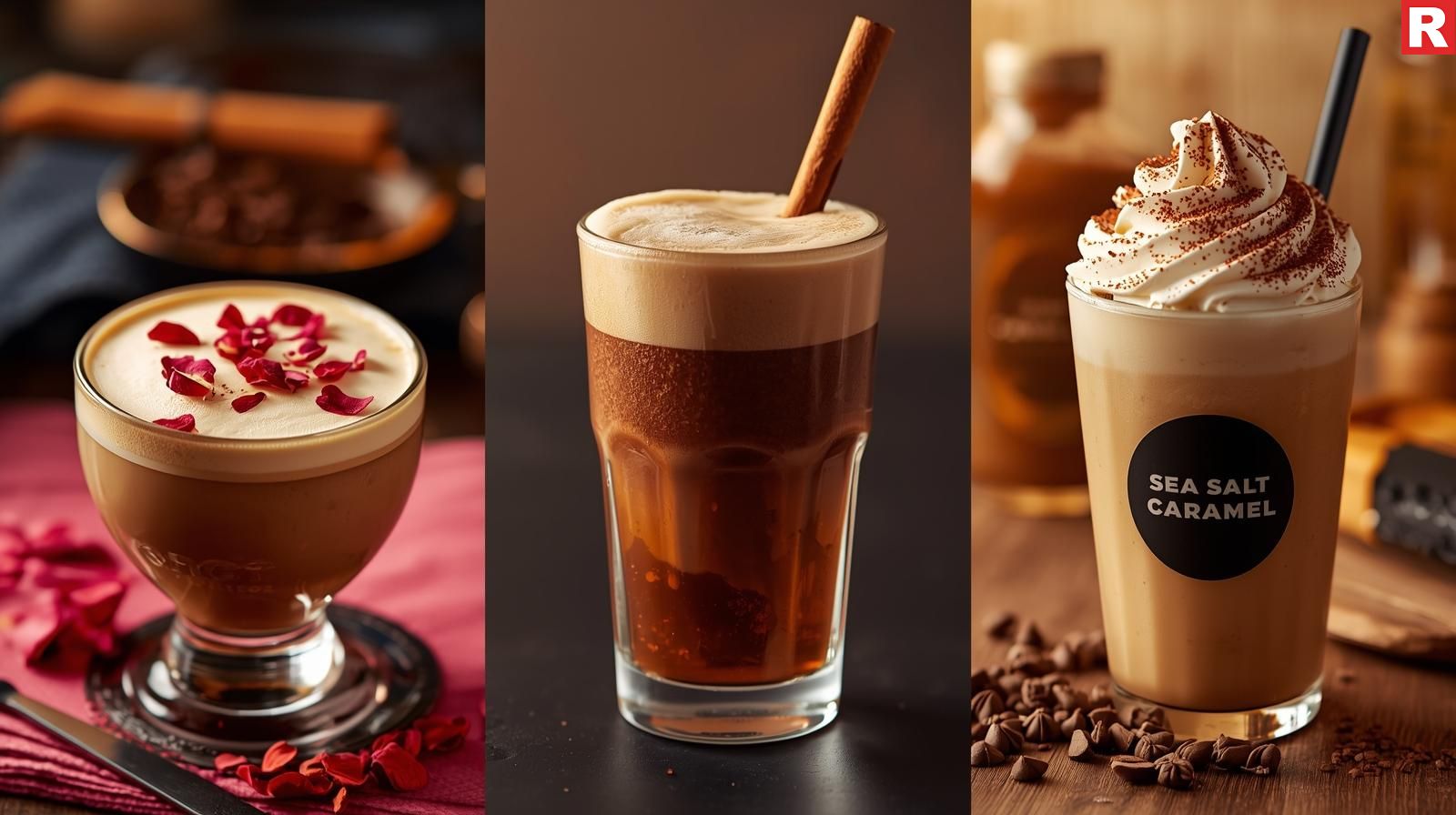
Provide a menu that offers more than the bare minimum to appeal to the expanding market of coffee lovers. Consider cold brew varieties, handcrafted brews, and specialty lattes.
Key Selling Point: Capitalizes on the enormous popularity of specialty coffee culture.
Examples:
- Rose & Cardamom Latte: A sophisticated palate will enjoy this exquisite and aromatic latte made with rose water and a touch of cardamom.
- Nitro Cold Brew with Cinnamon Stick: A cinnamon stick is served alongside a rich, velvety cold brew coffee that has been injected with nitrogen for a creamy head.
- Sea Salt Caramel Frappe: A rich and decadent iced coffee concocted with salted caramel and garnished with whipped cream is called a sea salt caramel frappe.
What's new: Best Whole Wheat Pasta Brands in India
5. House-made Infused Sodas (Shrubs)

Fruit, sugar, and vinegar are combined to make shrubs, often known as drinking vinegars. They have a distinct tangy-sweet flavor and are frequently combined with sparkling water to make cool beverages.
Key Selling Point: A really unique, adult-flavored craft beverage that differentiates your menu.
Examples:
- Mango and Turmeric Shrub: This shrub combines the earthy warmth of turmeric with a tangy-sweet taste.
- Raspberry & Apple Cider Vinegar Soda: A vibrant, delicious shrub with a strong vinegar tang is raspberry and apple cider vinegar soda.
- Pineapple & Chilli Shrub: The ideal ratio of spicy zing to tropical sweetness.
6. Sophisticated Kombuchas

A popular beverage among health-conscious people is kombucha, a fermented tea. Providing a range of high-quality, house-made, or partnered kombuchas can be very appealing.
Key Selling Point: Its distinct flavor and probiotic benefits capitalize on the wellness trend.
Examples:
- Ginger & Lemongrass Kombucha: This energizing and delightful kombucha is spicy and zesty.
- Berry and Mint Kombucha: This kombucha has a mild, herbal finish and is delicious and refreshing.
- Apple & Cinnamon Kombucha: This kombucha has hints of spiced apple and is warm and soothing.
7. Smoothies and Lassi
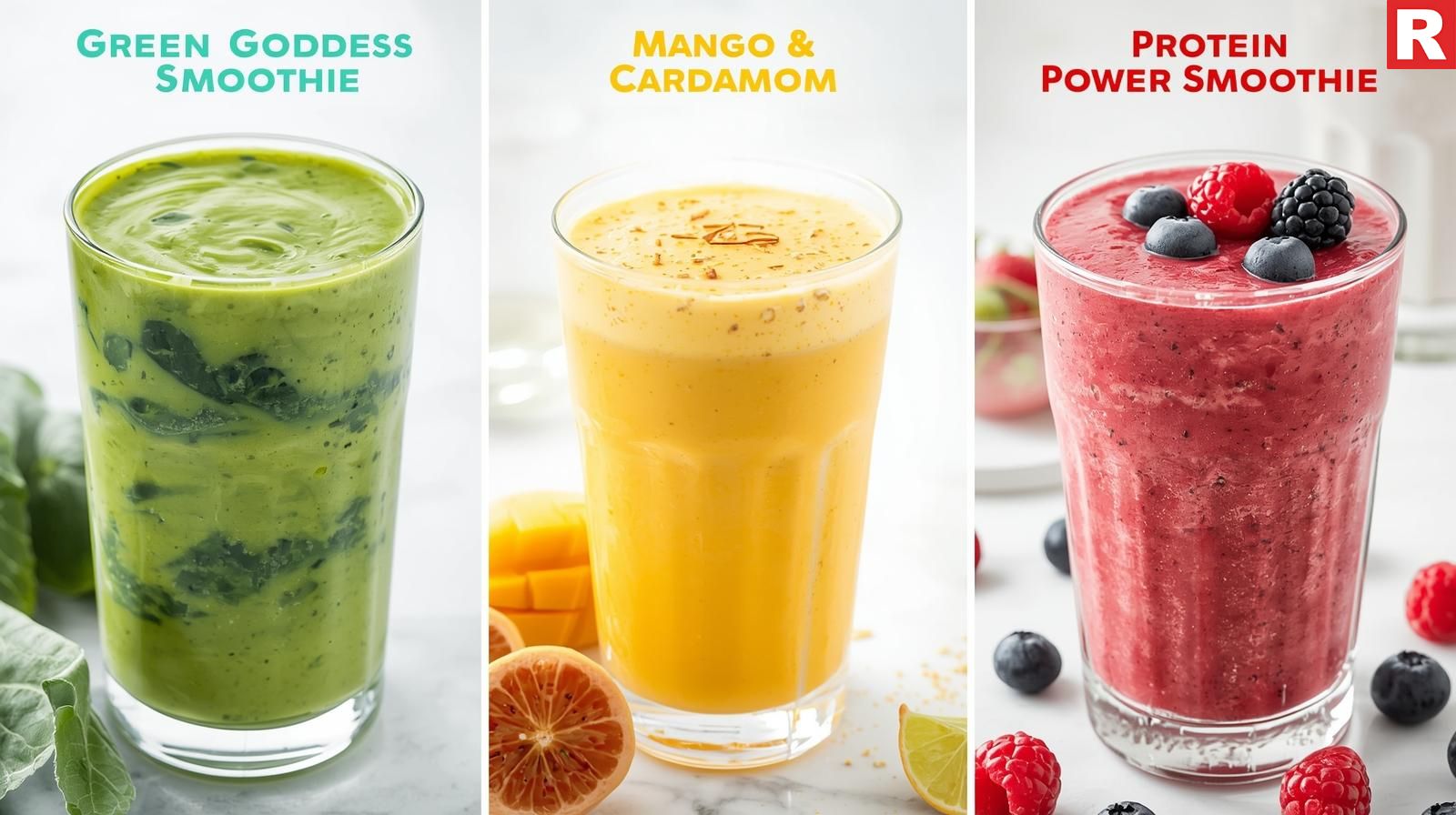
Enhance these traditional drinks with premium ingredients and a gourmet touch. In India, lassi is a common beverage, and a high-end version can serve as its focal point.
Key Selling Point: A satisfying and wholesome choice that may be used as a healthy treat or as a meal substitute.
Examples:
- Green Goddess Smoothie: The Green Goddess Smoothie is a nutrient-dense, creamy drink made with spinach, avocado, banana, and plant-based milk.
- Mango and Cardamom Lassi: This traditional sweet mango lassi is enhanced with a dash of cardamom for a fragrant treat.
- Protein Power Smoothie: A combination of Greek yogurt, protein powder, and berries for a healthy or post-workout meal.
Check out: 10 Best Indian Quinoa Recipes for Weight Loss
Best brown bread brands in India
8. Fresh Juices and Juice Blends

Offer freshly pressed or blended juices instead of prepackaged ones. Fresh juices are always tempting because of their vivid colors and simple, undiluted flavors.
Key Selling Point: A colorful, healthy, and pure option that demonstrates your dedication to using only the freshest ingredients.
Examples:
- Beet, Carrot, Apple & Ginger Juice: A strong, earthy, and spicy juice blend with health benefits is beet, carrot, apple, and ginger juice.
- Watermelon & Mint Juice: Simple, sweet, and refreshing, watermelon and mint juice is ideal for hot weather.
- Spinach, Pineapple, and Cucumber Detox: A crisp and energizing green juice mixture.
9. Non-alcoholic Cocktail Replicas

By carefully replicating the flavor profile and sensation of a particular, well-known alcoholic cocktail, this beverage type goes above and beyond the generic mocktail. Restaurants can serve zero-proof versions of traditional drinks like a Mojito, Margarita, or Old Fashioned by using a range of creative non-alcoholic "spirits," bitters, and syrups. In order to give designated drivers and non-drinkers a genuinely authentic-tasting substitute, the objective is not just to substitute the alcohol but also to replicate the original drink's complexity, texture, and aroma.
Key Selling Point: Enables customers to enjoy their favorite beverages without the alcohol content while still providing the full flavor experience and social ritual of a classic cocktail.
Examples:
- NA Spiced Rum & Cola: A perfect imitation of a traditional rum and cola made with a premium non-alcoholic rum substitute that has a hint of spice and molasses.
- Zero-Proof Margarita: This drink is a zesty and revitalizing mixture of fresh lime juice, agave nectar, and a non-alcoholic tequila alternative that is served in a glass with a salt rim.
- Herbal Gin & Tonic: An elegant blend of a botanical non-alcoholic "gin" with fresh botanicals such as juniper berries or rosemary and a high-end tonic water.
10. Flavored Hot Chocolates and Spiced Milks
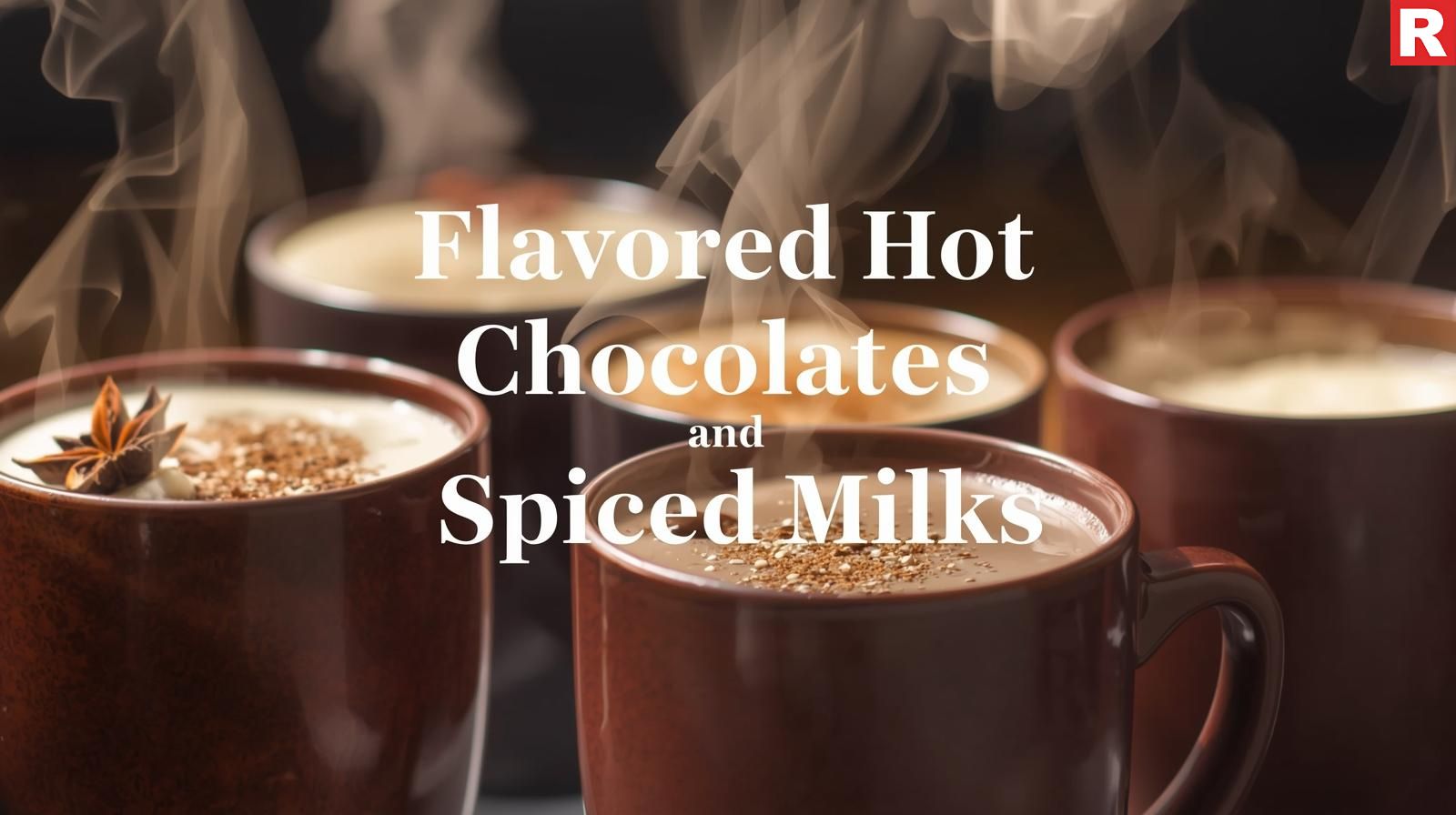
An excellent choice for dessert or as a cozy drink, particularly at restaurants that welcome families. These can be very well-liked in the winter.
Key Selling Point: A rich, cozy, and kid-friendly substitute for tea or coffee.
Examples:
- Chilli & Cinnamon Hot Chocolate: Rich, black hot chocolate with a subtle spicy sting and a comforting cinnamon undertone is known as "chilli and cinnamon hot chocolate."
- Saffron & Pistachio Badam Milk: This traditional Indian beverage is made with almond milk and enhanced with crushed pistachios and the luxurious taste of saffron.
- Salted Caramel Hot Chocolate: A delightful and comforting blend of sweetness and salt.
Read this: 7 Reasons to Add Macadamia Nuts to Your Daily Diet
Conclusion
A modern restaurant can no longer afford to overlook a unique and dynamic non-alcoholic beverage menu, as it is now a strategic advantage. Restaurants can boost revenue, satisfy evolving customer preferences, and establish themselves as progressive, diverse dining places by adopting these top ten non-alcoholic drink concepts. In today's time, providing a genuinely appealing zero-proof menu is a potent method to improve the visitor experience and guarantee that your business stays at the forefront of the hospitality sector in the cutthroat culinary industry.

Pasta has evolved from its beginnings as an Italian staple to become a popular comfort food in both homes and restaurants in India's changing food sector. But as health consciousness rises across the country, especially in major urban cities, mindful customers are turning their attention away from typical refined wheat pasta. Alternatives that combine the beloved texture and versatility of pasta with the substantial nutritional advantages of whole grains are becoming more and more popular. The main focus of this story is whole wheat pasta, which offers a nutrient-dense, fiber-rich alternative that promotes a healthier way of living without compromising the enjoyment of a delicious pasta dish.
This in-depth article explores the growing appeal of whole wheat pasta in India. We will discuss its nutritional advantages, important considerations for buyers, and the top brands of whole wheat pasta in India, looking at their components, texture, accessibility, and appeal for families and health-conscious individuals nationwide.
Read this: Frankenstein-Inspired Foods and Drinks for Your Spooky Celebrations
The Advantages of Whole Wheat Pasta
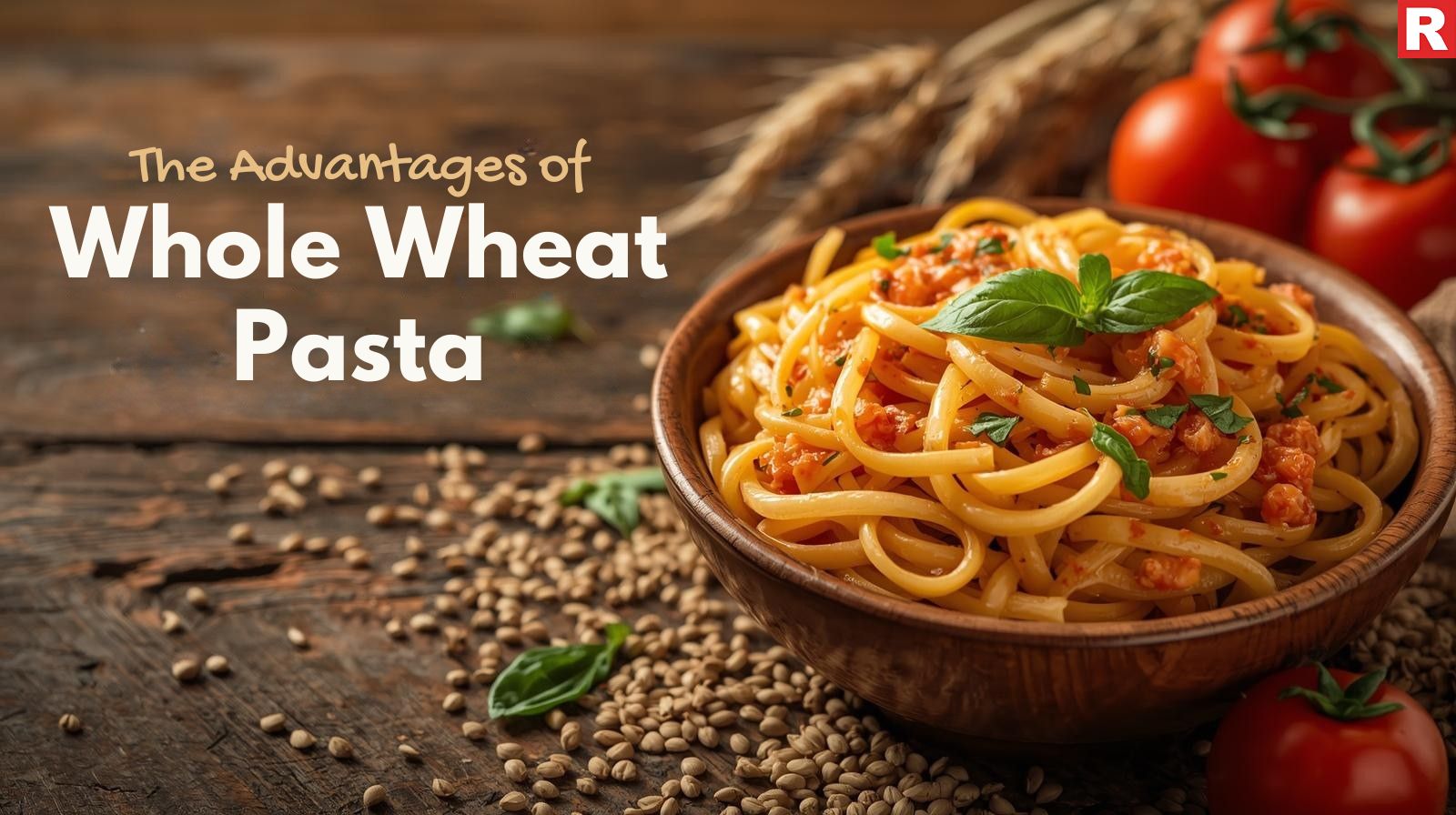
Growing knowledge of health and a desire for less processed foods are the main causes of the trend toward whole wheat pasta:
- Higher in Dietary Fiber: Whole wheat pasta keeps the bran, which is high in dietary fiber, unlike processed pasta. Fiber helps control blood sugar levels, improves gut and heart health, facilitates digestion, and improves hunger, which keeps you fuller for longer.
- Additional Nutrients: Whole wheat flour contains the germ and endosperm, which are vital sources of iron, magnesium, zinc, selenium, and the B vitamins (B1, B3, and B5). When wheat is refined to become maida, the nutrients are mostly lost.
- Reduced Glycemic Index (GI): Whole wheat pasta often has a lower GI than white pasta because of its higher fiber content. Because of this, it raises blood sugar more gradually, which makes it a better option for people with diabetes or those looking for long-lasting energy without a sudden increase in blood sugar.
- Weight management: Whole wheat pasta's higher fiber and protein content make you feel fuller for longer, which may help you cut back on calories and manage your weight.
- Promotes Gut Health: The fiber serves as a prebiotic, feeding good bacteria in the gut and promoting a healthy digestive tract.
Know more: 7 Reasons to Add Macadamia Nuts to Your Daily Diet
What to Look For While Buying "Whole Wheat Pasta"?
To ensure that you are certainly buying pasta from a brand that is genuinely made from wheat flour, you need to keep these indicators in mind:
- The First Ingredient: The most important indicator is "Whole Wheat Semolina" or "Whole Durum Wheat Semolina" as the first ingredient. A product is not truly whole wheat if its first or only ingredient is "refined wheat flour" (maida) or "durum wheat semolina" (without the word "whole"). Look for "whole wheat" at the top of the list because some brands may use a combination.
- Fiber Content: Examine the nutritional information panel to determine the fiber content. Each serving of a high-quality whole wheat pasta (usually 50–80 grams of dry pasta) should include at least 4-6 grams of fiber.
- Ingredient List: Generally, a simpler and shorter list of ingredients is preferable. Be mindful of extra sodium, artificial coloring, and other additives.
- Texture: Compared to white pasta, expect a slightly firmer, chewier texture. Cooking till the pasta is done may take an additional minute or two.
- Color: Unlike pale yellow pasta, true whole wheat pasta will have a somewhat darker, brownish tint.
- "100% Whole Wheat" Label: The most obvious guarantee that no refined flour was used in its manufacture is seen on the label.
Top Whole Wheat Pasta Brands in India
As the demand for healthier whole-wheat pasta grew in India, several brands jumped into the market offering excellent wheat options. Here are some of the top brands providing whole wheat pasta in the country:
1. Barilla Whole Wheat Pasta
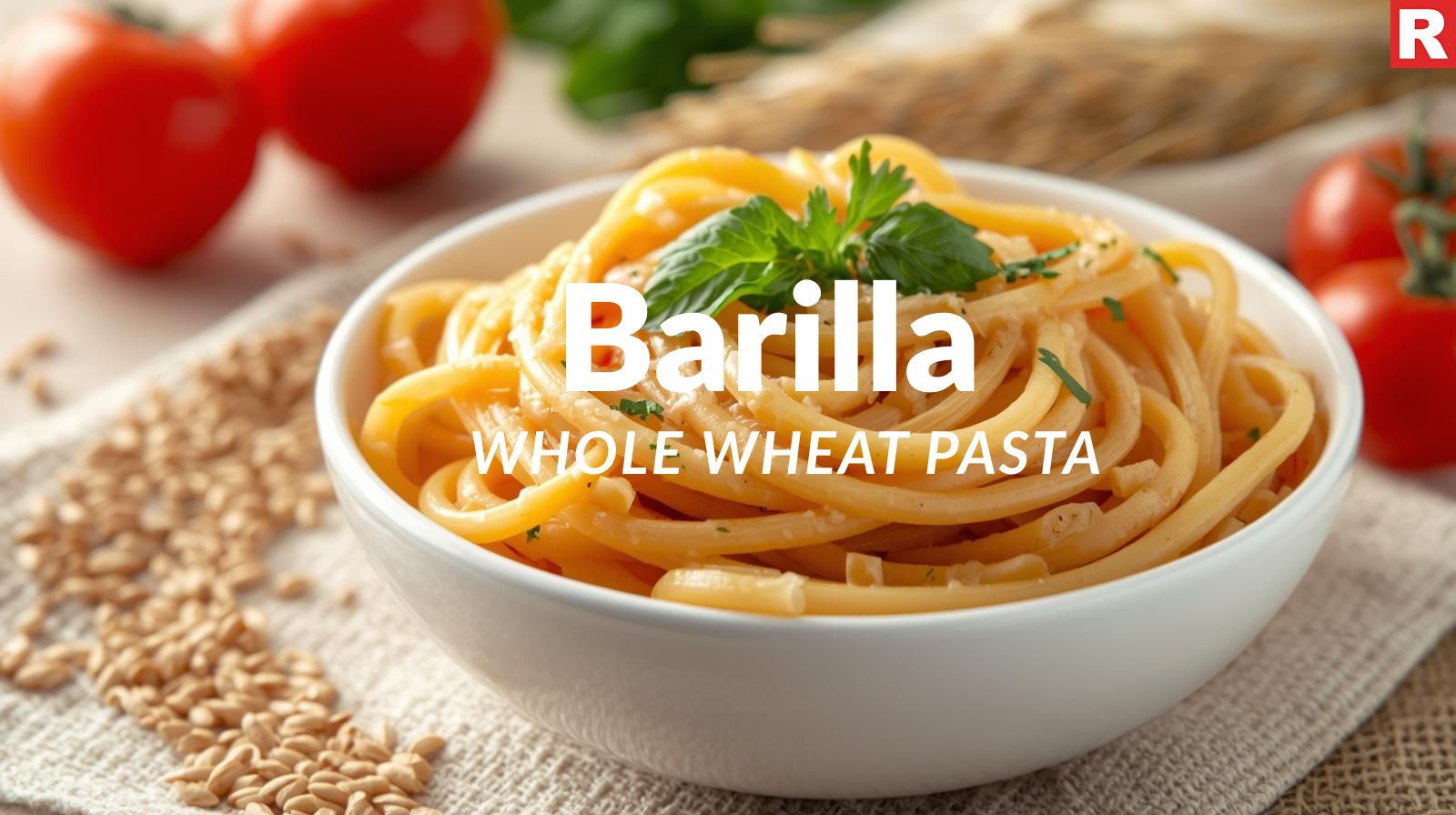
The Italian-based big company Barilla is well-known throughout the pasta industry, and its entire wheat line is well-liked in India. Because of its typical chewy texture, genuine Italian quality, and accessibility in all major Indian cities, Barilla Whole Wheat Pasta is popular with consumers. It has a hard bite and a rich flavor that complements a variety of sauces because it is made from 100% whole durum wheat semolina. Its high fiber content in the nutritional profile appeals directly to health-conscious consumers. Barilla is a solution for anyone looking for a high-quality, genuine whole wheat pasta experience because of its wide variety of shapes, which include penne, spaghetti, fusilli, and farfalle. It is easily accessible because it is available in practically all significant supermarkets and online shopping platforms.
2. Disano Whole Wheat Pasta
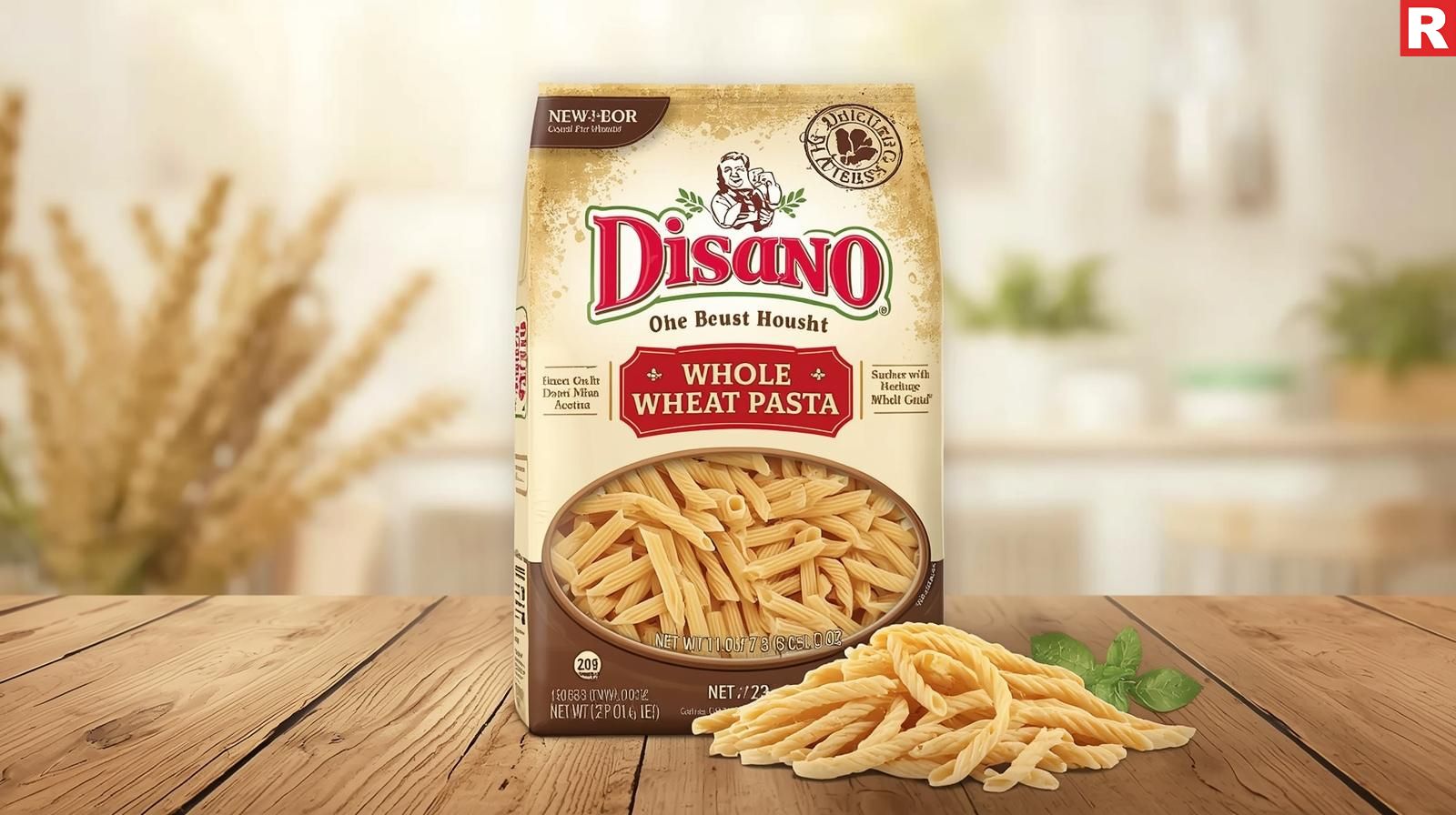
With its line of nutritious food items, such as pasta and olive oil, Disano has swiftly become a well-known brand in the Indian market. Disano Whole Wheat Pasta is well-known for being a reliable and reasonably priced whole wheat choice that offers a pleasing texture and flavor. The desired fiber and nutritional advantages are provided by the 100% whole wheat durum semolina used in its production. Customers in India value Disano's ability to provide a high-quality product that fills the gap between more affordable options and luxury international brands. Its steady quality and growing availability in supermarkets and online retailers make it a formidable competitor for regular, healthful pasta dishes that appeal to a wide range of families.
What's new: Best brown bread brands in India
3. Saffola Oodles Whole Wheat Pasta
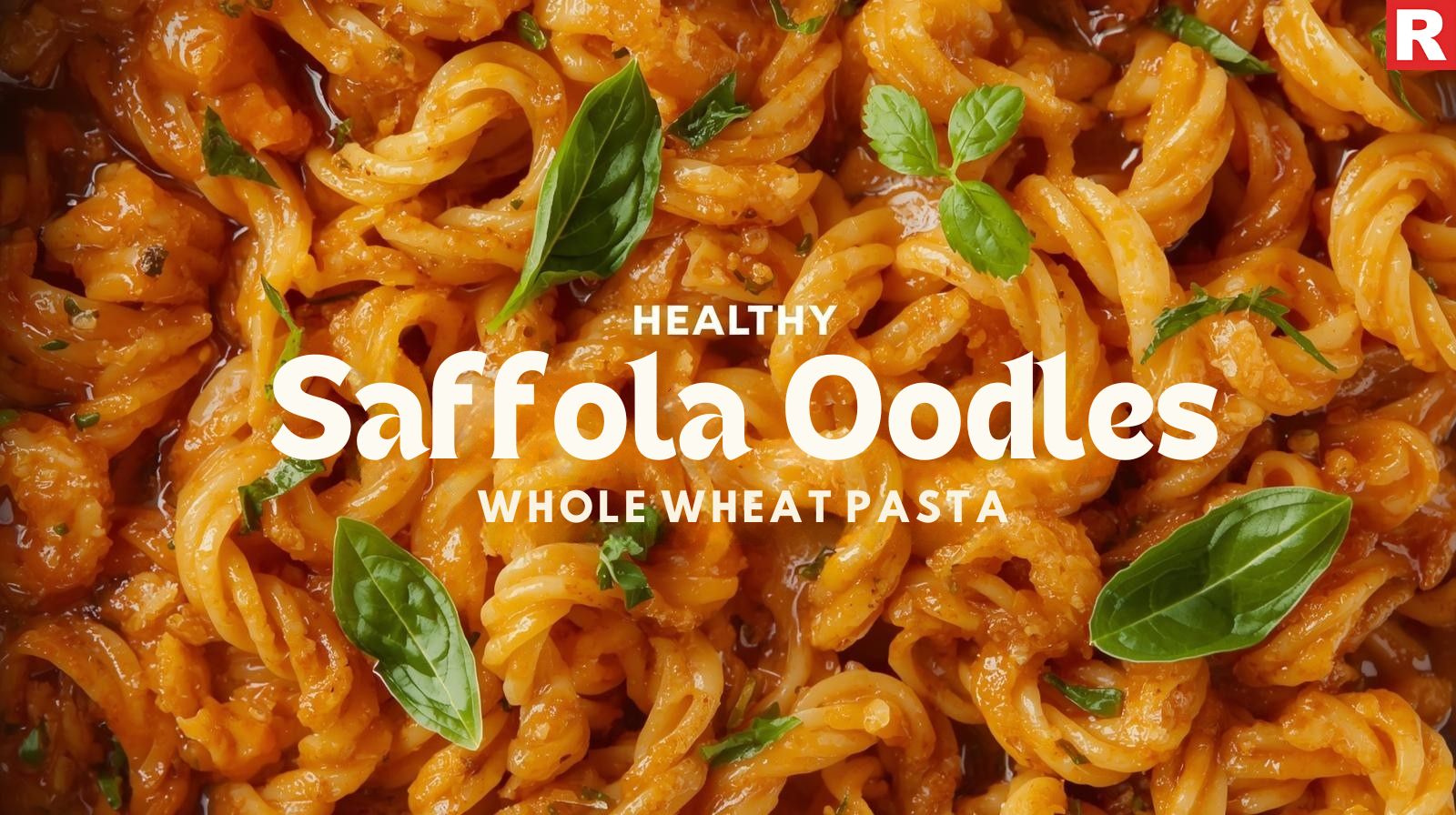
The well-known Indian brand Saffola, which is associated with wellness and health, expanded its product line to include whole wheat pasta. Saffola Oodles Whole Wheat Pasta is well-known for combining the ease of a quick-cooking pasta with the reliability of the Saffola brand. It is frequently promoted as a healthy option for meals or snacks. Although it contains "whole wheat flour," customers should verify the ingredient list for the particular "Oodles" product because certain variations may contain additional ingredients. It seeks to offer a delicious, quick, and comparatively healthier substitute for conventional instant noodles, appealing to a younger customer base and busy people who value convenience and healthier ingredients in their prepared foods.
4. Nutriorg Whole Wheat Pasta
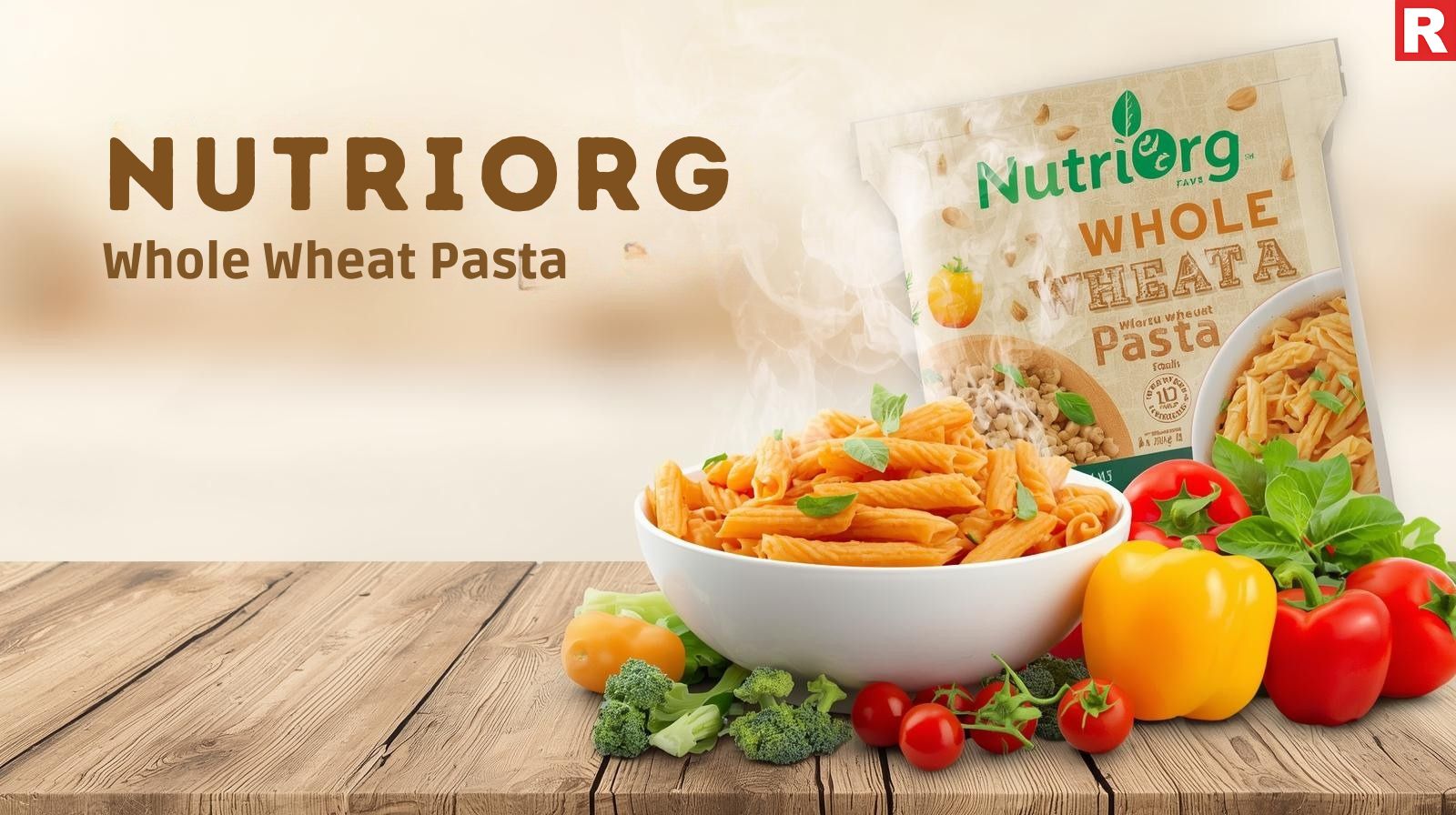
Whole wheat pasta from the Indian company Nutriorg reflects the company's strong commitment to natural and organic food items. Because of its organic certification and emphasis on the health of whole wheat without any additives, Nutriorg Whole Wheat Pasta is well-known. Constructed from 100% organic whole wheat, it targets customers who value organic ingredients and seek out clean-label products. Its dedication to sustainable agricultural methods and avoidance of artificial fertilizers and pesticides makes it appealing, even though its availability may be limited in organic stores and online platforms. For the increasing number of environmentally concerned and health-sensitive Indian consumers, these factors make it their first choice.
Check out: 7 Essentials to Keep Staff Trained in Your Restaurant
How Health & Wellness Trends Are Redefining Indian Dessert Menus
4. Borges Whole Wheat Pasta
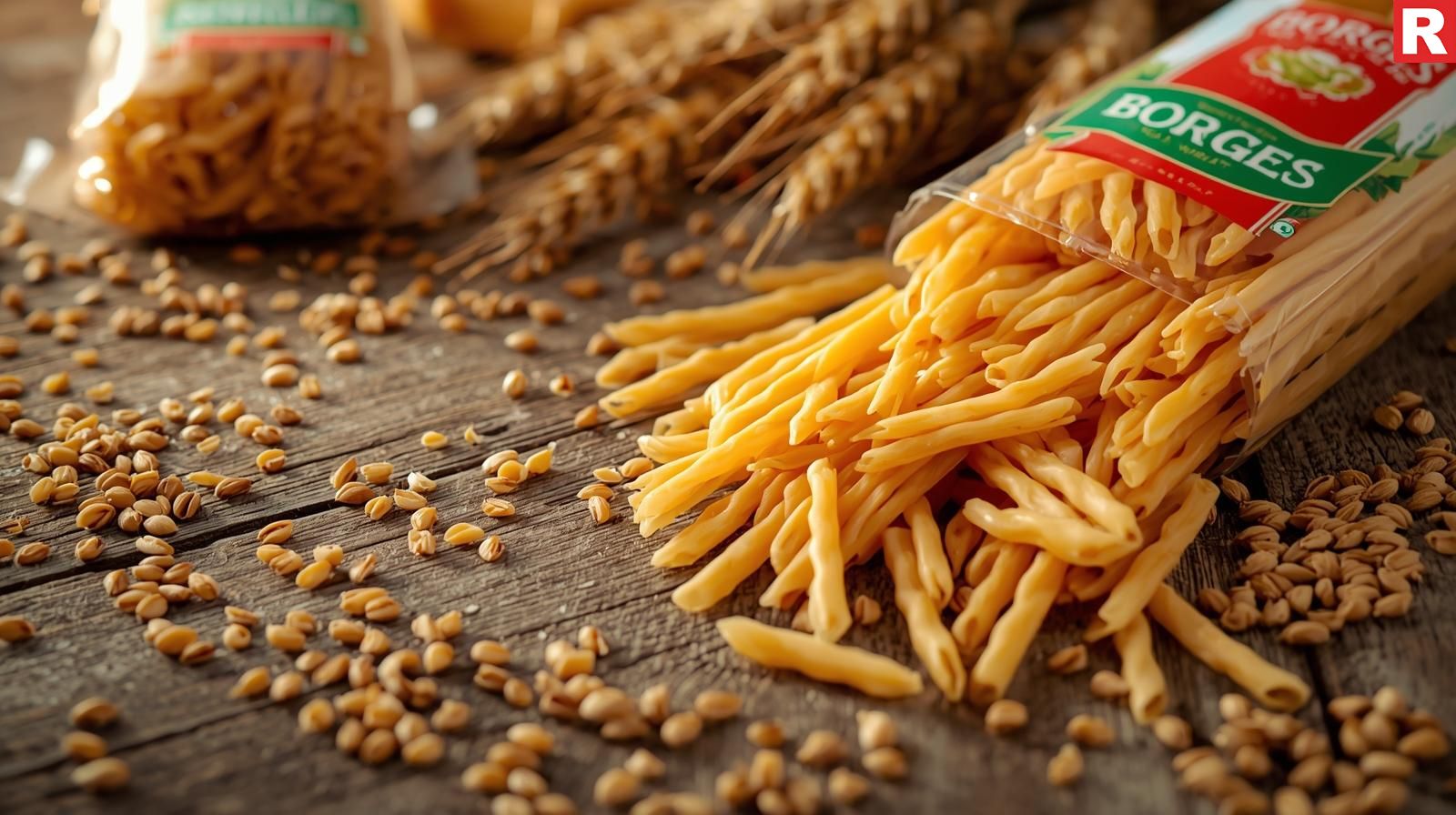
The popular Mediterranean food brand Borges is well-known in India, especially for its olive oils and, more recently, its pasta line. Borges Whole Wheat Pasta is well-known for its premium whole durum wheat semolina, which guarantees a superb texture and genuine flavor. It is distinguished by its firm bite and good sauce-holding capacity, which are traits of high-quality Italian pasta. It serves customers who value imported quality and a dependable whole wheat choice from a reputable foreign brand. It comes in a variety of forms and is available in luxurious supermarkets and online grocery stores throughout major Indian cities. It is a favorite among people looking for healthy gourmet options because of its dedication to using only the best ingredients.
5. Weikfield Whole Wheat Pasta
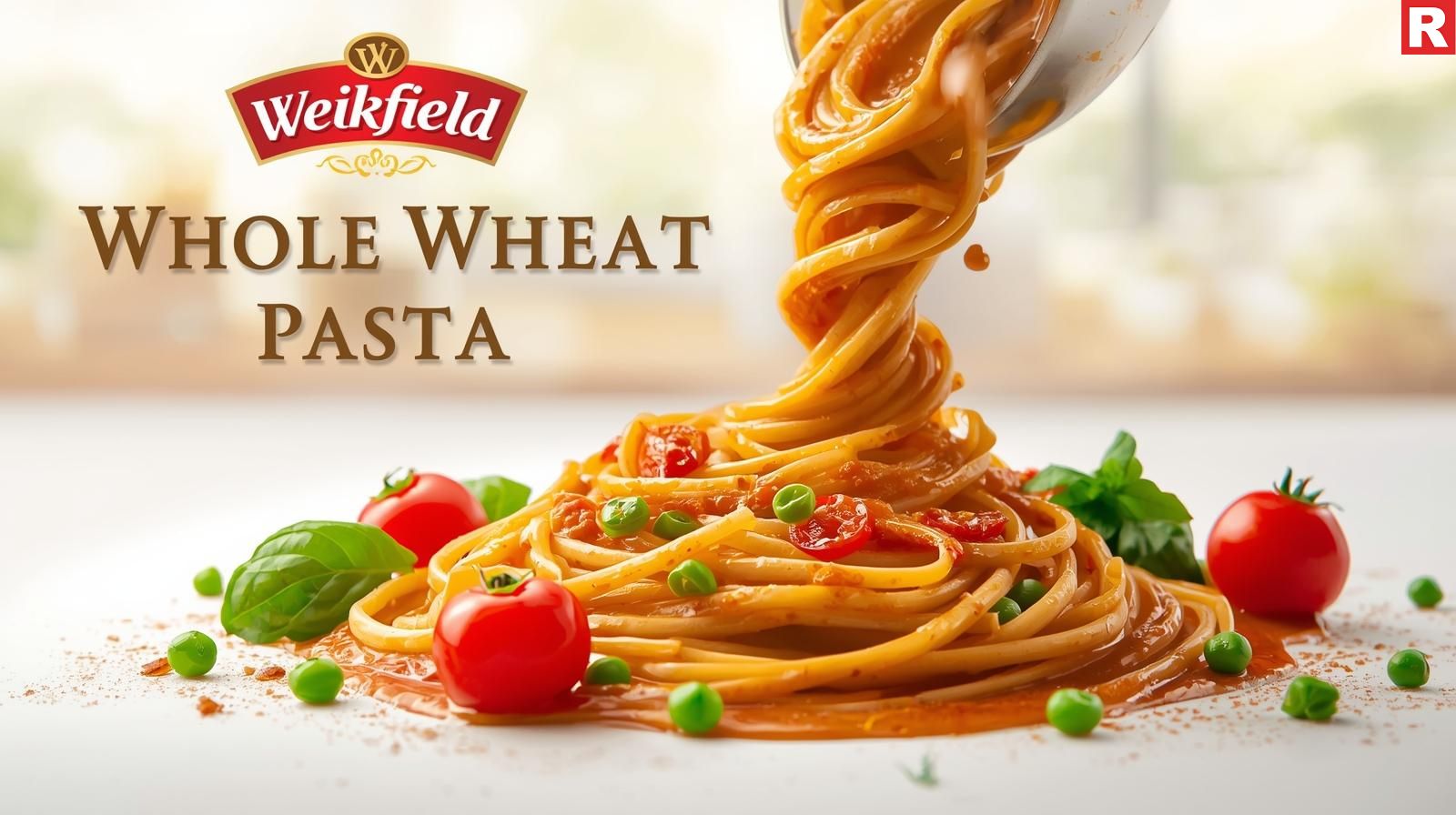
Weikfield, a well-known Indian food brand that specializes in baking supplies and cooking goods, has expanded into the whole wheat pasta industry. Weikfield Whole Wheat Pasta is well-known for being widely available, reasonably priced, and an affordable whole wheat choice for Indian homes. It offers a simple and dependable whole wheat product that guarantees the extra fiber and nutrients that consumers are looking for. Due to its wide distribution network, it is readily available in neighborhood supermarkets and grocery stores, making it a practical option for daily cooking for families of all income levels who are transitioning to healthier options.
Read this: Instagram-Worthy Interior & Food Styling Trends That Are Driving Footfalls in Metro Cities
Tips for Cooking and Enjoying Whole Wheat Pasta
- Remember the Cooking Time: In order to achieve an al dente (firm to the bite) texture, whole wheat pasta usually takes one to three minutes longer to cook than white pasta. Always follow the directions on the package and do a taste test.
- Lots of Water: To keep the pasta from sticking and to ensure that it cooks through, use a lot of boiling salted water.
- Pairing Sauces: The flavor of whole wheat pasta is a little more powerful and nuttier. It goes well with substantial sauces such as tomato-based gravies, pesto, mushroom sauces, or chunky vegetable sauces. Oil-based, lighter sauces are also effective.
- Accept Textures: Enjoy its distinct, pleasant chewiness rather than expecting the same texture as refined pasta.
Conclusion
Whole wheat pasta's rising appeal in India is clearly proof of a national movement in health and wellness. The need for nutritious, whole-grain substitutes is growing as people become pickier about what they eat. Today's market provides a wide variety of whole wheat pasta options to suit different tastes, ranging from kid-friendly blends to authentic textures. Customers can make smart choices by carefully reading labels like "whole wheat semolina" and taking into account variables like fiber content. Including whole wheat pasta in regular meals is an easy yet significant step toward eating in a healthier and more ethical manner.

Halloween is the perfect time to have fun with food. If you are planning a spooky party or just want to try something new, Frankenstein-inspired foods and drinks are a great choice. Frankenstein’s monster is a famous character from a horror story. His green skin, stitches, and bolts make him the perfect theme for spooky treats. You don’t need to be a master chef to create these dishes. With simple ingredients and some creativity, you can make your Halloween celebration extra special.
In this article, we will share easy and exciting ideas for Frankenstein-themed foods and drinks. These recipes are fun to make and will impress your guests. Whether you are cooking for kids or hosting an adult party, you will find recipes that suit everyone.
Read more: Best Food Festivals Every Foodie Must Attend
Delhi’s Love Affair with Chole Bhature – A Culinary Classic
Why Frankenstein Makes a Great Food Theme
Frankenstein is a character from the classic horror novel “Frankenstein” by Mary Shelley. His monster is misunderstood and strange, but also fun and creative. His appearance with stitches, bolts, and green skin inspires spooky decorations and foods. These foods are perfect for Halloween, costume parties, and movie nights. Frankenstein foods are not only creepy but also tasty and shareable. By using bright colors, unusual shapes, and textures, you can turn normal snacks into something exciting.
The best part is that you don’t need expensive or hard-to-find ingredients. You can use fruits, vegetables, gelatin, pasta, and everyday kitchen items to bring Frankenstein to life.
Top Frankenstein-Inspired Foods
1. Frankenstein Brain Jello

This brain-shaped dessert is a showstopper for any Frankenstein-themed party. It’s both spooky and fun to make, with its eerie green color and realistic texture. The strawberry or raspberry gelatin gives it a fruity and refreshing taste, while the green food coloring transforms it into a monster’s brain. Adding red licorice strings or icing creates vein-like details, making it look even creepier. Serve it on a dark plate or tray with dim lighting to highlight the gory effect. Kids and adults alike will love its look and flavor.
Ingredients:
- 2 cups of strawberry or raspberry gelatin
- A few drops of green food coloring
- Licorice strings or red icing for veins
How to Make It:
- Prepare the gelatin as instructed on the package.
- Add a few drops of green food coloring to give it a monster look.
- Pour the mixture into a brain-shaped mold.
- Let it chill in the fridge until set.
- Add red licorice or icing to mimic veins for an extra creepy look.
This dessert is simple to prepare and looks amazing when placed on a dark tray.
2. Monster Eyeball Pizza
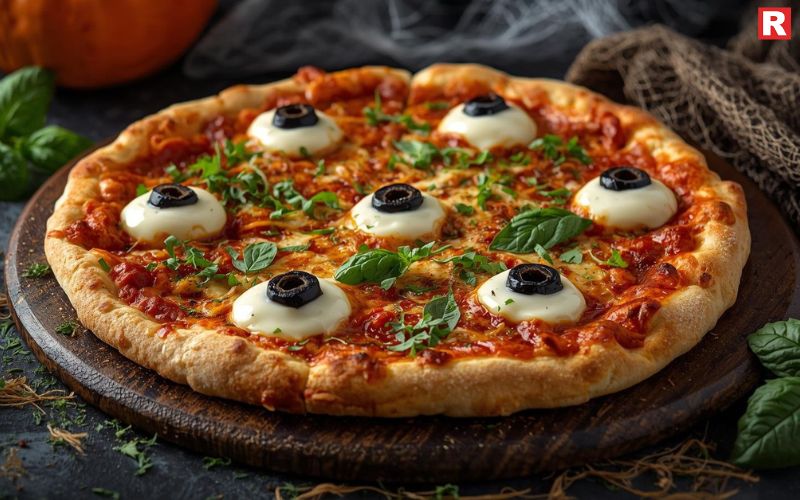
Monster Eyeball Pizza is a playful twist on a classic party favorite. Using pizza dough or ready-made bases, you can create creepy yet delicious eyeballs with mozzarella cheese and black olives. The mozzarella forms the white of the eye, while the olives serve as pupils, giving it a lifelike appearance. A sprinkle of herbs like basil or parsley adds texture and color, creating a mossy effect around the edges. Baked until crispy, this dish is perfect for Halloween gatherings, making every bite both eerie and tasty.
Ingredients:
- Pizza dough or ready-made bases
- Mozzarella cheese
- Black olives
- Green herbs like basil or parsley
How to Make It:
- Spread pizza sauce on the base.
- Add mozzarella in round shapes to look like eyeballs.
- Place slices of olives in the center to create the pupil.
- Sprinkle herbs around the edges to give a mossy, spooky feel.
Bake the pizzas as usual. Serve them warm for extra fun.
Know more: Best Ice Cream & Gelato Brands for Restaurants
3. Frankenstein’s Green Meatballs
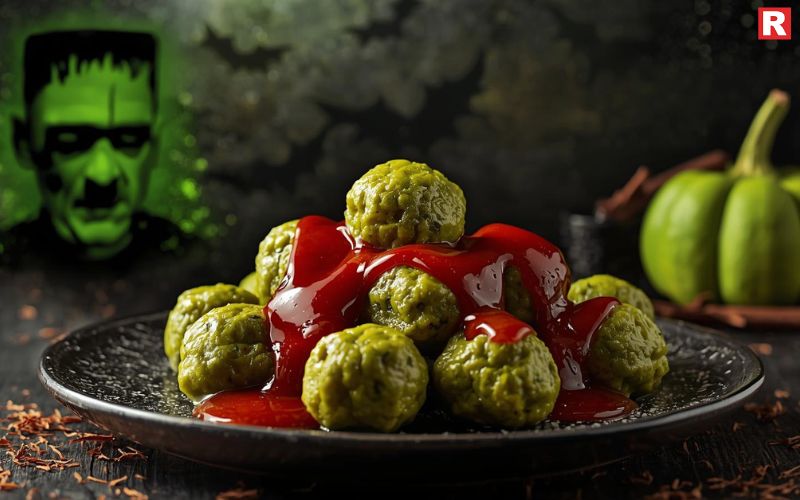
Frankenstein’s Green Meatballs are a savory treat that combines healthy ingredients with a spooky look. By mixing spinach puree or matcha powder into ground meat or plant-based alternatives, the meatballs turn a vibrant green that perfectly suits the monster theme. Garlic, salt, and pepper enhance the flavor, while baking or frying gives them a crispy exterior. Served with a rich tomato sauce, these meatballs look delightfully eerie with the dark red contrast. They’re not only fun for Halloween but also a nutritious option that doesn’t compromise on taste.
Ingredients:
- Ground meat or plant-based alternative
- Spinach or matcha powder
- Garlic, salt, and pepper
- Tomato sauce
How to Make It:
- Mix spinach puree or matcha powder with the meat mixture.
- Add garlic, salt, and pepper for flavor.
- Shape into balls and bake or fry them.
- Serve with dark tomato sauce for contrast.
These meatballs are healthy and look eerie on the plate.
4. Bolt Sandwiches

Bolt Sandwiches are a clever nod to Frankenstein’s iconic neck bolts, making them a fun and creative snack for spooky parties. Using crunchy breadsticks as the base, you can wrap them in slices of deli meat, cheese, or even roasted vegetables for a vegetarian option. They’re bite-sized, easy to prepare, and versatile enough to suit different tastes. To make them visually striking, secure with toothpicks and serve on a dark platter. Kids enjoy the playful design, while adults appreciate the quick and flavorful preparation. Perfect for themed gatherings.
Ingredients:
- Breadsticks
- Sliced deli meat or cheese
How to Make It:
- Wrap breadsticks with slices of meat or cheese.
- Secure them with toothpicks.
- Arrange them like Frankenstein’s bolts.
These are easy to prepare and great for kids.
Also check: Why Fish Kobiraji Is a Must-Try for Every Food Lover in Kolkata
Top Frankenstein-Inspired Drinks
1. The Monster Mash Smoothie
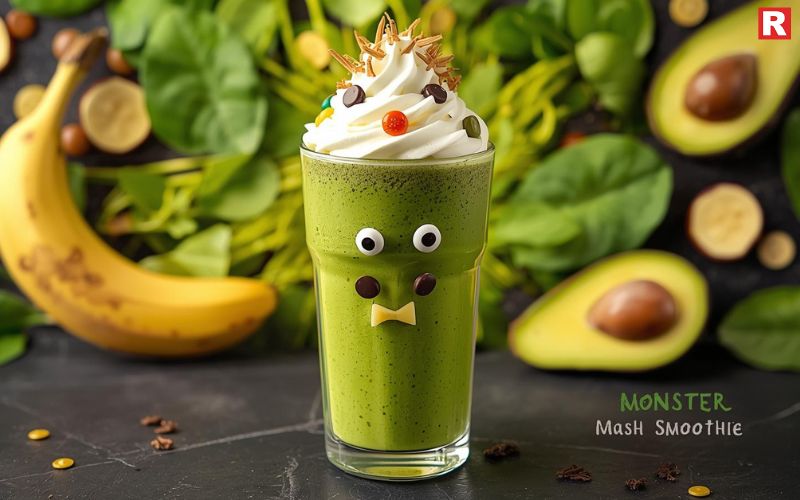
The Monster Mash Smoothie is a healthy and playful drink that fits perfectly into any spooky-themed celebration. The combination of spinach, banana, and avocado creates a creamy texture and vibrant green color, while spirulina adds extra nutrients and an eerie look. Topped with whipped cream styled as wild “monster hair” and candy eyes or chocolate chips, this smoothie becomes a fun and tasty treat. It’s not only visually impressive but also packed with vitamins, making it a guilt-free indulgence for kids and adults alike.
Ingredients:
- Spinach
- Banana
- Avocado
- Spirulina powder
- Whipped cream
- Candy eyes or chocolate chips
How to Make It:
- Blend spinach, banana, avocado, and spirulina until smooth.
- Pour into glasses.
- Top with whipped cream “hair.”
- Add candy eyes for a playful monster look.
This drink is tasty, healthy, and visually fun.
2. Frankenstein’s Elixir (Green Punch)

Frankenstein’s Elixir is a refreshing and eye-catching green punch that’s ideal for Halloween parties or spooky gatherings. Made with lime soda or sparkling water and blended kiwi puree, this drink offers a light and fruity flavor with a hint of tartness. Fresh mint leaves add aroma and a burst of herbal freshness, while dry ice creates an eerie bubbling effect that transforms the punch into a bubbling potion. Serve it in glass containers with gothic-themed decorations for a spooky and festive experience.
Ingredients:
- Lime soda or sparkling water
- Kiwi puree
- Mint leaves
- Dry ice (optional, for smoky effects)
How to Make It:
- Mix lime soda with kiwi puree.
- Add mint leaves for flavor and decoration.
- Place dry ice just before serving to create bubbling smoke.
This drink is perfect for a Halloween atmosphere.
3. Electric Shock Cocktail (For Adults)

The Electric Shock Cocktail is a sophisticated and striking drink that adds flair to any adult Halloween party. Combining gin or vodka with green chartreuse and a splash of lemon juice, it offers a balanced and slightly herbal flavor. Edible glitter gives the drink a sparkling, otherworldly appearance, while a rosemary sprig mimics Frankenstein’s bolts for added effect. Served in chilled glasses under dim, spooky lighting, this cocktail delivers both flavor and theatrical presentation, making it the perfect signature drink for a haunted celebration.
Ingredients:
- Gin or vodka
- Green chartreuse
- Lemon juice
- Edible glitter
- Rosemary sprig
How to Make It:
- Shake gin or vodka with chartreuse and lemon juice.
- Pour into glasses.
- Sprinkle edible glitter for sparkle.
- Garnish with rosemary to look like Frankenstein’s bolt.
Serve chilled with spooky lighting for extra drama.
Check more: Pani Puri Has Different Names in Different Indian States—Know Them All
10 Fastest-Growing Alcohol Brands in India’s HoReCa Sector
7 Types of Whiskies Everyone Should Try Once
Presentation Tips for Frankenstein-Themed Foods
Presentation plays a big role in making these recipes stand out. Here are some tips:
- Use glass jars, test tubes, or mason jars to serve drinks.
- Place food on black or dark-colored plates for a dramatic look.
- Add edible flowers or herbs to mimic moss or decay.
- Use fake cobwebs, skulls, or dry ice effects to enhance the spooky atmosphere.
Small touches make a big difference when it comes to Halloween themes.
Authenticity Tips
If you want to make your Frankenstein foods look real and taste great, keep these points in mind:
- Use natural ingredients like fruits, vegetables, and herbs whenever possible.
- Experiment with textures. Add gooey sauces or crunchy toppings.
- Don’t overdo the theme. Balance spooky decorations with flavors that are actually good.
Authenticity makes the food more appealing and enjoyable.
Final Thoughts
Frankenstein-inspired foods and drinks are an exciting way to celebrate Halloween or any spooky event. They are easy to prepare, look amazing, and taste delicious. You can make them with simple ingredients found in your kitchen. With a little creativity, you can turn ordinary snacks into a monster-themed feast that your guests will love.
So, gather your friends and family, and bring Frankenstein’s monster to life on your table. These recipes will not only make your celebration spooky but also fun, memorable, and full of flavor. Happy Halloween, and let the monster feast begin!

The Indian diet has changed significantly in recent years, including the simple loaf of bread. Customers are increasingly choosing healthier options over refined flours as a result of the growing health and wellness trend that is spreading through major cities in the country. Once considered an uncommon product, brown bread has gained popularity in many health-conscious households due to its lower glycemic index, increased fiber content, and whole-grain advantages. Its adaptability and health benefits have made it a popular option for people trying to make better food choices, whether they are eating sandwiches or toast each day.
This in-depth article explores the rising demand for brown bread in India. The nutritional benefits of brown bread will be discussed, along with what to look for when selecting a genuinely healthy brand. Additionally, the Best Brown Bread Brands in India will be highlighted, with an emphasis on their ingredients, texture, availability, and suitability for the educated consumer, particularly in metropolitan areas.
Read more: 7 Reasons to Add Macadamia Nuts to Your Daily Diet
The Advantage of Brown Bread: Why the Switch?

A better understanding of nutrition and the long-term health advantages of whole grains is the main factor behind the switch from white to brown bread:
- Increased Fiber Content: Dietary fiber is abundant in brown bread, particularly when it is produced from whole wheat. Fiber supports the health of the heart, helps control blood sugar levels, improves appetite (keeping you fuller for longer), and facilitates digestion.
- Benefits of Whole Grain: Whole wheat flour (atta), which contains the bran, germ, and endosperm of the wheat kernel, is used to make authentic brown bread. These ingredients are rich in vital minerals that are frequently lost in processed white flour, such as iron, magnesium, zinc, B vitamins, and antioxidants.
- Reduced Glycemic Index (GI): Brown bread often has a lower GI than white bread because of its higher fiber content. This makes it a better option for people with diabetes or looking for long-lasting energy because it raises blood sugar levels more gradually.
- Weight management: Brown bread's fiber helps people feel full, which may lower their daily calorie consumption overall and help them control their weight.
- Gut Health: The fiber supports a healthy digestive tract and feeds beneficial gut bacteria by acting as a prebiotic.
- Lower Risk of Chronic Illnesses: Eating whole grains on a regular basis has been associated with a lower risk of heart disease, type 2 diabetes, and several types of cancer.
A quick and easy way to adopt a healthy lifestyle for health-conscious families and individuals is to include brown bread in their daily diet.
What to Look For When Buying "Brown Bread"
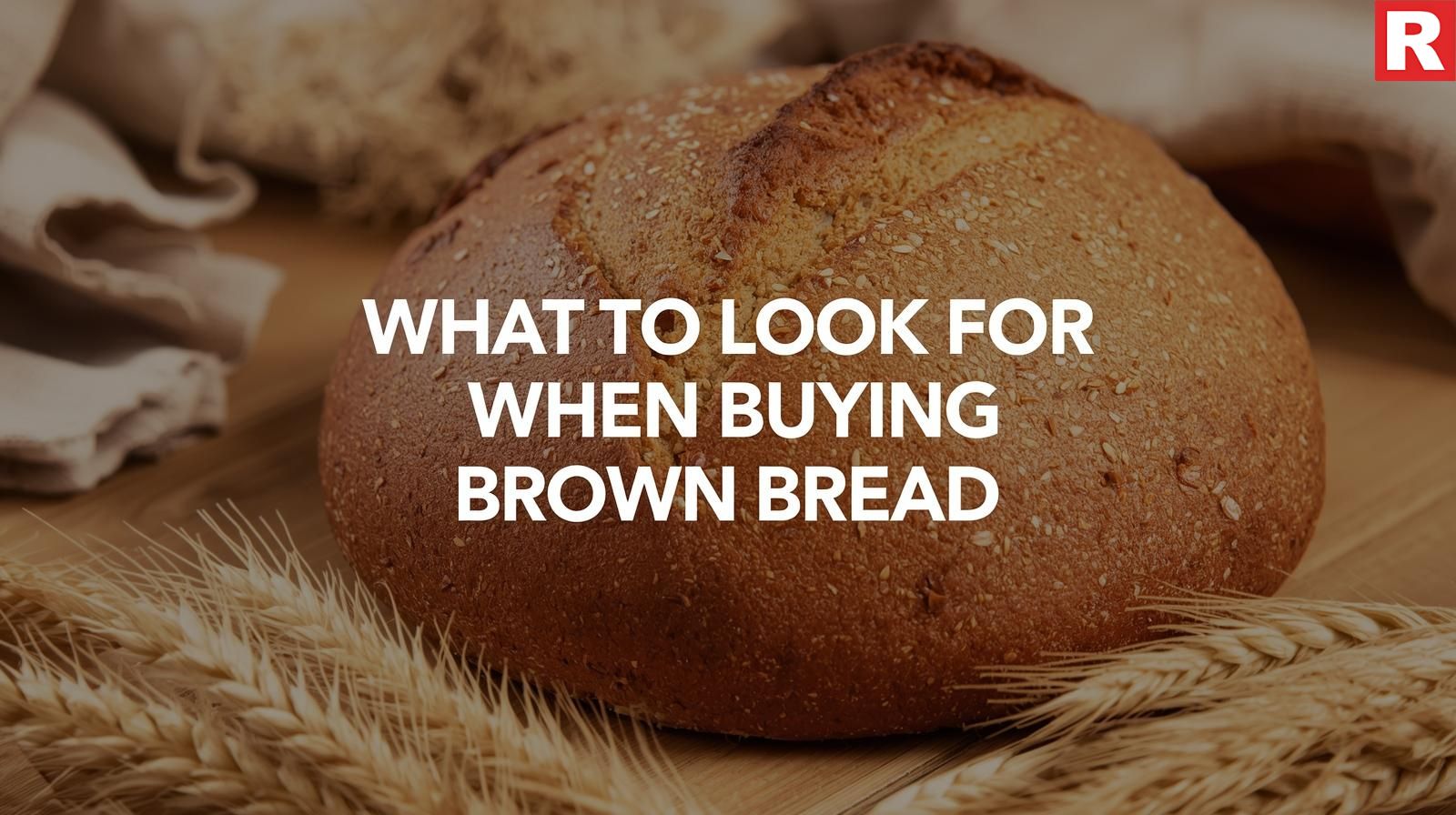
Sometimes the word "brown bread" is deceiving. Without really using whole grains, some manufacturers give white bread a brown tint by coloring it with molasses or caramel. Keep an eye out for these warning signs to make sure you're getting real, healthful brown bread:
- The first ingredient is "whole wheat flour" or "wholemeal flour": The most important indicator is this one. It's basically white bread with coloring if "refined wheat flour" (maida) is the first or only flour mentioned.
- Fiber Content: Verify the nutritional data for the fiber content. Each slice of high-quality brown bread should include at least two to three grams of fiber.
- Sugar Level: Pay attention to additional sugars. A certain amount of natural sweetness is fine, but too much sugar can counteract the health advantages.
- Ingredient List: In general, shorter, more identifiable ingredient lists are preferable. Steer clear of breads that include excessive amounts of high-fructose corn syrup, emulsifiers, or chemical preservatives.
- Texture & Density: Compared to soft white bread, real whole wheat bread frequently has a denser, rougher texture.
- "100% Whole Wheat" Label: This indicates that no refined flour was used, making it the gold standard for brown bread.
Know more: Top Eco-friendly Cleaning Product Brands in India for Restaurants
Top Brown Bread Brands in India
There is an increasing number of brown bread brands available in the Indian market, each with specific characteristics. Here is a thorough analysis of the top brands available:
Britannia
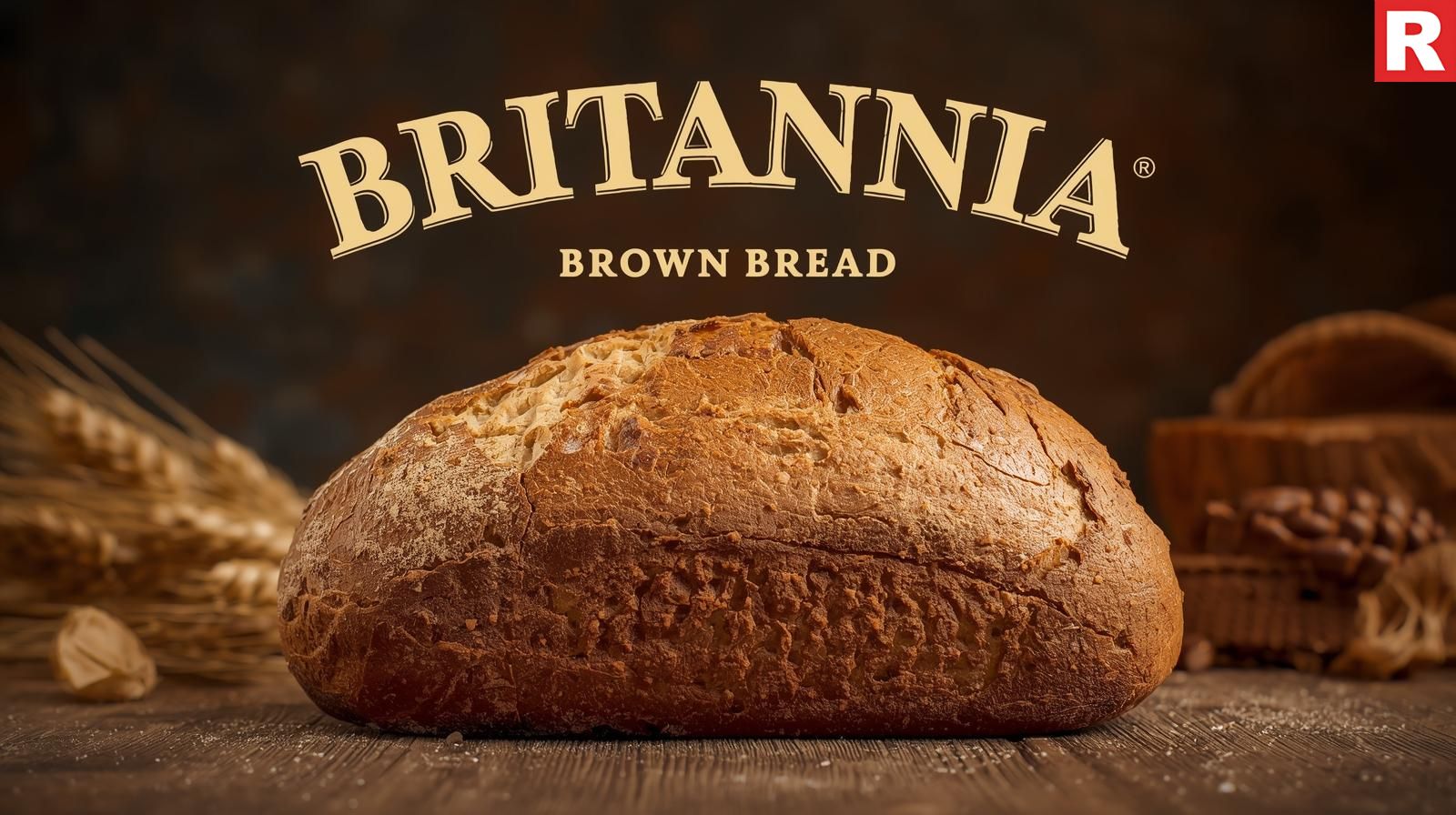
Britannia, a well-known brand in India for many years, has successfully adjusted to health trends and commands a sizeable portion of the bread industry. Britannia's brown bread is well-known for being widely accessible, consistently high-quality, and having a comparatively soft texture that appeals to a wide range of Indian consumers. It constantly mentions "Whole Wheat Flour" (Atta) as the main ingredient, guaranteeing a healthy supply of fiber and vital elements found in whole wheat. Families all throughout the country find it to be an accessible and practical option for everyday use due to its widespread availability in practically every supermarket, grocery store, and neighborhood kirana shop, as well as its reasonable pricing.
Harvest Gold
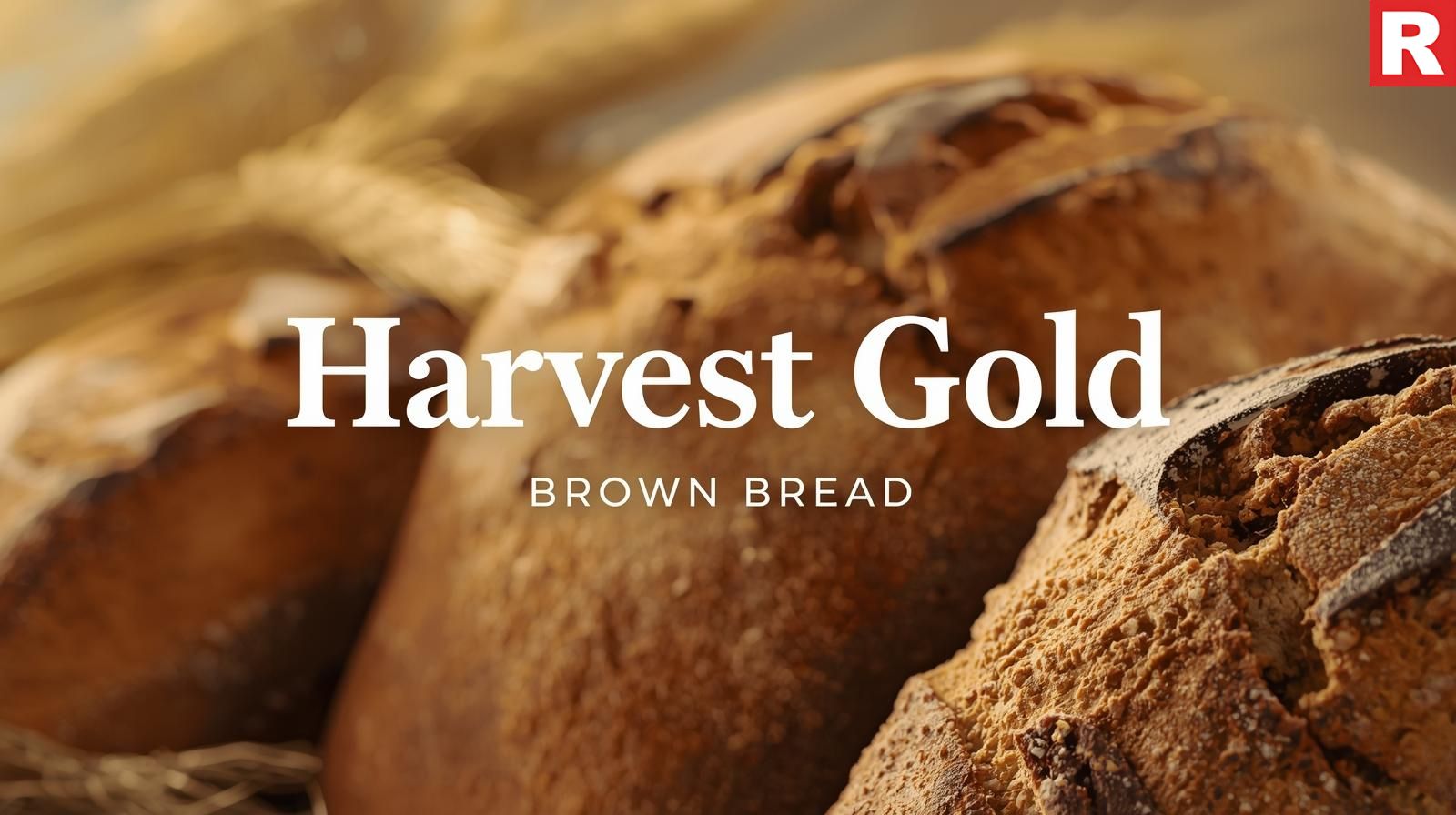
Harvest Gold is a well-known brand, especially in North India, that is well-known for its soft and fresh bread products. Harvest Gold's brown bread is recognized for its strong regional presence, constant freshness, and superb texture. It is popular for its effective daily fresh supply chain and specifically lists "Whole Wheat Flour" as the main ingredient. The bread is suitable for people switching from white bread since it achieves a decent balance between softness and the usual solidity of whole wheat bread. Many households looking for dependable, whole wheat deliciousness consider it a staple due to its significant market presence in the locations where it operates.
English Oven

The premium bakery brand English Oven, which is a division of Mrs. Bector's Food Specialties, is well-known throughout India for its superior bread and baked goods. The brown bread from English Oven is recognized for its outstanding quality, superb texture, and flavor profile, which frequently tends toward a more handmade feel. It is renowned for its consistent quality and good crust development, and it always uses whole wheat flour to provide authentic brown bread. While still being delightfully soft, the bread frequently has a somewhat stronger, more genuine whole wheat quality. It appeals to selective customers who value a higher-quality product for gourmet sandwiches and toast, and it is commonly accessible in supermarkets and larger grocery stores in metro areas, as well as increasingly in other urban areas.
What's new: How Health & Wellness Trends Are Redefining Indian Dessert Menus
Modern Bread
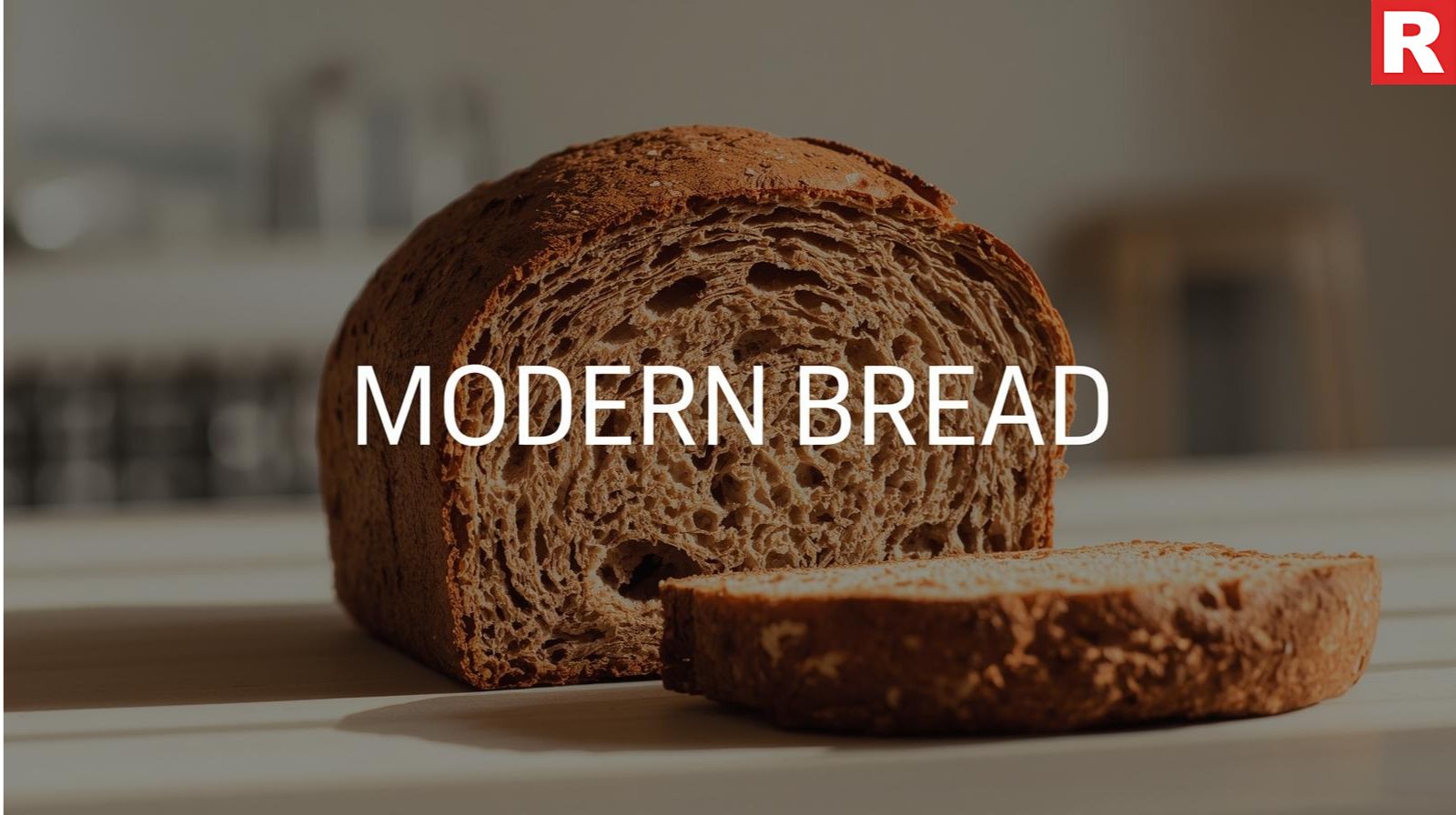
For many years, Modern Bread, a traditional company in India, has been a staple in many homes. Brown bread from Modern Bread is well-known for being widely available in many states, being reasonably priced, and working effectively as a whole wheat bread choice for daily use. It is a dependable alternative for those looking for healthier bread options at a competitive price because it uses whole wheat flour as its main ingredient. Because of its wide distribution network, which makes it accessible even in more isolated and smaller towns, healthy bread is now available to a wider range of people and represents a reliable brand that continues to thrive over time.
The Baker's Dozen

In major Indian cities, The Baker's Dozen, a relatively new creative bakery company, has rapidly developed a devoted following because of its dedication to providing premium, natural, and preservative-free products. Often marketed as "Whole Wheat Sandwich Bread" or something similar, The Baker's Dozen's brown bread is well-known for its minimalist label, clear lack of artificial preservatives, and genuine, healthful flavor. It has a richer, nuttier flavor profile and a more rustic, chewy texture. It frequently mentions clearly that it is made entirely of whole wheat flour. Mostly found in gourmet shops, a few supermarkets, and their own online delivery services in large cities, it serves health-conscious consumers who value natural ingredients and clean eating, and who are prepared to go for specific brands for better flavor and no artificial additives.
Check out: What Are the Special Dishes You Must Try This Durga Puja
Top Electric Cooker Brands for Restaurants in India
Spencers (Private Label)
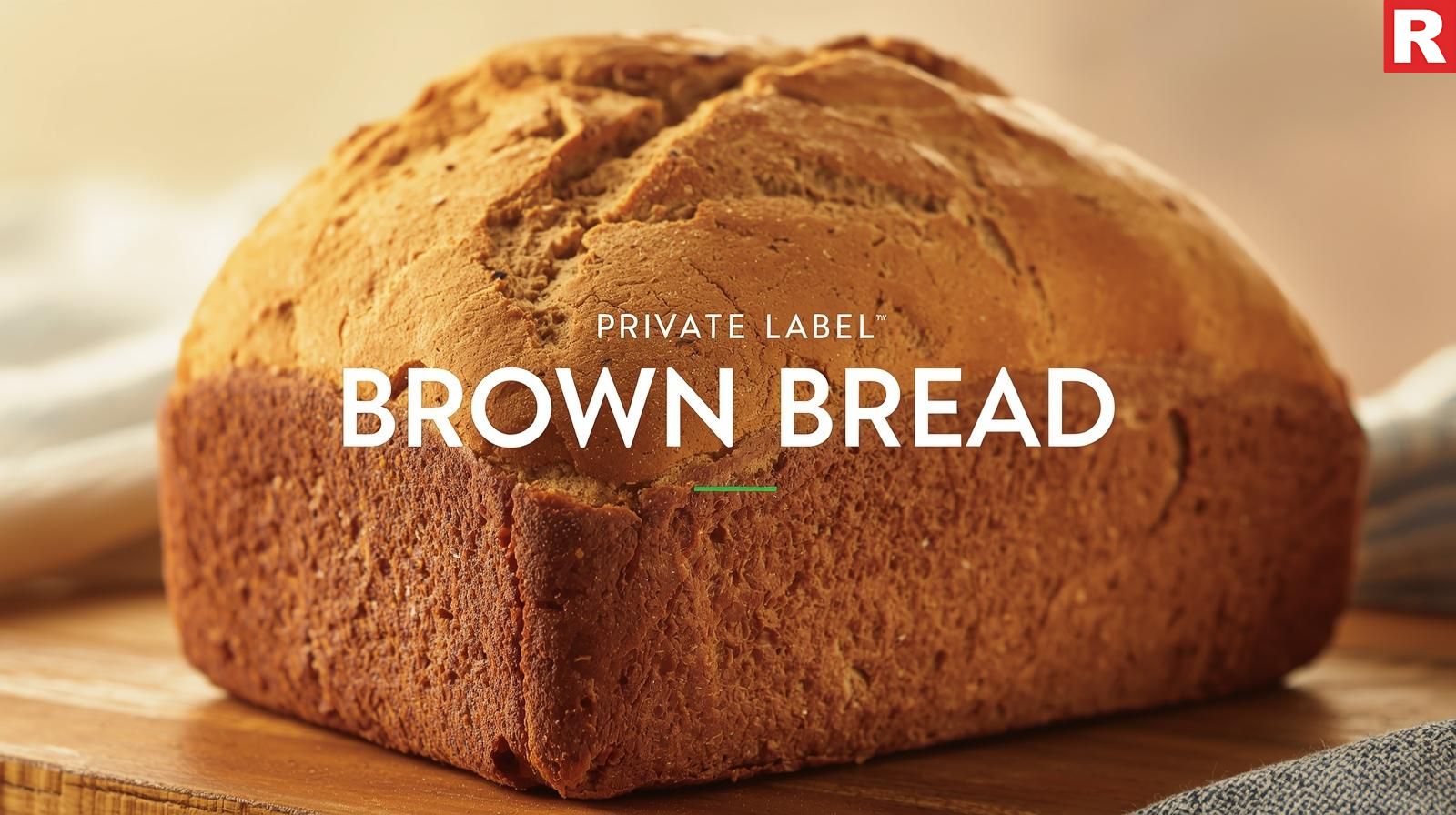
In India, a number of major supermarket chains, including Spencers, Big Bazaar, Reliance Smart, and others, sell brown bread under their own private label. Given their direct store-to-shelf service within their respective supermarket chains, these private-label brown breads are well-known for offering affordable, frequently fresh brown bread options. For regular supermarket shoppers, their prices are typically extremely affordable, providing exceptional value and convenient availability. Although whole wheat flour is typically used, it is always a good idea to look up particular information in the ingredient list because different retailers may have different formulas. For those looking for a convenient and reasonably priced brown bread to include in their weekly shopping, they provide an affordable choice.
Making the Right Choice
Customers in India need to balance awareness, taste, and practicality while selecting the best brown bread:
- Examine the Labels Carefully: Make sure "whole wheat flour" is listed as the first component on the ingredient list, and pay close attention to the amount of sugar and preservatives. Your main line of defense against "brown-washed" white bread is this.
- Think About Your Preference for Texture: Do you like a denser, more rustic loaf for a gourmet experience, or a very soft bread for regular sandwiches? Textural preferences are catered to by different brands.
- Availability Factor: How simple is it to find the brand in your area's local stores or online delivery services?
- Budget: There are several range of brown bread options available, from highly affordable to expensive, so be sure your selection is within your price range.
- Shelf Life: Naturally, brands with fewer preservatives would be less durable. Although this necessitates more frequent purchases, it frequently signals higher freshness and a "cleaner" product.
Read this: Best Flour Brands in India for Pizza & Bakery Restaurants
A Healthier Staple for the Modern Indian Diet
Due to customer demand for wholesome, whole-grain options, brown bread has become increasingly popular in India, marking a national health and wellness revolution. Alongside creative products from more recent, quality-focused firms, this selective pattern has led to the expansion of numerous reliable and affordable solutions from large competitors. Local bakeries and supermarket private labels add even more variety to the selection. The market currently meets all needs, whether one is looking for a product that is widely available, has a particular texture, uses high-quality components, or is devoid of preservatives. Making an educated choice enables customers to include whole-grain goodness into their diet with ease, signaling a long-term change in India toward mindful eating.

Macadamia nuts are more than just a tasty snack. Their rich and buttery flavor makes them a favorite among many. People enjoy them as a treat, but they also offer several health benefits. These nuts are packed with important nutrients that support the body in different ways. For those who want to eat healthy without giving up on good taste, macadamia nuts are an excellent choice. They are natural and full of nutrients like healthy fats, fiber, vitamins, and minerals. Adding them to everyday meals is simple and doesn’t require much effort. Macadamia nuts can be eaten as a quick snack or added to salads, breakfast bowls, or desserts. Even a small amount each day can make a difference in your health.
These nuts help in improving heart health, boosting energy, supporting digestion, and keeping the skin healthy. They are a smart option for people of all ages. With their unique taste and health benefits, macadamia nuts are an easy and enjoyable way to stay fit and feel good every day. Starting small can lead to big benefits in the long run.
Read more: High Protein Indian Meals You Should Try
Top 10 Health Benefits of Eating Dry Fruits Daily
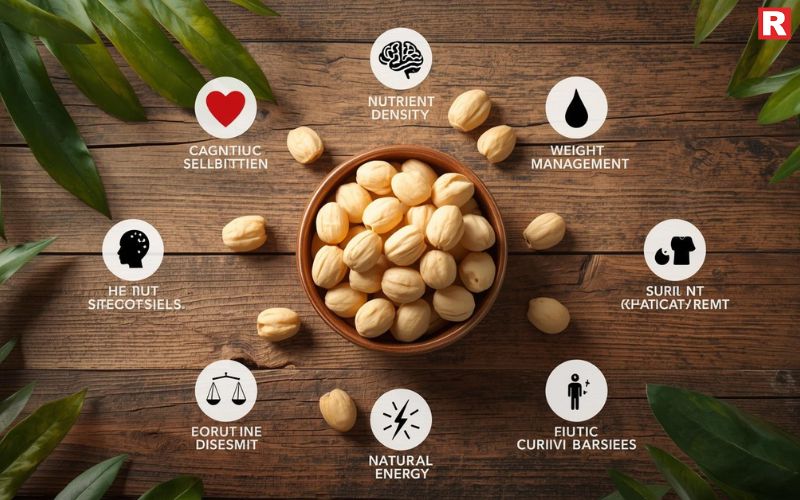
1. Heart-Healthy Goodness
One of the biggest reasons to eat macadamia nuts is that they support heart health. These nuts are full of monounsaturated fats. These fats are the same kind that you find in olive oil, which is known to be good for your heart. Eating these healthy fats helps lower bad cholesterol (LDL) and can increase good cholesterol (HDL). This balance is important for keeping your heart healthy. Studies show that regular intake of monounsaturated fats may reduce the risk of heart diseases like heart attacks. Including just a handful of macadamia nuts in your diet can be an easy way to support your heart without making big changes.
2. A Boost for Brain Health
What you eat affects how your brain works. Macadamia nuts are great brain food. They contain omega-9 fatty acids, also known as oleic acid, which helps protect your brain cells from damage. These nuts also have antioxidants that fight harmful free radicals. Free radicals can cause stress in the brain, leading to memory loss or other issues. Regular consumption of macadamia nuts may help improve memory, focus, and mental clarity. For students, professionals, or anyone who needs to stay sharp, adding macadamia nuts to your diet can give your brain the fuel it needs to perform better.
3. Packed with Nutrients
Macadamia nuts are more than healthy fats. They are a good source of several essential vitamins and minerals. For example, they are rich in vitamin B1 (thiamine), magnesium, manganese, and copper. Vitamin B1 helps your body turn food into energy. Magnesium supports muscle and nerve function. Manganese and copper play a role in bone health and enzyme production. These nutrients work together to keep your body running smoothly. If you have a busy lifestyle, eating macadamia nuts can help you stay energized and balanced.
4. Great for Weight Management
It may sound strange that nuts, which are high in calories, can help you manage weight. But macadamia nuts are an exception. They are full of healthy fats and fiber, which help you feel full for longer. When you feel full, you are less likely to snack on unhealthy foods like chips or sweets. Eating a small portion of macadamia nuts between meals can prevent overeating and keep your weight in check. Also, these nuts don’t cause sharp spikes in blood sugar, unlike processed snacks. This slow and steady energy release helps you stay satisfied throughout the day.
Know more: 6 Benefits of Drinking Black Coffee
5. Supports Healthy Skin
Your skin is the largest organ in your body. What you eat can have a direct impact on its health. Macadamia nuts are especially good for the skin because they contain a rare type of fat called palmitoleic acid (omega-7 fatty acid). This nutrient helps keep your skin hydrated and soft. It also plays a role in repairing damaged skin and protecting it from aging signs like wrinkles and dryness. Adding macadamia nuts to your diet can help you glow from the inside out. For people living in harsh weather conditions or with dry skin, this natural boost is especially helpful.
6. Gut-Friendly Snack
A healthy gut is key to overall wellness. Macadamia nuts are rich in fiber, which helps your digestive system work properly. Fiber promotes healthy bowel movements and prevents constipation. More importantly, fiber feeds the good bacteria in your gut. These bacteria are essential for digestion, immune function, and even mood regulation. Eating macadamia nuts regularly supports a balanced gut microbiome. This means you will feel lighter, more energetic, and less bloated.
7. A Natural Energy Booster
If you are always on the go, macadamia nuts can be your secret weapon. They are calorie-dense, which means they provide a lot of energy in a small portion. But unlike sugary snacks that cause energy crashes, macadamia nuts give you a steady release of energy. This helps you stay active without feeling tired. A handful of these nuts before a workout or during a long day can keep you going. They are especially useful for athletes, students, or anyone with a demanding schedule.
Also check: 5 Foods to Avoid for Better Cholesterol
These 7 Foods Can Help You Cool Your Stomach in Summer
From Murukku to Misal: Regional Snack Stars Winning Big on Q-Commerce Platforms
How to Add Macadamia Nuts to Your Daily Diet
Now that you know the benefits, you might be wondering how to include macadamia nuts in your meals. Here are some simple and effective ways:
- As a snack: Eat them raw or roasted. A handful is enough for a quick energy boost.
- In smoothies: Add a few nuts for extra creaminess and nutrients.
- In salads: Sprinkle chopped macadamia nuts over your favorite salad for texture and flavor.
- With breakfast: Mix them into oatmeal, yogurt, or cereal.
- In baked goods: Add them to muffins, cookies, or granola bars.
- With desserts: Use them as toppings for ice cream or chocolate-based treats.
You don’t have to make big changes. Even a small portion every day can make a difference.
Final Thoughts
Macadamia nuts are a simple yet powerful way to improve your health. From supporting your heart to boosting your brain and keeping your skin healthy, they are a nutrient-rich option for everyone. You don’t need to overhaul your entire diet to enjoy their benefits. Just add them gradually, and you’ll start to feel the difference. For those looking for a natural, tasty, and nutritious snack, macadamia nuts are the perfect choice. Whether you are a busy professional, a student, or someone focused on wellness, they can help you stay energized, healthy, and balanced every day. Start today—make macadamia nuts a part of your daily routine and give your body the care it deserves.

Matcha tea has been enjoyed for hundreds of years. It is an important part of Japanese culture. People use it in traditional tea ceremonies. For a long time, it was mostly known in Japan. But in recent years, more people around the world have started to appreciate it. Many think matcha is just another type of green tea. That is not true. Matcha is made differently from regular green tea. Instead of using leaves to steep in hot water, matcha is made by grinding whole tea leaves into a fine powder. This process keeps more nutrients and antioxidants in the tea. Because of this, matcha is much stronger and healthier than regular green tea.
Every cup of matcha gives the body more vitamins and minerals. It helps boost energy, focus, and overall health. People who drink matcha regularly often feel more refreshed and balanced. With its high content of nutrients, matcha is seen as a superfood. It is easy to add to a daily routine. A simple cup of matcha can be a great way to support a healthy lifestyle.
Read more: 12 Delicious High-Protein Foods to Eat Daily for a Healthier You
Pani Puri Has Different Names in Different Indian States—Know Them All
What Is Matcha Tea?
Matcha is a powdered green tea made from shade-grown tea leaves. The leaves are picked, steamed, and dried before being ground into a fine powder. Because you consume the whole leaf, you get more vitamins, minerals, and antioxidants compared to brewed tea where you only steep the leaves.
The taste is slightly earthy with a smooth texture. It may take a few tries to love it, but once you do, matcha can easily become a part of your daily routine.
The Secret of Matcha
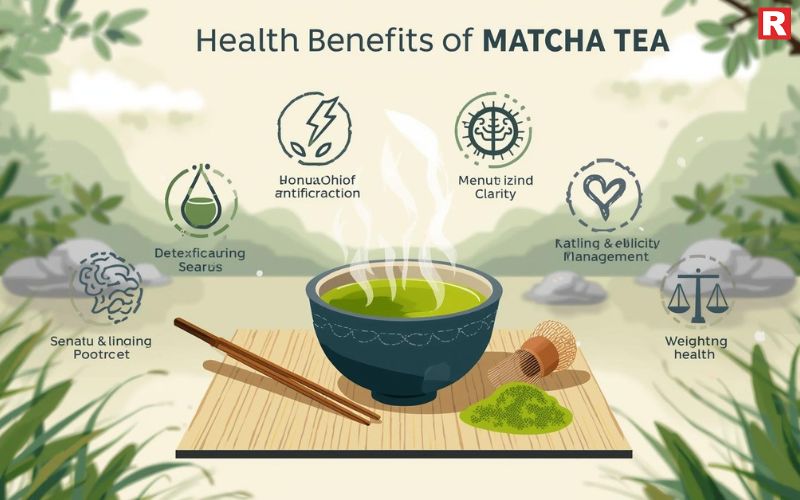
Here are the secret health benefits of matcha tea that you probably didn’t know but should.
1. A Natural Energy Booster Without the Jitters
Many people drink coffee to feel awake. But coffee often causes jitters and crashes. Matcha offers a better way to stay energized. It contains caffeine like coffee but in a gentler form. Along with caffeine, matcha has an amino acid called L-theanine. This combination helps release energy slowly and evenly. It keeps you alert without making you nervous or restless. You can drink matcha in the morning or before work. It helps you stay focused while feeling calm. People who meditate or practice yoga often use matcha to enhance concentration.
2. Detoxify and Rejuvenate – Naturally
Matcha is rich in chlorophyll. This natural plant pigment helps cleanse the body by flushing out toxins. Chlorophyll also supports liver health and helps neutralize harmful chemicals. Regular consumption of matcha can support your body’s natural detox process. Many health experts recommend matcha as a part of a clean diet. It pairs well with a balanced lifestyle and exercise. Even a cup a day can help keep your system fresh and energized.
3. Super Antioxidants for Aging Gracefully
Antioxidants fight damage from free radicals. Free radicals are unstable molecules that cause stress in your body. This stress can lead to early aging and disease. Matcha is packed with antioxidants, especially a type called catechins. One of the most powerful catechins is EGCG (epigallocatechin gallate), which has been studied for its role in preventing cell damage. These antioxidants help protect your skin from aging and support your immune system. Drinking matcha regularly may help you look and feel younger. Experts also say that matcha can reduce inflammation and improve overall health. It’s a simple way to strengthen your body’s defenses.
Know more: 5 Ways to Use Garden Cress Seeds (Halim) for Stronger Hair and Bones
4. Supports Mental Clarity and Focus
If you’ve ever felt foggy or distracted, matcha might be the solution. The unique combination of caffeine and L-theanine not only boosts energy but also sharpens your mind. L-theanine helps you stay calm and relaxed while staying awake. It promotes alpha waves in the brain, which are linked to alertness and creativity. People who use matcha before studying, writing, or working on projects report better focus and fewer distractions. It’s a natural way to improve your concentration without harsh side effects.
5. Helps Manage Weight and Boost Metabolism
Matcha can play a role in weight management. The catechins in matcha boost metabolism and help the body burn fat more efficiently. Some studies suggest that drinking matcha may increase fat oxidation, especially during exercise. While it’s not a magic solution, matcha supports a healthy diet and active lifestyle. Adding matcha to your daily routine can give your weight loss goals a little extra push. It’s best combined with good nutrition and regular movement.
6. Heart Health and Cholesterol Control
Matcha’s antioxidants are also good for heart health. Some research shows that matcha can help reduce LDL cholesterol, which is often called “bad” cholesterol. It also supports healthy blood pressure levels. Regular consumption of matcha, combined with a healthy diet, can protect your heart from long-term damage. While matcha isn’t a cure, it’s a simple and natural way to keep your heart strong and healthy.
Also check: 5 Foods to Avoid for Better Cholesterol
How to Enjoy Matcha Every Day
Matcha is easy to include in your daily life. You don’t need special equipment to enjoy its benefits. Here are a few ideas to try:
- Matcha Latte – Mix matcha powder with hot milk or plant-based milk. Add a little honey or maple syrup for sweetness.
- Smoothies – Blend matcha with fruits like bananas, berries, or spinach for a nutrient boost.
- Baking – Add matcha to cookies, muffins, or pancakes for a subtle flavor and extra antioxidants.
- Salad Dressings – Mix matcha with olive oil and lemon juice for a fresh, healthy twist.
- Iced Matcha – Combine matcha with cold water and ice for a refreshing drink on warm days.
You can start small with half a teaspoon a day and gradually increase it as you get used to the flavor.
Precautions to Keep in Mind
Matcha is safe for most people when taken in the right amount. However, it is important to drink it in moderation. Matcha contains caffeine, and having too much can lead to problems. Some people may experience trouble sleeping or feel an upset stomach after drinking too much matcha. For those who are pregnant or breastfeeding, it is best to talk to a doctor before adding matcha to their diet. This helps ensure both the mother and baby stay healthy.
It is also important to choose good-quality matcha. Some low-quality powders may have artificial colors, flavors, or other additives. These can reduce the health benefits of matcha. To get the most out of this healthy drink, it is better to buy pure matcha from trusted sources. By drinking it in the right way, people can enjoy its benefits without any risks. Matcha can be a healthy part of everyday life.
Check more: 6 Unexpected Benefits of Eating Jackfruit (Kathal) – Nature’s Spiky Surprise!
Six Benefits of Starting Your Day with Okra Water
Quick Commerce’s Role in Expanding Regional Specialties to Tier-2 & Tier-3
A Sip of Wellness
Matcha tea is more than a popular drink. It is a natural way to support good health. Many people do not know how much it can help. Matcha can boost energy without causing jitters. It also helps the body get rid of toxins and fight aging. Adding matcha to daily life is easy. It does not cost much and can be used in different ways. People can enjoy it hot or cold, in drinks or food. Every cup of matcha helps nourish the body and calm the mind. It supports a healthier lifestyle. When someone needs a quick boost or wants to feel refreshed, matcha is a great choice. It’s a simple step toward feeling better every day.

Food is emotion for everyone. For some, it’s a connection to home, family, and tradition. This is especially true when it comes to snacks. Across India, every state has its own special snacks. These are not just tasty treats—they carry memories, flavors, and culture. Now, thanks to quick commerce (Q-commerce) platforms like Swiggy Instamart, Blinkit, Zepto, and others, these regional favorites are reaching people faster than ever before.
Whether you miss the crunchy murukku from your hometown or the spicy misal that reminds you of weekend breakfasts, these snacks are helping you feel closer to home. Q-commerce platforms are making it possible to order them in minutes, even if you live in a big city far from your roots. In this article, we will explore how these regional snack stars are becoming a hit and why more people are turning to them.
Read more: Kootu Curry Recipe: Traditional Kerala-Style Curry for Your Festive Menu
Pani Puri Has Different Names in Different Indian States—Know Them All
Why Are Regional Snacks Trending on Q-Commerce?
There are many reasons why regional snacks are becoming popular on Q-commerce platforms.
- First, people are always looking for comfort food. Snacks from childhood or family gatherings offer a sense of familiarity. When you are away from home, these snacks bring back memories.
- Second, Q-commerce platforms make it very easy to order them. Earlier, you had to visit local shops or wait for family members to send them from home. Now, you can order them through your phone and get them delivered in 30 minutes or less.
- Third, many platforms are working with local vendors. They ensure that the snacks are authentic and of high quality. Some even offer homemade or artisanal versions that taste just like home-made snacks.
- Lastly, regional snacks are affordable and loved by all age groups. They are perfect for tea time, quick bites, or celebrations. This makes them a great choice for daily snacking.
Popular Regional Snacks Winning Big
Let’s take a closer look at some of the most popular snacks that are winning hearts across the country.
1. Murukku – South India’s Crispy Delight
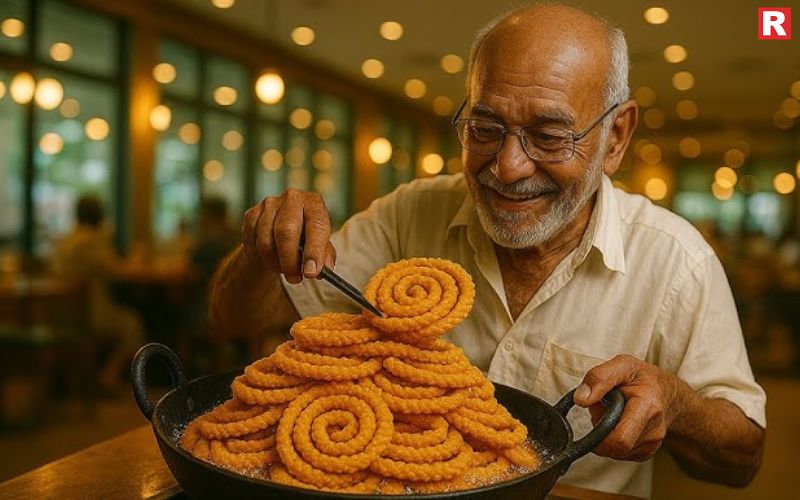
Murukku is a crunchy snack made from rice flour and spices. It is mostly enjoyed in states like Tamil Nadu, Andhra Pradesh, and Karnataka. Traditionally, people make it at home during festivals like Diwali or other family celebrations. Now, you can easily order murukku from Q-commerce platforms. Many brands offer homemade flavors that remind people of their mothers’ or grandmothers’ cooking. The snack’s light, crispy texture and savory spices make it perfect for tea time. People living in metros like Bangalore or Chennai especially order murukku when they miss the festive spirit.
2. Misal – Maharashtra’s Spicy Favorite
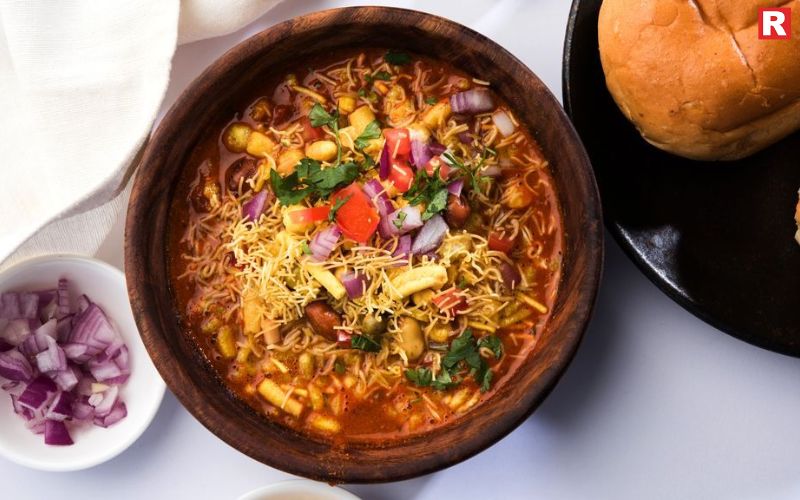
Misal is a spicy dish from Maharashtra made with sprouts, farsan, onions, and tangy gravy. It is mostly eaten as a breakfast or brunch dish. The bold flavors and heat make it a favorite among spice lovers. With Q-commerce platforms, misal is now available as ready-to-eat kits. You can order it without worrying about preparation time. Many professionals in Mumbai or Pune order misal on weekends when they want something filling and flavorful. Some platforms even offer “restaurant-style” misal that tastes just like the versions served at local stalls.
3. Bhel Puri – A Light, Tangy Treat

Bhel Puri is a popular street snack in western India, especially in Mumbai and Gujarat. It is made of puffed rice, sev, tangy chutneys, and fresh vegetables. Q-commerce platforms now sell ready-to-mix kits for bhel puri. These kits are perfect for students, young professionals, or families who want to enjoy street-style snacks at home. The crunchy and tangy flavors make it a perfect snack for movie nights or casual hangouts.
4. Chivda – A Crunchy Tea-Time Treat
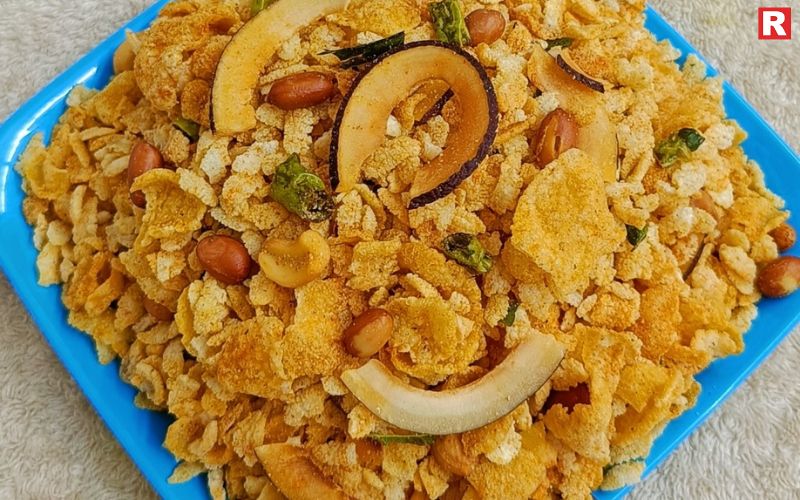
Chivda is a snack loved across central and western India. It is made from flattened rice, peanuts, and curry leaves. Light and flavorful, it pairs perfectly with a cup of tea. Thanks to Q-commerce platforms, people can now order freshly made chivda anytime. It is especially popular during the rainy season when people crave warm and savory snacks. Many users share stories of how chivda reminds them of their childhood snacks.
Know more: 10 Must-Try Gujarati Dishes That Will Delight Your Taste Buds
5. Theplas and Khakhra – Gujarat’s Healthy Favorites
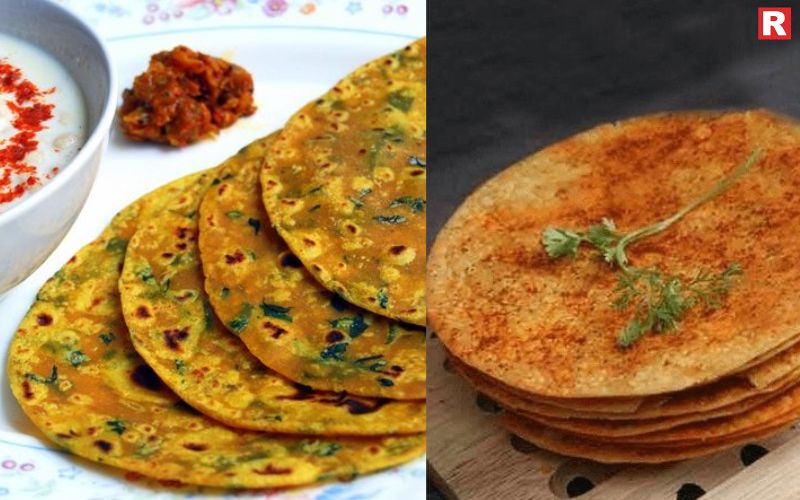
Theplas and khakhra are crispy and slightly spiced snacks from Gujarat. They are not only tasty but also healthy. Many people carry them for long trips or pack them in lunch boxes. Q-commerce platforms offer vacuum-sealed packs of these snacks that stay fresh for days. Health-conscious users love these options as they are made with whole grains and fewer oils. This has led to a rise in demand among urban buyers.
Why These Snacks Are Perfect for Q-Commerce
Several factors make regional snacks ideal for quick commerce.
- Convenience: They are easy to pack and ship. Most of these snacks have a longer shelf life, making them suitable for fast delivery.
- Affordability: Compared to gourmet snacks or imported treats, regional snacks are budget-friendly. They attract a wider audience.
- Nostalgia: Food is tied to memories. A snack from your hometown helps you feel connected to your roots, especially when living away from family.
- Partnerships: Many platforms are working with local artisans and small businesses. This helps preserve traditional flavors while offering users something authentic.
- Customization: Some platforms allow users to choose spice levels, packaging sizes, or combo packs, making them more appealing.
Also check: 10 Different Types of South Indian Rice Dishes
Data and Trends
The demand for regional snacks has grown steadily over the last few years. During festive seasons like Diwali and Ganesh Chaturthi, snack orders see a 30-50% rise. In metros, snack kits have become a top-selling category. In cities like Mumbai, Bangalore, and Pune, users order misal, bhel puri, and murukku the most. Startups are also collaborating with local vendors to introduce new flavors or healthier versions of these snacks.
Subscription boxes are emerging as a new trend. Customers receive a curated selection of snacks from different regions every month. This helps them explore flavors while supporting small businesses.
The Future of Regional Snacks on Q-Commerce
The snack trend is only going to grow. Experts predict that regional snacks will become a major segment in Q-commerce over the next few years. We are already seeing new trends like fusion snacks. For example, millet-based murukku or low-oil misal mixes are gaining popularity among health-conscious users.
Eco-friendly packaging is also becoming important. Many vendors now offer biodegradable packaging options, making snack delivery more sustainable. Finally, subscription boxes that offer regional snacks from across India are set to become a favorite. These boxes allow users to try new flavors while supporting local businesses.
Check more: Top 5 States With the Spiciest Food in India
Metkut Recipe: Traditional Maharashtrian Comfort Food
Why Fish Kobiraji Is a Must-Try for Every Food Lover in Kolkata
The Road Ahead
Regional snacks are more like memories of home, festivals, and family moments. Each bite carries culture and tradition. With quick commerce platforms, these snacks are now just a click away. People in big cities can enjoy murukku from the South or misal from Maharashtra in minutes. The ease of ordering has made these snacks part of daily life again. Tea-time feels complete with chivda, while bhel puri brings back the charm of street corners. More people are embracing these flavors for comfort and nostalgia. The demand is rising across metros and small towns alike. Regional snacks are not just tasty; they are a way to stay connected with roots. Quick commerce is helping people rediscover these authentic flavors anytime they want.

Durga Puja is not just a festival. It is a time when people come together. Families, friends, and neighbors celebrate with joy. The streets of Kolkata and other cities are filled with lights, music, and decorations. People wear new clothes and visit pandals to see the idols of Goddess Durga. But what makes the festival even more special is the food. Traditional dishes are prepared at home and shared with everyone. Many stalls are set up near pandals to serve tasty street food. The smell of spices and sweets fills the air.
People look forward to eating together. Some dishes are simple, while others are rich and flavorful. From khichuri to rolls and sweets, every dish has its own story. Trying these foods is a way to enjoy the festival fully. It brings people closer and makes the celebrations even more memorable. Anyone visiting during Durga Puja should not miss these delicious treats. They are an important part of the festive spirit.
Read more: Celebrate Navaratri with These Must-Try Dishes – Flavorful, Festive & Wholesome!
Why Fish Kobiraji Is a Must-Try for Every Food Lover in Kolkata
Why Food Is So Important During Durga Puja
Food plays a very important role during Durga Puja. It is not just about eating. It is about sharing, caring, and being together. People offer food to the goddess as a sign of respect. After that, families and communities come together to enjoy the meal. These gatherings create a feeling of belonging and happiness.
Many of the recipes are old. They have been made in homes for generations. The ingredients are simple, but the taste is rich and full of history. Some dishes are spicy and hearty, while others are sweet and soft. Every dish has its own story and meaning. Food is also a way to keep traditions alive. By cooking and sharing these recipes, people feel connected to their culture. It brings families closer and creates beautiful memories. During Durga Puja, eating together becomes a way to celebrate life and happiness. Anyone visiting the festival will find that food is one of the best ways to experience the spirit of the celebration. It brings warmth and joy to everyone.
Must-Try Durga Puja Dishes – A Festive Food Trail
Must-Try Durga Puja Dishes – A Festive Food Trail Filled with Traditional Flavors, Sweet Treats, Spices, and Joyful Delights.
1. Khichuri – The Comfort Food of Durga Puja
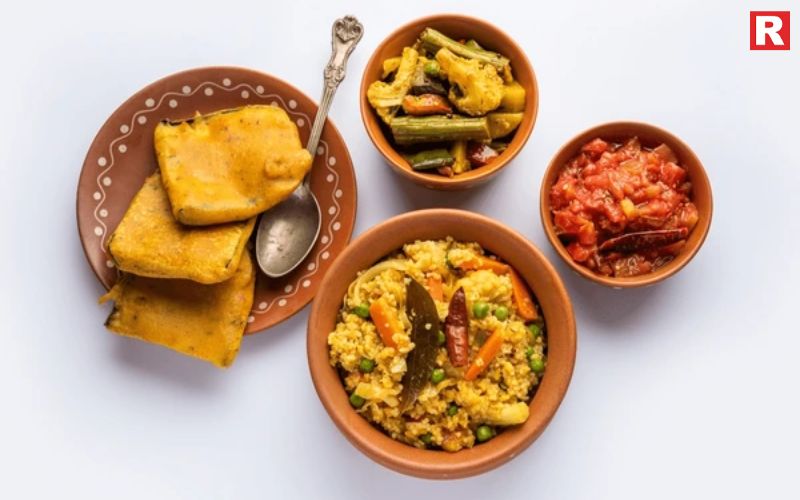
Khichuri is a rice and lentil dish cooked with ghee, mild spices, and sometimes vegetables. It is light but filling. It is usually served as prasad, or offering, to the goddess. The aroma of ghee and cumin makes it hard to resist. Many families cook khichuri together and serve it with a smile. It pairs perfectly with side dishes like fried vegetables or chutney.
2. Luchi & Alur Dom – A Morning Favorite
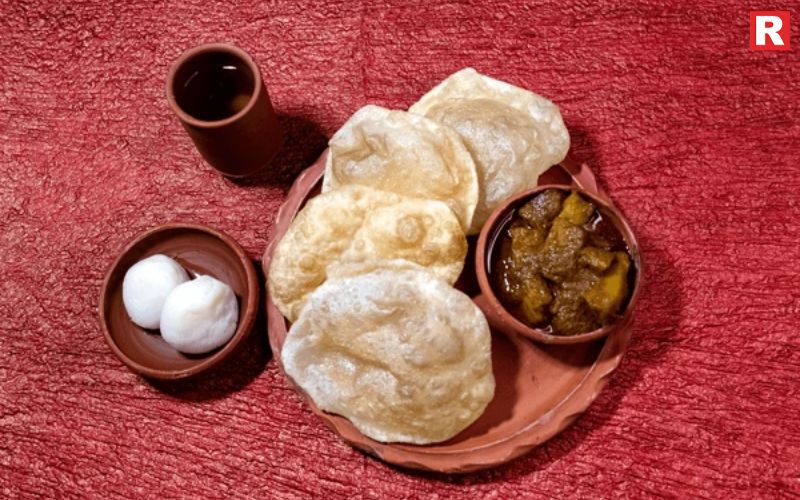
Luchi is a deep-fried, fluffy bread made from refined flour. It is soft and puffs up when fried. Alur Dom is a spicy potato curry made with aromatic spices like cumin, turmeric, and red chili powder. Together, they create a delicious and comforting meal. This combination is often served in the morning during Durga Puja. It is loved by children and adults alike.
3. Chingri Malai Curry – The Royal Treat

Chingri Malai Curry is a rich and creamy prawn dish cooked in coconut milk. The prawns are marinated with turmeric and salt before being cooked. The coconut milk gives the curry a smooth texture and slightly sweet taste. This dish is a must for seafood lovers. It is best enjoyed with plain rice or khichuri.
4. Mutton Curry – A Festive Classic
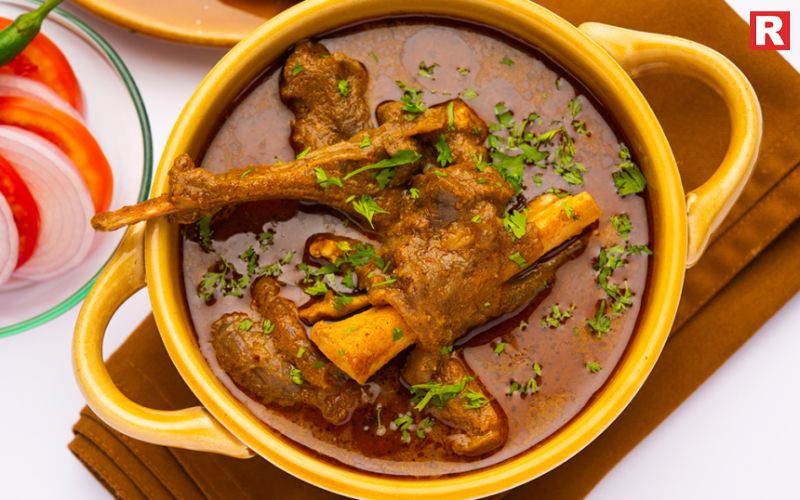
For those who enjoy hearty flavors, mutton curry is a must-try. It is slow-cooked with garam masala, bay leaves, and other spices. The meat becomes tender and flavorful. It is often served during festive lunches and dinners. Many families have their own version of this curry, passed down through generations.
5. Sweets – The Perfect End to Every Meal
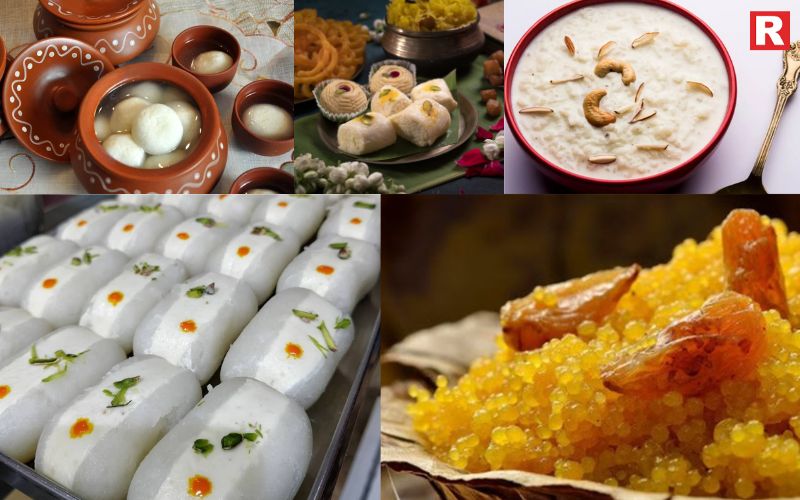
No festive meal is complete without sweets. Durga Puja is the best time to try some of the most famous Bengali sweets.
- Rasgulla – Soft, spongy balls soaked in sugar syrup. It melts in the mouth and is a favorite across India.
- Sandesh – Made from fresh chhena and sugar, this sweet is often flavored with saffron, cardamom, or pistachio.
- Payesh – A creamy rice pudding cooked with milk, sugar, and cardamom. It is usually served at the end of a meal.
- Chamcham – A cylindrical sweet made from chhena, soaked in thick sugar syrup and sometimes stuffed with coconut.
- Mihidana – Tiny, fine sweet droplets made from ground chana dal and sugar, giving it a delicate texture and flavor.
These sweets are sold at sweet shops across Kolkata during the festive days. Many families also prepare them at home.
Know more: Pani Puri Has Different Names in Different Indian States—Know Them All
Famous Street Food – What You Must Taste
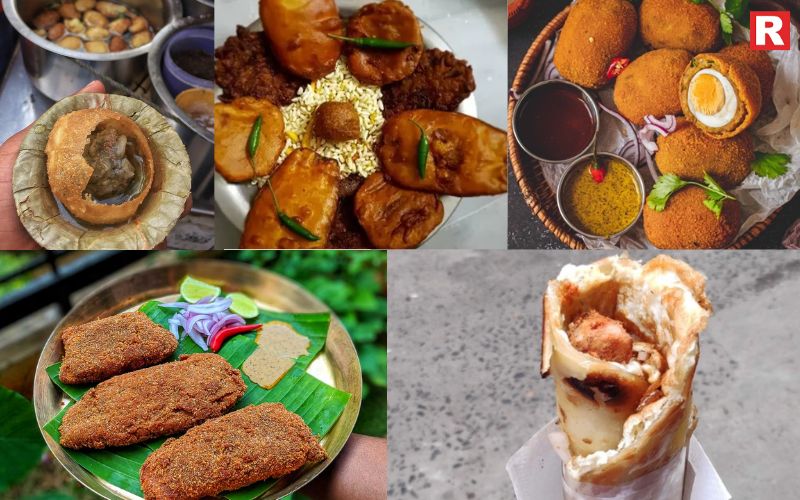
Durga Puja is not only about home-cooked meals. Street food adds another layer to the celebration. The stalls near pandals are filled with tempting options. Here are five famous street foods you must try this season.
1. Phuchka
Phuchka is a crispy shell filled with mashed potatoes, tamarind water, and spices. It is similar to panipuri but has a tangy and spicy twist. Vendors prepare it fresh in front of you. It is crunchy, flavorful, and addictive.
2. Roll (Kathi Roll)
The Kolkata roll is a must-try. It is a paratha filled with egg, chicken, or mutton along with spices and sauces. The wrap is grilled lightly to perfection. It’s a quick meal while hopping between pandals.
3. Egg Devil
Egg Devil is a deep-fried snack made from boiled eggs coated with spiced potato mixture and breadcrumbs. It is crispy on the outside and soft inside. It is perfect for evening snacks.
4. Fish Fry
Fish fry is a classic street snack. Fish pieces are marinated with turmeric, salt, and other spices, then coated in breadcrumbs and fried until golden brown. It’s crispy, flavorful, and goes perfectly with mustard sauce or chutney.
5. Telebhaja
Telebhaja refers to deep-fried snacks like beguni (battered eggplant), alur chop (potato fritters), and mochar chop (banana flower cutlets). These are crispy, spicy, and best enjoyed with tea during the monsoon season.
These street foods give a different perspective on how Kolkata celebrates the festival. Eating them is part of the experience.
Tips for First-Timers
- Visit Early: Try visiting food stalls early in the day to avoid long queues.
- Talk to the Vendors: Most vendors love sharing the story behind their dishes.
- Try Everything in Small Portions: You don’t have to finish a plate; sample many flavors.
- Pair with Local Drinks: Try local drinks like cha or fresh sugarcane juice to complement the spices.
- Respect Local Customs: Many stalls also serve prasad. It’s a good way to experience rituals.
Where to Find Authentic Durga Puja Food
Kolkata is the best place to explore Durga Puja food. The markets near College Street, Shobhabazar, and Park Street are famous for their festive stalls. Many neighborhoods organize community feasts called bhog, where you can try khichuri and other items for free or at low cost. Sweets are available at iconic shops like K.C. Das, Balaram Mullick, and Ganguram.
Also check: 12 Delicious High-Protein Foods to Eat Daily for a Healthier You
Delhi’s Love Affair with Chole Bhature – A Culinary Classic
Best Food Festivals Every Foodie Must Attend
A Feast for the Senses
Durga Puja is not just a religious event. It is a time to celebrate life, family, and culture. Food plays a big role in the festival. People gather to enjoy different kinds of dishes. From traditional meals like khichuri to street snacks like phuchka, every bite is tasty and special. These foods are full of stories and memories. They bring people together and make the celebration more joyful. Families cook and share meals, and friends explore new flavors at the stalls. Trying these foods is a way to feel the spirit of the festival. This Durga Puja, tasting these special dishes and sharing them with loved ones will create moments to remember for a long time.

Navaratri is one of the most loved festivals in India. It is a time when families come together, pray, and also enjoy special food. During these nine days, many people observe fasts and eat sattvik meals that are simple, healthy, and delicious. Food is an important part of this celebration. Every region of India brings its own flavors and traditions to Navaratri meals.
If you are planning to try something new this Navaratri, here are the top dishes you must taste. These dishes are easy to prepare, full of nutrition, and perfect for fasting days. Whether you are a first-time cook or someone who loves experimenting with festive recipes, this list will guide you.
Read more: Pani Puri Has Different Names in Different Indian States—Know Them All
12 Delicious High-Protein Foods to Eat Daily for a Healthier You
Why Food is a Big Part of Navaratri
During Navaratri, many people avoid grains, onion, and garlic. Instead, they eat foods made from millets, fruits, roots, and dairy products. These ingredients keep you full, energetic, and light at the same time.
Food is not only about taste during the festival. It is about keeping the body in balance while observing fasts. Each region adds its own twist using local ingredients. For example, in Maharashtra, sabudana dishes are popular, while in Gujarat, sweet potato preparations are common. Exploring these dishes makes the festival more special.
Top Dishes You Can’t Miss This Navaratri
1. Sabudana Khichdi
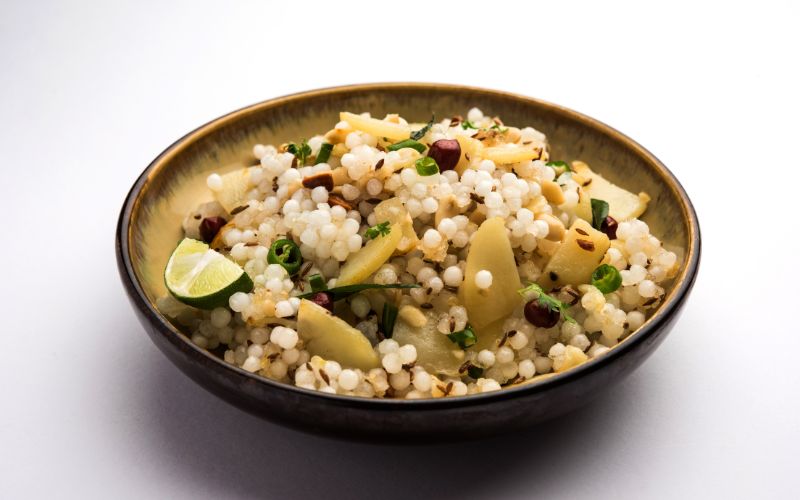
Sabudana khichdi is a popular dish during Navaratri. It is made by soaking tapioca pearls in water. These pearls are then cooked with potatoes, peanuts, and mild spices. The dish is light and easy to digest, making it perfect for fasting days. The peanuts add crunch, while potatoes give it softness. Cumin seeds, green chilies, and black pepper are used to enhance the flavor without overpowering it. It is filling but not heavy on the stomach. People often prepare it when they need something quick and tasty. It is also a great source of energy. Sabudana khichdi is best enjoyed hot. Adding fresh coriander leaves and a little lemon juice on top makes it more refreshing. The tanginess of the lemon balances the spices. It is a comforting and nourishing dish that many families cook during the festival.
How to serve: Top it with fresh coriander and a squeeze of lemon for extra taste.
2. Kuttu Ki Puri

Kuttu ki puri is a deep-fried bread made from buckwheat flour. It is crunchy on the outside and soft inside. This dish is loved by families during Navaratri because it feels like a special treat. Even people who are fasting enjoy it. The puris are made by mixing buckwheat flour with boiled potatoes, spices, and a little water. The dough is shaped into small rounds and fried in warm oil until golden brown. The puris puff up slightly and have a crisp texture. It pairs well with curd or chutney. Some use mint or coriander chutney to add extra flavor. The puris are simple but satisfying. They are a good option when someone wants a festive dish without much effort. Using warm oil while frying helps get the perfect crunch every time.
- Tip: Use warm oil while frying to get crisp puris.
3. Singhare Ke Aate Ka Halwa
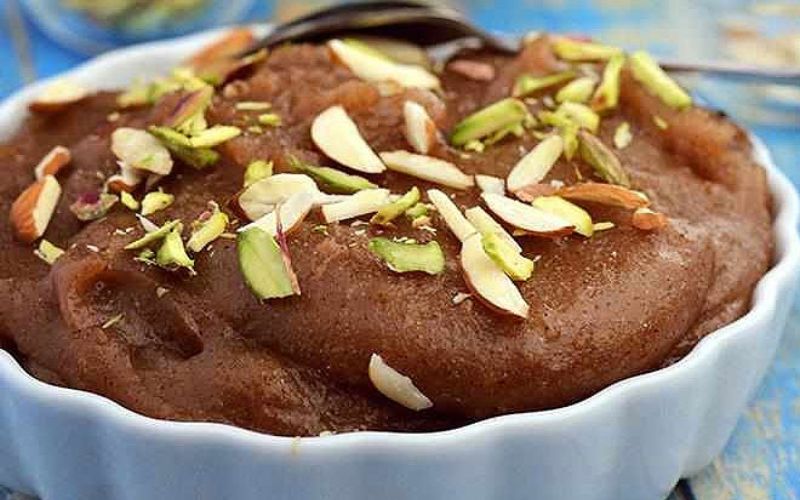
Singhare ka atta, or water chestnut flour, is used to make a soft and sweet halwa during Navaratri. It is a rich and nourishing dish. The flour is roasted in ghee and mixed with milk or water to make it soft. Sugar or jaggery is added to give sweetness. Dry fruits like almonds, cashews, and raisins are added for texture and extra nutrition. The dish is energy-packed, which helps those observing fasts stay strong throughout the day. It is creamy, fragrant, and comforting. Many families cook this halwa on fasting days as a treat for themselves. Serving it warm with a spoon of ghee makes it more special. The ghee gives it a traditional touch and a richer taste. This halwa is a festive dessert that fills the heart and stomach, making it a favorite dish during the festival.
Serving suggestion: Serve it warm with a spoon of ghee for a traditional feel.
4. Rajgira Paratha
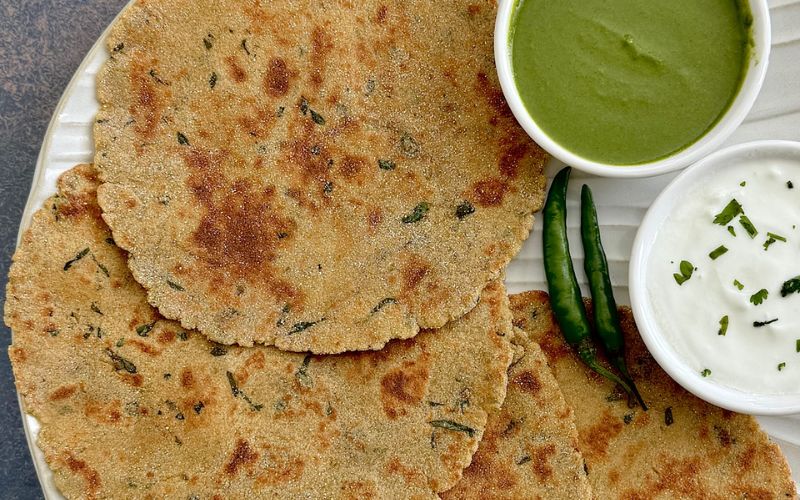
Rajgira paratha is a nutritious flatbread made with amaranth flour. Amaranth is rich in protein and helps keep the body strong during fasting. The dough is prepared with rajgira flour, boiled potatoes, and spices like black pepper and cumin. Some add finely chopped coriander or curry leaves to bring out the aroma. The parathas are cooked on a hot pan with a little ghee or oil until they turn golden brown. They are soft, flavorful, and satisfying. Rajgira parathas are easy to digest but also filling. They are often served with curd or a simple potato preparation. Many people prefer this dish because it is light yet keeps them energetic for long hours. It can be prepared quickly and is a good option when one wants a healthy meal without compromising on taste. The mild flavors pair well with other fasting dishes.
Tip: Add finely chopped coriander or curry leaves for extra aroma.
5. Aloo Ka Raita
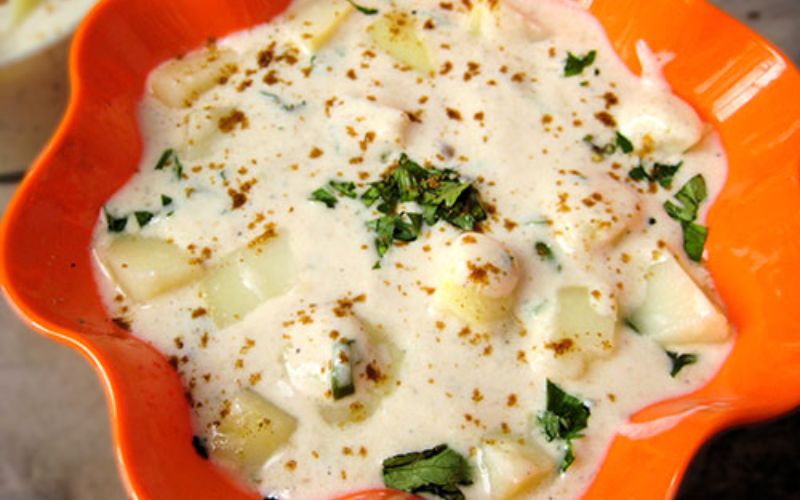
Aloo raita is a cooling side dish that balances spicy or rich foods. It is made by mixing boiled potatoes with fresh curd and spices. The potatoes are chopped or mashed before being added to the curd. Roasted cumin powder, black salt, and fresh herbs like mint give it a refreshing flavor. The dish is simple, quick to prepare, and helps in digestion. It is a perfect accompaniment for other fasting dishes like kuttu puri or sabudana khichdi. The creamy texture of curd complements the soft potatoes well. It can be served chilled or at room temperature. Many families prepare aloo raita when they need something light but tasty. Adding roasted cumin powder and mint leaves enhances the aroma and taste. It is a mild dish that soothes the stomach while giving a burst of flavor. It is easy to prepare and can be made in under 10 minutes.
Serving idea: Garnish with roasted cumin powder and fresh mint.
Know more: Top 5 States With the Spiciest Food in India
6. Fruit Chaat
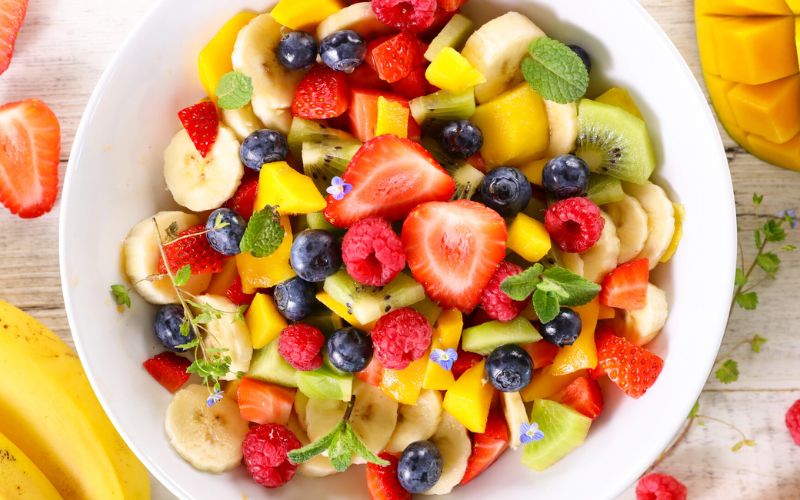
Fruit chaat is a colorful and healthy dish that is often enjoyed during Navaratri. It is made by mixing seasonal fruits like apple, banana, pomegranate, and papaya. These fruits are cut into small pieces and tossed with black salt, chaat masala, and lemon juice. The spices give it a tangy and slightly spicy flavor while keeping it refreshing. The dish is light and helps keep the body hydrated during fasting. It can be prepared quickly and enjoyed as a snack or side dish. Fruit chaat is loved for its vibrant look and natural sweetness. Using fresh, seasonal fruits makes it taste even better. Some families add chopped cucumber or soaked nuts for extra texture. It is perfect when someone wants a healthy treat without spending too much time in the kitchen. The flavors balance well, making it a popular choice during the festive days.
Tip: Use seasonal fruits for the best taste and texture.
7. Thalipeeth (Fasting Version)
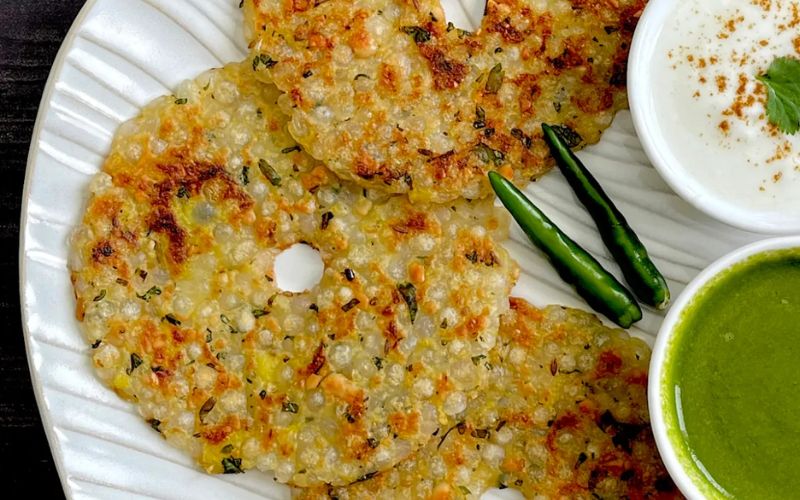
Thalipeeth is a spiced multi-grain flatbread from Maharashtra. For fasting, it is made with ingredients like amaranth, peanuts, and boiled potatoes. The flour mixture is combined with spices like cumin, black pepper, and green chilies. Water is added to make soft dough, which is flattened by hand and cooked on a hot griddle. It is cooked with ghee or oil until crispy on the outside and soft inside. Thalipeeth is filling and nutritious. Many families enjoy it for breakfast or dinner during Navaratri. It pairs beautifully with homemade butter or curd. A simple peanut chutney made by grinding roasted peanuts adds flavor without overpowering the dish. This version of thalipeeth keeps the flavors subtle while providing the energy needed during fasts. It is also loved because it can be prepared quickly and enjoyed with other fasting foods.
Serving suggestion: Pair it with a simple chutney made from roasted peanuts.
8. Paneer-Based Dishes

Paneer is a popular ingredient during Navaratri because it is rich in protein and calcium. Many families include paneer in their fasting meals. It can be used in simple stir-fries, soft gravies, or cubes mixed with curd. Mild spices like black pepper, ginger, and green chilies are used to enhance its flavor. Onion and garlic are avoided in fasting recipes, so these ingredients provide a perfect alternative. Paneer stays soft and creamy even when cooked quickly, making it ideal for light meals. It pairs well with other dishes like aloo raita or rajgira paratha. Some people add fresh herbs like coriander to brighten the taste. Paneer-based dishes offer a satisfying texture and help maintain energy levels during fasting. They are simple to prepare and add variety to the fasting menu without compromising on taste or nutrition.
Tip: Avoid onion and garlic. Use ginger and green chili for flavor.
Also check: 10 Different Types of South Indian Rice Dishes
9. Vrat Special Ladoo
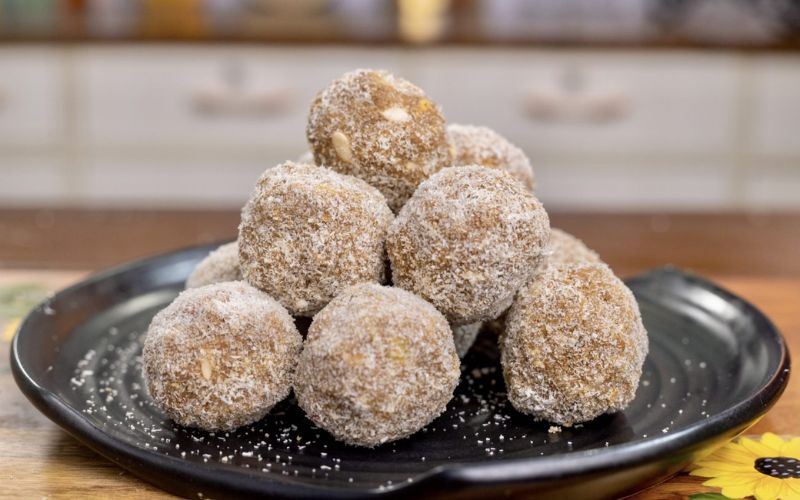
Vrat special ladoos are sweet treats made with healthy ingredients. They are usually prepared with nuts like almonds and cashews, seeds like sesame, and natural sweeteners like jaggery or dates. These ladoos are energy-packed and help people stay strong during fasting. Coconut is often added to give them a rich and nutty flavor. The ingredients are ground or chopped and mixed with melted ghee before being shaped into small balls. They can be made in advance and stored in airtight containers for freshness. Many families prepare a batch at the start of Navaratri to enjoy throughout the week. These ladoos are a healthy alternative to heavy sweets, providing nutrition without harming digestion. They are perfect as a snack or dessert after a light meal and bring a sense of comfort and celebration during the festive days.
Serving idea: Keep them in airtight containers for freshness.
Regional Flavours to Explore
- North India: Here, sabudana khichdi and rajgira parathas are very popular. People often pair them with homemade curd and seasonal fruits.
- Maharashtra: Thalipeeth and sabudana vada are the go-to dishes. These are quick to prepare and loved by families during fasting days.
- Gujarat: Sweet potato preparations, vrat farsan, and fruit chaat are widely enjoyed. People add jaggery or black salt to enhance the taste.
- South India: Coconut plays a major role here. Dishes like curd rice without onion, coconut chutney, and steamed vegetables are common.
- Eastern India: Pumpkin, colocasia, and root vegetables are staples. They are cooked with mild spices and served with homemade butter or curd.
Exploring these flavors will give you a deeper connection with the traditions of Navaratri while enjoying a variety of tastes.
Health Benefits of Navaratri Dishes
Navaratri meals are not only tasty but also healthy. Millets like rajgira are full of protein and fiber. Fruits keep the body hydrated. Dry fruits and nuts provide energy. Roots and tubers like sweet potatoes are rich in vitamins and minerals.
Eating sattvik food helps in detoxification. It supports digestion and gives you strength throughout the day. These dishes are also light on the stomach and easy to cook at home.
Check more: Celebrate Onam with 41 Sadya Menus Across India
Best Food Festivals Every Foodie Must Attend
Power-Packed & Plant-Based: Top Vegan High-Protein Foods Trending
Quick Tips for Preparing Navaratri Meals at Home
- Plan Ahead: Soak ingredients like sabudana the night before. Prepare chutneys and raita fresh in the morning.
- Use Available Ingredients: If you don’t find a specific flour, substitute it with similar ones. For example, kuttu can be replaced with amaranth or millet flour.
- Balance Taste and Nutrition: Use natural spices like black pepper, cumin, and ginger instead of too much oil or heavy seasoning.
- Store Smartly: Cook larger batches of ladoos or parathas and refrigerate. This saves time and keeps you organized.
- Serve Fresh: Many fasting dishes taste best when served fresh. Keep raita, chutney, and fruits separate until mealtime.
Ready For Navaratri!
Navaratri is a celebration of devotion, discipline, and togetherness. Food plays a major role in keeping the spirit alive. These top dishes are not only easy to cook but also nutritious and delicious. They bring the warmth of tradition and the joy of sharing meals with family. This festive season, try out these recipes and enjoy the flavors of Navaratri. Whether you are fasting or simply looking to explore new dishes, this list will surely add excitement to your celebrations. Celebrate with taste, health, and happiness. Happy Navaratri!

Nothing feels better than a chilled glass of draft beer poured fresh from the tap. The crisp taste, smooth head, and perfect temperature make it different from bottled or canned beer. In India, draft beer culture is on the rise, not just in pubs but also in homes. More people are building personal bars, hosting parties, and enjoying premium beer experiences. The secret behind this trend is the growing popularity of draft beer dispensers.
In this article, we explore the top draft beer dispenser brands in India. We will also look at why they are gaining popularity, how to choose the right one, and some interesting facts that make draft beer special.
Read more: 7 Types of Whiskies Everyone Should Try Once
How to Pair Beer with Indian Food: A Desi Guide to Perfect Pints
Draft Beer Culture in India
India’s beer market has grown rapidly in the last decade. According to market reports, the beer industry in India is expected to cross USD 20 billion by 2026, with premium and craft beer playing a major role. Cities like Bengaluru, Pune, and Delhi NCR have become hotspots for breweries.
Craft beer brands like Bira 91, Simba, and White Owl have introduced Indians to new flavors. With this comes the demand for fresh beer on tap. Restaurants and bars invest in beer dispensers to keep customers coming back. At the same time, young professionals and party hosts are exploring compact dispensers to enjoy draft beer at home.
Why Draft Beer Dispensers Are Popular
Draft beer dispensers are not just machines. They create an experience. Here is why they are becoming popular in India:
- Fresh taste: Draft beer tastes better because it is stored in kegs and poured under pressure.
- Right temperature: Dispensers keep the beer chilled at the perfect serving temperature.
- Consistent carbonation: You get the same fizz and foam every time.
- Premium feel: A tap system adds a bar-like vibe to your home.
- Cost saving for businesses: Restaurants and pubs save money by serving beer on tap rather than stocking bottles.
Top Draft Beer Dispenser Brands in India
Here are the leading draft beer dispenser brands available in India. Each brand brings something unique, whether for personal use or for professional setups.
1. Brew Driver

Brew Driver has become a familiar name in India for home bar solutions. The brand focuses on compact draft beer dispensers that are simple to use and easy to maintain. Their machines work with both mini kegs and standard kegs, making them versatile for different needs. The design is small, so it fits easily into apartments or home bars. Cleaning and refilling are straightforward, which makes it user-friendly for beginners. Brew Driver stands out for bringing affordable and reliable dispensers to Indian homes. It is best for small parties, house gatherings, or anyone who wants a no-fuss setup.
Key features:
- Compact design for home use.
- Easy to clean and refill.
- Designed for small gatherings and parties.
Why it stands out: Brew Driver is among the few brands focusing on Indian homes. It is ideal for beginners who want a simple machine without spending too much.
2. KegWorks

KegWorks is an international player in the draft beer market and is trusted by bars and breweries across the world. Their dispensers are known for their durability and professional-grade performance. The brand offers a wide range of options, from single-tap machines to large multi-tap systems that can handle heavy use. Built with stainless steel, the machines are sturdy and made to last. KegWorks also provides accessories for complete bar setups, making it a one-stop solution. It is a premium choice for pubs and restaurants in India that want a reliable dispenser for consistent quality and smooth service.
Key features:
- Stainless steel build for long life.
- Suitable for large-scale use.
- Accessories for complete bar setups.
Why it stands out: KegWorks is perfect for restaurants, pubs, or anyone looking for a professional-grade dispenser. It may be more expensive, but the quality makes it worth it.
Know more: 9 Facts You Should Know About Beer
3. Hopsy / Krups (BeerTender)

The BeerTender system, developed by Hopsy and Krups, is a stylish draft beer dispenser designed mainly for home use. It is already popular in Europe and the US and is now gaining attention in India. The machine works with mini kegs and keeps beer fresh for up to 15 days. Its design is compact and modern, making it easy to place in kitchens or living rooms. It delivers smooth pours without much effort, giving a bar-like feel at home. BeerTender stands out as a lifestyle product, perfect for those who want a mix of performance, freshness, and sleek design.
Key features:
- Works with mini kegs.
- Keeps beer fresh for up to 15 days.
- Elegant design that suits modern homes.
Why it stands out: BeerTender is a lifestyle product. It is perfect for those who want both performance and style.
4. Blichmann Engineering

Blichmann Engineering is known as a premium brand in the homebrewing and draft beer world. Their machines are designed for serious users who want professional standards at home or in small breweries. The dispensers use high-quality stainless steel and come with advanced pressure controls to ensure perfect pours every time. They are built to last and can handle regular use without issues. While the price is on the higher side, the machines offer unmatched quality and precision. Blichmann appeals to beer enthusiasts and microbreweries in India who are looking for long-term value and top-level performance in their draft systems.
Key features:
- High-quality stainless steel equipment.
- Advanced pressure control for perfect pours.
- Designed for both home brewers and microbreweries.
Why it stands out: If you want the best technology and durability, Blichmann is a top choice. It is not cheap but gives long-term value.
5. Philips PerfectDraft

Philips PerfectDraft is one of the most recognized draft beer machines worldwide. It is known for its sleek design, ease of use, and advanced features. The dispenser works with 6-liter kegs and can keep beer fresh for up to 30 days. It also comes with digital temperature control, ensuring that every glass is served at the right chill. The machine is compact, making it ideal for home bars. PerfectDraft combines the trust of Philips with the premium feel of draft beer. It is a strong choice for Indian users who want a reliable and stylish machine for their personal space.
Key features:
- Works with 6-liter kegs.
- Keeps beer fresh for up to 30 days.
- Digital temperature control.
Why it stands out: Philips PerfectDraft combines brand trust with premium design. It is perfect for someone who wants an international-quality machine for their home.
Also check: Is Beer Good for Your Health? Here's the Truth You Should Know
6. GrowlerWerks (uKeg)

GrowlerWerks offers the uKeg, a portable beer dispenser that combines style with function. It is designed as a growler with a built-in tap, making it easy to carry and serve. The uKeg is made from double-walled stainless steel, which keeps beer cold for hours. It also has a pressure control cap, so the carbonation stays intact, giving fresh pours every time. The product is compact and travel-friendly, perfect for picnics, camping trips, or house parties. GrowlerWerks is well-known for its design-first approach. For Indian beer lovers, the uKeg is an option that mixes portability with a premium drinking experience.
Key features:
- Portable and travel-friendly.
- Double-walled stainless steel keeps beer cold.
- Pressure control cap for perfect carbonation.
Why it stands out: GrowlerWerks is all about design and portability. It is ideal for picnics, house parties, or small gatherings.
How to Choose the Right Beer Dispenser
If you are planning to buy a draft beer dispenser in India, keep these points in mind:
- Capacity: For homes, mini kegs or small dispensers are enough. For bars, go for larger kegs.
- Cooling system: Some machines have built-in cooling, while others need external cooling.
- Budget: Home machines start from a few thousand rupees, while professional ones can cost lakhs.
- Portability: If you host parties outdoors, portable dispensers work best.
- Maintenance: Choose a model that is easy to clean and refill.
Interesting Facts About Draft Beer Dispensers
- The first draft beer systems appeared in 17th century England.
- Some modern machines keep beer fresh for up to 30 days after tapping.
- Draft beer usually has lower carbonation than bottled beer, making it smoother to drink.
- India’s growing middle class is fueling a rise in home bar setups with compact dispensers.
Check more: How to Pair Indian Food with the Right Alcohol: A Desi Guide to Perfect
Types of Liquor Licenses: Which One Do You Need for Your Business?
Different Types of Bars to Explore in 2025: Where Drinks Meet Vibes
Final Sip!
Draft beer dispensers are slowly shaping the way India experiences beer. The market now offers a wide range of options, from small home-friendly machines to large professional setups designed for busy pubs. For home users, brands like Brew King and Philips provide compact, easy-to-use models that bring the freshness of a bar into living rooms. On the other hand, international names like KegWorks and Blichmann are preferred by restaurants and breweries that want professional quality and durability. The appeal of these machines lies in the taste and feel they deliver—fresh, chilled, and perfectly poured beer every time. More people in India, especially young professionals, are investing in home bars and party setups, making draft systems more popular. For bar owners, it has become a way to attract repeat customers. For beer lovers, it is about enjoying a premium experience at home. A good dispenser ensures that every glass is worth the pour.

Onam is one of India’s most loved harvest festivals. It is celebrated with joy, flowers, music, and of course, food. At the heart of the celebration lies the Onam Sadya — a grand vegetarian feast served on a banana leaf. This meal is more than food. It is a tradition that speaks of abundance, unity, and cultural pride.
Every year, families in Kerala prepare a Sadya at home with more than 25 dishes. But today, the experience has gone beyond Kerala. Hotels, restaurants, and delivery kitchens across India now serve their own versions of Sadya. From luxury buffets in five-star hotels to homely thalis from Kerala kitchens, the festival has spread to every corner of the country.
This year, you can join the celebration with 41 unique Sadya menus across India. Let’s explore where you can find them and why this meal is so special.
Read more: 10 Different Types of South Indian Rice Dishes
12 Delicious High-Protein Foods to Eat Daily for a Healthier You
What Makes Onam Sadya Special?
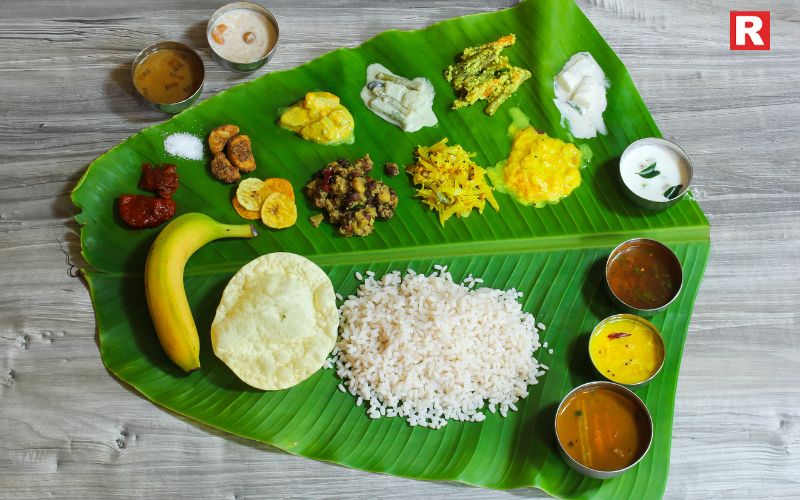
Sadya means “banquet” in Malayalam. Traditionally, it includes between 26 and 30 dishes. Each dish has its place on the banana leaf. The meal is eaten with hands, and the order of serving is fixed.
The beauty of Sadya lies in balance. The mix of sweet, sour, salty, and spicy dishes makes it wholesome. A Sadya usually includes:
Rice served with sambar, rasam, and curries
Rice is the heart of the Sadya. It is always served with sambar, rasam, and light curries. The rice balances every flavor on the banana leaf. Each spoonful brings together tangy, spicy, and earthy notes. This simple grain turns into a grand experience when paired with so many dishes.
Avial, made with vegetables and coconut
Avial is one of the most loved dishes in Sadya. It is made with fresh vegetables like beans, carrots, and drumsticks. Grated coconut and curry leaves add flavor. The dish is light, healthy, and colorful. It shows the beauty of Kerala cooking, where vegetables and spices blend in harmony.
Olan, cooked with ash gourd and coconut milk
Olan is a mild and gentle dish in Sadya. It is cooked with ash gourd and red beans in coconut milk. The taste is soft and soothing. It balances the stronger flavors on the banana leaf. Olan represents the calm side of Kerala food, rich yet very delicate in flavor.
Erissery, made with pumpkin or yam
Erissery is a traditional dish that combines pumpkin or yam with coconut. The vegetables are cooked until soft and then mixed with a fragrant coconut paste. A topping of fried coconut gives it crunch. It has a sweet and earthy taste. Erissery adds warmth and comfort to the Sadya spread.
Banana chips and pickles
Banana chips and pickles are small yet important parts of Sadya. The chips are fried in coconut oil, giving them a crisp bite. Pickles, often made with mango or lime, bring tang and spice. Together, they awaken the taste buds. They prepare the eater for the bigger dishes ahead.
Payasam, the sweet dish that completes the meal
Payasam is always the last and most loved dish in Sadya. It is made with rice, milk, or jaggery. Some versions use vermicelli or lentils. It is rich, creamy, and sweet. Payasam is served in generous portions. It marks the end of the meal and leaves everyone full and happy.
Know more: These 7 Foods Can Help You Cool Your Stomach in Summer
Find Onam Sadya Menus Across India
Here are 41 places across India where you can enjoy an authentic or innovative Sadya this Onam.
Bangalore
- Ente Keralam – Known for its traditional Sadya with 28 dishes, including ada pradhaman and parippu payasam.
- Kappa Chakka Kandhari – Offers a mix of traditional Sadya and modern Kerala flavors. Pre-booking is a must.
- The Paul Hotel – A luxury Onam buffet with live counters and multiple payasam varieties.
- Nandhana Palace – Their Sadya focuses on homely, simple dishes at an affordable price.
Chennai
- Dakshin, Crowne Plaza – Famous for its premium Sadya thali with classic Kerala flavors.
- Benjarong – A Thai restaurant that does a Kerala special Sadya during Onam.
- Savya Rasa – Combines dishes from different South Indian states along with Sadya.
- Kerala Mess – Known for authentic home-style Sadya at pocket-friendly prices.
Delhi NCR
- Mahabelly, Saket – A go-to spot for Kerala food lovers. Their Onam Sadya is among the most popular in Delhi.
- Carnatic Cafe – Offers a mix of Karnataka and Kerala dishes with a Sadya touch.
- The Suryaa, New Friends Colony – A grand buffet-style Sadya with over 30 dishes.
- Delivery by Naivedyam Cloud Kitchen – For those who want Sadya at home, this option is convenient.
Mumbai
- Just Kerala, Andheri – Known for its banana leaf service and authentic Kerala flavors.
- Hotel Deluxe, Fort – A local favorite for Sadya in the city. Affordable and traditional.
- JW Marriott Juhu – Offers a luxury buffet with a modern twist on Sadya.
- Taste of Kerala, Crawford Market – Old-school Kerala restaurant serving Sadya during the festival.
Hyderabad
- Ulavacharu – Mixes Andhra flavors with Onam Sadya for a unique taste.
- Kochi Kitchen, Marriott Hotel – Offers a wide spread of Kerala dishes in a festive buffet.
- Kerala Kitchen, Banjara Hills – Home-style Sadya with payasam combinations.
- The Fisherman’s Wharf – Combines seafood with traditional Sadya for fusion lovers.
Pune
- Kerala Café – Famous for its homely Sadya experience.
- Greenlands Kerala Restaurant – Affordable and authentic Sadya thali.
- JW Marriott Pune – Five-star luxury buffet with Sadya highlights.
- Hotel Malabar – Popular for its simple yet complete Sadya.
Kolkata
- Santa’s Fantasea – Serves Kerala dishes with a Bengali touch.
- Banana Leaf – One of the oldest South Indian restaurants in the city. Offers Sadya during Onam.
- ITC Sonar – Premium Sadya experience in a festive buffet.
- Kerala Food House – Budget-friendly Sadya options.
Also check: 10 Must-Try Gujarati Dishes That Will Delight Your Taste Buds
Goa
- Mum’s Kitchen – Known for seasonal Onam specials.
- Kerala Café Goa – Homely Sadya with payasam varieties.
- Vivanta Goa – Luxury Sadya spread with over 25 items.
Ahmedabad
- Annalakshmi – Famous for traditional South Indian feasts, including Sadya.
- Swad Kerala Restaurant – Authentic Sadya with banana leaf service.
- The Grand Bhagwati – Hosts special Onam buffets.
Kerala
- Paragon, Kozhikode – Legendary restaurant known for Sadya during Onam.
- Ariya Nivas, Thiruvananthapuram – Classic Sadya with more than 30 dishes.
- Malabar Junction, Kochi – Sadya with a fine-dining twist.
- Hotel Sree Krishna, Thrissur – Affordable and widely loved for its Sadya.
Other Cities
- Kerala Mess, Jaipur – Serving homely Sadya in Rajasthan.
- Sadhya by Kerala House, Lucknow – Brings Kerala flavors to the north.
- Kerala Kitchen, Chandigarh – Small outlet known for Onam specials.
Why Sadya Is Popular Outside Kerala
Regional food is gaining importance across India. People want to explore culture through food. Sadya offers a unique chance to experience Kerala’s hospitality and heritage.
Hotels and restaurants are also innovating. Some offer vegan Sadya options. Others bring fusion with seafood or local flavors. Delivery platforms now make it possible to enjoy Sadya at home.
Check more: Six Benefits of Starting Your Day with Okra Water
Top 10 Health Benefits of Eating Dry Fruits Daily
Top 7 Food Safety Practices Every Restaurant Should Follow
Tips to Enjoy Onam Sadya
- Always eat with your hands. It enhances the taste.
- Start from the top left of the banana leaf with salt and pickles. Move clockwise.
- Taste every dish in small portions. The joy lies in balance.
- End with payasam. Many places serve two or three varieties.
Happy Onam!
Onam is more than a harvest festival. It is a time that celebrates togetherness, prosperity, and joy. The grand feast called Sadya brings these feelings to life. Traditionally served on a banana leaf, Sadya is a spread of many dishes, each adding its own taste and meaning. Today, one does not have to be in Kerala to enjoy this experience. From Bangalore to Delhi, from Mumbai to Kolkata, restaurants, hotels, and home kitchens are serving special Onam menus. Some offer lavish buffets in luxury hotels, while others bring homely flavors through small eateries and delivery kitchens. Each menu keeps the spirit of Onam alive in its own way. This year, 41 Sadya menus across India are inviting people to celebrate. Every bite tells a story of tradition and culture. Onam is about sharing food and happiness, and Sadya makes that story complete for everyone who joins the table.

Food is much more than taste. It reflects culture, traditions, and stories passed through generations. Across the world, food festivals bring this idea to life. They are not just about meals but about people, flavors, and shared experiences. At these festivals, local dishes meet global tastes, creating a journey that excites both the palate and the heart. From streets filled with spicy snacks to fine dining under the stars, every festival has its own charm. Travelers and food lovers see these events as more than celebrations. They are windows into communities, their history, and their way of life.
For a foodie, visiting a food festival is like stepping into a new world of flavors. Each bite tells a story, each dish carries heritage, and each event builds memories that last. These festivals are not just about eating but about living an experience. For anyone with a passion for food, these gatherings deserve a place on the travel bucket list. Here are seven of the best food festivals every foodie must attend.
Read more: 7 Types of Whiskies Everyone Should Try Once
12 Delicious High-Protein Foods to Eat Daily for a Healthier You
Find Best Food Festivals You Should Visit
Discover the best food festivals you should visit, where flavors, culture, and community come together for unforgettable culinary experiences.
1. Oktoberfest, Germany

Oktoberfest is the world’s biggest beer and food festival. It takes place in Munich every year, usually in late September and early October. Millions of people come here to enjoy Bavarian food, beer, and culture. What makes it special is the mix of tradition and fun. You can taste sausages, roast chicken, pretzels, and local cheese. Breweries serve beer that is specially brewed for the event. There are also parades, music, and cultural shows. If you are planning to go, book your stay early. The festival gets very crowded. And don’t forget to try the giant pretzel with mustard—it is a classic.
2. La Tomatina, Spain

La Tomatina is one of the most unique food festivals in the world. It takes place in Buñol, a small town near Valencia, Spain. Every year in August, thousands of people gather for the famous tomato fight. The festival is not just about throwing tomatoes. It is about enjoying food, music, and street celebrations. The entire town turns into a party spot. Local stalls sell Spanish tapas, paella, and drinks. It is messy but full of fun. If you go, wear old clothes and be ready to get covered in tomatoes. It is a once-in-a-lifetime experience that no foodie should miss.
3. Taste of London, UK

Taste of London is a festival for those who love fine dining and global cuisines. It happens twice a year in Regent’s Park, London. Top chefs and restaurants set up stalls to showcase their signature dishes. You can taste food from Michelin-starred chefs without spending a fortune at their restaurants. There are live cooking demos, wine tastings, and workshops. You can even meet chefs and learn about the latest food trends. For foodies, this is like a dream come true. It gives you a chance to try different cuisines in one place. If you are planning a London trip, time it with this festival.
Know more: 10 Fastest-Growing Alcohol Brands in India’s HoReCa Sector
4. Pizzafest, Naples, Italy

Naples is the birthplace of pizza. Every year, the city hosts Pizzafest, a celebration of Italy’s most loved dish. Pizza makers from around the world come to showcase their best recipes. From the classic Margherita to modern versions with truffle and seafood, you can taste hundreds of varieties. There are also pizza-making workshops and contests. The smell of fresh pizza fills the air and makes the festival unforgettable. If you love pizza, this is the place to be. The energy of the festival, combined with authentic Italian flavors, makes it one of the most exciting food festivals in the world.
5. Singapore Food Festival

The Singapore Food Festival is a melting pot of Asian flavors. It brings together local street food, fine dining, and modern fusion dishes. It is usually held in July and lasts for two weeks. The highlight is the variety. You can taste dishes from Chinese, Malay, Indian, and Peranakan cuisines. From laksa and satay to chilli crab and dim sum, the options are endless. There are food trails, pop-up kitchens, and cultural shows. Chefs host workshops where you can learn how to cook traditional dishes. If you are a foodie who loves Asian flavors, this festival is a must.
6. National Street Food Festival, Delhi, India
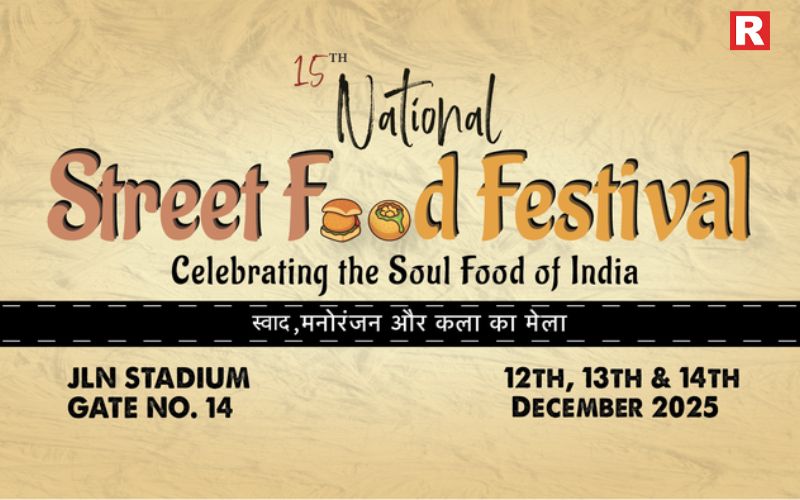
India’s street food is famous across the world. The National Street Food Festival in Delhi brings together the best of it in one place. Vendors from across India come to serve their specialties. You can try chaats from Uttar Pradesh, momos from the Northeast, dosas from South India, and kebabs from Lucknow. The festival is full of colors, aromas, and energy. It is not just about food but also about celebrating India’s diversity. The festival takes place in December at Jawaharlal Nehru Stadium. If you are in Delhi, it is the best way to taste India in one day.
7. Melbourne Food and Wine Festival, Australia

This festival is one of the biggest culinary events in the Southern Hemisphere. It happens every March in Melbourne. The event celebrates both local and international cuisines. There are outdoor banquets, riverbank picnics, and chef-led dinners. Wineries from across Australia bring their best bottles. You can enjoy fresh seafood, barbecue, and desserts prepared by some of the world’s top chefs. The best part is the mix of food and atmosphere. Melbourne’s vibrant culture makes the festival even more special. If you want to enjoy food with a global flair, this is the festival to attend.
Also check: Types of Liquor Licenses: Which One Do You Need for Your Business?
Why You Should Attend Food Festivals
Food festivals are more than just eating. They let you experience the culture of a place. You get to try authentic dishes, meet chefs, and learn about food traditions. They are also a great way to travel differently. Instead of just visiting landmarks, you explore a city through its food.
For foodies, these festivals are unforgettable. They combine flavors, fun, and culture in one place. Whether you love pizza, beer, street food, or fine dining, there is a festival for you.
Check more: Is Beer Good for Your Health? Here's the Truth You Should Know
How to Pair Indian Food with the Right Alcohol: A Desi Guide to Perfect
5 Foods to Avoid for Better Cholesterol
Tips for Attending Food Festivals
- Book tickets and hotels early. These festivals get crowded.
- Go with an empty stomach so you can try more dishes.
- Carry cash, as some stalls may not accept cards.
- Dress comfortably and wear shoes suitable for walking.
- Explore not just food but also music, art, and cultural shows.
Final Thoughts
Food festivals celebrate taste, culture, and community. They bring people together, no matter where they come from, and create bonds over shared meals. For food lovers, these gatherings are more than events; they are dreams turned into reality. Each festival has its own charm. In Delhi, the streets come alive with flavors from every corner of India. In Naples, the aroma of fresh pizza fills the air and reflects the city’s pride. Every festival tells a story of tradition, passion, and the people who keep it alive. These are moments where food becomes more than just nourishment. It becomes a way to connect with others and discover new worlds. For anyone who loves food, attending at least one of these festivals is a must. It is not only about eating but about enjoying the experience, creating memories, and celebrating the joy that food brings to life.

Plant-based eating is no longer just a trend. It has become a lifestyle for millions across the world. More people are turning to vegan diets for health, fitness, and sustainability. At the same time, protein has become a buzzword in food conversations. From athletes to office-goers, everyone is aware that protein is vital for energy, muscle repair, and overall wellness.
But here’s the question many still ask: Can vegans get enough protein?
The answer is a strong yes. Vegan foods today are rich in protein and are as powerful as animal-based sources. The rise of new-age plant proteins has made it easy to get nutrition without compromise. Let us explore the top vegan foods that are high in protein, how they work, and why they are in demand today.
Read more: 12 Delicious High-Protein Foods to Eat Daily for a Healthier You
10 Superfoods That Will Supercharge Your Diet & Make You Feel Like a
Why Vegan & Protein-Rich Foods Are Trending
The demand for vegan high-protein foods is driven by three key reasons: health, sustainability, and accessibility.
- Health benefits: Plant-based proteins lower cholesterol, reduce inflammation, and support better digestion. They also help in weight management and provide long-lasting energy.
- Sustainability: Plant proteins use fewer resources than animal proteins. Producing one kilogram of lentils, for example, uses far less water than producing the same amount of beef.
- Accessibility: From supermarket shelves to food delivery apps, vegan protein options are now widely available. Packaged foods, protein powders, and ready-to-cook meals have made it easier for people to choose vegan protein every day.
The global plant-based protein market is booming. According to industry reports, it is expected to cross $23 billion by 2030, growing rapidly each year. This growth shows how demand is shifting worldwide.
Top Vegan High-Protein Foods
Here is a detailed look at the best vegan foods that are rich in protein. Each of these is not only high in nutrition but also versatile in cooking.
1. Lentils
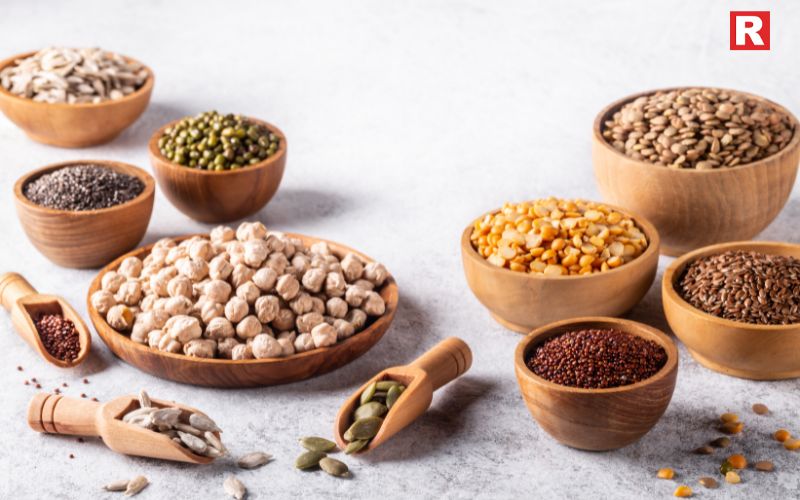
Lentils are among the best plant-based proteins. One cooked cup has about 18 grams of protein. They are also rich in fiber, folate, and iron. These nutrients support digestion and heart health. In India, lentils are eaten daily as dal. They can also be added to soups, curries, or tossed into salads for a filling meal.
- Protein content: About 18 grams per cooked cup.
- Benefits: High in fiber, iron, and folate. They support heart health and aid digestion.
- How to use: Add them to soups, curries, or salads. In India, dal is already a staple, making lentils an easy choice.
2. Chickpeas
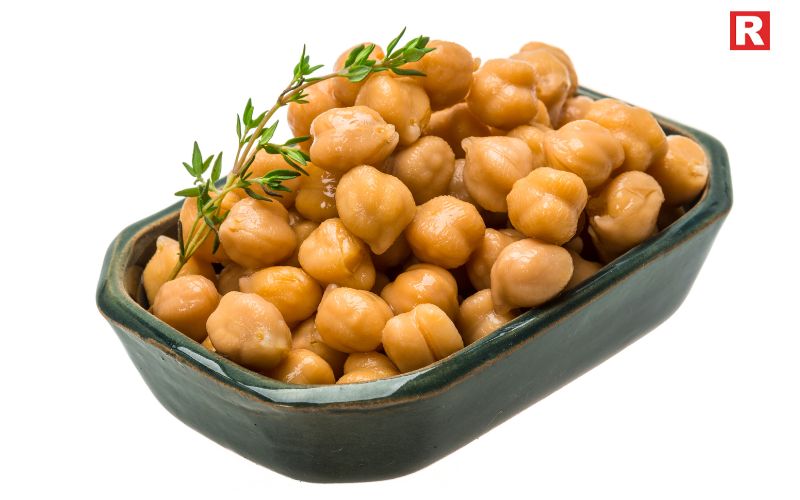
Chickpeas, also called garbanzo beans, are a protein-rich food. A cooked cup provides around 15 grams of protein. They are packed with fiber and manganese, which keep you full and support gut health. Chickpeas are very versatile. They can be blended into hummus, tossed into salads, or added to curries, making them both healthy and tasty.
- Protein content: 15 grams per cooked cup.
- Benefits: Rich in fiber and manganese. They keep you full for longer and support gut health.
- How to use: Blend into hummus, add to curries, or toss into salads.
Know more: Top 10 Health Benefits of Eating Dry Fruits Daily
3. Quinoa
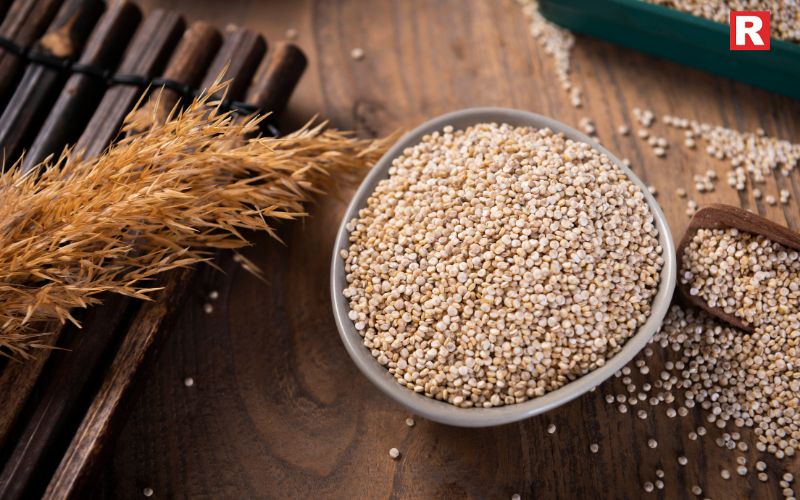
Quinoa is a superfood and a complete protein. One cup of cooked quinoa has 8 grams of protein. It contains all nine essential amino acids, along with magnesium and antioxidants. Gluten-free and light, it is ideal for daily meals. Quinoa works well as a rice substitute, in breakfast bowls, or as a base for fresh salads.
- Protein content: 8 grams per cooked cup.
- Benefits: Gluten-free, rich in magnesium and antioxidants.
- How to use: Cook it as a rice substitute, make breakfast bowls, or use it in salads.
4. Tofu
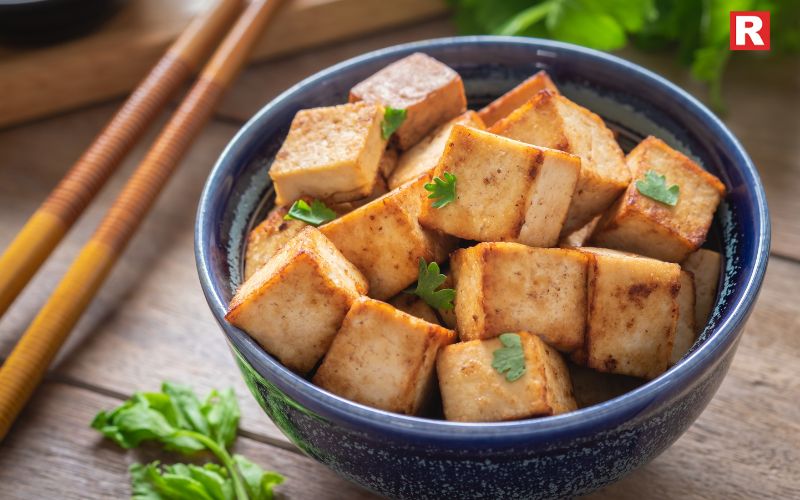
Tofu is made from soybeans and is popular worldwide. A 100-gram serving offers about 10 grams of protein. It is rich in calcium, iron, and amino acids, making it very nutritious. Tofu is known for its soft texture and neutral flavor. It can be grilled, stir-fried, or even blended into smoothies, fitting into many simple recipes.
- Protein content: 10 grams per 100 grams serving.
- Benefits: Contains iron, calcium, and all essential amino acids.
- How to use: Can be grilled, stir-fried, or blended into smoothies. Its neutral taste makes it very versatile.
5. Tempeh

Tempeh is a soy-based food with a firm texture and nutty taste. Every 100 grams has around 19 grams of protein. As a fermented food, it supports gut health while also providing minerals like magnesium and phosphorus. Tempeh is filling, healthy, and versatile. It can be added to stir-fries, sandwiches, or grain bowls for balanced meals.
- Protein content: 19 grams per 100 grams serving.
- Benefits: Fermented, which makes it good for gut health. It is also rich in magnesium and phosphorus.
- How to use: Best used in sandwiches, stir-fries, or grain bowls.
6. Seitan
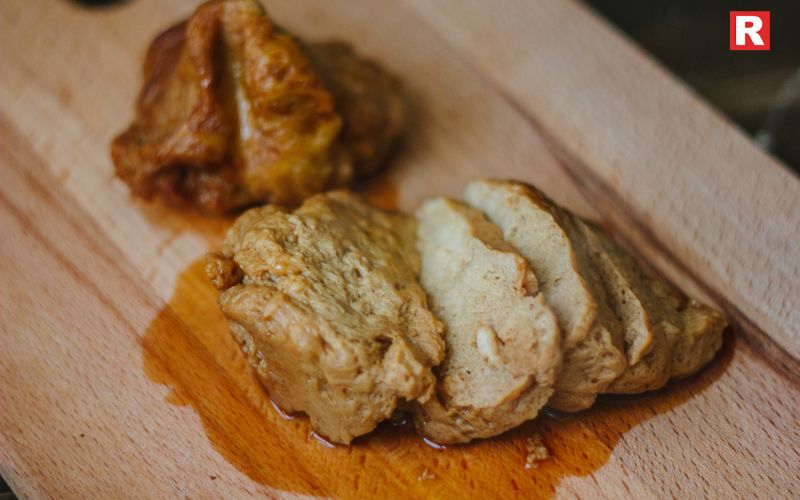
Seitan, often called “wheat meat,” is one of the richest vegan protein foods. A 100-gram serving provides about 25 grams of protein. It is low in fat and has a dense, chewy texture. Seitan works well as a meat substitute. It can be used in curries, wraps, or grilled recipes, making it perfect for hearty meals.
- Protein content: 25 grams per 100 grams.
- Benefits: Dense in protein and low in fat.
- How to use: Works well as a meat substitute in curries, wraps, and even grilled dishes.
7. Edamame
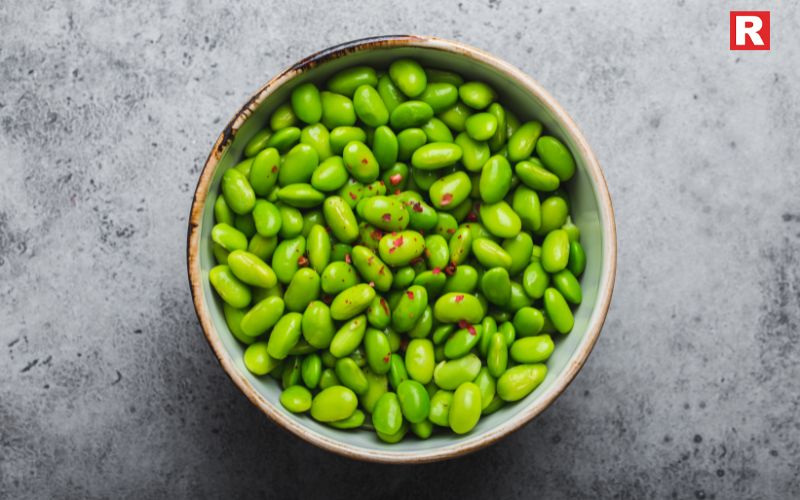
Edamame are young soybeans eaten as a snack or side dish. One cooked cup provides 17 grams of protein. They are rich in iron, vitamin K, and fiber. Edamame is tasty, light, and easy to prepare. Simply boil and season with salt, or add to soups and stir-fries. It is a healthy choice for everyday meals.
- Protein content: 17 grams per cooked cup.
- Benefits: Packed with protein, iron, and vitamin K.
- How to use: Boil and sprinkle with salt, add to stir-fries, or use in soups.
8. Chia Seeds
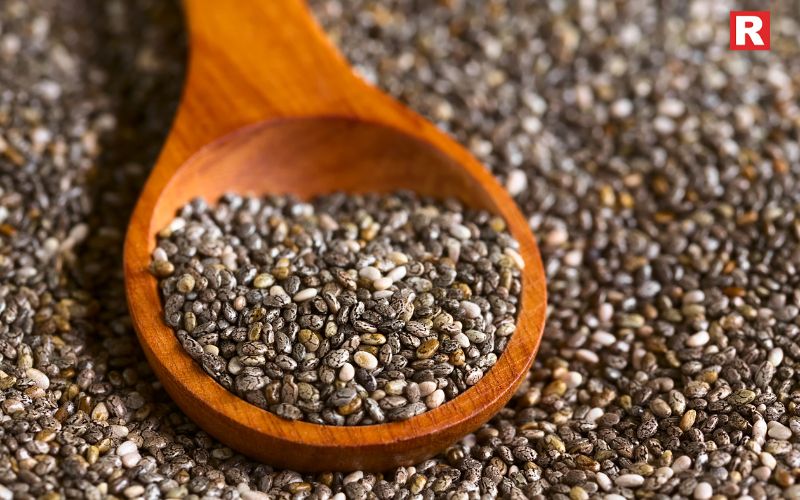
Chia seeds may be small, but they are full of nutrition. Two tablespoons contain about 6 grams of protein. They are also packed with omega-3 fatty acids, calcium, and fiber. Chia seeds help with digestion and provide long-lasting energy. They can be added to smoothies, oats, or made into pudding. Their texture makes them versatile in recipes.
- Protein content: 6 grams per 35 grams (2 tablespoons).
- Benefits: High in omega-3 fatty acids, fiber, and calcium.
- How to use: Add to smoothies, overnight oats, or chia puddings.
Also check: Health Benefits of Quinoa: A Superfood for Every Diet
9. Hemp Seeds
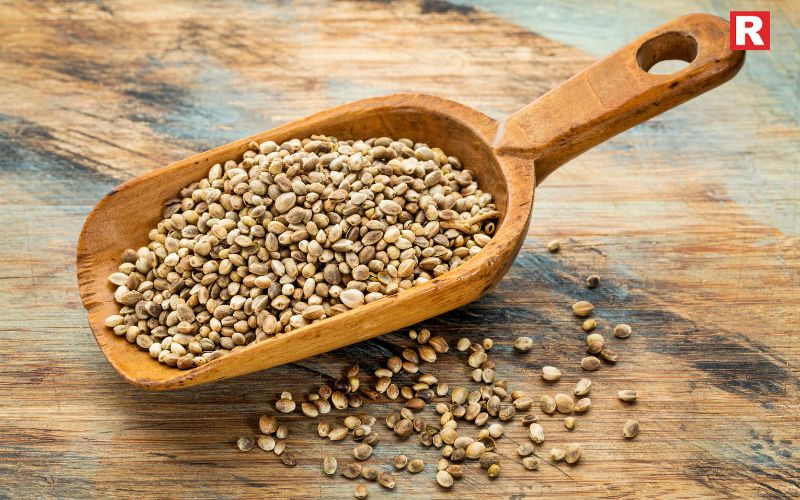
Hemp seeds are gaining attention for their nutrition. Three tablespoons provide about 10 grams of protein. They are a complete protein and contain healthy fats, including omega-3s. Hemp seeds also have essential minerals like magnesium. With their mild, nutty taste, they can be sprinkled on salads, blended into shakes, or added to energy bars and snacks.
- Protein content: 10 grams per 3 tablespoons.
- Benefits: Complete protein with healthy fats and minerals.
- How to use: Sprinkle on salads, blend into shakes, or add to energy bars.
10. Pea Protein Powder
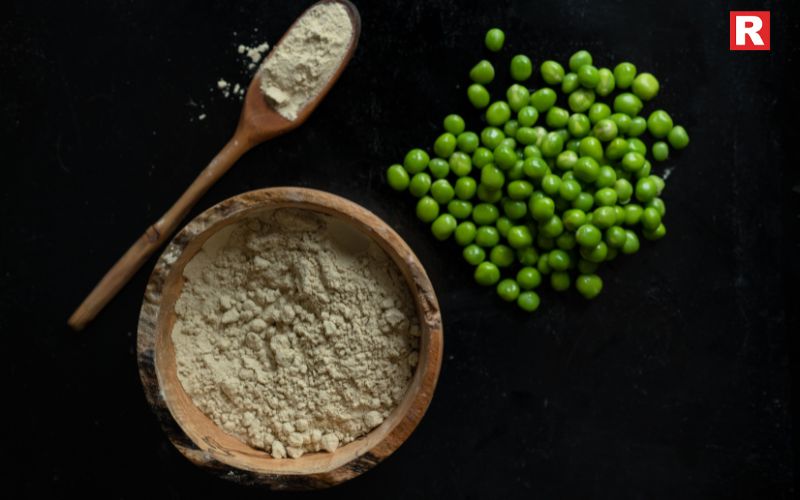
Pea protein powder is now a favorite among fitness lovers. One scoop gives about 20 grams of protein. It is easily digestible, allergen-free, and rich in amino acids. Pea protein is often used in shakes and smoothies after workouts. It can also be added to baking recipes. Simple to use, it is a trusted vegan supplement.
- Protein content: Around 20 grams per scoop.
- Benefits: Easily digestible, allergen-free, and used in vegan protein shakes.
- How to use: Mix with water, add to smoothies, or use in baking.
Easy Ways to Add Vegan Protein
Switching to vegan high-protein foods does not mean complicated cooking. Here are some simple ideas:
- Add lentils or chickpeas to your weekly meal prep.
- Start your day with chia pudding or a quinoa bowl.
- Replace meat with seitan or tempeh in wraps and stir-fries.
- Snack on roasted edamame instead of chips.
- Use pea protein powder for quick shakes after workouts.
Athletes and fitness lovers are increasingly adopting these foods. Plant proteins are easier on digestion, reduce inflammation, and provide long-term health benefits.
Check more: Best International Cuisines You Should Try Once
Best Food Delivery Apps & Quick Commerce Platforms in India
How to Choose the Healthiest Cooking Oil for Your Kitchen
Market & Trend Insights
The rise of vegan high-protein foods is not just about health. It is also about demand and business.
- The global plant-based food market is projected to grow at over 10% every year.
- More brands are introducing high-protein vegan snacks, ready-to-eat bowls, and fortified beverages.
- India is also seeing rapid growth, with urban consumers exploring vegan protein powders, snacks, and traditional pulses in new forms.
This trend is here to stay as more people seek nutrition that is both powerful and sustainable.
Power Pack Meal!
Protein is a vital part of every diet. Many assume it is difficult to get enough protein from a vegan lifestyle, but this is not true. Foods such as lentils, quinoa, tofu, seitan, and chia seeds show that plants can easily meet protein needs. These foods are not limited to athletes or bodybuilders. They are for anyone who wishes to stay healthy, eat clean, and care for the environment. Vegan protein sources are rich, varied, and widely available today. From simple home-cooked meals to modern snacks, there are endless options to choose from. Eating this way supports energy, digestion, and long-term wellness. It also reduces dependence on animal products. Plant-based protein is more than a trend. It is a smart, sustainable choice for the future. Strong, nourishing, and satisfying, it proves that health and taste can go hand in hand.

Food has always been more than just a meal. It is about taste, health, and the story behind every ingredient. In recent years, people have started asking a simple but powerful question: Where does my food come from? This question has given rise to a global dining movement known as farm-to-table. Today, farm-to-table restaurants are not just popular—they have become a lifestyle choice.
Read more: High Protein Indian Meals You Should Try
Delicious High-Protein Foods to Eat Daily for a Healthier You
What is Farm-to-Table Dining?
Farm-to-table means that the food you eat comes directly from local farms. It cuts out long supply chains, middlemen, and heavy processing. The vegetables on your plate are grown nearby. The milk in your coffee is sourced from a farmer close to the city. Even the meat and grains are produced locally. In short, it is food served fresh, natural, and seasonal.
This concept is not new. Farmers and local communities have always shared food. But what makes it trendy today is how restaurants are turning it into an experience. Diners are not just eating; they are connecting with the farmers, the land, and the story behind their meal.
Why Farm-to-Table is Trending Now

Several reasons have made this movement so popular.
- Health-conscious eating: People want food that is fresh, chemical-free, and filled with nutrients. Farm-to-table restaurants promise exactly that.
- Transparency: Customers today value honesty. They want to know how their food is grown and who grows it.
- Sustainability: Reducing the carbon footprint has become a big factor. Eating locally reduces transport and packaging, which helps the planet.
- Social media influence: Farm-fresh meals are colorful, vibrant, and perfect for Instagram. Many young diners discover these restaurants through posts and reels.
In India, for example, cities like Bengaluru, Pune, and Goa have seen a sharp rise in farm-to-table cafés. Travelers often choose such places for a healthier and more authentic food experience.
Know more: 5 Foods to Avoid for Better Cholesterol
The Experience Beyond Just Food
Walking into a farm-to-table restaurant feels different from a regular diner. Many of these restaurants use rustic interiors, wooden tables, and greenery to create a natural vibe. Some even have an attached farm where you can see vegetables being grown.
The menus are often seasonal. A dish you enjoy in winter may not be available in summer. Instead of static menus, chefs create weekly or monthly menus based on what the farmers harvest. This adds freshness and surprise to every meal.
For example, some restaurants in Kerala allow guests to pick fresh herbs from the garden. Others in Maharashtra offer open-kitchen dining where chefs explain the story of every dish. This mix of storytelling and authenticity makes the experience memorable.
Benefits of Farm-to-Table Dining

The rise of farm-to-table is not just about style. It has real benefits.
- Healthier meals: Without long storage, preservatives, and chemical sprays, the food is cleaner and more nutritious.
- Support for local farmers: Diners’ money goes directly to farmers instead of large supply chains. This strengthens local economies.
- Better taste: Freshly picked vegetables and fruits always taste richer. Seasonal menus bring out natural flavors.
- Lower carbon footprint: With fewer trucks and less packaging, the environment benefits.
Many families today prefer dining at these restaurants because it aligns with their values. It is food that feels good, tastes good, and does good.
How Chefs Are Reinventing Menus
Chefs play a big role in this movement. Instead of relying on imported avocados or exotic cheeses, they experiment with local produce. A salad might include jackfruit or moringa leaves instead of foreign ingredients. Drinks may feature kokum, jamun, or tender coconut water. This creativity also makes dining more exciting. Customers discover new flavors that are rooted in their own culture. In fact, some chefs even collaborate directly with farmers to grow specific herbs or vegetables for their dishes.
For example, a restaurant in Goa works with spice farmers to grow rare varieties of chili. Another in Himachal Pradesh serves apples directly from its own orchard. This level of innovation connects diners to the soil in a very personal way.
Also check: The Secret Spice Box: Most Common Spices Chefs Can’t Live Without
The Market and Industry Angle
Farm-to-table is not just a food trend—it is also a business opportunity. Globally, the demand for organic and local food has grown fast. According to industry reports, the organic food market in India is expected to cross USD 2 billion by 2026. A large part of this demand comes from urban millennials and young families.
Restaurants are using farm-to-table as a marketing edge. By highlighting their local sourcing, they attract health-conscious and eco-aware customers. People are willing to pay slightly more for meals that they know are ethical and sustainable.
Quick commerce platforms are also catching up. Many now promote “farm fresh” fruits and vegetables with traceability features. This shows that the trend is moving beyond restaurants into daily groceries as well.
Challenges for Restaurants
While the idea sounds perfect, it does come with challenges.
- Consistent supply: Seasonal farming means that not all ingredients are available year-round. Chefs must constantly adjust menus.
- Higher costs: Organic and small-scale farming can be expensive. Restaurants must balance costs without losing customers.
- Consumer education: Not all diners understand why prices are slightly higher. Some need awareness about the benefits of local sourcing.
Despite these issues, many restaurants are choosing quality over convenience. Their success shows that diners appreciate the effort.
The Future of Farm-to-Table
The farm-to-table movement is here to stay. Experts predict it will grow into new formats. Small cafés, quick-service restaurants, and even cloud kitchens are adopting local sourcing models. Technology will also play a role. Some restaurants already use QR codes on menus where diners can see the exact farm their food came from.
Urban farming is another exciting area. Rooftop farms and hydroponic systems in cities will allow restaurants to grow their own produce. This could solve supply challenges and make farm-to-table even more sustainable.
Globally, this movement reflects a bigger change in how people think about food. It is no longer just about eating—it is about living responsibly and making choices that matter.
Check more: Best International Cuisines You Should Try Once
Pani Puri Has Different Names in Different Indian States—Know Them All
How to Choose the Healthiest Cooking Oil for Your Kitchen
Farm Fresh!
Farm-to-table restaurants are no longer seen as just another dining option. They mark a real shift in the way people think about food, farmers, and the planet. More diners today choose local, seasonal, and sustainable meals because they want food that is fresh, clean, and full of flavor. By doing so, they also support local farmers and reduce the burden on the environment. In a world where speed often matters more than quality, these restaurants bring people closer to nature. They remind us that food is not only about filling plates but about caring for health, community, and the land that feeds us. The rise of farm-to-table dining shows that people now value connection as much as taste, making it one of the strongest and most meaningful food trends of recent times.

Food is more than a daily need; it carries history, culture, and memories across generations. Each cuisine tells a story shaped by tradition, geography, and local ingredients. Some bring comfort and warmth, like a bowl of homemade pasta or bread fresh from the oven. Others bring excitement with bold spices, unusual textures, and flavors that awaken the senses.
Exploring international cuisines allows people to experience the essence of a country without traveling. Italian dishes highlight fresh ingredients and simple cooking, while Indian meals showcase layers of spices and regional variety. Japanese food reflects precision and balance, while Mexican cuisine celebrates color and vibrancy. French cooking emphasizes elegance, while Thai flavors balance sweet, sour, salty, and spicy notes in every bite. Chinese cuisine offers diversity, and Greek food reflects a healthy, Mediterranean lifestyle. Each cuisine is more than taste—it is a connection, heritage, and identity. Trying these dishes opens the door to understanding cultures most deliciously. International cuisines are journeys on a plate, waiting to be explored by anyone curious enough to taste.
Read more: 12 Delicious High-Protein Foods to Eat Daily for a Healthier You
How to Pair Beer with Indian Food: A Desi Guide to Perfect Pints
Why You Should Try International Cuisines
Trying food from different countries is not only about filling the stomach. It is about tasting the world and learning from it. Every dish carries a piece of culture, a tradition, and a story from the place it belongs to. International cuisines open doors to new flavors that may be sweet, spicy, sour, or completely unexpected. They also show how people across the globe use local ingredients in creative ways. For some, it may be a bowl of ramen in Japan, while for others, it could be tacos in Mexico or curries in India. Each bite teaches something new. Dining becomes an adventure, not just a routine. Exploring these cuisines helps people discover variety, respect other cultures, and create memories that last beyond the meal. It is a simple yet meaningful journey through taste.
1. Italian Cuisine: The Taste of Comfort
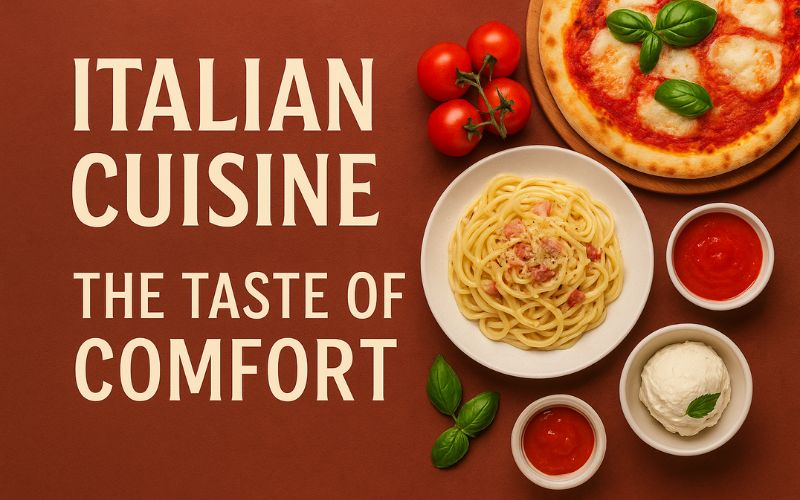
Italian food is one of the most loved cuisines worldwide. It is simple, fresh, and always comforting. The focus is on high-quality ingredients like tomatoes, olive oil, cheese, and fresh herbs. What makes Italian cuisine special is the tradition of family-style eating. Meals are often shared with everyone at the table. If you want authentic Italian flavors, look for restaurants that serve handmade pasta or Neapolitan pizza cooked in a wood-fired oven.
Famous dishes to try:
- Pizza Margherita
- Pasta Carbonara
- Gelato
2. Japanese Cuisine: Art on a Plate
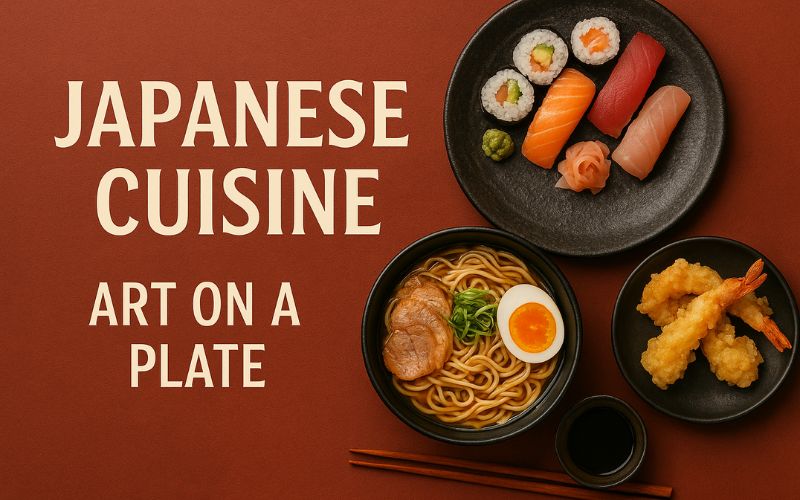
Japanese food is all about balance, precision, and respect for ingredients. The dishes look beautiful and taste even better. It is also one of the healthiest cuisines in the world, with a focus on rice, fish, vegetables, and fermented foods. One interesting fact about Japanese cuisine is the concept of “umami,” also known as the fifth taste. It is that savory flavor you experience in dishes made with soy sauce, miso, or seaweed. Eating Japanese food is like enjoying art, as presentation is just as important as taste.
Famous dishes to try:
- Sushi rolls and sashimi
- Ramen noodles
- Tempura
3. Mexican Cuisine: Bold and Colorful
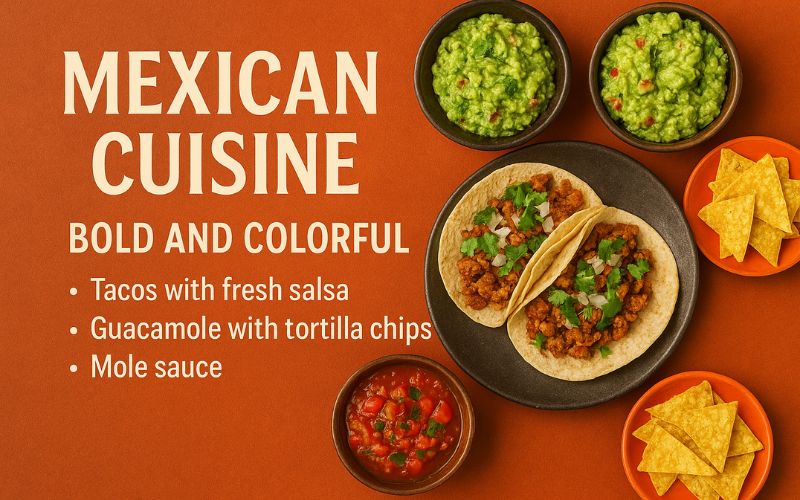
Mexican food is vibrant, flavorful, and filled with spices. It combines native Mesoamerican ingredients like corn and beans with Spanish influences. The result is bold dishes that people across the globe love. What makes Mexican cuisine unique is the use of chili peppers in different forms—fresh, dried, or smoked. Each region in Mexico has its own style of cooking, so you will always find something new to taste. It is also one of the most festive cuisines, often enjoyed during family gatherings and celebrations.
Famous dishes to try:
- Tacos with fresh salsa
- Guacamole with tortilla chips
- Mole sauce
Know more: 5 Foods to Avoid for Better Cholesterol
4. French Cuisine: The Art of Fine Dining
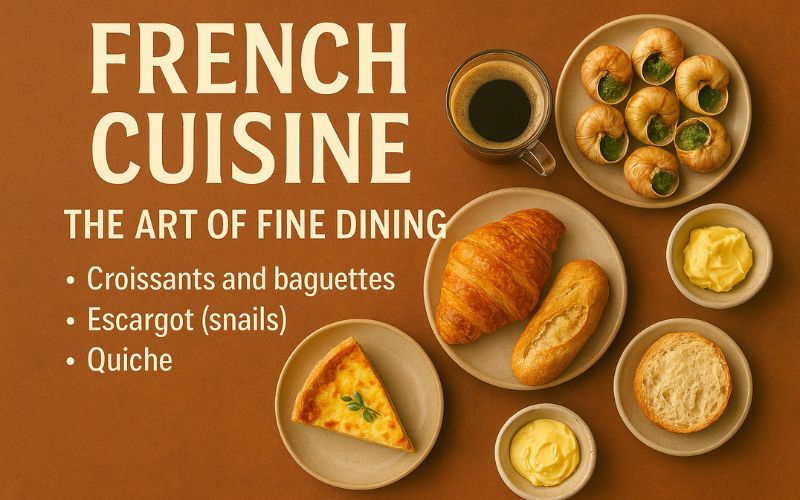
French food is known for its elegance and technique. It is the heart of fine dining and has influenced cooking styles across the world. French chefs focus on sauces, precision, and the best ingredients. French cuisine is not just about expensive dining. Even the simplest French breakfast with bread, butter, and coffee feels special. The tradition of wine and cheese pairing is also a big part of their culture. If you want to experience true French flavors, try visiting a bakery that makes fresh pastries or a bistro that serves classic dishes.
Famous dishes to try:
- Croissants and baguettes
- Escargot (snails)
- Soufflé
5. Thai Cuisine: Sweet, Sour, Spicy, and Salty
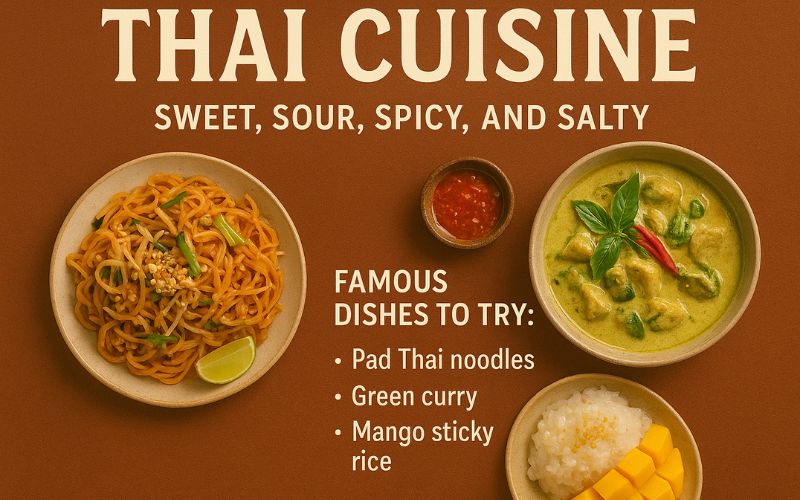
Thai food is loved for its balance of flavors. Every dish combines sweet, sour, salty, and spicy elements, making it a truly exciting cuisine. Fresh herbs and coconut milk are often used to create rich yet refreshing dishes. One special thing about Thai cuisine is how meals are designed to be shared. People usually order different dishes for the table, so everyone can taste a variety of flavors. Street food culture is also very strong in Thailand, making it easy to enjoy authentic dishes.
Famous dishes to try:
- Pad Thai noodles
- Green curry
- Mango sticky rice
6. Chinese Cuisine: Diversity on a Plate
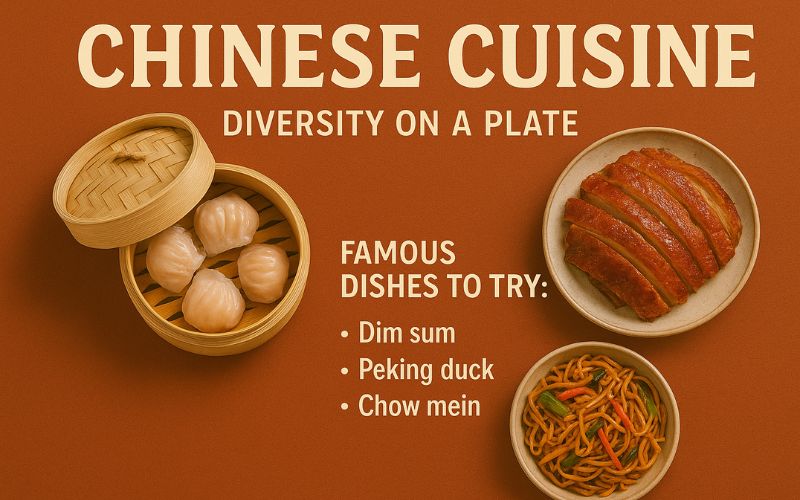
Chinese cuisine is one of the oldest and most diverse in the world. It changes from region to region, offering everything from spicy Sichuan dishes to delicate Cantonese dim sum. Rice, noodles, soy, and fresh vegetables form the base of most meals. An interesting fact is that food plays a huge role in Chinese festivals and family gatherings. Dumplings are often eaten during the Lunar New Year, symbolizing wealth and prosperity. Eating Chinese food is more than just about taste—it is also about tradition.
Famous dishes to try:
- Dim sum
- Peking duck
- Chow mein
Also check: 6 Unexpected Benefits of Eating Jackfruit (Kathal) – Nature’s Spiky Surprise!
7. Spanish Cuisine: Flavor and Festivity
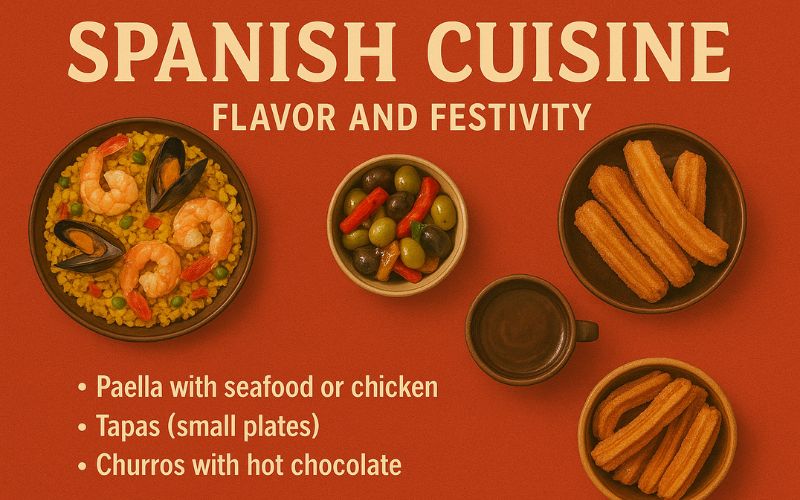
Spanish food is about sharing, community, and enjoying life. It is influenced by Mediterranean ingredients like olive oil, seafood, and fresh vegetables. Meals are often long and social, with many small dishes served together. What makes Spanish cuisine special is the tradition of tapas. These are small bites meant for sharing with friends and family, often paired with wine. It is a style of eating that encourages conversation and connection.
Famous dishes to try:
- Paella with seafood or chicken
- Tapas (small plates)
- Churros with hot chocolate
8. Middle Eastern Cuisine: Rich and Aromatic
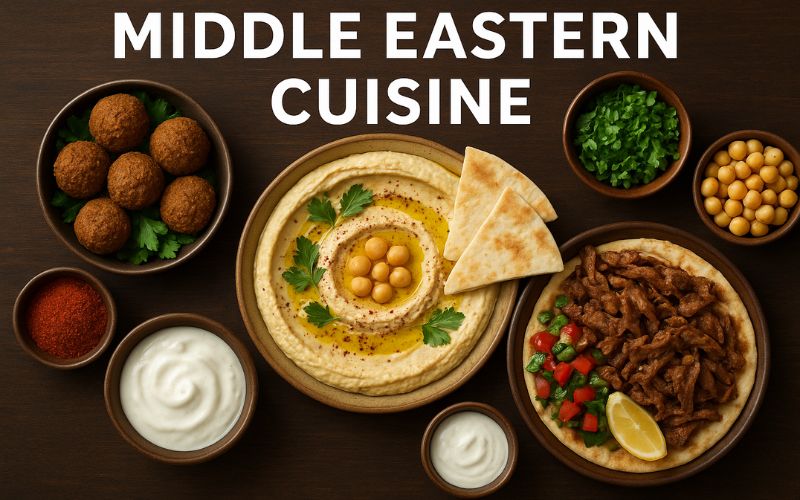
Middle Eastern food is rich, flavorful, and filled with spices like cumin, cinnamon, and sumac. It is also one of the most communal cuisines, where meals are meant to be shared. One highlight of Middle Eastern cuisine is its use of fresh herbs like parsley and mint. Olive oil, chickpeas, and yogurt are also common in many dishes, making them both hearty and healthy. The food culture here is about generosity, with large platters served to everyone at the table.
Famous dishes to try:
- Hummus with pita bread
- Falafel
- Shawarma
9. Greek Cuisine: Healthy and Delicious
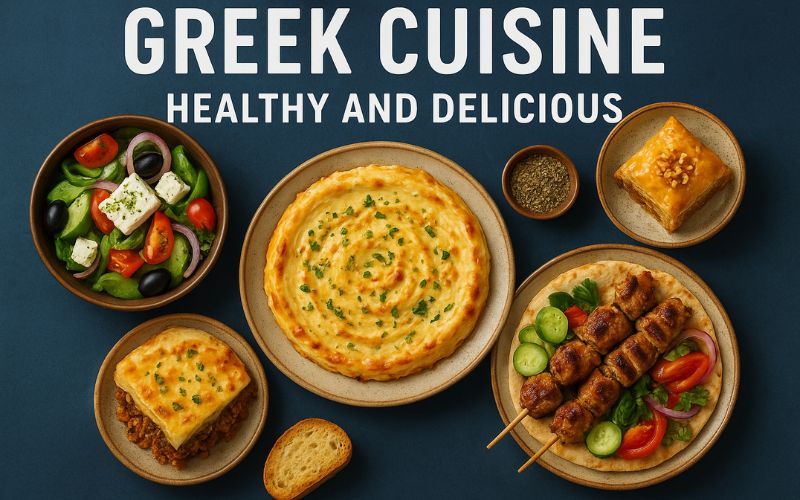
Greek food is known for being part of the Mediterranean diet, which is considered one of the healthiest in the world. It is simple, fresh, and full of flavor. Olive oil, vegetables, herbs, and seafood are at the heart of Greek cooking. Greek cuisine celebrates freshness. Most meals include salads, cheeses, and bread alongside the main dish. It is food that nourishes both the body and the soul, making it a must-try for anyone interested in healthy eating.
Famous dishes to try:
- Moussaka
- Souvlaki (grilled meat skewers)
- Baklava
How to Experience Global Cuisine
- Visit authentic restaurants in your city.
- Try food festivals that focus on global cuisines.
- Experiment with recipes at home.
- Pair your meals with cultural experiences like music or traditions.
Check more: Top 5 States With the Spiciest Food in India
Pani Puri Has Different Names in Different Indian States—Know Them All
Best Food Delivery Apps & Quick Commerce Platforms in India
Final Thoughts
Food speaks to everyone in its own way. It goes beyond taste and becomes a language that connects people across borders. Every cuisine carries history, tradition, and culture within its recipes. Indian curries bring depth with spices and warmth that feel like home. Japanese sushi shows balance, precision, and respect for ingredients. Italian pasta offers comfort with simple flavors made from fresh produce. Each dish reflects the spirit of the people and the land it comes from. Exploring these cuisines is like taking a journey around the world, one plate at a time. It creates experiences that last longer than the meal itself. Memories are built at the table, whether in a busy market or a quiet family kitchen. Food gives more than flavor; it gives a sense of belonging and discovery. The world is full of dishes worth trying, and each one has a story to share.

India’s food and nightlife industry has undergone a dramatic transformation over the last decade, moving from a fragmented, trend-driven sector to one defined by global benchmarks and bold concepts.
India’s restaurant beverage market is projected to cross $500 billion by 2030, fueled by rising incomes, urban lifestyles, and shifting consumer tastes. Driven by premium products, the surge in non-alcoholic options, a thriving café culture among youth, and an increasingly dynamic bar scene.
What’s Pushing the Growth
India’s restaurant landscape is bursting with new opening every day, each striving to stand out with a unique identity and experience. Jairaj Singh Solanki, MD & Co-Founder of Naaya Hospitality began his journey in 2012 with Asian House, one of India’s earliest delivery brands that introduced premium packaging and restaurant-quality food to homes. This led to Sushi House, Amma House, and Masala House.
In 2019, he unveiled Lair in New Delhi, launched just before the pandemic; the venture faced daunting challenges, yet survived and flourished. Today, Lair ranks among India’s most celebrated bars, with a coveted place on Asia’s 50 Best Bars list—a testament to Solanki’s conviction in vision, resilience, and team-driven success.
Pawan Shahri, CEO & Founder, Chrome Asia Hospitality started his journey began Mumbai’s nightlife, where he ran Chrome Nightlife as a college student, curating events and bringing in international artists. What started as a side hustle quickly grew into his first real lessons in branding and hospitality.
By graduation, he pivoted to digital, launching Chrome Communications, one of India’s early restaurant marketing agencies. In just four years, it scaled to 45 employees and 80 clients nationwide, eventually paving the way for Chrome Hospitality.
Today, the company operates 10 units across Mumbai and Goa, including a boutique hotel. Its flagship, Late Checkout, embodies Shahri’s evolved vision—intimate, craft-driven, and people-focused.
Shared Values, Distinct Paths
The vision should be clear from design and menus to team building and operations. Solanki emphasizes on persistence: concepts must be seen through even when they go against prevailing trends. Shahri pointed that the industry is no longer about celebrating brands alone but about the individuals who bring them to life.
The Five Pillars of a Successful Venue
1. Concept – a clear and original idea.
2. Location – the right setting to support the concept.
3. Team – people aligned with the vision.
4. Product and Service – consistently strong food, drinks, and hospitality.
5. Business Discipline – a sharp handle on financials and operations.
“The strength of the concept comes first, even before location,” noted Solanki. Shahri added, “Location can make or break a project, no matter how good the idea. Both agree, however, that without a strong team and financial clarity, no vision can last.”
Leading With People
Personal interviews of employees, learning every team member’s name, and creating a family-like culture where individuals feel invested in the company’s growth is important for long run.
“Expansion with discipline is needed, treating each new outlet as a separate responsibility rather than a number on a growth chart. Focusing on nurturing teams with long-term consistency in mind helps,” pointed Shahri.
As India’s dining culture matures, opportunities for bold concepts becomes a new norm. Customers expect international standards, are willing to explore frequently, and actively seek out new experiences.

If there is one street food that brings people together across India, it is pani puri. The small puri, crisp and hollow, breaks with a crack as it is filled with spicy, tangy water. The first bite bursts with flavor, and for many, it is more than just food—it is an experience tied to childhood, friends, and evenings at roadside stalls. What makes this snack even more special is how it changes from place to place.
In Delhi, it is known as golgappa, stuffed with potatoes and chickpeas, and dipped in tangy tamarind water. In Kolkata, the same snack is called phuchka, made with spiced potatoes and a sharp hint of mustard oil. In Mumbai, it takes the name pani puri, often filled with ragda, giving it a unique twist. Odisha and Chhattisgarh call it gup chup, while in Rajasthan it is patashi, sometimes flavored with fennel seeds. Different names, different flavors, but one emotion. Wherever it is eaten, pani puri remains India’s most loved street food.
Read more: 12 Delicious High-Protein Foods to Eat Daily for a Healthier You
Best Food Delivery Apps & Quick Commerce Platforms in India
Why So Many Names?
The many names of pani puri come from the diversity of India. Each state has its own language, traditions, and eating style. Food often reflects local culture, and this snack is no different. Over the years, the same round puri has been filled and flavored in many ways to suit regional tastes. In the north, people enjoy golgappas with spicy water and chickpeas. In the east, phuchkas are sharper, with potatoes, tamarind, and mustard oil. In the west, pani puri comes with ragda, making it more filling. In Rajasthan, patashi has a sweeter touch with fennel seeds. Odisha and Chhattisgarh prefer gup chup, with light and tangy flavors. The base remains the same—crispy puris dipped in flavored water—but the experience changes as one travels from state to state. This variety shows how a single snack can unite people while still carrying the unique taste of each region.
1. Pani Puri – Maharashtra, Gujarat, Madhya Pradesh
The most common name you will hear in western India is “Pani Puri.” If you walk through the streets of Mumbai, Ahmedabad, or Indore, vendors will serve you pani puri with a smile and a lot of water-filled puris. Mumbai-style pani puri is different because it often comes with ragda, a white pea curry. This makes it more filling and slightly different in taste compared to other states. In Gujarat and Madhya Pradesh, the water usually has a tangy flavor made with tamarind, mint, and a touch of hing (asafoetida). For many people growing up in Mumbai, pani puri is more than just food. It is a memory of standing in line with friends, asking the vendor for “thoda aur teekha” (make it spicier), and enjoying every bite.
2. Golgappa – Delhi, Haryana, Punjab, Uttar Pradesh, Bihar
In the northern belt of India, this snack is known as “Golgappa.” The name itself explains it well: “gol” means round, and “gappa” means to eat in one bite. That is exactly how this snack is enjoyed—whole, in one go. Delhi’s golgappas are famous for their spicy and tangy water. The stuffing is usually mashed potatoes and chickpeas. The water has a perfect balance of tamarind and mint, making it refreshing yet fiery. If you have ever been to a wedding in Delhi or Punjab, you will notice that golgappa stalls are the most crowded. Guests wait in line for their turn, and the vendor keeps asking, “Kitna teekha?” (How spicy?). The excitement of eating golgappas in Delhi is unmatched.
3. Phuchka – West Bengal, Assam, Jharkhand
Travel to the east, and you will meet the “Phuchka.” Kolkatans swear that their phuchka is the best in India. What makes it unique is the stuffing. Instead of chickpeas, it is made with mashed potatoes mixed with black salt, green chilies, and tamarind pulp. Another special ingredient in Kolkata’s phuchka is mustard oil. That small drizzle of oil gives the snack a sharp and fiery punch, something you will not find in pani puri from other states. People from Bengal often argue that phuchka tastes better than golgappa. If you have grown up in Kolkata, you probably have a favorite phuchkawala near your home, and no other version tastes the same.
Know more: 5 Foods to Avoid for Better Cholesterol
4. Puchka – Odisha
In Odisha, the name changes slightly to “Puchka.” The style of serving is similar to Bengal, but the flavors are milder. The water is tangy but not as spicy, making it easier for people who prefer a lighter taste. If you have visited Puri beach, you will know how special puchka tastes while watching the waves. Vendors often carry their baskets right on the beach, and eating puchkas there is an experience you will always remember.
5. Gup Chup – Odisha, Chhattisgarh, Parts of Jharkhand and Bihar
In some parts of eastern and central India, the same snack is called “Gup Chup.” The name is believed to come from the sound you make when you eat it—gup chup in one bite. Compared to phuchka, gup chup usually has a lighter stuffing. The focus here is on the flavored water, which is often served in different varieties. Some vendors even serve sweet water along with spicy ones, giving you options to balance the flavors.
6. Pakodi – Madhya Pradesh, Rajasthan, Parts of Gujarat
In Madhya Pradesh and some parts of Rajasthan and Gujarat, pani puri is also known as “Pakodi.” Here, the puri itself is referred to as pakodi. The stuffing is simple, usually with potatoes and chickpeas, but sometimes vendors add sev and onions for a crunchy twist. The taste is lighter compared to Mumbai’s ragda version or Kolkata’s mustard-filled one, but it has its own loyal fans.
7. Patashi – Rajasthan, Parts of Uttar Pradesh
In Rajasthan and some areas of Uttar Pradesh, people call it “Patashi.” The taste here is slightly different because the water often has fennel seeds (saunf) in it. This gives the patashi a sweet aftertaste along with the spice. The puris are slightly bigger, and the experience is more about enjoying the flavored water than the stuffing. In many small towns of Rajasthan, patashi stalls are where people gather in the evenings to chat and eat together.
Also check: 5 Ways to Use Garden Cress Seeds (Halim) for Stronger Hair and Bones
Regional Taste Differences
- Mumbai’s pani puri is filling with ragda.
- Delhi’s golgappa is spicy and tangy with chickpeas.
- Kolkata’s phuchka is sharp with mustard oil.
- Odisha’s puchka is milder and lighter.
- Rajasthan’s patashi has a sweet touch of fennel seeds.
These differences show how one snack can take so many forms, yet still bring the same joy.
A Global Superstar
Pani puri is no longer limited to India. Many Indian restaurants abroad serve it with unique twists. In London and New York, you will find pani puri served as fine dining appetizers. Some chefs experiment with vodka pani puri, chocolate pani puri, and even dry ice for special effects.
Despite all these modern changes, the joy of eating pani puri from a roadside stall in India remains unmatched.
Check more: 7 Healthy Chicken Dishes to Maintain Your Diet
Rain Meets Refinement: 7 Premium Whisky Cocktails to Sip This Monsoon
Top 7 Food Safety Practices Every Restaurant Should Follow
Street Treat!
Call it pani puri, golgappa, phuchka, puchka, gup chup, pakodi, or patashi—this snack is India’s true street food hero. No matter which state you visit, you will find a version of this snack waiting for you. Each name carries its own story, but the feeling remains the same. For many, it is not only a snack but a piece of memory. It is the taste of school days, when friends shared a plate after class. It is the joy of family evenings, standing together at a busy stall. It is the comfort of asking the vendor for “one more, extra spicy.” Travel to any state, and a version of this snack will always be waiting. The stuffing may change, the water may taste different, but the love for it never fades. It is a simple puri filled with flavors, yet it carries emotions. Wherever it is eaten, it reminds people of joy, togetherness, and shared moments.

Cooking oil is more than just something to fry or sauté food. It has a direct impact on health, energy, and the taste of daily meals. Many households still choose oil out of habit or because of price, but not every oil works the same way. Some oils provide nutrients and protect the heart, while others may increase health risks if used every day. Oils differ in how they react to heat, their fat composition, and the benefits they bring. Olive oil, for example, is rich in healthy fats but is not ideal for deep frying. Coconut oil has a unique flavor and certain benefits but is high in saturated fat. Mustard oil has been a trusted choice in Indian kitchens for generations, while sunflower oil remains popular for its neutral taste and high smoke point. Shoppers often feel confused when facing a wide range of bottles lined up on store shelves. Knowing how each oil works and where it fits best in cooking can make choosing easier and healthier for the whole family.
Read more: 12 Delicious High-Protein Foods to Eat Daily for a Healthier You
High Protein Indian Meals You Should Try
Why Cooking Oil Matters
Cooking oil is more than just fat. It carries a mix of fatty acids, vitamins, and natural compounds that affect the body in many ways. The choice of oil can change cholesterol levels, influence heart health, and even control inflammation. Not all oils are meant for the same kind of cooking. Some oils, such as sunflower or groundnut oil, can handle high heat, making them suitable for deep-frying. Others, like extra virgin olive oil or flaxseed oil, lose their nutrients when heated too much and work better in salads or light cooking. Each oil has its own strength, whether it is flavor, nutrition, or heat stability. Choosing the right oil for the right dish can make food taste better while supporting overall health. For any kitchen, knowing when to use which oil is a simple but powerful step toward healthier eating and balanced cooking habits.
Key Factors to Look for in Cooking Oil

Before picking a bottle of oil, check these factors:
- Smoke Point – This is the temperature at which oil starts burning and releasing harmful compounds. High smoke point oils are good for frying, while low smoke point oils are better for salad dressings.
- Fat Composition – Oils contain saturated, monounsaturated (MUFA), and polyunsaturated fats (PUFA). Unsaturated fats are considered heart-healthy. Avoid oils with trans fats.
- Nutritional Value – Some oils are rich in antioxidants, omega-3, and vitamins like E and K. These give extra health benefits.
- Flavor – Some oils like mustard or coconut add strong flavors, while sunflower or rice bran oil is neutral.
- Health Goals – If you are managing weight, cholesterol, or diabetes, your choice of oil should match your health needs.
Know more: 6 Benefits of Drinking Black Coffee
Popular Oils in India: Pros and Cons
Here’s a breakdown of the most commonly used oils, with details to help you decide.
1. Olive Oil

Olive oil is packed with antioxidants and healthy fats that support heart health. It works best for salads, sautéing, and Mediterranean recipes. With its smooth taste, it adds freshness to dishes. However, it is not ideal for deep frying, as it loses nutrients at high heat.
- Best for: Salad dressings, sautéing, Mediterranean dishes.
- Smoke Point: Low to medium.
- Why it’s good: Rich in antioxidants and monounsaturated fats. Great for heart health.
- Watch out: Not ideal for deep frying. Extra virgin olive oil loses nutrients at high heat.
2. Coconut Oil

Coconut oil is popular in South Indian cooking and baking. It contains MCTs, which may boost metabolism and provide quick energy. Its flavor adds richness to food. While useful in certain dishes, it is high in saturated fats and should be used carefully, especially for cholesterol-conscious people.
- Best for: Baking, South Indian cooking, some Asian dishes.
- Smoke Point: Medium.
- Why it’s good: Contains medium-chain triglycerides (MCTs) that may support metabolism.
- Watch out: High in saturated fats. Use in moderation if you have cholesterol issues.
3. Sunflower Oil

Sunflower oil is a common choice in many Indian homes because of its neutral taste. It is rich in vitamin E and holds up well during frying. With a high smoke point, it is ideal for everyday cooking. However, its omega-6 content can cause imbalance if consumed too much.
- Best for: Deep frying, daily Indian cooking.
- Smoke Point: High.
- Why it’s good: Neutral taste, vitamin E rich.
- Watch out: High in omega-6, which can cause imbalance if consumed in excess.
4. Mustard Oil

Mustard oil has been a staple in Indian kitchens for generations. Its pungent flavor adds depth to curries, pickles, and stir-fries. It is rich in healthy fats like MUFAs and omega-3. The oil is excellent for heart health but may not suit those who prefer milder flavors.
- Best for: Indian curries, pickles, stir-fries.
- Smoke Point: High.
- Why it’s good: Rich in MUFAs and omega-3. Traditionally used in Indian kitchens for generations.
- Watch out: Strong pungent flavor, may not suit all dishes.
5. Groundnut (Peanut) Oil

Groundnut oil, also known as peanut oil, is valued for its nutty taste and stability in high heat. It is a good mix of MUFAs and PUFAs, making it suitable for frying. Popular in Indian cooking, it is not recommended for people with peanut allergies due to health risks.
- Best for: Frying, stir-frying, and deep-frying.
- Smoke Point: High.
- Why it’s good: Good balance of MUFA and PUFA. Has a nutty flavor.
- Watch out: Not suitable for people with peanut allergies.
6. Avocado Oil

Avocado oil is a nutrient-rich option with a very high smoke point. It works well for grilling, frying, and also salad dressings. Packed with MUFAs, vitamin E, and antioxidants, it supports heart health. Although versatile and healthy, it remains expensive and less accessible in most Indian markets.
- Best for: High-heat cooking, salads, marinades.
- Smoke Point: Very high.
- Why it’s good: Rich in MUFAs, vitamin E, and antioxidants.
- Watch out: Expensive and not widely available in India.
Also check: 5 Foods to Avoid for Better Cholesterol
7. Ghee

Ghee is a traditional favorite in Indian kitchens, known for its aroma and rich taste. It enhances parathas, sweets, and tadkas. With vitamins A, D, and E, it provides nourishment along with flavor. Though nutritious, it is high in saturated fat, so moderation is important for long-term health.
- Best for: Indian sweets, parathas, and tadkas.
- Smoke Point: High.
- Why it’s good: Contains vitamins A, D, and E. Traditional and aromatic.
- Watch out: High in saturated fat. Use sparingly if you have cholesterol issues.
Tips for Using Oils the Healthy Way
- Do not stick to just one oil. Rotate between two or three oils to get varied nutrients.
- Cold-pressed oils are better for nutrition because they are less processed.
- Store oils in dark bottles away from heat to preserve quality.
- Use measuring spoons while cooking. Even healthy oils are calorie-dense, and too much can lead to weight gain.
- Avoid reusing oil for deep frying multiple times. It creates harmful compounds.
Check more: 5 Ways to Use Garden Cress Seeds (Halim) for Stronger Hair and Bones
Top 5 States With the Spiciest Food in India
A Guide to Different Breads and Their Nutritional Value
Quick Guide: Which Oil for Which Dish?
- Deep frying → Groundnut, Rice Bran, or Sunflower Oil
- Salad dressings and drizzling → Olive Oil or Flaxseed Oil
- Baking → Coconut Oil or Avocado Oil
- Everyday sautéing → Olive Oil or Mustard Oil
- Indian curries and tadka → Mustard Oil or Ghee in small amounts
Final Thoughts
The healthiest cooking oil is not about finding one perfect choice but about using the right oil for the right dish. Olive oil works well for salads and light cooking but does not suit deep frying. Mustard oil is valued for its sharp taste and heart-friendly fats, making it ideal for curries. Groundnut oil is stable at high heat and reliable for frying. Coconut oil and ghee carry strong flavors and traditional appeal, but both are rich in saturated fats and should be used in small amounts. No single oil can provide all benefits, so a mix of two or more oils in the kitchen is a better approach. Choosing oils with care ensures balanced nutrition, enhances flavor, and supports long-term health.

Everyone goes through days when the mood feels low and energy drops. People often look for comfort in music, movies, or even a walk outside to lift their spirits. While these things help, many forget that food can also shape the way a person feels. What goes on the plate does not just fill the stomach, it can also influence the mind. Scientists have found that food plays a role in brain health and emotional balance. Certain foods can trigger the release of chemicals like serotonin and dopamine.
These chemicals are closely linked to feelings of happiness, calmness, and motivation. When the body gets the right nutrients, the brain responds in a positive way. Eating the right foods at the right time can act like a natural support system. It helps reduce stress, improves focus, and adds energy to the day. A small change in diet can create a big difference in mood. Instead of only seeking comfort outside, one can find real happiness and balance by making mindful choices in daily meals.
Read more: 12 Delicious High-Protein Foods to Eat Daily for a Healthier You
5 Foods to Avoid for Better Cholesterol
Top Mood-Boosting Foods for Positivity, Calm, and Energy

Let’s explore the top mood-boosting foods that can make you feel more positive, calm, and energized.
1. Dark Chocolate—The Instant Happiness Bite
Think about the last time you had a piece of chocolate. That small bite probably gave you a rush of comfort and joy. This isn’t just your imagination—dark chocolate really does boost happiness. It is packed with antioxidants that reduce stress in the body. It also helps release serotonin and endorphins, the brain chemicals linked to good moods. The richness of dark chocolate makes you feel satisfied, which is why even a small piece can brighten your day. Go for chocolate with at least 70% cocoa to get the best benefits without too much sugar.
2. Bananas—Nature’s Mood Stabilizer
Bananas are not just a quick snack; they are also mood stabilizers. They are rich in vitamin B6, which helps your brain produce serotonin, the chemical that keeps you happy and calm. They also contain natural sugars and fiber, which give you steady energy. Unlike sugary snacks that cause sudden spikes and crashes, bananas release energy slowly, keeping your mood balanced. Next time you feel low in the afternoon, pick up a banana instead of processed snacks.
3. Berries—The Little Stress Busters
Strawberries, blueberries, and raspberries are more than just tasty fruits. They are packed with antioxidants that fight inflammation in the body. Studies link inflammation to higher risks of stress and depression. Berries are also full of vitamin C, which reduces stress hormones. Adding a handful of berries to your breakfast or smoothie is one of the easiest ways to support your mood. If fresh berries are expensive, frozen ones work just as well.
4. Fatty Fish – The Calm Creator
Salmon, mackerel, sardines, and tuna are excellent for your brain. They are rich in omega-3 fatty acids, which play a big role in brain function. Omega-3s have been shown to reduce symptoms of anxiety and depression. Your brain is made up of nearly 60% fat, and omega-3s are the healthy fats it needs to work properly. Eating fish two to three times a week can help you feel calmer and more focused. If you do not eat fish, you can get omega-3s from walnuts, chia seeds, and flaxseeds.
5. Nuts and Seeds—The Tiny Powerhouses
When you need a quick snack that lifts your mood, nuts and seeds are perfect. Almonds, walnuts, pumpkin seeds, and sunflower seeds are rich in magnesium. Low magnesium levels are linked to stress and fatigue. They also contain healthy fats and protein, which give steady energy and keep your blood sugar balanced. Keeping a small handful of mixed nuts in your bag can save you on busy days when you need a boost.
6. Green Leafy Vegetables—The Brain Boosters
Spinach, kale, and other leafy greens are often called superfoods. They are rich in folate, a nutrient that helps your brain produce serotonin. Without enough folate, you may feel tired or irritable. They also contain iron, which improves oxygen flow to your brain. Better oxygen means more energy and sharper focus. Adding greens to your meals regularly can improve both your physical health and your mental well-being. Try adding spinach to your morning omelet or blending kale into your smoothie for an easy start.
7. Fermented Foods—The Gut Healers
There is a saying: “A healthy gut means a happy mind.” Fermented foods like yogurt, kimchi, sauerkraut, and kombucha prove this true. These foods are full of probiotics, which are good bacteria for your gut. A healthy gut helps regulate mood because the gut and brain are closely connected. Research shows that poor gut health is linked to higher risks of anxiety and depression. Eating yogurt with live cultures or adding fermented foods to your meals can make a difference to your mood over time.
Know more: Top 10 Calcium-Rich Foods for Stronger Bones
8. Coffee and Green Tea—The Energy Lifters
For many people, a cup of coffee in the morning feels like a boost of happiness. Coffee contains caffeine, which increases dopamine levels in the brain. This gives you energy, improves focus, and can make you feel more positive. Green tea, on the other hand, has both caffeine and an amino acid called L-theanine. This combination keeps you calm while still alert. That’s why green tea is often recommended for people who want focus without feeling jittery. The key is balance. Too much caffeine can cause anxiety, so one to two cups a day is enough.
How These Foods Work Together
You may notice that many of these foods work on similar brain chemicals. That’s because mood is not controlled by one factor alone. Serotonin, dopamine, gut health, and blood sugar all work together.
When you combine these foods in your daily meals, you get a balanced effect. For example:
- A breakfast of yogurt with berries.
- A snack of bananas with peanut butter.
- A dinner of salmon with leafy greens.
These simple combinations give you steady energy and a positive mood throughout the day.
Also check: Best Pre-Workout & Post-Workout Foods for Energy
How Food Influencers Are Changing the Way We Eat
Vegan Food Revolution: 6 Dishes Everyone Should Try in 2025
Tips to Maximize Happiness from Food
Eating mood-boosting foods is not just about what you eat but also how you eat. Here are some simple tips:
- Do not skip meals. Low blood sugar makes you tired and irritable.
- Drink enough water. Dehydration can affect mood and concentration.
- Avoid too much processed food. They may give short bursts of energy but leave you feeling drained.
- Eat mindfully. Slow down and enjoy your meals—it helps your body absorb nutrients better.
Happiness on Your Plate
The kitchen is often the simplest place to find comfort. Instead of waiting for sadness or stress to fade, a person can turn to food as a daily step toward better mood and balance. Dark chocolate brings instant joy with its rich taste. Bananas and berries offer steady energy that lasts longer than processed snacks. Fish, nuts, and leafy greens work deeper, supporting brain health and keeping the mind sharp. Fermented foods like yogurt and kimchi strengthen the gut, which is closely tied to emotional well-being. Coffee and green tea, when enjoyed in moderation, give a calm lift and help with focus. These small food choices can make a real difference. Happiness does not always need big changes—it can often be found right on the plate.

Strong bones are the base of a healthy life. They carry the body, keep their posture straight, and protect the vital organs. Bones also give strength for daily movement and activity. But like every part of the body, bones need proper care. Calcium is one of the most important nutrients for this. Almost all the calcium present in the body, nearly 99 percent, is stored in the bones and teeth. It keeps them firm and prevents damage. Without enough calcium in the diet, bones may lose strength and become brittle.
This can lead to a higher risk of fractures and bone-related diseases. To keep bones strong, a diet rich in calcium is necessary. Foods like milk, greens, nuts, seeds, and grains are natural sources of calcium. Vitamin D and minerals such as magnesium also play a role in helping the body absorb calcium properly. Including these nutrients in everyday meals supports bone growth, strength, and long-term health. A simple change in diet can protect bones and keep the body active for years to come.
Read more: 12 Delicious High-Protein Foods to Eat Daily for a Healthier You
5 Foods to Avoid for Better Cholesterol
Why Calcium Is Essential for Bone Health
Calcium is an essential nutrient for bone health. It helps children and teenagers build strong bone density during their growing years. As people get older, calcium continues to play a key role by preventing bone loss and maintaining strength. When the body does not receive enough calcium from food, it begins to draw calcium from the bones. This gradual loss makes bones weaker and fragile over time. Without proper intake, the risk of conditions like osteoporosis increases. A steady supply of calcium through daily diet is necessary to keep bones strong, healthy, and able to support the body well.
The daily calcium requirement depends on your age:
- Children (4–8 years): 1,000 mg
- Teenagers (9–18 years): 1,300 mg
- Adults (19–50 years): 1,000 mg
- Women above 50 and men above 70: 1,200 mg
Meeting these needs through food is the best way to maintain healthy bones.
Know more: Best Pre-Workout & Post-Workout Foods for Energy
Top 10 Calcium-Rich Foods for Stronger Bones

Here are the best foods that provide high calcium levels naturally.
1. Milk and Dairy Products: Milk is one of the most common and effective sources of calcium. A single glass of milk contains around 300 mg of calcium. Dairy products like yogurt, paneer, and cheese are also rich in calcium. Yogurt has the added benefit of probiotics, which improve digestion. Cheese is a concentrated source of calcium, but it should be consumed in moderation because of its high fat content. If you start your day with a glass of milk or add yogurt to your lunch, you are already supporting your bones.
2. Leafy Greens: Green vegetables such as spinach, kale, and broccoli are loaded with calcium. A single cup of cooked spinach provides almost 250 mg of calcium. Broccoli is also a good option as it is easier to digest. Leafy greens are also rich in vitamin K, which works with calcium to improve bone health. Try adding spinach to your smoothies or include stir-fried broccoli with your meals for a natural calcium boost.
3. Nuts and Seeds: Nuts and seeds may look small, but they are nutrient powerhouses. Almonds, sesame seeds, and chia seeds are especially high in calcium. Just 30 grams of almonds give you about 75 mg of calcium. Sesame seeds and chia seeds also provide magnesium, which helps the body absorb calcium. Sprinkle sesame seeds on salads, add almonds to your snacks, or mix chia seeds into your breakfast bowls. These simple steps can make a big difference.
4. Tofu and Soy Products: Tofu, made from soybeans, is a great option for people who follow a vegetarian or vegan diet. It is not only rich in calcium but also provides protein, which is essential for bone and muscle strength. Soy milk is another good choice, especially if it is fortified with calcium. Adding tofu to curries or stir-fries is an easy way to make your meals healthier.
5. Fish with Edible Bones: Fish like sardines and salmon are excellent sources of calcium. Sardines, in particular, are eaten with their small, soft bones, which makes them calcium-rich. They also provide omega-3 fatty acids, which reduce inflammation and support overall bone health. A small serving of sardines can give you up to 325 mg of calcium. For those who enjoy seafood, including these fish once or twice a week is a smart choice.
6. Beans and Lentils: Beans and lentils are affordable and widely available sources of calcium. White beans, chickpeas, and kidney beans all provide good amounts of calcium. They are also high in fiber and protein, making them perfect for daily meals. For example, a cup of cooked white beans provides almost 160 mg of calcium. Lentils are easy to include in Indian diets, whether as dal, soup, or curry.
7. Fortified Foods: Modern diets often include fortified foods that are enhanced with extra calcium. Examples include fortified breakfast cereals, orange juice, and plant-based milk alternatives like almond milk or soy milk. These options are very helpful for people who do not consume dairy. Always check the labels when buying fortified foods to know how much calcium they provide per serving.
8. Cheese and Yogurt: Cheese and yogurt deserve a special mention. Cheese, especially parmesan, has some of the highest calcium levels among dairy products. Yogurt is another excellent choice since one serving can provide nearly 30% of your daily calcium requirement. Including a small portion of cheese in your meals or having yogurt as a snack is a simple way to get closer to your daily target.
9. Figs and Oranges: Fruits are not usually known for calcium, but some are surprisingly rich in it. Dried figs provide around 120 mg of calcium per 100 grams. Oranges are another good option, offering vitamin C along with calcium. Vitamin C helps in collagen production, which is important for bone structure. Including figs as a snack or having fresh orange juice with breakfast can support your bone health in a natural way.
10. Ragi (Finger Millet): Ragi, also known as finger millet, is a traditional Indian supergrain. It contains three times more calcium than milk. A 100-gram serving of ragi provides around 344 mg of calcium. This makes it one of the best plant-based calcium sources in the world. Ragi can be eaten as porridge, dosa, or rotis. For those looking for local, affordable, and nutrient-rich foods, ragi is an excellent option.
Also check: The Top Most Famous Dishes of the World by Country
Top 7 Food Safety Practices Every Restaurant Should Follow
Top 5 States With the Spiciest Food in India
Tips to Boost Calcium Absorption

Eating calcium-rich foods is only one part of the process. Your body also needs to absorb it properly. Here are some tips to make sure you get the maximum benefit:
- Get enough vitamin D from sunlight, eggs, and mushrooms.
- Avoid excessive caffeine and soft drinks, as they reduce calcium absorption.
- Balance calcium intake with magnesium and phosphorus.
- Spread calcium intake across the day instead of eating it all at once.
Stay Healthy!
Calcium plays an important role in keeping bones strong and the body healthy. It is stored mainly in the bones and teeth, giving them strength and support. A balanced diet with calcium-rich foods such as milk, yogurt, leafy greens, nuts, and ragi helps in meeting daily needs. These foods not only protect against weak bones but also reduce the risk of conditions like osteoporosis. Adding different sources of calcium to everyday meals ensures better bone density and long-term health. Strong bones are like the body’s frame, holding everything in place and helping a person stay active. Eating right today can prevent problems tomorrow. Readers are suggested to consult a dietician or doctor to understand their specific calcium requirements and to plan the best diet for their needs.

When it comes to glowing skin and strong, shiny hair, many people turn to costly creams, serums, and salon treatments. But the real secret lies in what goes on the plate. Food plays a bigger role in beauty than most imagine. The nutrients from daily meals reflect directly on the skin and hair. A balanced diet rich in vitamins, minerals, antioxidants, and healthy fats can make a visible difference.
hese nutrients help the skin stay soft, even-toned, and youthful, while also strengthening the hair from the roots. Simple foods like avocados, berries, nuts, spinach, eggs, and fish carry the power to nourish from within. They protect against damage, slow down aging, and keep hair healthy and full of life. Experts agree that deficiencies in diet are often the first to show through dull skin or weak hair. The best part is that these are everyday foods, easy to add to regular meals. True beauty begins with what is eaten daily, not just with what is applied on the outside.
Read more: 12 Delicious High-Protein Foods to Eat Daily for a Healthier You
5 Foods to Avoid for Better Cholesterol
Why Food Matters for Skin and Hair
Skin and hair are often the first places where nutritional deficiencies show up. If you are low on protein, your hair may fall or feel weak. If you don’t get enough antioxidants, your skin may look dull or age faster. The connection between food and beauty is very real.
Nutrients like omega-3 fatty acids, vitamin E, vitamin C, iron, zinc, and protein all support your skin and hair. Along with good sleep, hydration, and stress management, food is one of the most powerful beauty secrets you can control.
Best Foods for Glowing Skin

Avocados – Nature’s Moisturizer
Avocados are rich in healthy fats and vitamin E. These nutrients help keep your skin soft, supple, and moisturized from within. If you often suffer from dry skin, adding avocado to your diet can make a big difference. Many nutritionists call them nature’s moisturizer because they help your skin stay hydrated naturally.
Berries – Antioxidant Powerhouses
Blueberries, strawberries, and raspberries are loaded with antioxidants like vitamin C. These antioxidants fight free radicals that damage skin cells and speed up aging. Eating a handful of berries daily can reduce fine lines, even out skin tone, and give you that youthful glow.
Nuts and Seeds – Tiny Skin Saviors
Almonds, walnuts, sunflower seeds, and flaxseeds are packed with zinc, selenium, and omega-3 fatty acids. These nutrients reduce inflammation and help skin heal faster. If you struggle with acne or dullness, a small portion of nuts and seeds every day can make your skin clearer and healthier.
Tomatoes – The Sun Shield
Tomatoes are rich in lycopene, a plant nutrient that protects your skin against sun damage. While sunscreen is still a must, eating tomatoes regularly can act as an internal shield against UV rays. You can add them to salads, soups, or even as juice.
Sweet Potatoes – Glow Boosters
Sweet potatoes are high in beta-carotene, which the body converts into vitamin A. This nutrient acts as a natural sunblock, prevents dryness, and gives your skin a healthy glow. Many people notice brighter skin when they include beta-carotene-rich foods in their diet.
Know more: 5 Ways to Use Garden Cress Seeds (Halim) for Stronger Hair and Bones
Best Foods for Healthy Hair

Eggs – Protein and Biotin Bomb
Hair is mostly made of protein, which makes eggs one of the best foods for hair health. They are also rich in biotin, a vitamin that prevents hair thinning and supports stronger strands. Regular intake of eggs can make your hair grow thicker and shinier.
Spinach – The Iron and Folate Fuel
Spinach provides iron, folate, and vitamin C, which are essential for strong hair growth. Low iron levels are one of the most common causes of hair fall. Adding spinach to your diet can improve circulation to the hair roots and keep them nourished.
Fatty Fish – Omega-3 Elixir
Salmon, mackerel, and sardines are loaded with omega-3 fatty acids. These healthy fats nourish the scalp, reduce dryness, and give hair a natural shine. If you are vegetarian, chia seeds and flaxseeds are great plant-based alternatives.
Greek Yogurt – Shine from Within
Greek yogurt contains vitamin B5 and protein, both of which are crucial for hair strength and shine. It also supports scalp health by keeping it balanced and hydrated. A bowl of Greek yogurt topped with fruits makes an excellent hair-friendly snack.
Lentils – Plant-Based Protein Fix
Lentils are an affordable and powerful source of plant protein. They also contain iron, zinc, and biotin, all of which support healthy hair growth. If you are vegetarian or vegan, lentils are one of the best foods you can eat for hair health.
Hydration Heroes
Hydration is often overlooked when it comes to beauty. Drinking enough water keeps your skin plump and your hair strong. Dehydration can make skin look tired and hair look brittle.
Coconut water is another excellent option. It is rich in electrolytes and keeps your body hydrated for longer. Herbal teas like green tea or chamomile tea are also great choices, as they are rich in antioxidants and support both skin and hair health.
Also check: 10 Must-Try Gujarati Dishes That Will Delight Your Taste Buds
Lifestyle and Eating Tips
- Eat a balanced diet with a mix of proteins, healthy fats, and fresh vegetables.
- Snack smartly. Instead of chips or biscuits, choose nuts, seeds, or fruit.
- Plan meals with beauty in mind. For example, a smoothie bowl with berries, spinach, and chia seeds is both delicious and great for your skin and hair.
- Avoid excess sugar, fried foods, and processed snacks. These can trigger acne, make skin dull, and damage hair follicles.
Quick Facts You Should Know
- Collagen production in the body starts reducing after the age of 25. Eating foods rich in vitamin C and protein helps maintain collagen levels.
- Biotin deficiency, though rare, can cause hair thinning and brittle nails. Eggs, nuts, and lentils are rich in biotin.
- Omega-3 fatty acids are not made by the body, so you must get them from food.
Check more: Best Pre-Workout & Post-Workout Foods for Energy
How Food Influencers Are Changing the Way We Eat
10 Famous Indian Sweets from Different States
Busting Common Myths
- Oiling your hair alone will not make it grow faster. Nutrition plays a bigger role than external treatments.
- Applying fruits and vegetables on the skin cannot replace eating them. The real benefits come when you consume them.
- Drinking more water than your body needs will not give you glowing skin. Balanced hydration is key.
Stay Healthy, Stay Pretty!
Glowing skin and strong hair do not come only from products applied on the outside. They are closely linked to what a person eats every day. Foods such as avocados, berries, eggs, spinach, and fatty fish are rich in nutrients that support natural beauty from within. These foods provide vitamins, proteins, and healthy fats that keep the skin clear, hydrated, and youthful, while also making the hair thicker and healthier. Adding just one or two of these options to daily meals can create visible changes over time. The results are gradual but lasting, giving skin a natural glow and hair renewed strength. Beauty is often as simple as making better choices in food. You are advised to consult a dietician or doctor for their specific requirements.

When it comes to fitness, workouts alone are not enough. The food a person eats before and after exercise plays a key role in performance and recovery. Many people focus only on training and ignore the fact that food works as fuel. Pre-workout meals prepare the body with energy and stamina. Post-workout meals help the body repair muscles, restore glycogen, and recover faster. Eating smart before exercise provides the strength to push harder. Eating the right foods afterward supports healing and muscle growth. Experts suggest simple, natural choices like fruits, oats, yogurt, lean proteins, and hydration.
These foods are easy to digest and give the body what it needs at the right time. Carbohydrates fuel the muscles, protein supports repair, and fluids prevent fatigue. Small changes in diet can make a big difference in energy levels and results. This guide highlights the best pre- and post-workout foods for energy. The suggestions are easy to follow, backed by nutrition science, and suitable for anyone looking to improve fitness and recovery.
Read more: 12 Delicious High-Protein Foods to Eat Daily for a Healthier You
5 Ways to Use Garden Cress Seeds (Halim) for Stronger Hair and Bones
Why Pre- and Post-Workout Nutrition Matters
Think of your body as a car. You cannot drive far without petrol. In the same way, your body needs fuel to power through workouts. Carbohydrates are the quick fuel. Protein helps build and repair muscles. Fats provide slow and steady energy. Water keeps everything running smoothly.
Pre-workout food is about fueling the fire. It prepares your body with enough energy to last the session. Post-workout food is about repair and recharge. It refills your energy stores and supports muscle recovery. Both are important if you want better performance and less fatigue.
Best Pre-Workout Foods

The goal before exercise is to eat food that is light and simple to digest. This kind of meal gives the body quick energy without making it feel heavy. Experts suggest eating 30 to 90 minutes before starting a workout. The best choice is a mix of carbohydrates and protein to fuel the muscles and prepare them for effort. Heavy or greasy meals should be avoided, as they slow digestion and may cause discomfort during training.
Quick Carbs for Energy
Carbohydrates give your muscles the fuel they need. Simple options include:
- A ripe banana – quick energy and easy to digest.
- A small bowl of oats with fruit.
- Whole-grain toast with a drizzle of honey.
These foods raise your blood sugar just enough to help you stay active.
Protein-Packed Snacks
Adding a little protein before exercise helps muscles get ready for work. Examples are:
- Greek yogurt with berries.
- A smoothie made with milk or a plant-based alternative plus a spoon of protein powder.
- A boiled egg with a slice of toast.
Hydration Boost
Water should always come first. But if you need a small energy lift, try:
- Coconut water for natural electrolytes.
- Black coffee or green tea for a safe caffeine kick.
Avoid too much caffeine. It can make you restless instead of focused.
Know more: 5 Foods to Avoid for Better Cholesterol
Best Post-Workout Foods
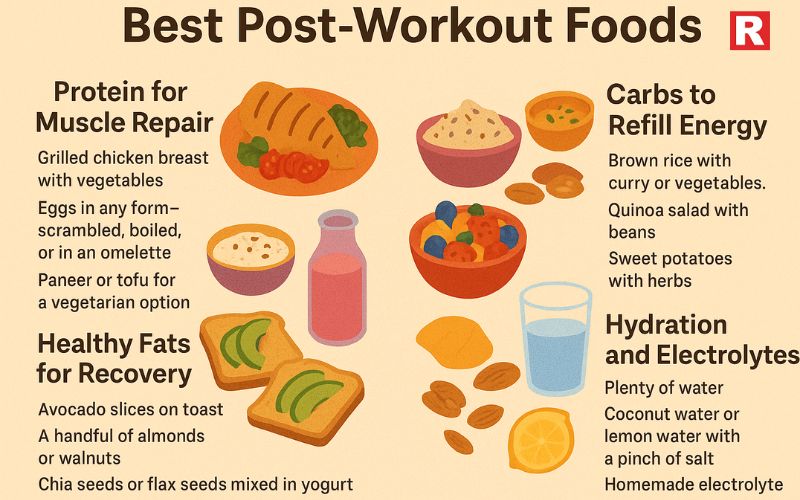
After exercise, the body feels like an empty battery that needs to be charged again. Muscles lose fuel and strength, and energy levels drop. This is when food becomes most important. Carbohydrates help refill glycogen stores that power the muscles. Protein supports repair and prevents muscle breakdown. Eating within 30 to 60 minutes after a workout makes recovery faster. The right balance of carbs and protein helps the body regain energy, reduce soreness, and prepare for the next session.
Protein for Muscle Repair
Protein is the building block of muscles. Eating it after a workout helps reduce soreness and supports growth. Options include:
- Grilled chicken breast with vegetables.
- Eggs in any form – scrambled, boiled, or in an omelette.
- Paneer or tofu for a vegetarian option.
- A protein shake with milk or water.
Carbs to Refill Energy
Carbs are just as important after training as they are before. They bring back the energy used by your muscles. Try:
- Brown rice with curry or vegetables.
- Quinoa salad with beans.
- Sweet potatoes with herbs.
- A bowl of fruit salad with seasonal fruits.
Healthy Fats for Recovery
Fats are not always the enemy. The right fats reduce inflammation and support recovery. Choose:
- Avocado slices on toast.
- A handful of almonds or walnuts.
- Chia seeds or flax seeds mixed in yogurt.
Hydration and Electrolytes
You lose water and minerals like sodium and potassium through sweat. Rehydrate with:
- Plenty of water.
- Coconut water or lemon water with a pinch of salt.
- Homemade electrolyte drinks with water, lemon, and honey.
Also check: 7 Pure Raw Honey Varieties That Offer Exceptional Taste and Natural Healing Benefits
Foods You Should Avoid Around Workouts
Not every food is good before or after exercise. Some make you feel heavy or slow down recovery. Stay away from:
- Fried foods or fast food – they are heavy and slow to digest.
- Sugary snacks or sodas – they give a quick rush but a fast crash.
- Alcohol – it dehydrates your body and reduces muscle recovery.
Quick Reference Cheat Sheet
Here is a simple list you can remember:
Pre-Workout Foods (Fuel) | Post-Workout Foods (Recover) |
|---|---|
Banana with peanut butter | Grilled chicken with rice |
Oats with berries | Eggs with avocado toast |
Greek yogurt with honey | Protein shake with banana |
Black coffee or green tea | Quinoa salad with paneer |
Pro Tips for Maximum Energy
- Keep your pre-workout meals light. A heavy stomach makes you slow.
- Drink water before, during, and after your workout. Dehydration reduces strength and focus.
- Adjust your meals to your goals. If you want to lose weight, reduce carbs and keep protein high. If you want to build muscle, increase both carbs and protein.
- Everyone’s body reacts differently. Try different foods and see what makes you feel best.
Check more: 5 Delicious Sago Desserts to Enjoy This Monsoon
How Food Influencers Are Changing the Way We Eat
6 Benefits of Drinking Black Coffee
Stay Healthy!
Workouts do not begin inside the gym; they begin with the food chosen in the kitchen. The right pre-workout meal gives the body the energy to perform with focus and strength. The right post-workout meal helps repair tired muscles, restore energy stores, and build strength for the next session. A simple formula makes it clear. Before exercise, combine carbohydrates with protein and proper hydration. After exercise, focus on protein, carbohydrates, healthy fats, and rehydration.
Each part works together to fuel energy, support recovery, and prevent fatigue. Natural and whole foods are the best choice, as they provide steady energy without unnecessary additives. Consistency in food habits brings visible results, not only in training but also in overall health and well-being. When the body is fueled smartly, workouts feel easier, recovery is faster, and progress becomes steady. The foundation of fitness is not just movement but the right nutrition every day. For specific requirements, consult a dietician/doctor.

India is often called the land of flavors. Spices may have given it global fame, but sweets are what truly carry its soul. Every state in India has its own special mithai, each shaped by its culture and people. These sweets are not just food on a plate. They are memories, traditions, and stories that have been passed down through families for centuries. Many began in temple kitchens as offerings to gods, while others were born in royal palaces where cooks experimented with rich ingredients.
Over time, they became part of festivals, weddings, and everyday life. For Indians, sweets are tied to emotions. They mark celebrations, welcome guests, and even express love. From the spongy Rasgulla of Bengal to the rich Mysore Pak of Karnataka, each sweet is more than a dessert. It is a piece of history. For a food lover, exploring these sweets is like following a sweet map of India. Each one tells a story about the land it comes from and the people who cherish it.
Read more: 12 Delicious High-Protein Foods to Eat Daily for a Healthier You
5 Foods to Avoid for Better Cholesterol
1. Rasgulla – West Bengal
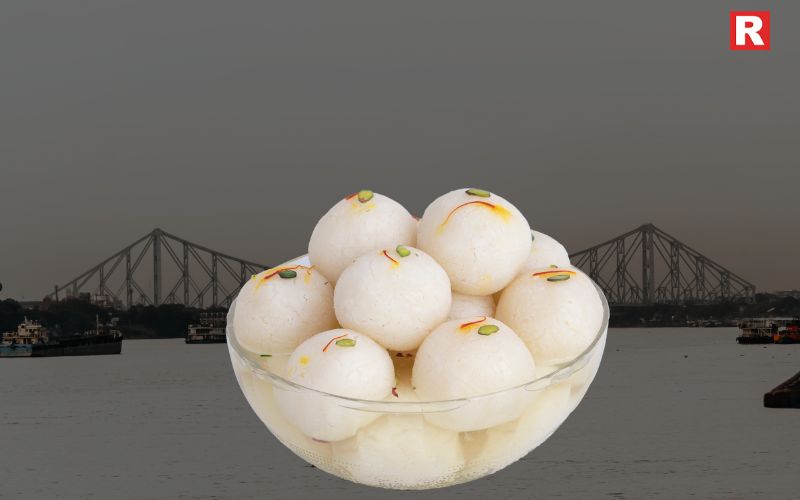
No list of Indian sweets is complete without Rasgulla. This white, spongy dessert made of chhena (cottage cheese) and sugar syrup is Bengal’s pride. The sweet is believed to have been created in Kolkata during the 19th century. There has always been a debate between Odisha and Bengal about its true origin. In fact, both states fought for the GI (Geographical Indication) tag. West Bengal got it in 2017, while Odisha received one for “Odisha Rasagola” in 2019. The charm of Rasgulla is its simple look and melt-in-the-mouth feel. Bengalis often serve it cold after meals or during festivals like Durga Puja. If you ever visit Kolkata, stopping by a sweet shop for Rasgullas is a must.
2. Petha – Uttar Pradesh (Agra)
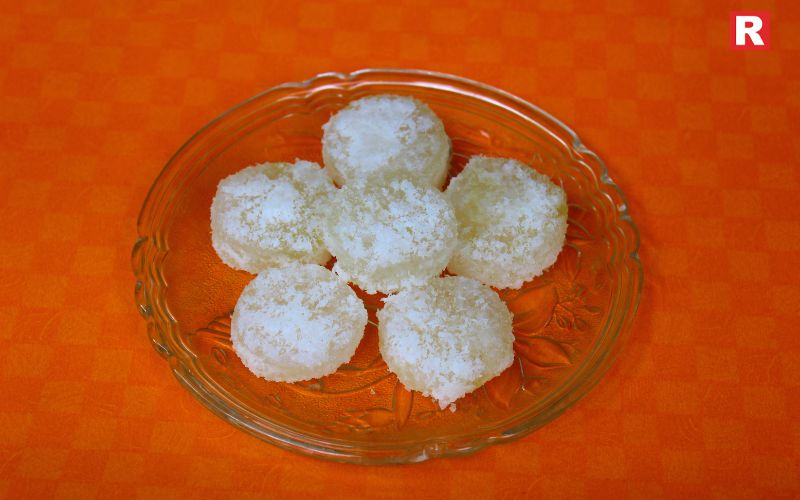
Agra is not just about the Taj Mahal. It is also the city of Petha. This translucent sweet is made from ash gourd (white pumpkin). It is boiled in lime water, then soaked in sugar syrup. Legend says Petha was first made in the Mughal kitchens to offer something refreshing and sweet to soldiers. Over time, it became Agra’s identity. Today, you will find countless Petha shops near the Taj Mahal. What makes it special is its variety. From classic dry Petha to modern flavors like mango, chocolate, and paan, there is something for everyone. Tourists often buy boxes of Petha as a souvenir.
3. Mysore Pak – Karnataka
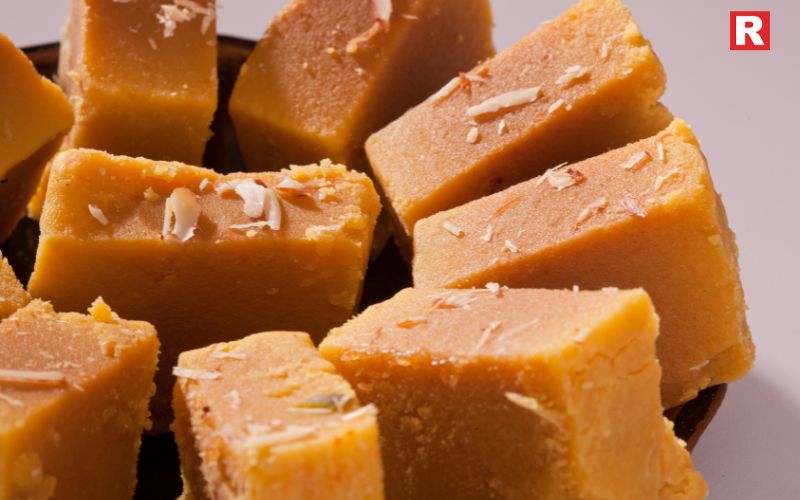
This royal sweet was born in the Mysore Palace during the rule of King Krishnaraja Wodeyar. A royal cook accidentally created this recipe with ghee, gram flour, and sugar. The king loved it so much that it became a part of palace tradition. Mysore Pak is known for its rich ghee flavor and crumbly texture. Some versions are soft and melt instantly, while others are firm and break like fudge. It is often prepared during Diwali in South Indian homes. If you are in Karnataka, you cannot miss tasting Mysore Pak. Many say the original from the royal kitchen is still unmatched.
Know more: Top 5 States With the Spiciest Food in India
4. Motichoor Ladoo – Rajasthan
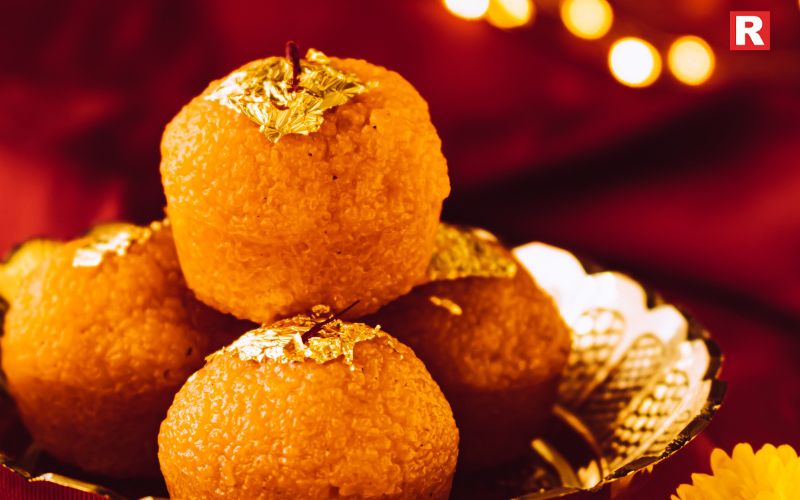
Rajasthan is famous for its bright colors and royal feasts. Its sweets are equally grand. Motichoor Ladoo is one of the state’s most loved sweets. Tiny fried gram flour pearls are soaked in sugar syrup and then rolled into balls with ghee and cardamom. These laddoos are offered in temples and at weddings. They are also closely linked with Lord Ganesha, who is believed to love laddoos. In fact, during Ganesh Chaturthi, Motichoor Ladoo is a must-have offering. What makes them stand out is their fine texture and saffron flavor. Rajasthan’s festive celebrations are incomplete without these laddoos.
5. Modak – Maharashtra
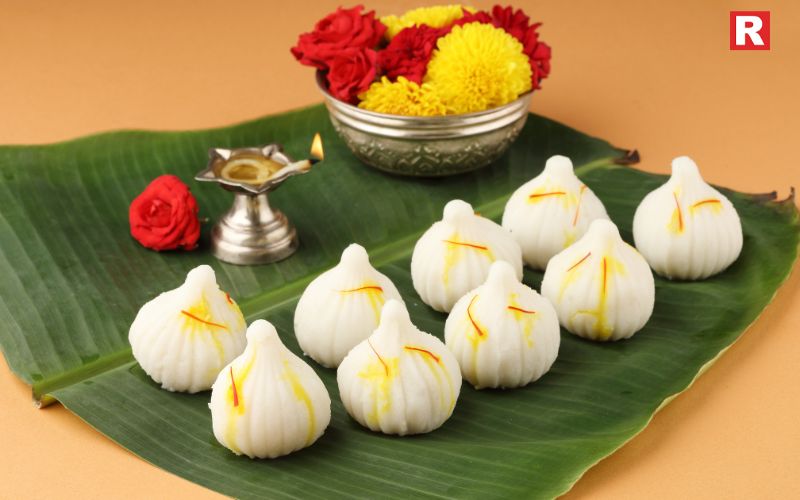
If Maharashtra had to pick one sweet as its identity, it would be Modak. This steamed dumpling is made of rice flour, stuffed with jaggery and coconut. During Ganesh Chaturthi, Modak is prepared in almost every Maharashtrian home. There are many versions of Modak today. Some are fried, some are made with chocolate, and even fusion styles are becoming popular. Yet, the traditional steamed “Ukadiche Modak” remains the most loved. For Maharashtrians, Modak is not just food. It is a symbol of devotion to Lord Ganesha. Every bite tastes of warmth and culture.
6. Sandesh – West Bengal
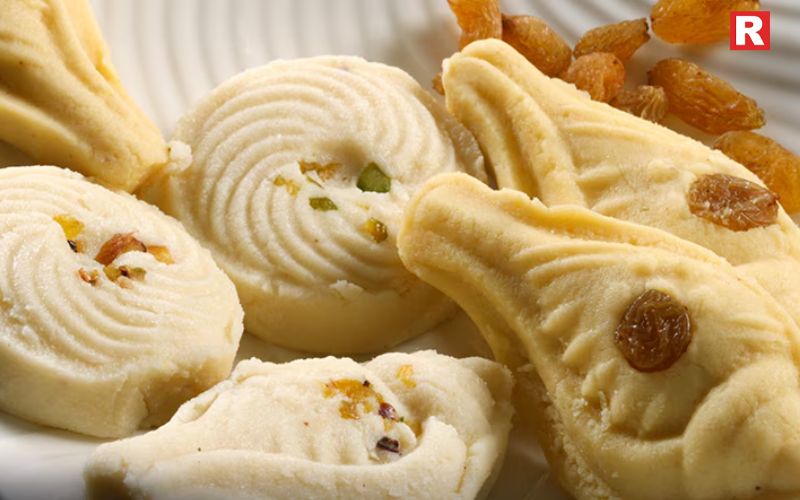
While Rasgulla is Bengal’s pride, Sandesh is its art. This sweet is made with fresh paneer and sugar. It is soft, light, and often flavored with fruits, saffron, or rosewater. Sandesh has a special place in Bengali households. It is given to guests, shared during festivals, and even offered as gifts. Sweet shops in Kolkata often shape Sandesh into flowers, fruits, and unique designs. It is said that Rabindranath Tagore himself loved Sandesh and often mentioned it in his writings. The sweet reflects the creativity and elegance of Bengal.
7. Ariselu – Andhra Pradesh and Telangana
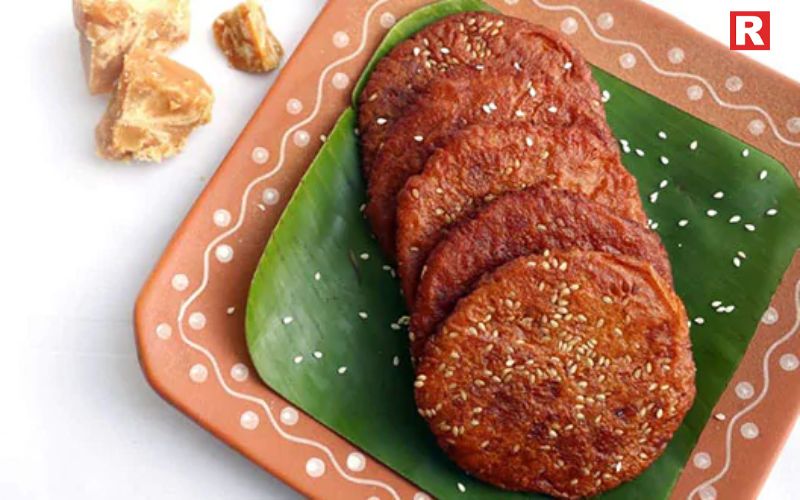
Ariselu is a traditional sweet deeply tied to harvest festivals. It is made with rice flour, jaggery, and sesame seeds. The dough is fried in ghee, giving it a crisp outer layer and a soft inside. Families in Andhra Pradesh and Telangana prepare Ariselu during Makar Sankranti. It is considered an auspicious sweet that brings prosperity. Mothers often make it at home using recipes passed down from generations. What makes Ariselu unique is its earthy taste, as jaggery and ghee dominate the flavor. It is not just a sweet, but a symbol of family bonding.
Also check: 10 Must-Try Gujarati Dishes That Will Delight Your Taste Buds
8. Kaju Katli – Gujarat and Maharashtra
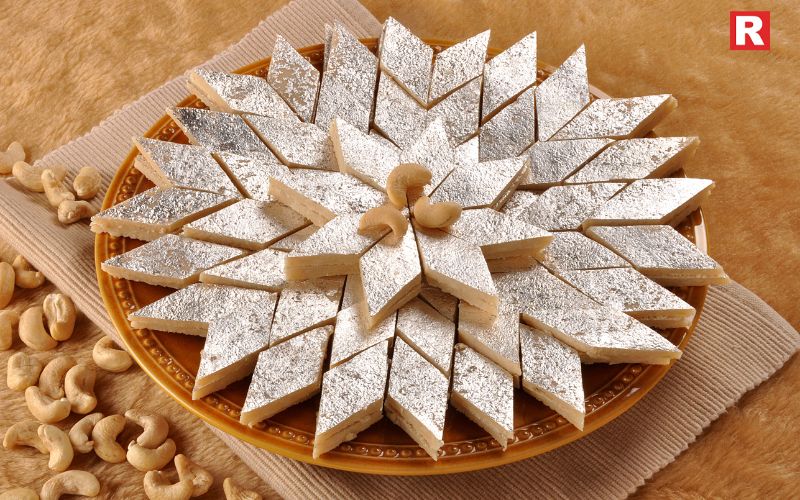
Kaju Katli is perhaps the most popular gift sweet during Diwali. This cashew-based dessert is cut into diamond shapes and often topped with silver leaf. Its silky texture and nutty flavor make it a crowd favorite. The sweet is said to have Mughal influences. Cashews, which were once considered royal ingredients, gave Kaju Katli its rich character. Today, it is loved across India, especially in Maharashtra and Gujarat. Diwali celebrations almost feel incomplete without a box of Kaju Katli. It is the sweet that symbolizes sharing and gifting.
9. Chhena Poda – Odisha
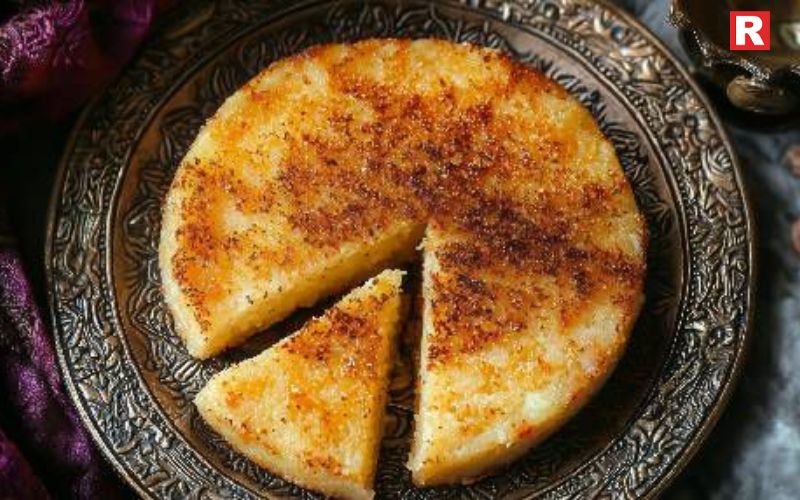
Chhena Poda means “roasted cheese.” This baked cottage cheese dessert is Odisha’s pride. It is made by mixing chhena with sugar and cardamom, then baking it until caramelized. The story goes that a cook accidentally left sweetened chhena in an oven overnight. The next morning, Chhena Poda was born. Since then, it has become a festive delicacy. Its smoky, caramelized flavor sets it apart from other Indian sweets. If you visit Odisha during festivals like Raja Parba, you will surely find Chhena Poda being served.
10. Payasam – Kerala
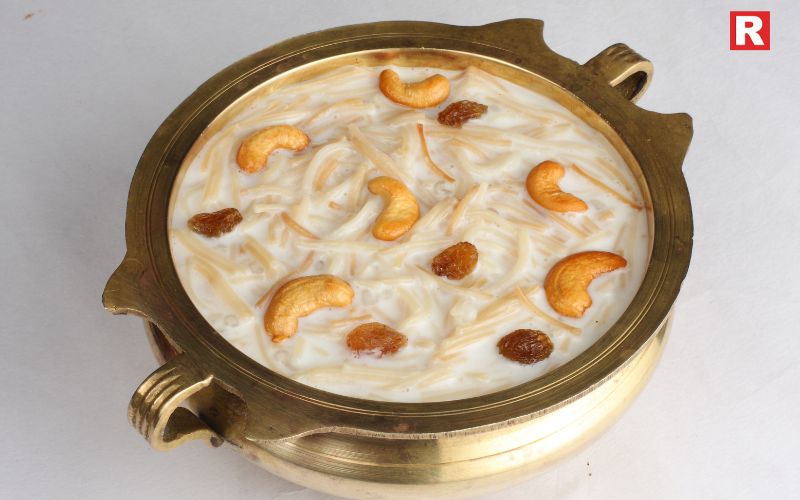
No Kerala feast is complete without Payasam. This milk and rice pudding is made with jaggery, coconut milk, or sugar. It is served at weddings, temples, and especially during the grand Onam Sadya. There are many varieties of Payasam, such as Pal Payasam (milk-based) and Ada Pradhaman (with rice flakes and jaggery). Each version carries a unique taste but the same sense of warmth. Payasam is more than a dessert. It is part of Kerala’s hospitality. When you are served Payasam in a traditional banana leaf feast, you know you are truly welcome.
Why Indian Sweets Are More Than Just Desserts
Indian sweets are tied to culture and emotions. They are offered to gods, shared at weddings, and gifted during festivals. Many were born in temples or royal kitchens, carrying history in every bite.
Even today, sweets remain a symbol of love and celebration. Modern versions may use chocolate or fusion styles, but the essence remains the same. Every mithai is a reminder of India’s diversity and traditions.
Check more: 7 Healthy Chicken Dishes to Maintain Your Diet
6 Benefits of Drinking Black Coffee
Top 10 Health Benefits of Eating Dry Fruits Daily
The Sweet Treat!
Traveling across India is like opening a box filled with sweets. Each state has its own flavor, its own story, and its own pride. The soft Rasgulla from Bengal speaks of Bengal’s love for chhena. The rich Mysore Pak of Karnataka tells the tale of royal kitchens. In Odisha, Chhena Poda brings the charm of an accidental creation, while in Maharashtra, Modak shows devotion to Lord Ganesha. These sweets are more than taste; they are memories, culture, and family traditions wrapped in sugar and ghee. For a traveler, tasting local mithai is as important as visiting monuments. A sweet shop can tell you more about a place than any guidebook. Every bite is a story, and every dessert is a small window into India’s heritage.

Food has always been a way to connect people and cultures. Every nation has a dish that reflects its history and values. These dishes are more than recipes, they are traditions passed through generations. In Italy, pizza is not just a meal but a part of everyday life, born in Naples and loved across the globe. Japan is known for sushi, a dish that highlights balance, freshness, and respect for ingredients. India brings curry, rich in spices and flavors, telling stories of trade and heritage. Mexico celebrates tacos, a simple yet versatile food that represents community and street culture. France is remembered for baguettes and croissants, symbols of art and craft in baking. China’s dumplings are linked to family and festivals, often enjoyed during special occasions. Each of these foods carries meaning, showing how culture is served on a plate. They remind people of home, identity, and pride. Famous dishes go beyond taste, they reflect who people are and where they come from.
Read more: 12 Delicious High-Protein Foods to Eat Daily for a Healthier You
7 Types of Whiskies Everyone Should Try Once
Discover the Most Famous Dishes in the Country
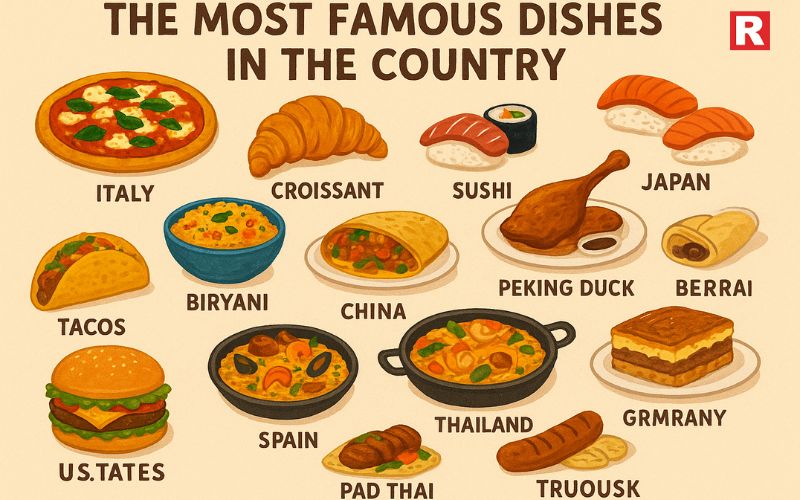
Explore iconic dishes from around the world that define culture, history, and heritage, bringing people together through taste and tradition.
Italy – Pizza
Italy’s ultimate comfort food, combining dough, tomato, and cheese into a global cultural treasure. Pizza originated in Naples and evolved into an international icon. The Margherita, with basil, mozzarella, and tomato, represents Italy’s tricolor. UNESCO honored Neapolitan pizza-making as heritage. Today, pizza is a worldwide symbol of casual dining.
France – Croissants
France’s buttery breakfast pastry, flaky layers baked to golden perfection, symbolizing elegance and tradition. Croissants became popular in Paris in the 19th century. The process involves folding dough and butter repeatedly. Today, croissants are served in cafés worldwide, often with coffee, and remain a favorite indulgence for travelers.
Japan – Sushi
Japan’s refined dish, vinegared rice and raw fish combined into delicate, artistic servings. Sushi began as a method to preserve fish but developed into culinary art. From nigiri to rolls, sushi reflects Japanese precision and elegance. Authentic sushi remains a highlight for visitors seeking Japan’s traditional cuisine.
India – Biryani
India’s aromatic rice dish blends spices, meat, or vegetables into rich cultural layers. Biryani was introduced by Persian influences but perfected in India. Hyderabad’s biryani is spicy, while Lucknow’s version is milder. Each style represents regional taste. Today, biryani is celebrated as India’s most iconic festive dish.
China – Peking Duck
China’s royal specialty, crispy-skinned duck carved and served with pancakes and sauces. Peking Duck dates back to the Ming Dynasty. It requires careful preparation to achieve crisp skin and tender meat. Traditionally served with pancakes, cucumber, and sweet sauce, it remains a symbol of Chinese culinary excellence.
Mexico – Tacos
Mexico’s street food star, tortillas filled with endless meat, beans, or vegetable combinations. Tacos were originally indigenous food, later adapted with Spanish influence. They can be soft or crispy, topped with salsa. Today, tacos represent Mexican culture and are enjoyed across the globe in countless variations.
United States – Burgers
America’s most famous dish, beef patty inside a bun with cheese and condiments. The hamburger rose in popularity in the early 1900s and became tied to U.S. fast-food culture. Today, it is found in restaurants, barbecues, and fast-food chains worldwide, representing American casual dining.
Know more: 6 Unexpected Benefits of Eating Jackfruit (Kathal) – Nature’s Spiky Surprise!
Spain – Paella
Spain’s saffron-flavored rice dish, cooked with meat, seafood, and vegetables in a shallow pan. Paella originated in Valencia. Traditionally made with rabbit and chicken, it now has seafood variations. Cooked in wide pans, it is often shared during gatherings, making it a symbol of Spanish community dining.
Thailand – Pad Thai
Thailand’s stir-fried noodle dish combines sweet, sour, salty, and spicy flavors. Pad Thai became popular during World War II as affordable street food. Cooked with shrimp, tofu, peanuts, and lime, it is Thailand’s most famous dish, loved by both locals and tourists around the world.
Greece – Moussaka
Greece’s layered casserole combines eggplant, potatoes, minced meat, and creamy béchamel sauce. Moussaka has Middle Eastern roots but gained fame in Greece. The dish is baked until golden and creamy. It is widely served in Greek households and restaurants, representing the comfort of Mediterranean food traditions.
Turkey – Kebab
Turkey’s grilled meat dish, enjoyed as skewers, rotisserie, or stuffed wraps. Kebabs date back to the Ottoman Empire. Doner kebabs, cooked on a vertical rotisserie, spread globally. Kebabs remain a symbol of Turkish street food, served with bread, rice, or salads in countless variations.
Brazil – Feijoada
Brazil’s national stew, combining black beans, pork, and beef into rich flavors. Feijoada reflects Brazil’s diverse influences, blending African, Portuguese, and indigenous traditions. Traditionally served with rice, greens, and oranges, it is eaten during weekend gatherings, making it both a cultural and social meal.
Germany – Bratwurst
Germany’s signature sausage, grilled or fried, paired with mustard and bread. Bratwurst is made from pork, veal, or beef. It is enjoyed during festivals and at Oktoberfest alongside beer. This iconic sausage represents Germany’s strong meat traditions and remains a highlight of German street food.
Vietnam – Pho
Vietnam’s noodle soup, with fragrant broth, rice noodles, herbs, and meat. Pho is a staple of Vietnamese cuisine, especially breakfast. Its broth, simmered for hours, creates deep flavors. Served with beef or chicken, pho has become a beloved global dish, representing Vietnam’s culinary pride.
South Korea – Kimchi
Korea’s fermented cabbage dish, seasoned with chili, garlic, and ginger. Kimchi is served at almost every Korean meal. It offers probiotics and vitamins, making it both healthy and delicious. Beyond nutrition, it represents Korean tradition, family recipes, and cultural resilience through history.
Argentina – Asado
Argentina’s barbecue tradition, grilling beef and sausages over open flames. Asado is more than food—it is a cultural gathering. Argentine beef is cooked slowly over fire and shared with friends. It remains a national symbol of hospitality, family, and meat excellence.
Russia – Borscht
Russia’s beetroot soup, served hot or cold, with sour cream garnish. Borscht is common across Eastern Europe, but Russia popularized it worldwide. Its bright red color comes from beets, combined with cabbage and potatoes. It reflects the farming culture and resilience of cold-climate cuisine.
Ethiopia – Injera
Ethiopia’s spongy flatbread, doubling as plate and utensil. Injera, made from teff flour, is served with stews placed on top. Diners tear off pieces to scoop food. This style of communal eating reflects Ethiopia’s culture of sharing and togetherness.
Lebanon – Hummus
Lebanon’s chickpea dip, blended with tahini, garlic, and lemon juice. Hummus is part of the Middle Eastern mezze tradition. Served with pita bread, it is nutritious and flavorful. Today, hummus has gained international fame as a healthy snack and plant-based protein source.
Morocco – Tagine
Morocco’s slow-cooked stew, cooked in clay pots with spices and vegetables. Tagine combines lamb, chicken, or vegetables with spices like saffron and cumin. The clay pot creates slow, tender cooking. It reflects Morocco’s blend of Berber, Arab, and Mediterranean influences.
Australia – Meat Pie
Australia’s hand-sized savory pie, filled with meat and gravy. Meat pies are popular at sports games and family events. Served with tomato sauce, they symbolize Australia’s casual and hearty food culture. They remain the country’s favorite snack food.
Sweden – Swedish Meatballs
Sweden’s savory-sweet meatballs, served with cream sauce and lingonberry jam. Swedish meatballs gained worldwide popularity through IKEA. They reflect Nordic comfort food, with balanced flavors of spiced meat, sauce, and tart berries. In Sweden, they are a traditional family dish.
Peru – Ceviche
Peru’s seafood dish, raw fish cured in citrus juices with onions and chili. Ceviche symbolizes Peru’s coastal heritage. Lime juice “cooks” the fish, making it fresh and tangy. Often served with corn or sweet potatoes, it is now a global seafood favorite.
Jamaica – Jerk Chicken
Jamaica’s spicy grilled chicken, marinated with peppers and allspice. Jerk chicken is cooked over pimento wood, giving it a smoky flavor. It blends African and Caribbean traditions. Today, it is Jamaica’s most famous dish and a global ambassador of Caribbean spice.
Belgium – Waffles
Belgium’s crispy sweet pastry, topped with fruit, cream, or chocolate. Belgian waffles are thicker and have deep pockets, perfect for toppings. Once eaten plain, they gained fame as street food. They represent Belgium’s pastry excellence and are loved worldwide.
Thailand – Tom Yum Soup
Thailand’s spicy and sour soup, flavored with lemongrass, chili, and lime. Tom Yum is made with shrimp or chicken. It reflects Thailand’s bold flavor balance and aromatic ingredients. Known for its hot and sour taste, it is both refreshing and warming.
Israel – Falafel
Israel’s deep-fried chickpea balls, often eaten in pita bread with salad. Falafel is a popular Middle Eastern street food. Crispy outside, soft inside, it is high in protein. Often paired with hummus and tahini, falafel has gained international recognition as a vegetarian favorite.
Also check: Top 5 States With the Spiciest Food in India
7 Healthy Chicken Dishes to Maintain Your Diet
Cuba – Ropa Vieja
Cuba’s shredded beef stew, cooked with tomatoes, peppers, and spices. Ropa Vieja means “old clothes,” as the shredded beef resembles torn fabric. Served with rice and beans, it reflects Spanish influence on Cuban food culture. It remains a national dish of Cuba.
Austria – Wiener Schnitzel
Austria’s breaded veal cutlet, fried until golden and crispy. Wiener Schnitzel is Austria’s most famous dish. Traditionally made with veal, it is served with lemon wedges and potato salad. It reflects Austria’s culinary refinement and remains popular in Central Europe.
Netherlands – Stroopwafel
Netherlands’ caramel-filled waffle, chewy and sweet. Stroopwafels are two thin waffles filled with syrup. They originated in Gouda and are enjoyed with coffee or tea. Today, they are a Dutch cultural export, beloved by travelers and locals alike.
Philippines – Adobo
Philippines’ savory stew, chicken or pork simmered in vinegar, soy sauce, and garlic. Adobo is simple yet flavorful. Each region in the Philippines has its own variation. It reflects the resourceful use of local ingredients and is regarded as the country’s unofficial national dish.
Colombia – Arepa
Colombia’s corn cake, grilled or fried, served with cheese or fillings. Arepas are versatile, eaten at breakfast or dinner. They can be stuffed with meats, eggs, or cheese. This staple food reflects Colombia’s indigenous traditions and has become a regional favorite across South America.
Portugal – Pastel de Nata
Portugal’s custard tart, creamy filling with flaky pastry. Pastel de Nata was created by Lisbon monks in the 18th century. Its creamy custard and caramelized surface make it one of the most beloved desserts in the world today.
Nigeria – Jollof Rice
Nigeria’s one-pot rice dish, cooked with tomatoes, peppers, and spices. Jollof Rice is a West African staple. It is often served at celebrations and family events. Each country in the region has its own variation, but Nigeria’s is especially famous for its flavor.
Iran – Kebab
Iran’s grilled meat skewers, seasoned with saffron and spices. Iranian kebabs are distinct from Turkish ones. They often feature lamb, chicken, or fish, marinated with saffron. Served with rice or bread, they remain a centerpiece of Persian cuisine and hospitality.
Poland – Pierogi
Poland’s dumplings, filled with potatoes, cheese, or meat. Pierogi are boiled or fried and served with butter or sour cream. They reflect Polish traditions of hearty, comforting food. Today, they are a symbol of Poland’s cultural pride and resilience.
Malaysia – Nasi Lemak
Malaysia’s coconut rice dish, served with sambal, peanuts, egg, and anchovies. Nasi Lemak is Malaysia’s national dish. Its balance of sweet, spicy, and savory makes it unique. Originally a farmer’s meal, it is now widely enjoyed for breakfast or lunch.
Indonesia – Nasi Goreng
Indonesia’s fried rice dish, flavored with kecap manis (sweet soy sauce). Nasi Goreng is versatile, often served with fried egg and satay. It is a street food staple that reflects Indonesia’s creative use of spices. It is considered the country’s unofficial national dish.
Switzerland – Fondue
Switzerland’s melted cheese dish, eaten with bread cubes dipped in communal pot. Fondue became popular as a way to use leftover cheese. Today, it represents Swiss alpine tradition. Diners share from the same pot, making it a social and cultural experience.
South Africa – Bobotie
South Africa’s baked dish, spiced minced meat topped with egg custard. Bobotie reflects Cape Malay influences. It blends savory meat with mild sweetness, often served with rice and chutney. It represents South Africa’s diverse culinary heritage.
Panama – Sancocho
Panama’s chicken stew, flavored with yuca, corn, and herbs. Sancocho is a comfort dish enjoyed at family gatherings. Slow-cooked with traditional spices, it reflects Panama’s rural food traditions. It is often considered the country’s national soup.
Morocco – Couscous
Morocco’s semolina dish, steamed and served with stew. Couscous is a staple of North African cuisine. Served with meat, vegetables, and broth, it represents Morocco’s agricultural history and is often eaten on Fridays for family meals.
Ecuador – Encebollado
Ecuador’s fish soup, flavored with cassava and pickled onions. Encebollado is often eaten for breakfast and is known as a hangover cure. Made with tuna and cassava, it reflects Ecuador’s coastal food culture.
Pakistan – Biryani
Pakistan’s spiced rice dish, layered with meat and vegetables. Pakistani biryani is known for its rich spices and bold flavors. Karachi and Lahore have their own versions. It is a centerpiece dish at celebrations and gatherings.
Singapore – Chili Crab
Singapore’s seafood dish, crab cooked in thick, spicy tomato-chili sauce. Chili Crab is messy but delicious. It reflects Singapore’s creative food culture, blending Chinese and Malay influences. It is one of Singapore’s most famous exports.
Norway – Gravlax
Norway’s cured salmon, flavored with dill and sugar. Gravlax was traditionally a method to preserve fish. Today, it is served with mustard sauce and bread. It reflects Norway’s fishing heritage.
Finland – Karjalanpiirakka
Finland’s rye-crust pastries, filled with rice porridge or potatoes. Karjalanpiirakka originated in Karelia. They are often topped with egg butter. This dish represents Finland’s rustic culinary traditions.
Tunisia – Brik
Tunisia’s fried pastry, filled with egg and tuna. Brik is crispy and golden, often served during Ramadan. It represents Tunisia’s mix of Mediterranean and North African flavors.
Check more: Top 7 Food Safety Practices Every Restaurant Should Follow
7 Chinese Dishes That Can Be a Healthy Option for Your Diet
Top 10 Health Benefits of Eating Dry Fruits Daily
Vietnam – Banh Mi
Vietnam’s sandwich, baguette filled with meat, vegetables, and herbs. Banh Mi combines French bread with Vietnamese flavors. Filled with pork, pickles, and chili, it reflects colonial history. Today, it is a global street food favorite.
Estonia – Blood Sausage
Estonia’s hearty sausage, made with barley and blood. Blood Sausage is a traditional winter food, often eaten at Christmas. It reflects Estonia’s farming traditions and rustic cuisine.
Why These Dishes Matter Globally
Each dish tells a story of survival, culture, and creativity. Pizza was once food for the poor, but today it is a global industry. Sushi reflects the Japanese respect for skill and simplicity. Biryani shows the blending of Persian and Indian flavors. Dishes like tacos, burgers, and kebabs have become global fast-food icons.
For travelers, tasting these dishes is a way to connect with the culture of a country. For locals, they are traditions passed down through generations. Food is more than nutrition—it is identity.
Happy Eating!
The world’s most famous dishes are not only about taste. They are stories told through food. Each dish reflects the land, the people, and their way of life. Italy gave pizza, a symbol of comfort and sharing. Japan offers sushi, built on freshness and balance. Vietnam is known for pho, a bowl filled with warmth and tradition. India brings curry, full of spices that speak of history and trade. France celebrates bread and pastries, crafted with skill and care. Mexico shares tacos, food that connects families and communities. China’s dumplings bring together festivals and family bonds. These dishes are more than meals, they are experiences. They let people travel through flavor, even when sitting at home. Food is a map of culture, always inviting discovery.

Innovation in beverages is truly limitless, yet what creates a lasting recall for any guest goes beyond the drink itself—it lies in the harmony of food and service. When a thoughtfully crafted dish is perfectly paired with a beverage of choice, the experience becomes memorable. From the timeless charm of rum to the growing popularity of the Negroni, the bar scene continues to evolve. Today, tequila has found its rightful place on India’s bar menus, adding vibrancy and versatility. It’s this synergy of culinary excellence and innovative mixology that keeps guests returning for more.
Stirring Innovation
At a time when people love to play around food and beverage, innovation is the hot topic in every discussion of a restaurant. From Chefs working around local, indigenous cuisine and ingredients, to bartenders working hard to lure customers by infusing local ingredients, techniques in their drinks, innovation today is on creating products that add value to the ecosystem and have a lasting impact rather than being short-lived experiments.
“I feel innovation is very subjective, as per each market and we try to understand what the customer wants, rather than just innovating for the sake of it,” shared Nikhil Rochlani, Partner at Kyma, The Butterfly High Mumbai by adding that for him innovation is something which is more sustainable, stay on the shelf for a year and there’s always a customer who’s coming for it.
He also added that consumers today are discerning; they try something new with expectations of quality and consistency. “If the product doesn’t live up to it, we lose not just a sale but also credibility. That’s why, whenever we innovate, we do so in close collaboration with our consumers, understanding their preferences and frequency of consumption. For us, innovation is about sustainability, longevity, and real consumer value,” he added further.
Experience at the Centre
Today, visiting a bar or restaurant is no longer just about having a drink or a meal—it has evolved into a deeply personal experience. Guests are increasingly conscious of what they consume and the places they choose, seeking authenticity, quality, and connection. Dining out is now as much about the experience as it is about food and drink.
“There are two concepts to it, one is today there's an involvement in restaurants as well as bars, earlier it was just your innovations, cocktails, more specific to only bars and restaurants used to serve the basics or straights, today people really expect, they go to a restaurant and they expect a good innovative drink or a good pairing. So, that’s where our market has reached. Today you have time to serve the drink, experience the entire experience that a restaurant is providing or a bar head is providing, because in a high energy bar it's more to do with turnovers, how fast can you churn a drink, and the innovation is limited because you have a time factor,” pointed Joy Singh, Founder, Raasta and Partner, Yeti- The Himalayan Kitchen.
Quality over Quantity
Customers today are increasingly prioritizing quality over quantity. They prefer fewer but premium choices that deliver authenticity, flavor, and value, rather than being overwhelmed by large, generic offerings. This shift reflects a more mindful consumption pattern, where guests seek memorable experiences, sustainable practices, and products that resonate with their tastes and values, ensuring true satisfaction with every choice.
“We can see there is a clear shift of the customers from quantity to quality, especially after COVID, guests prefer to have only one or two drinks, not many. They have become more knowledgeable, they know what they are consuming, they know what they want to consume, they know what ingredient is going to benefit them, what I should have in the evening or maybe in the morning, right, credit goes to the pandemic time, they have got enough time to, you know. So, there’s a change in shift where people are more conscious about what they eat, where they eat,” added Neeraj Sharma, Director of Food and Beverage, Roseate Hotels.
Today’s customers are far more aware of what they eat and drink, making them highly experiential, knowledgeable, and discerning. They actively seek authenticity, quality, and new experiences, while expecting brands to meet their evolving tastes. This shift has made them more demanding, pushing the industry to constantly innovate and adapt.
Copyright © 2009 - 2025 Restaurant India.




